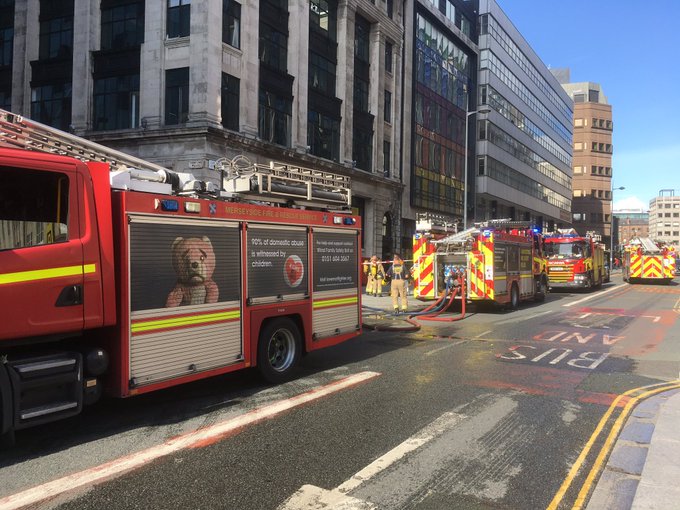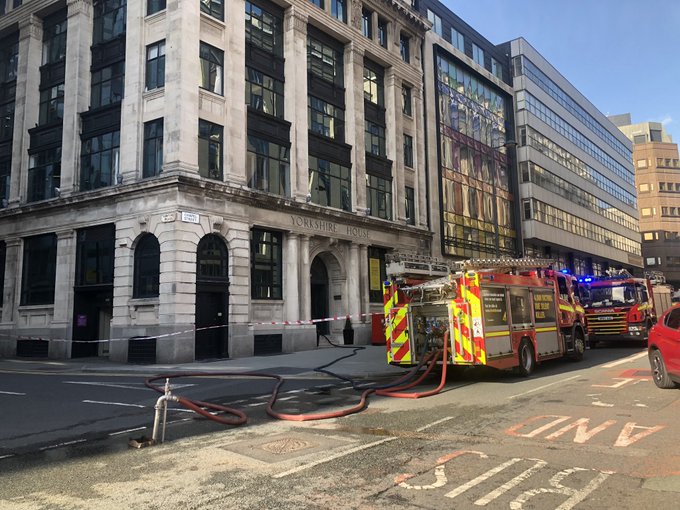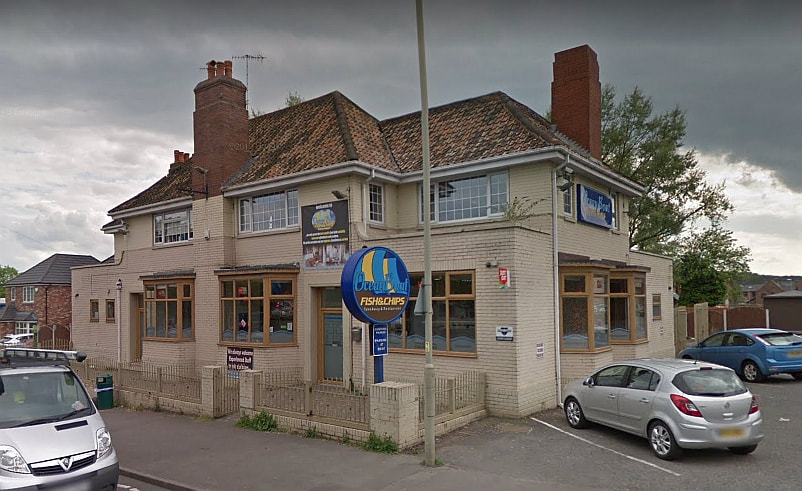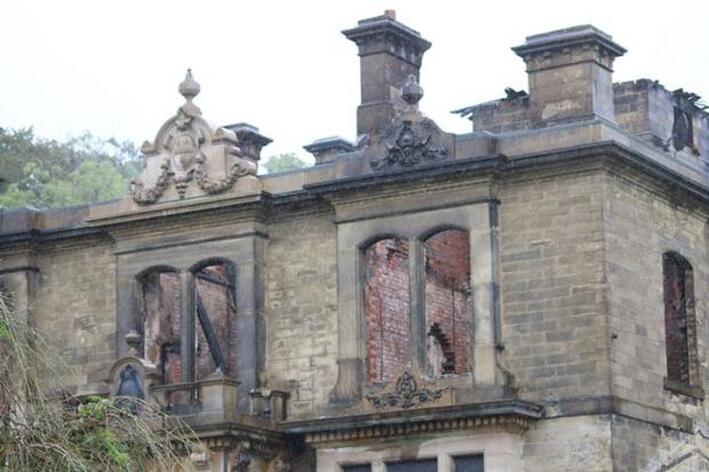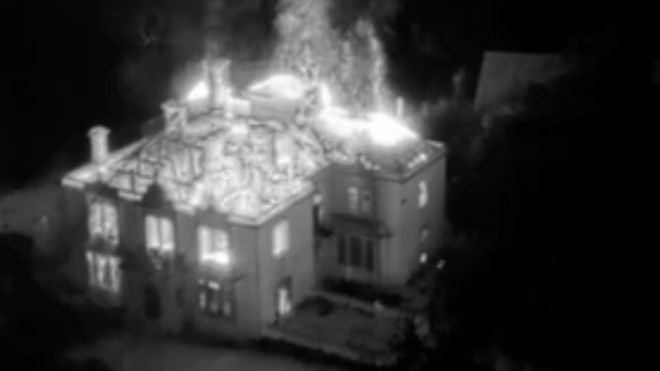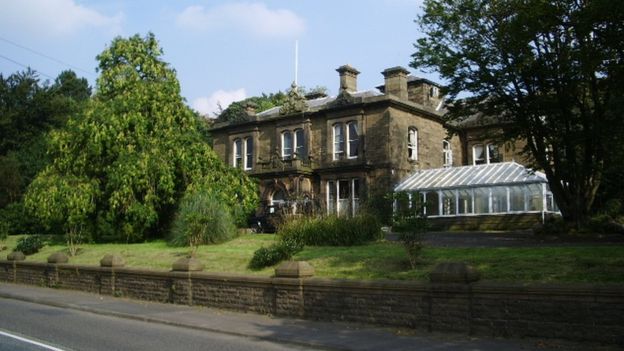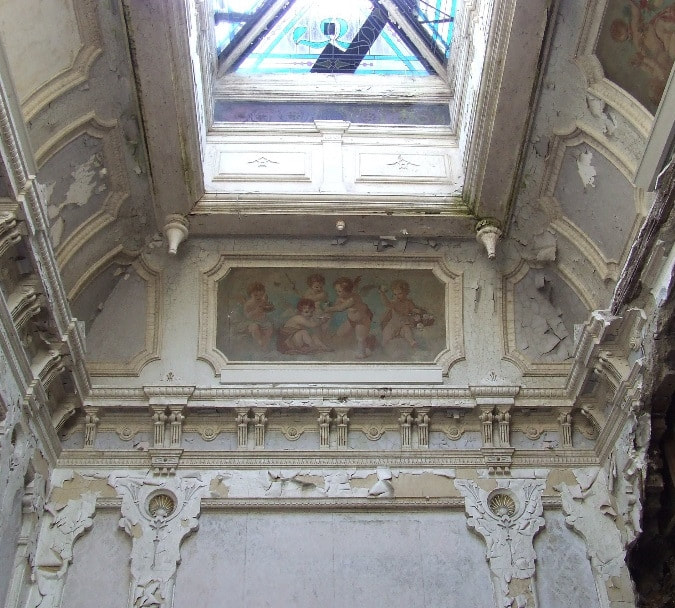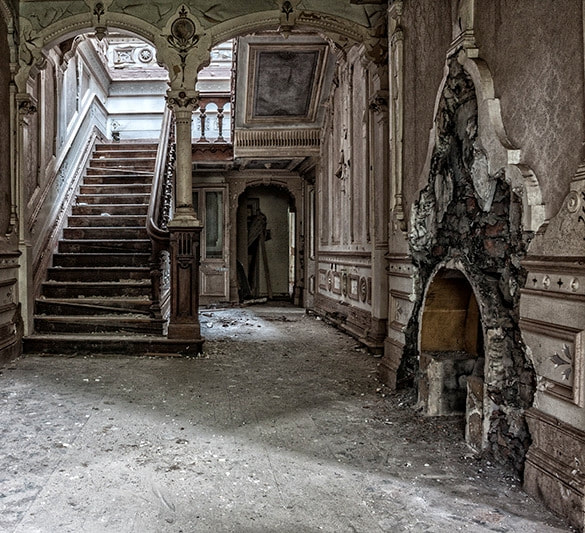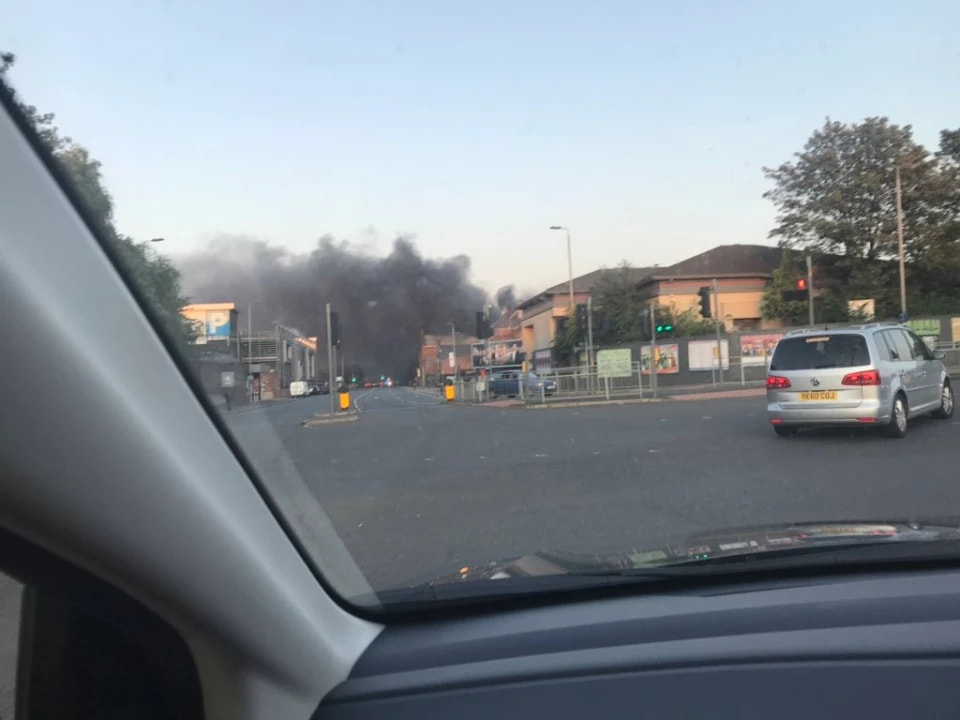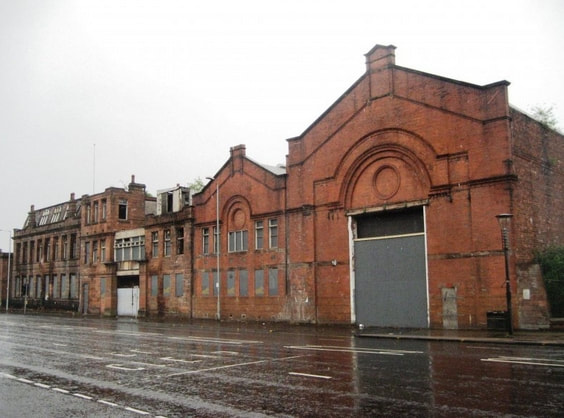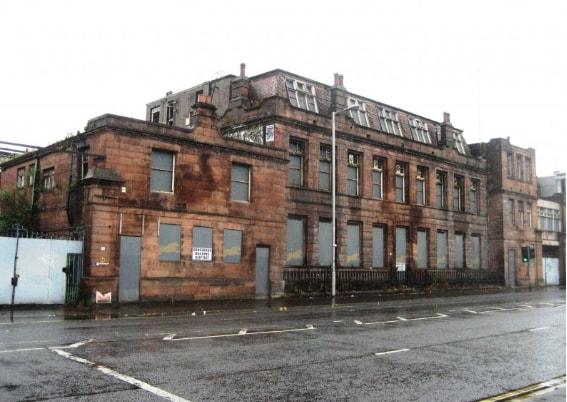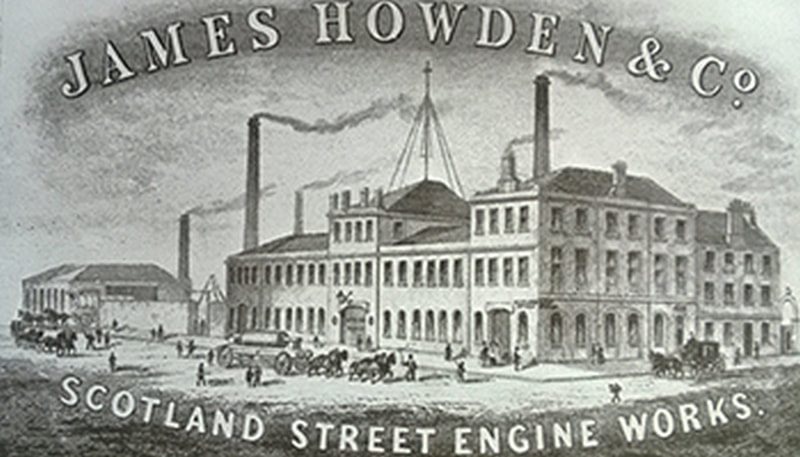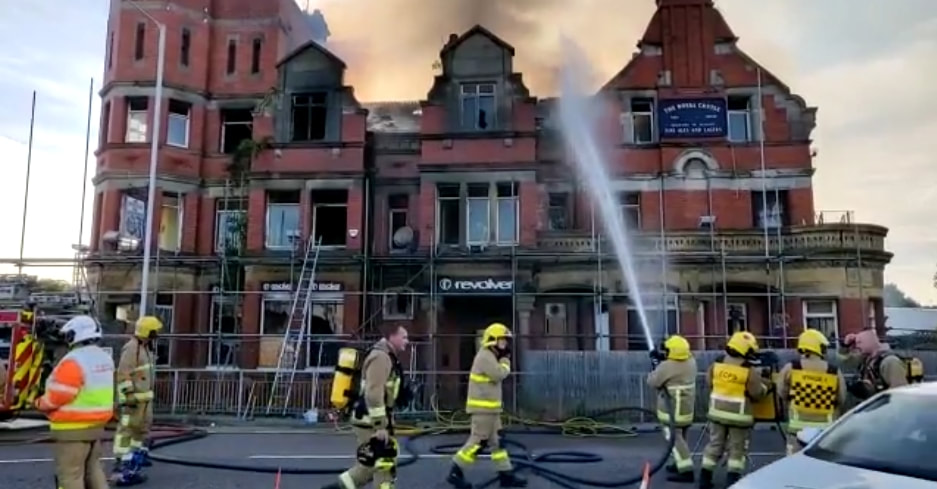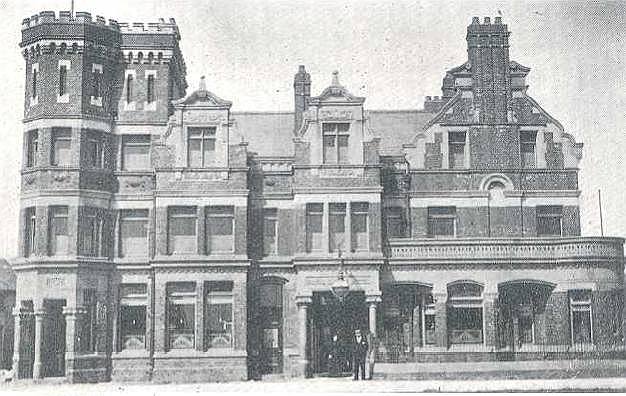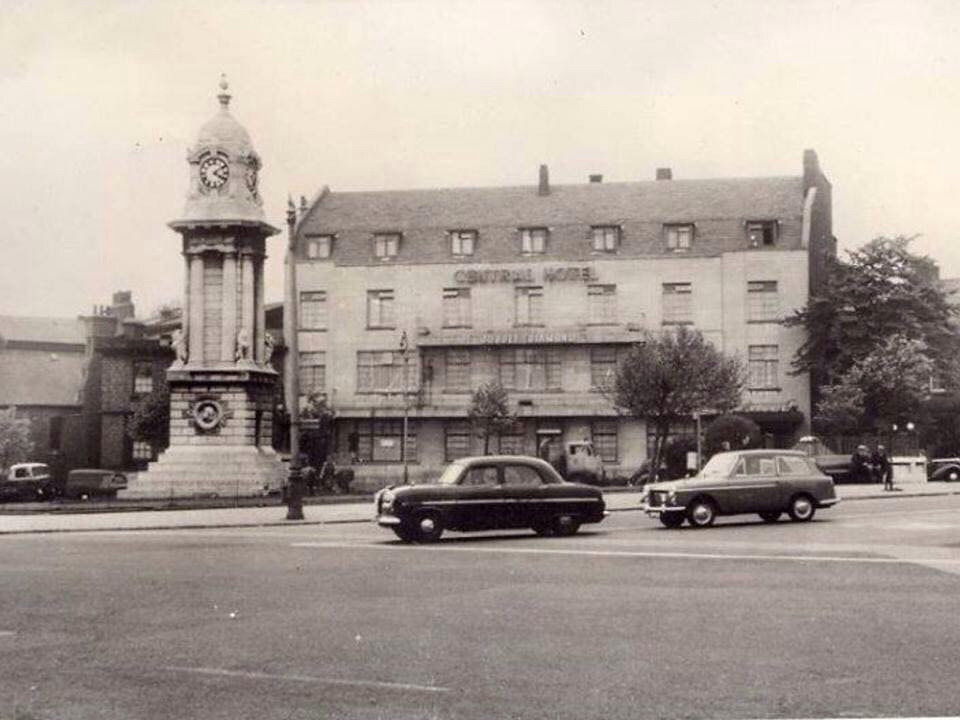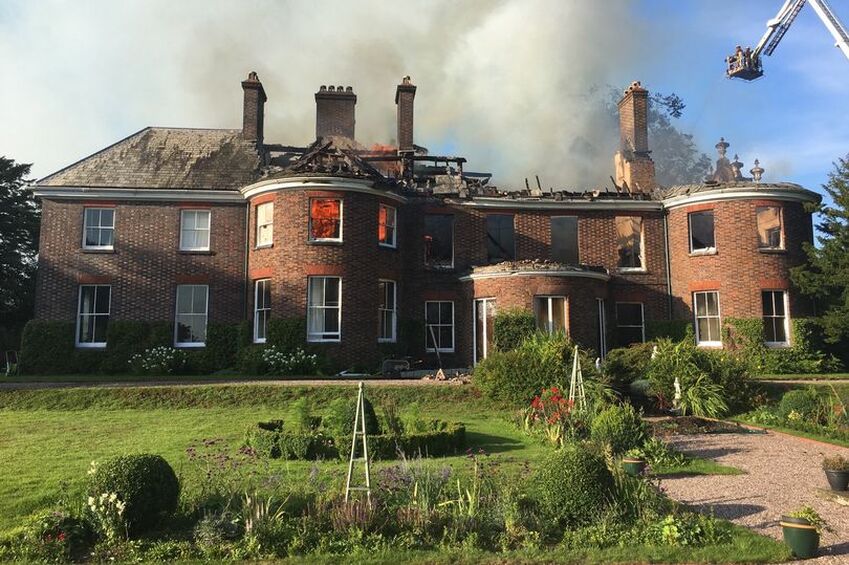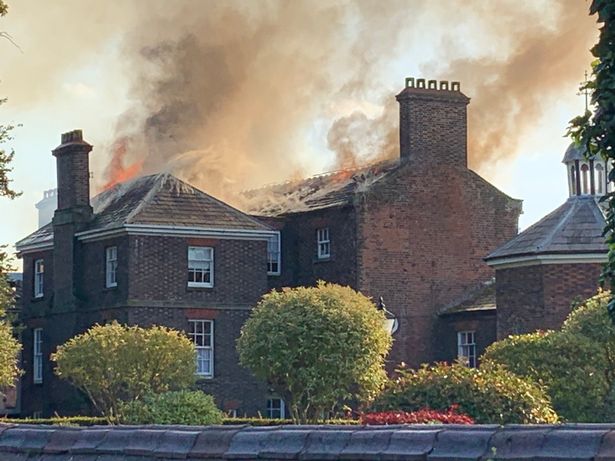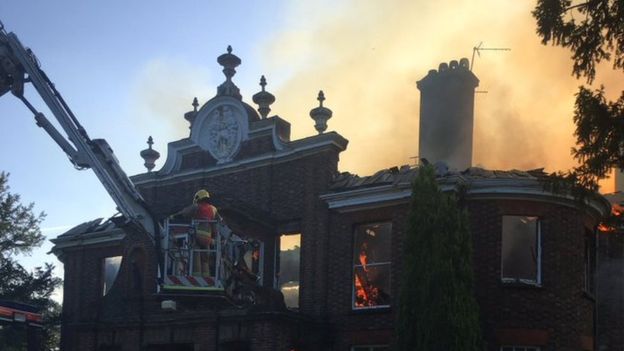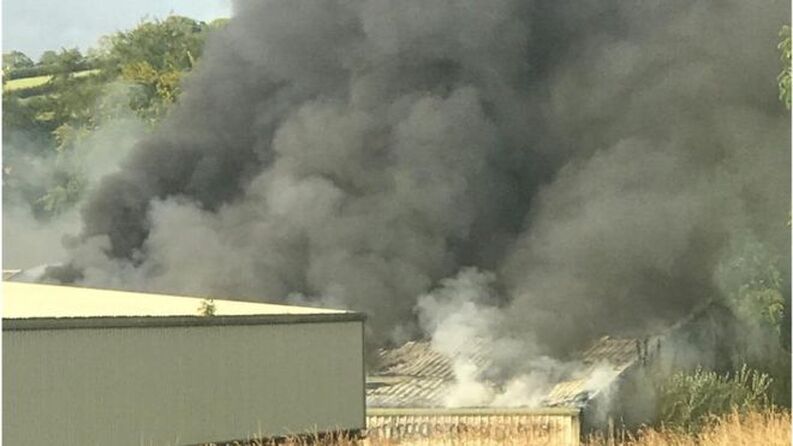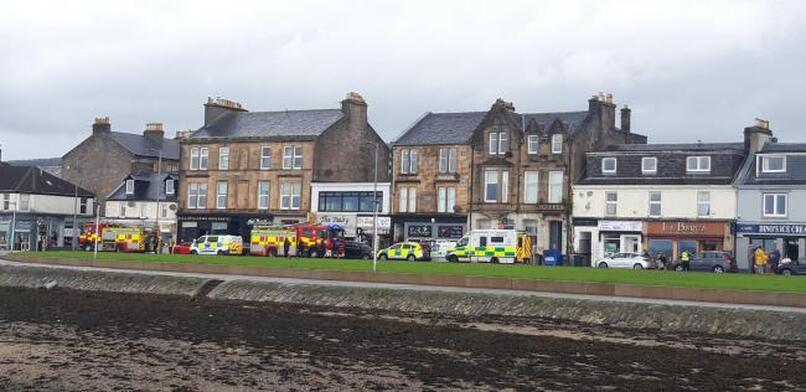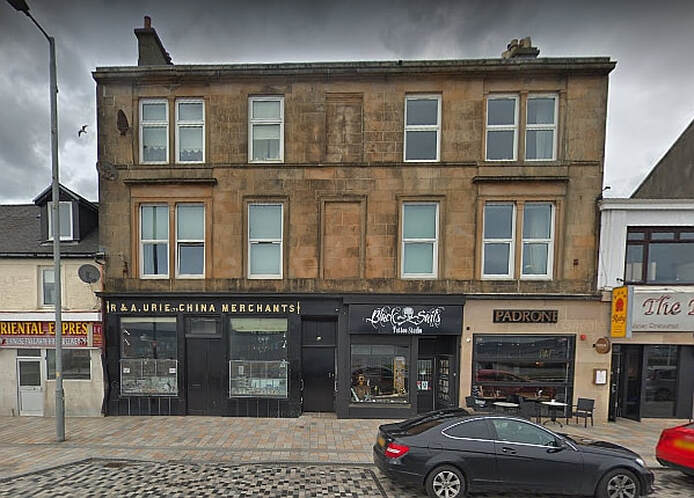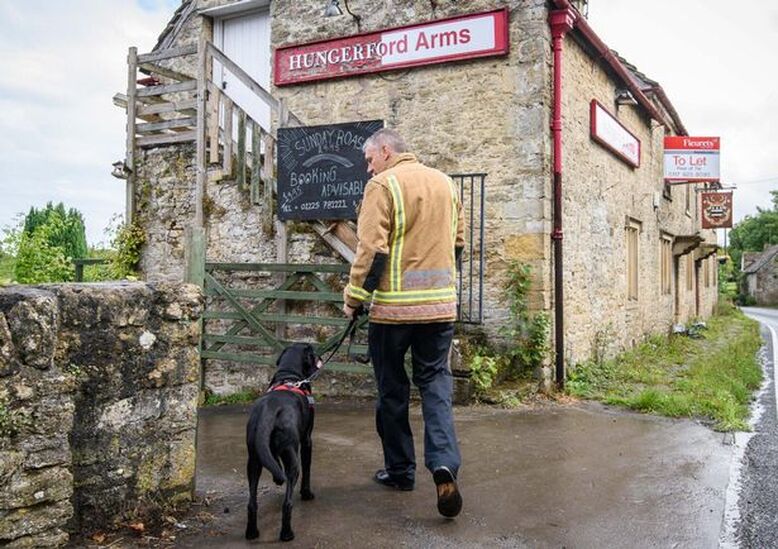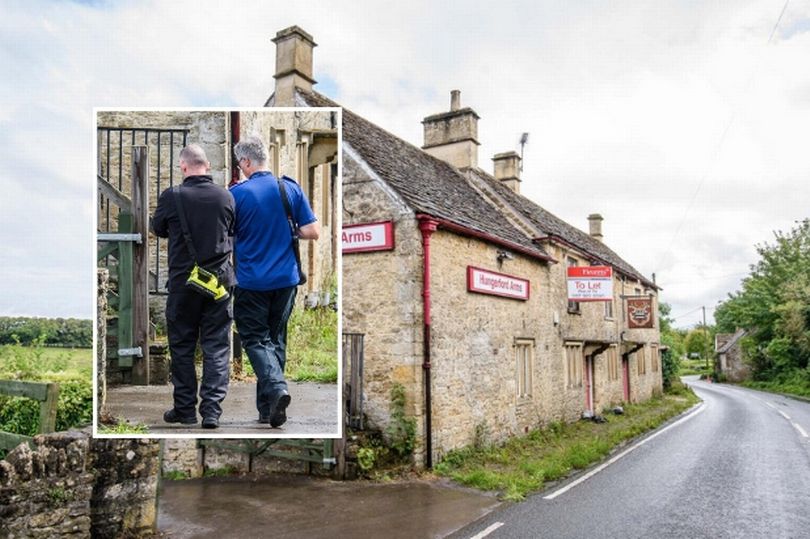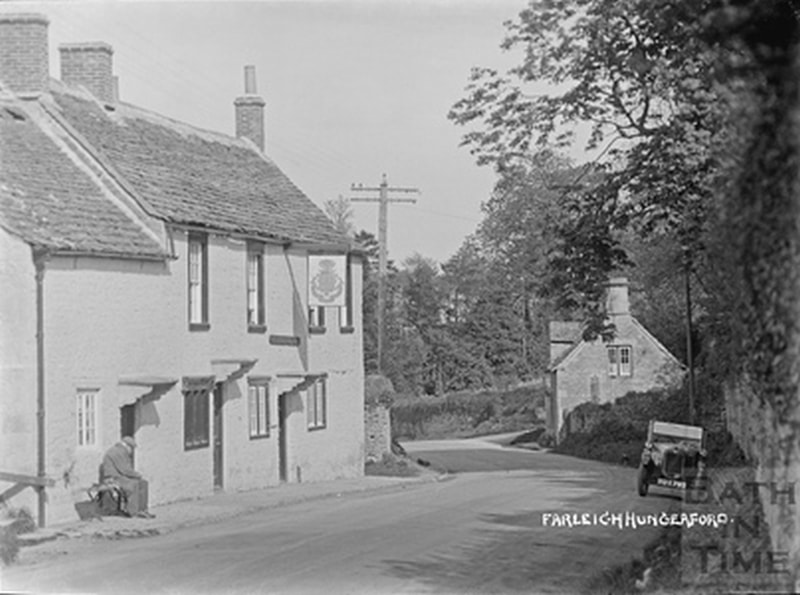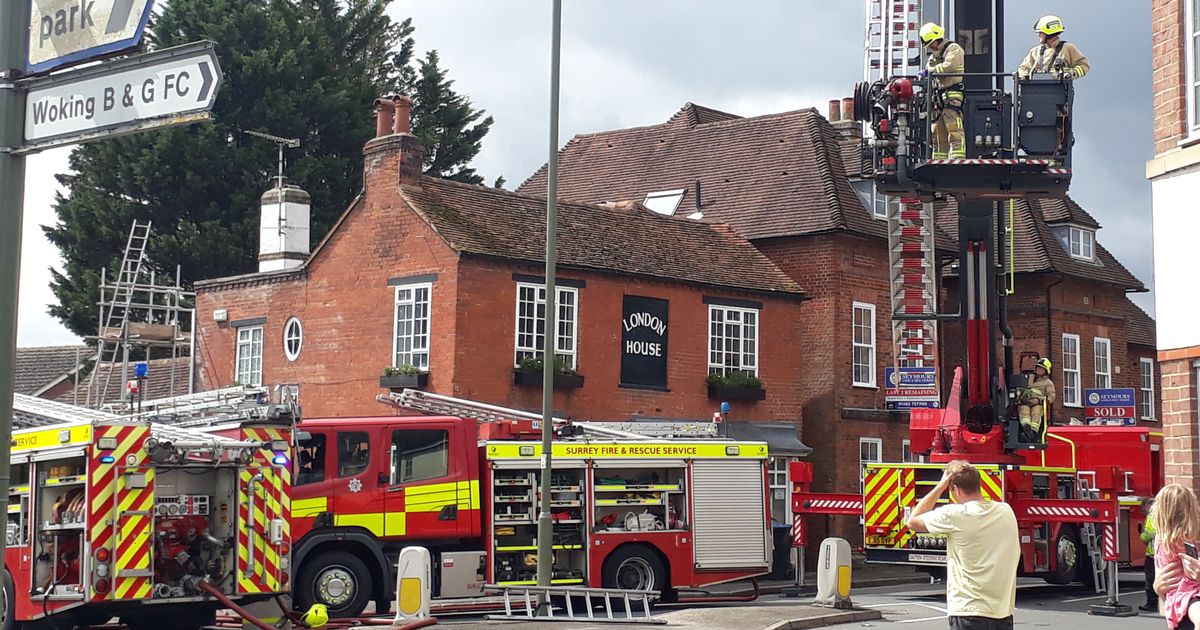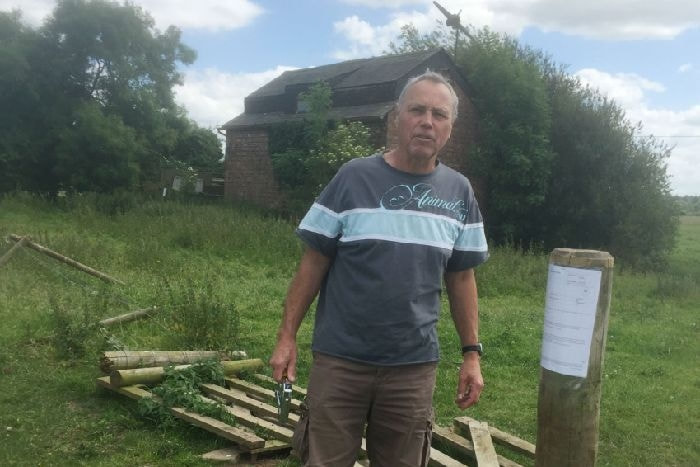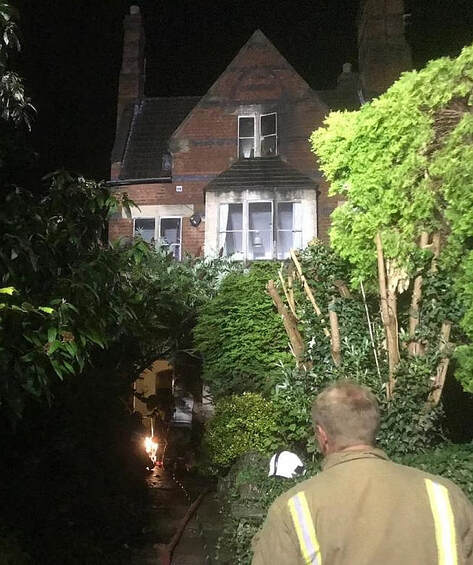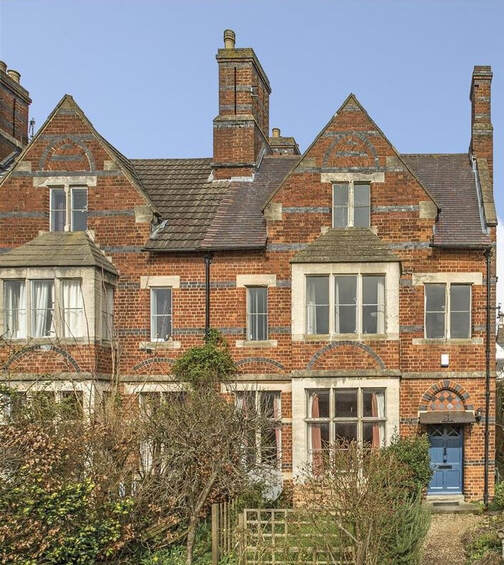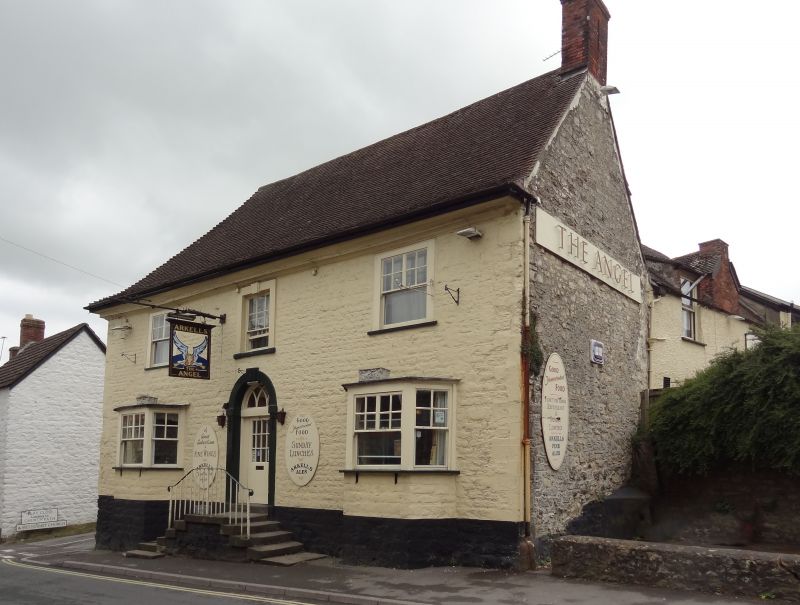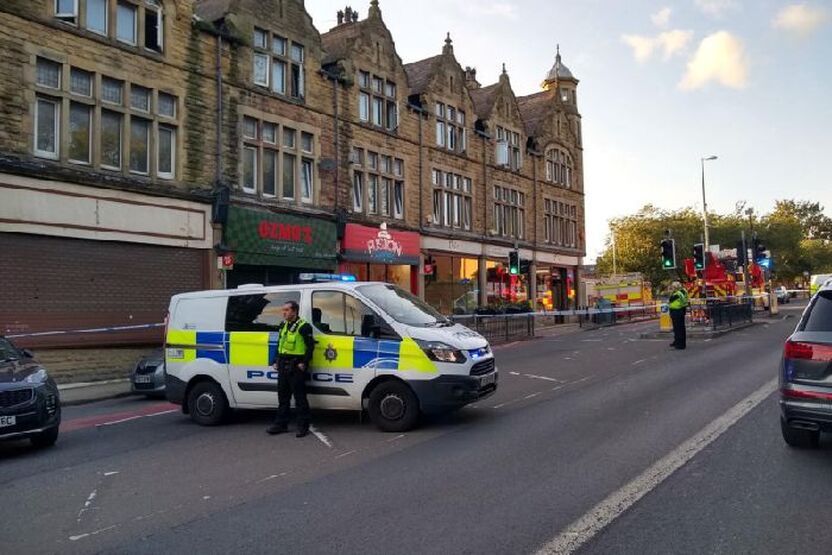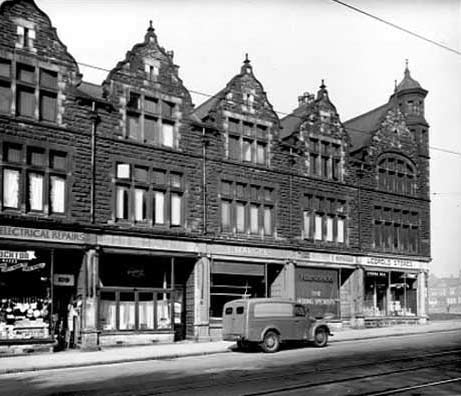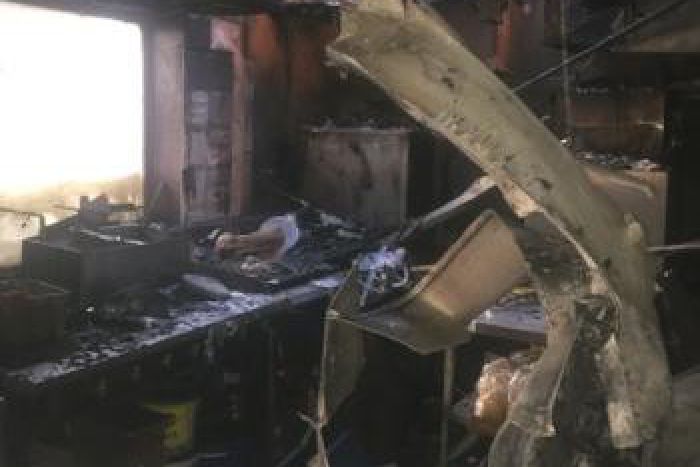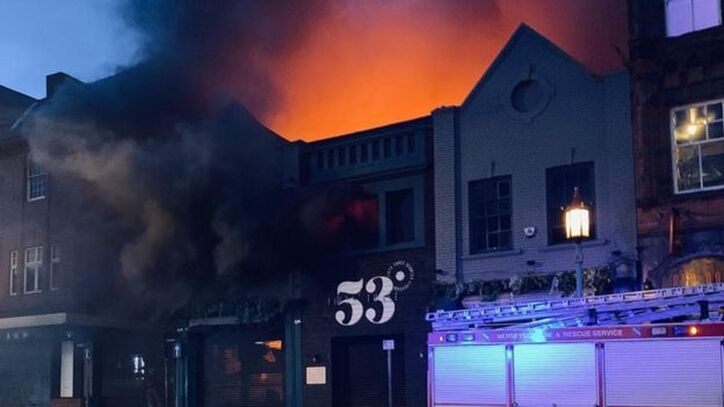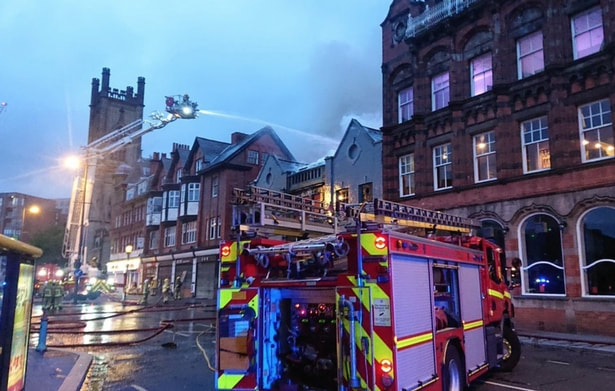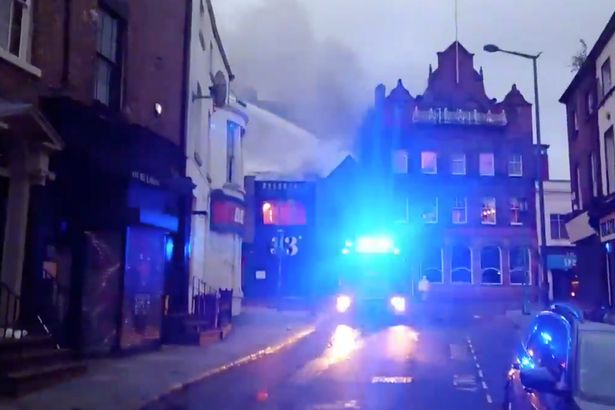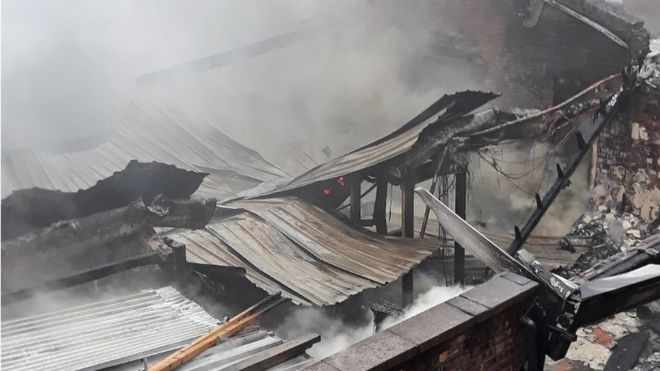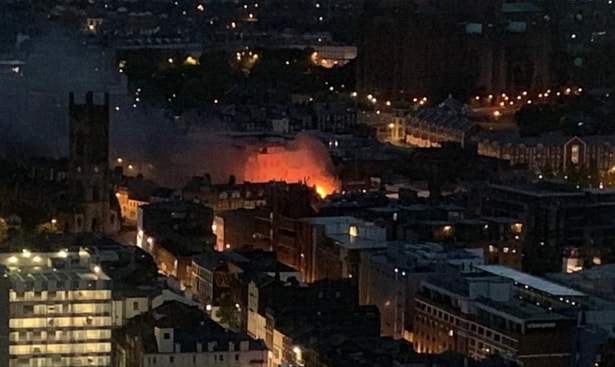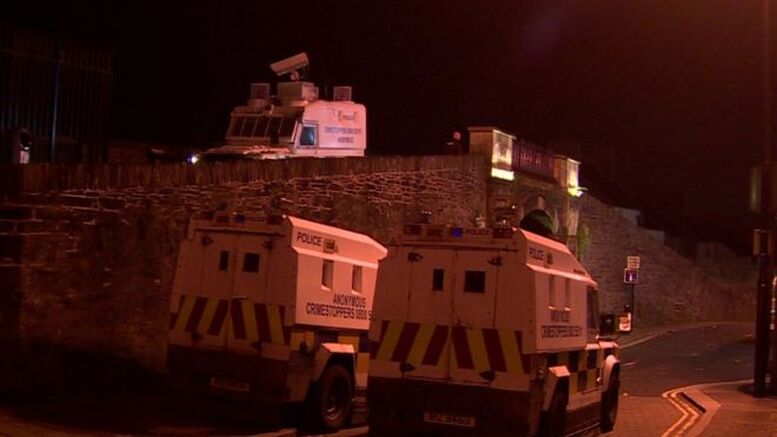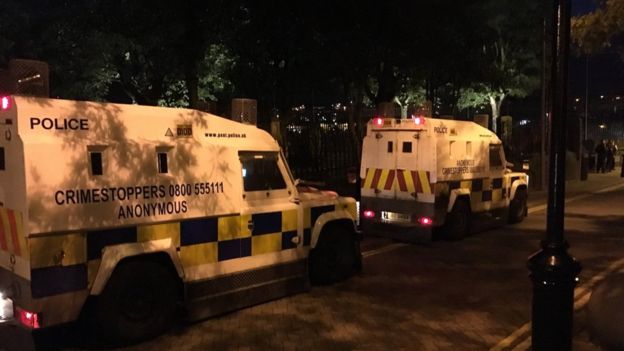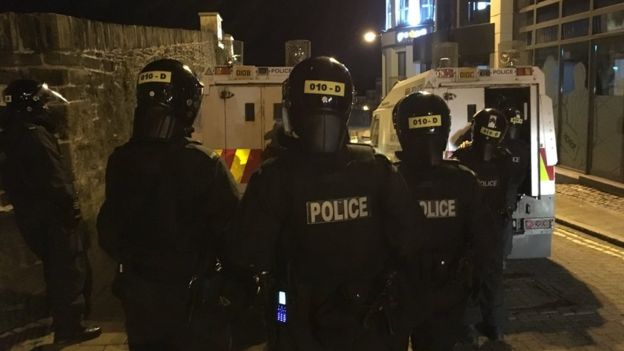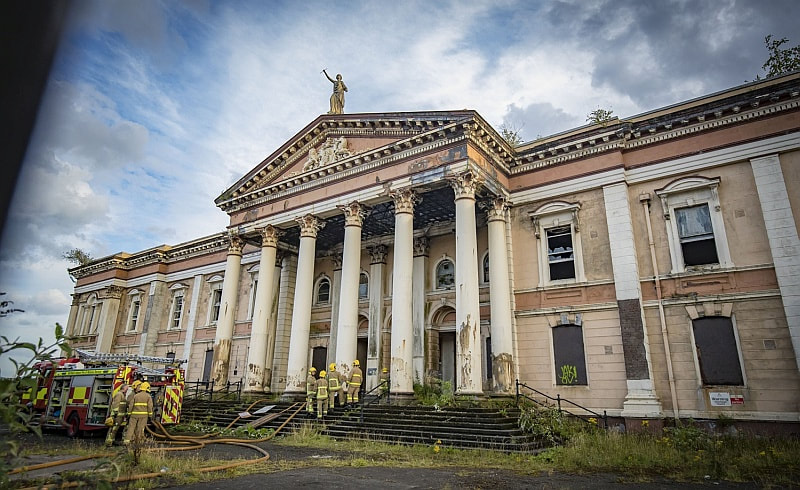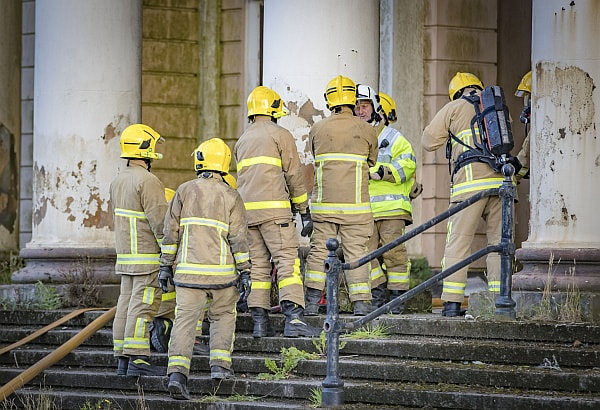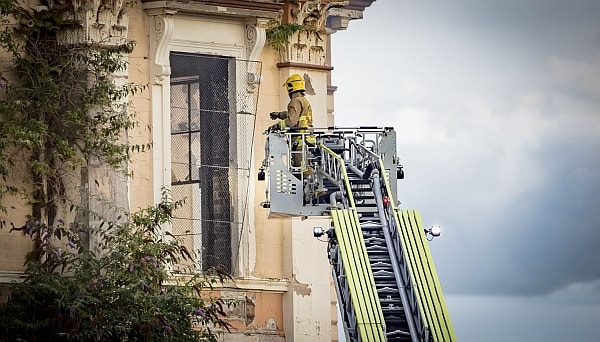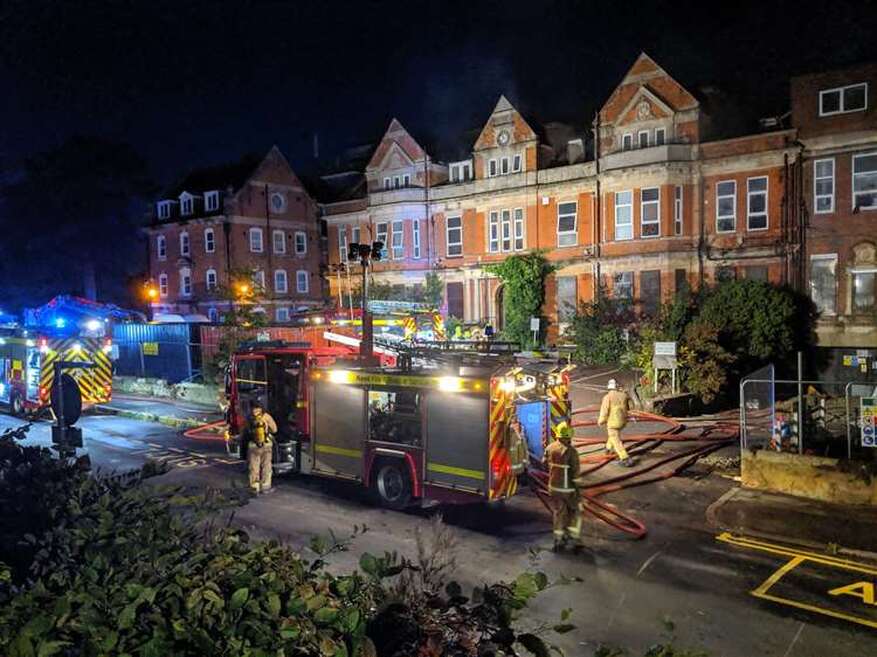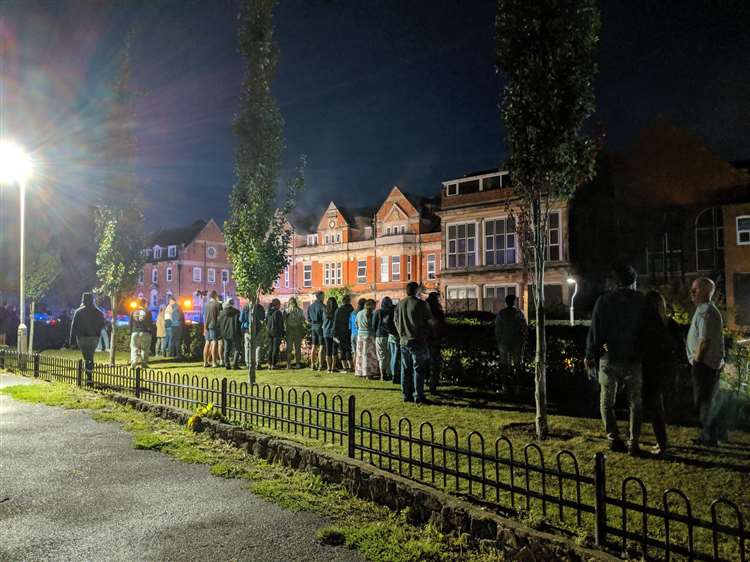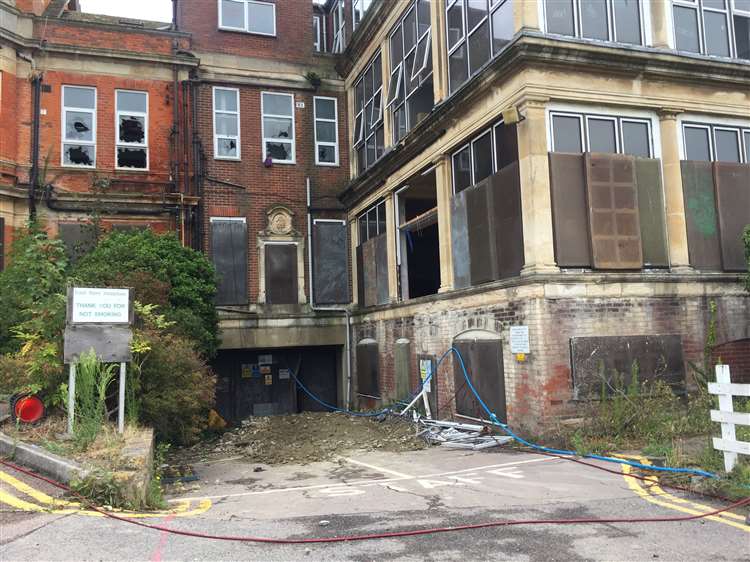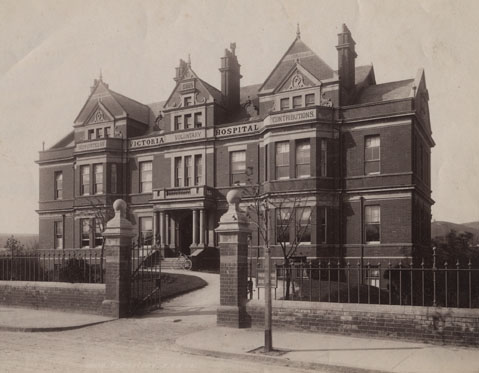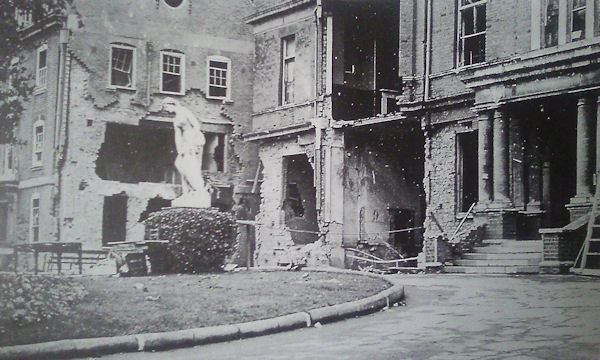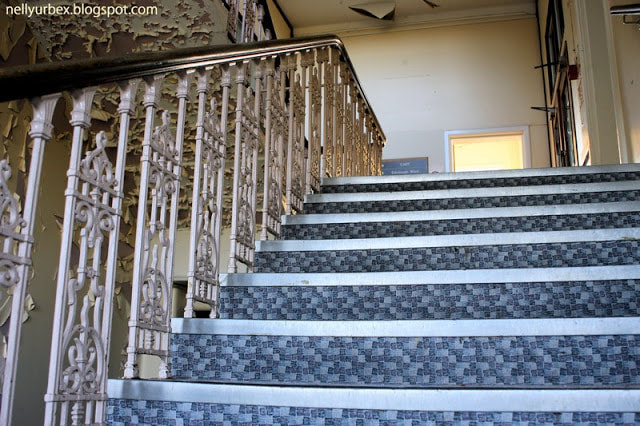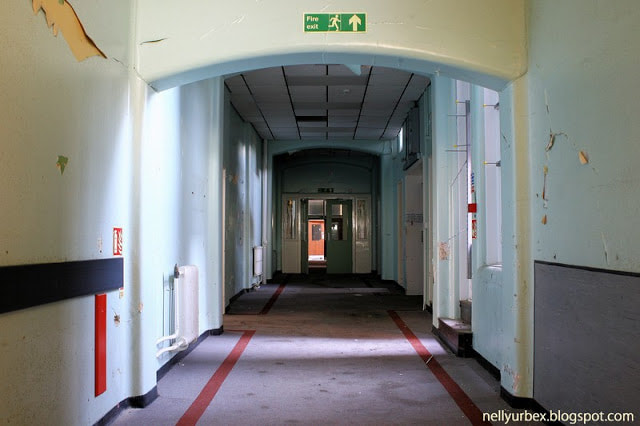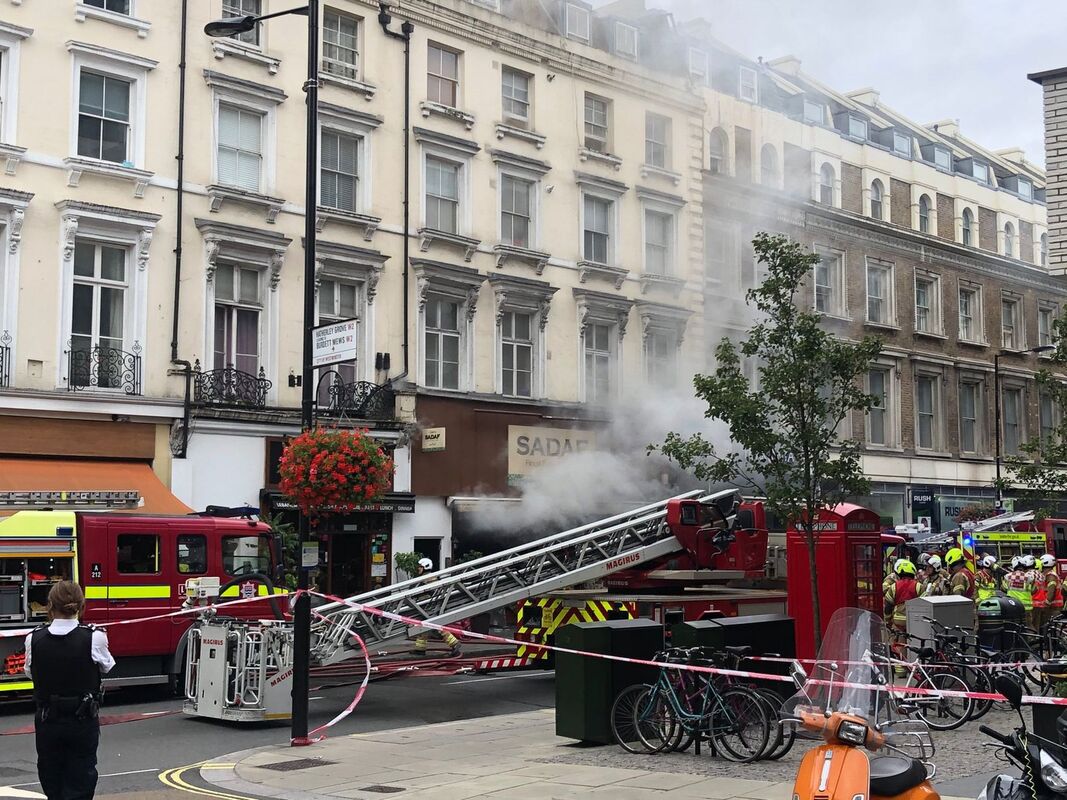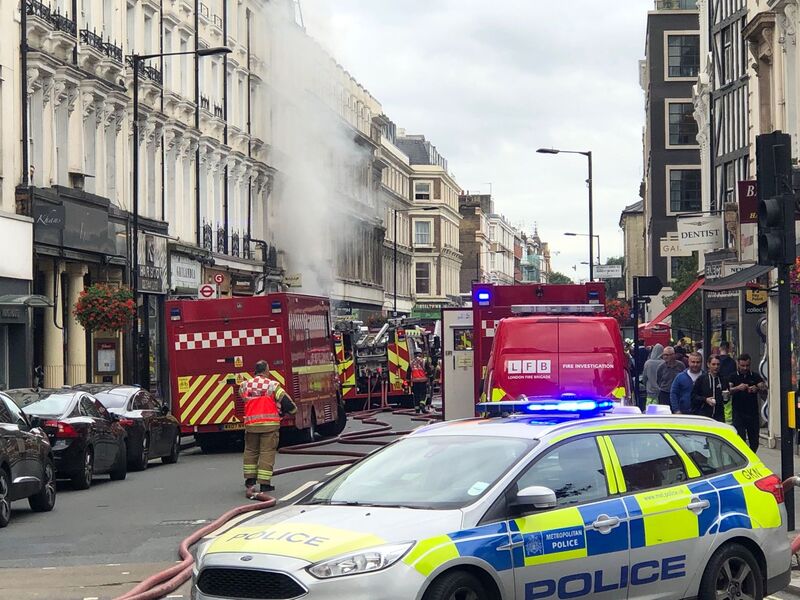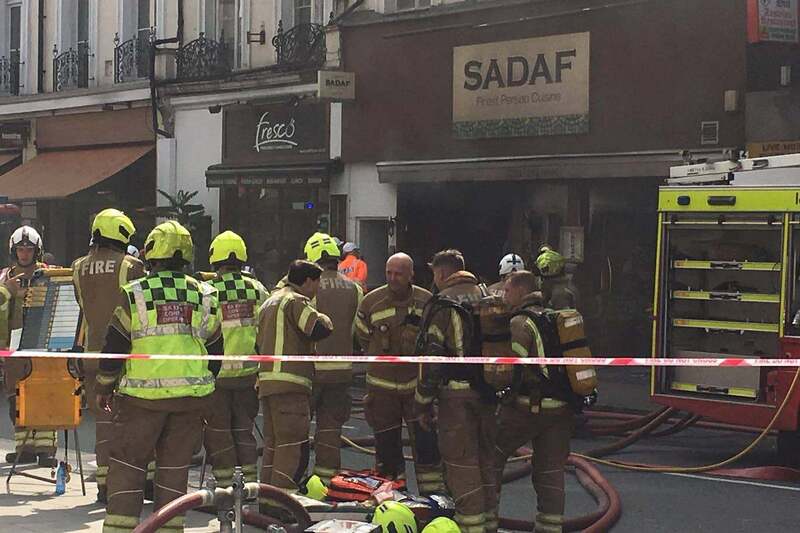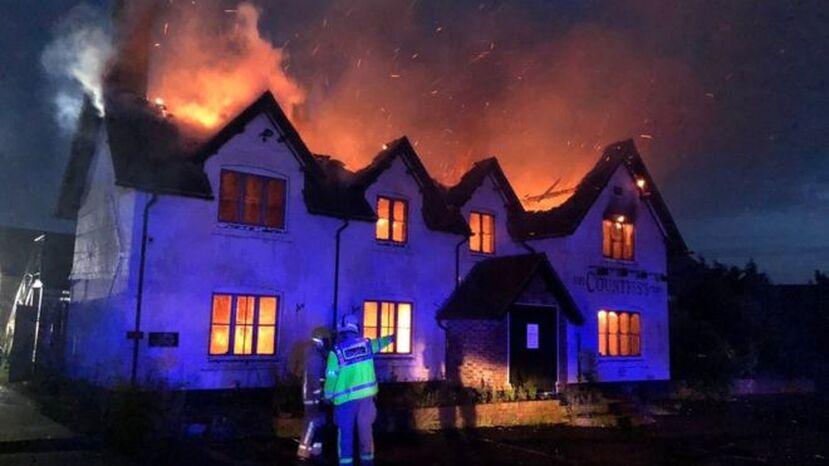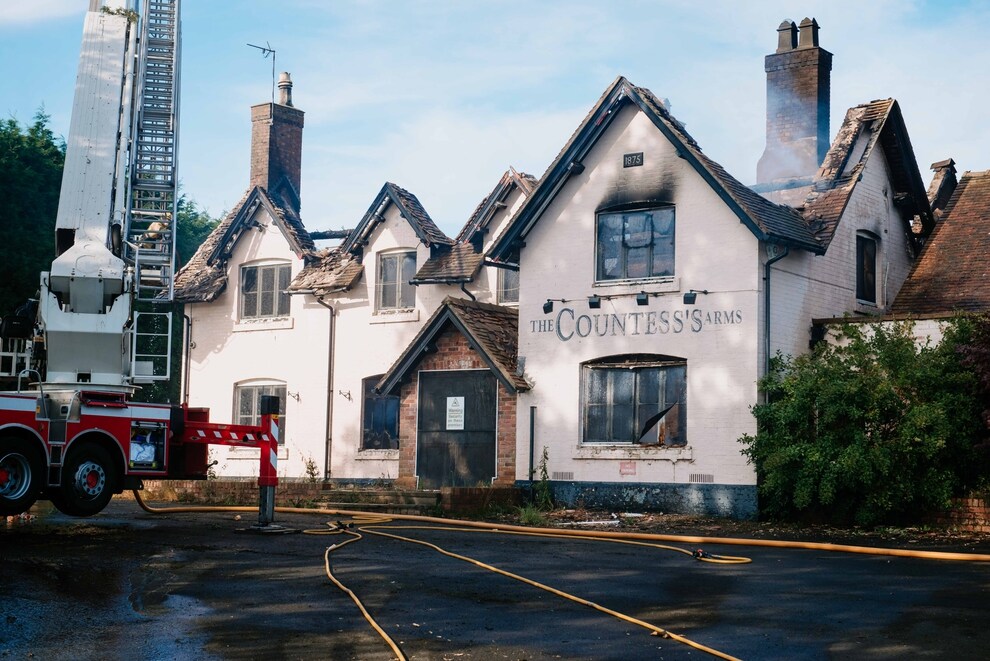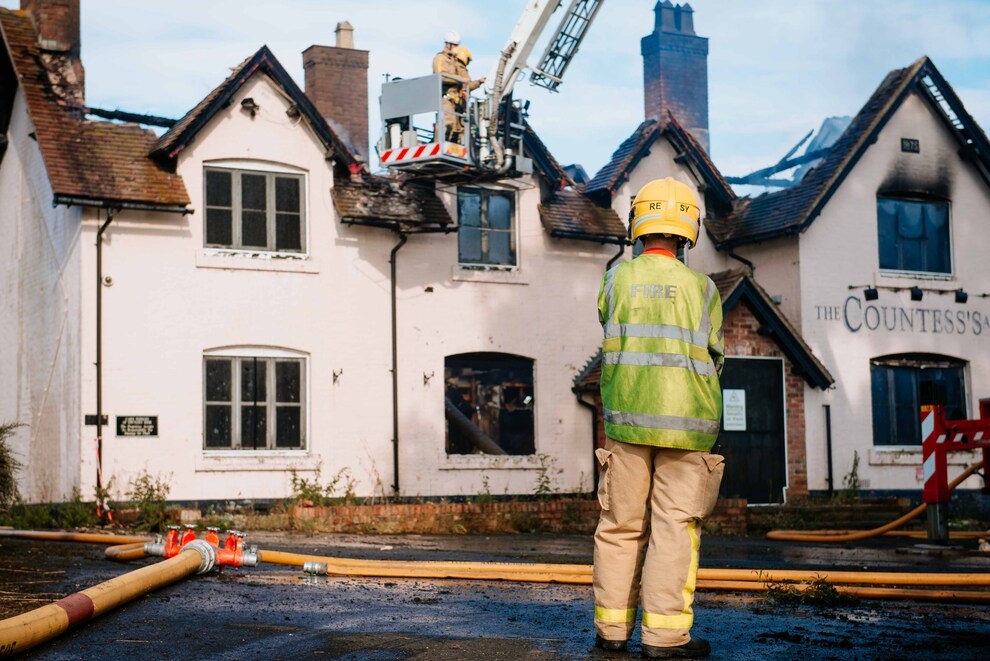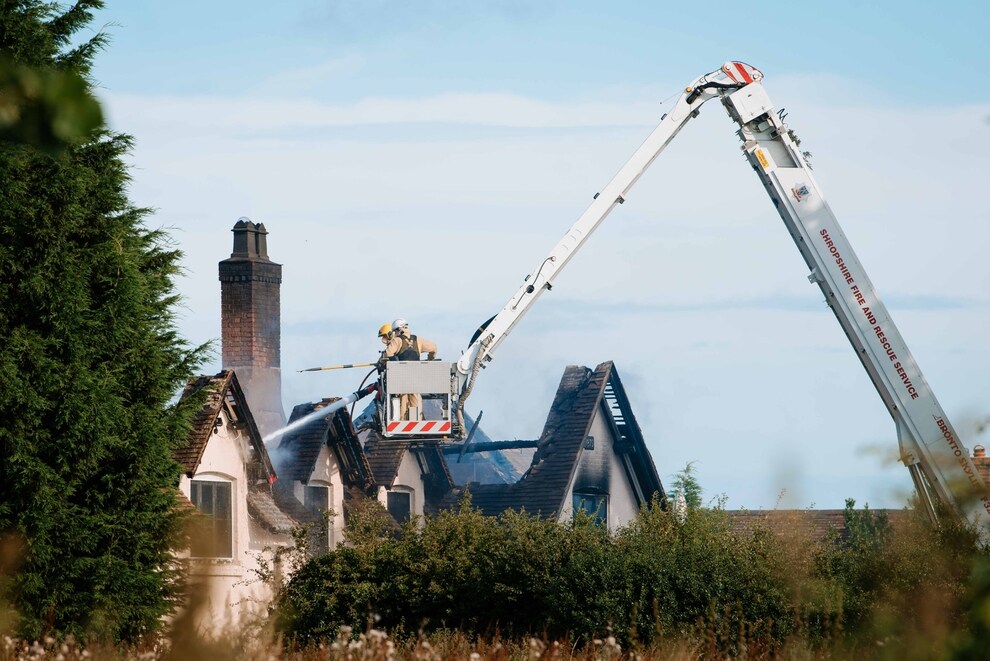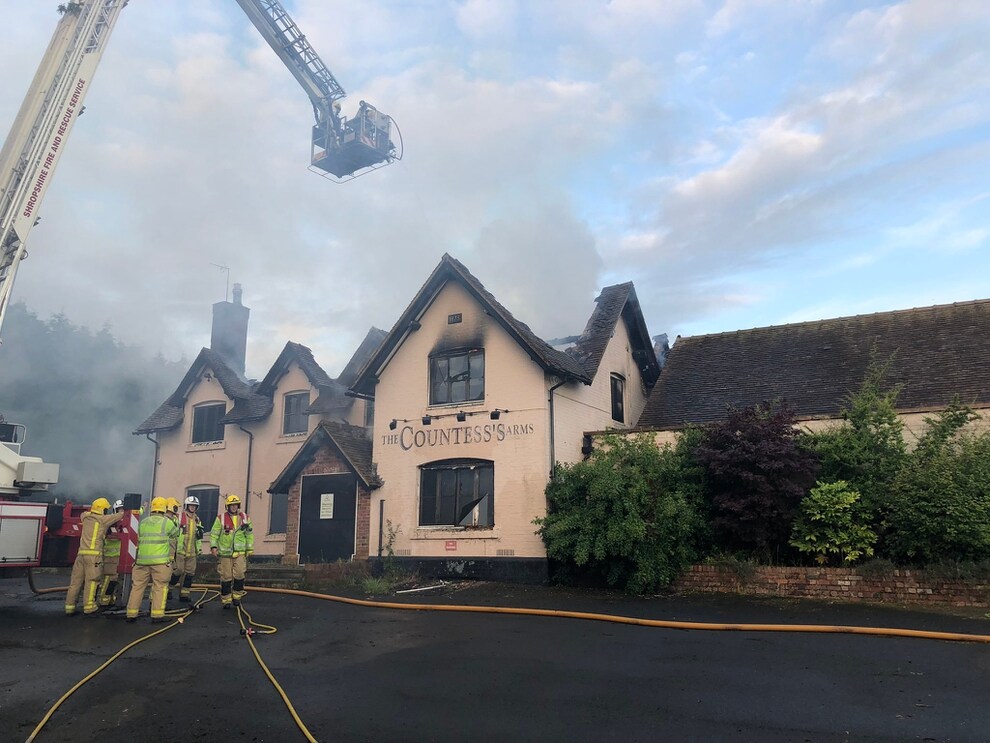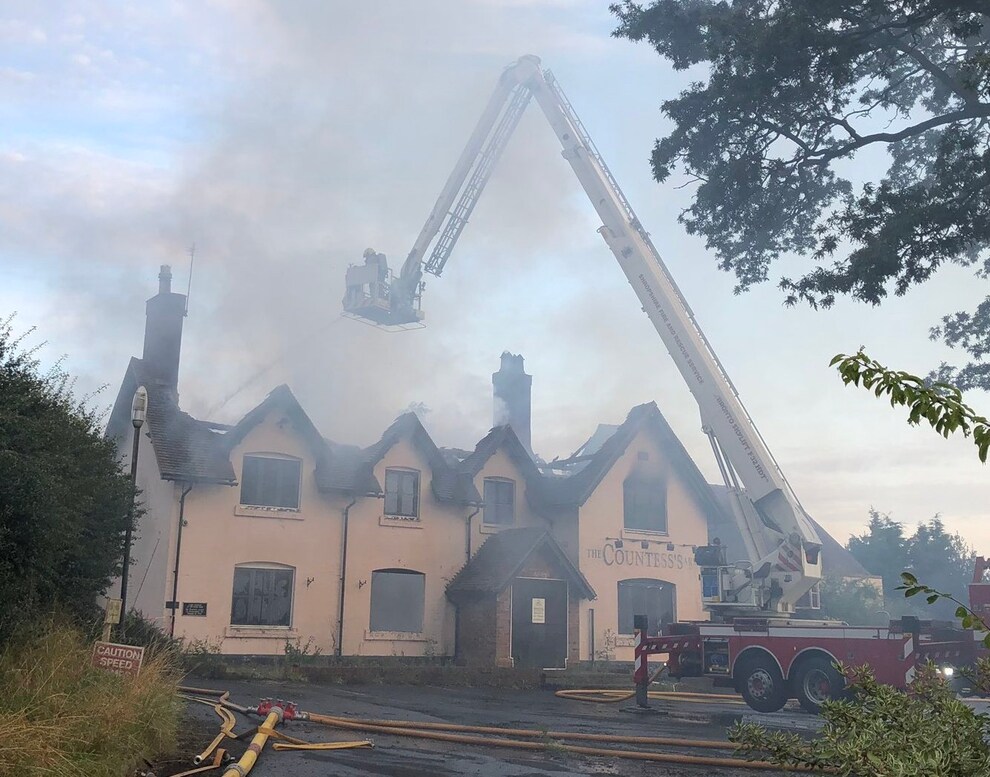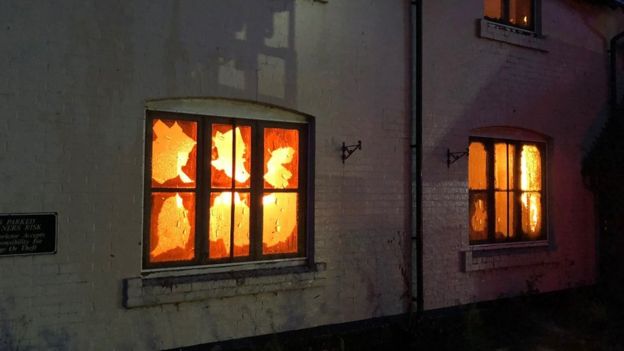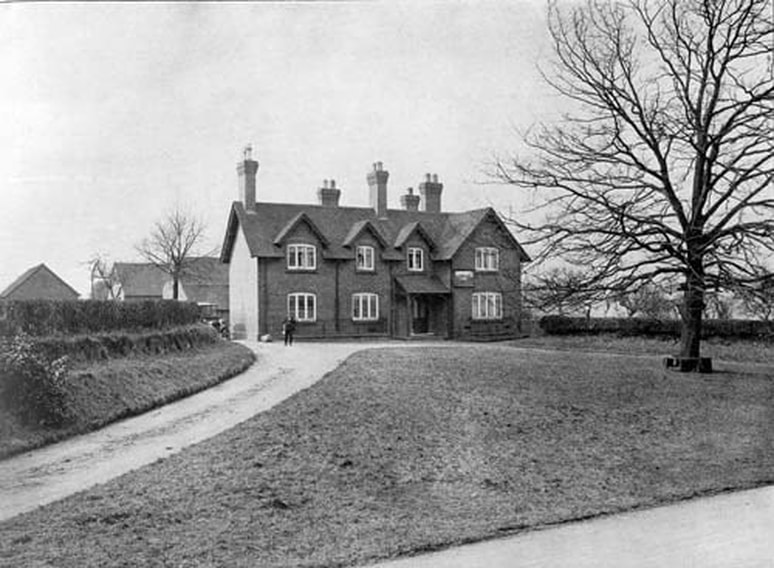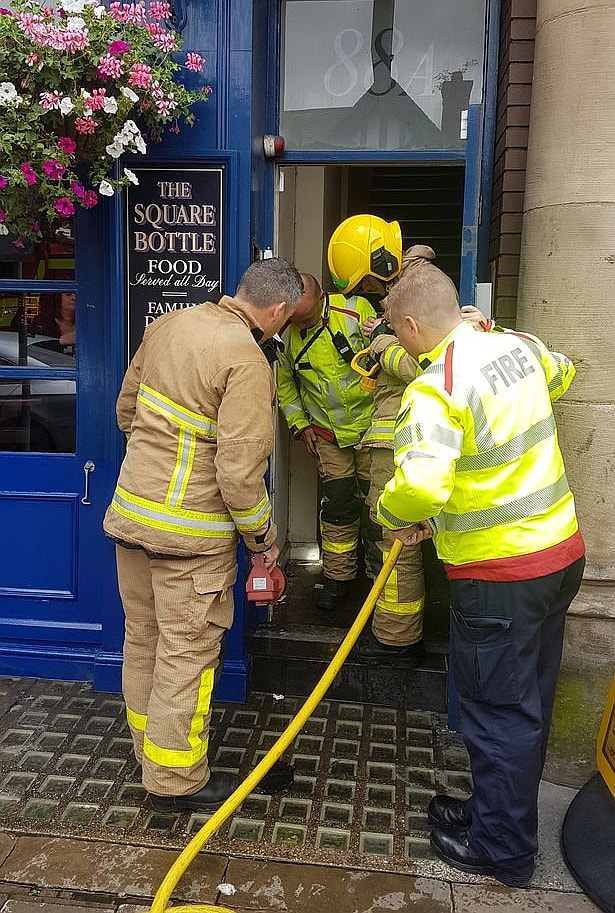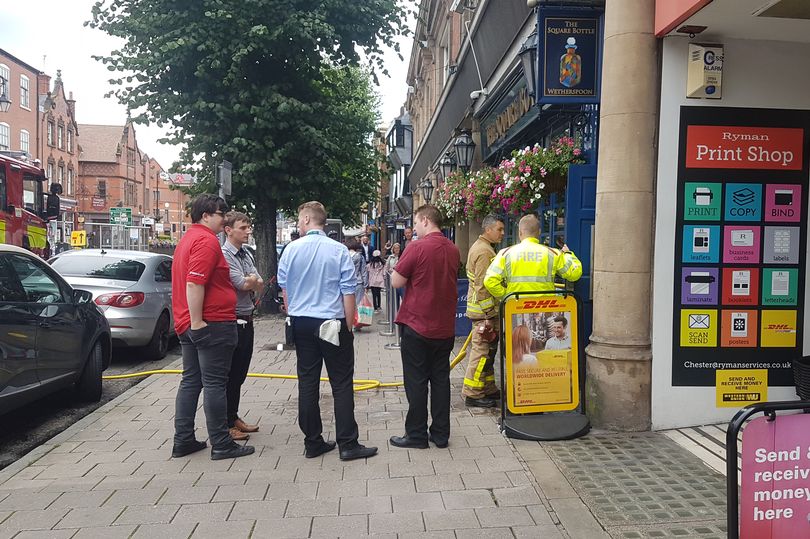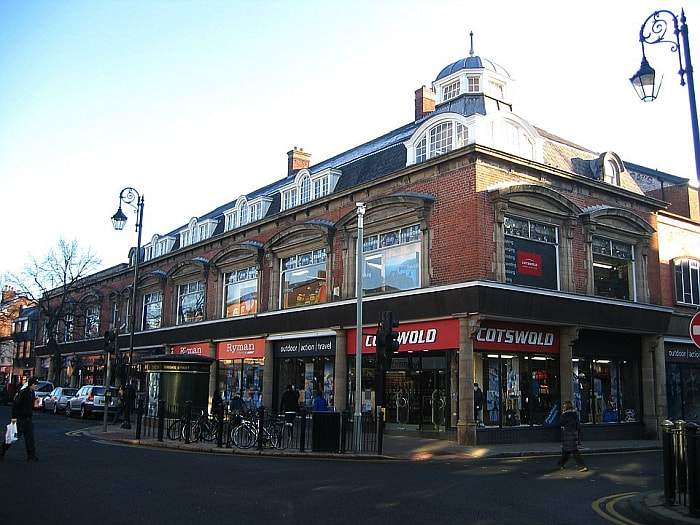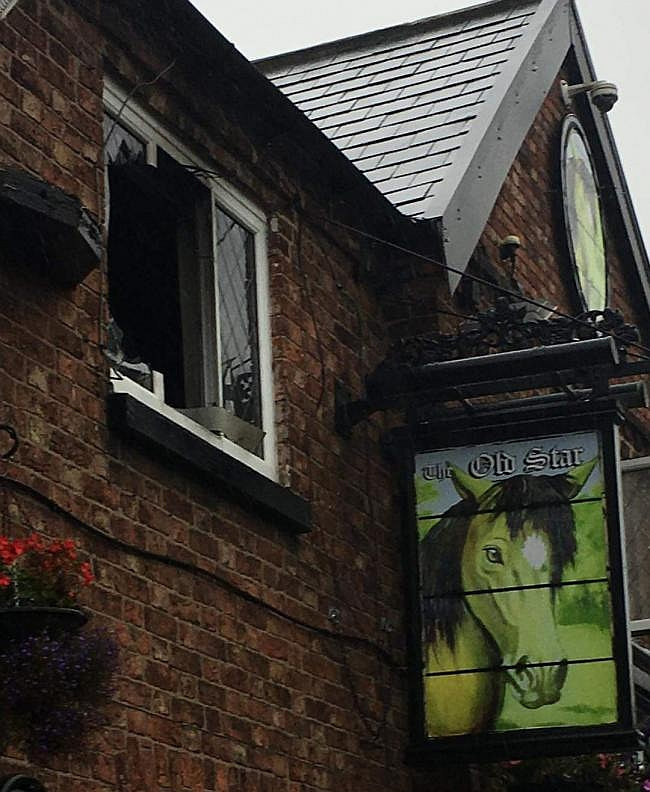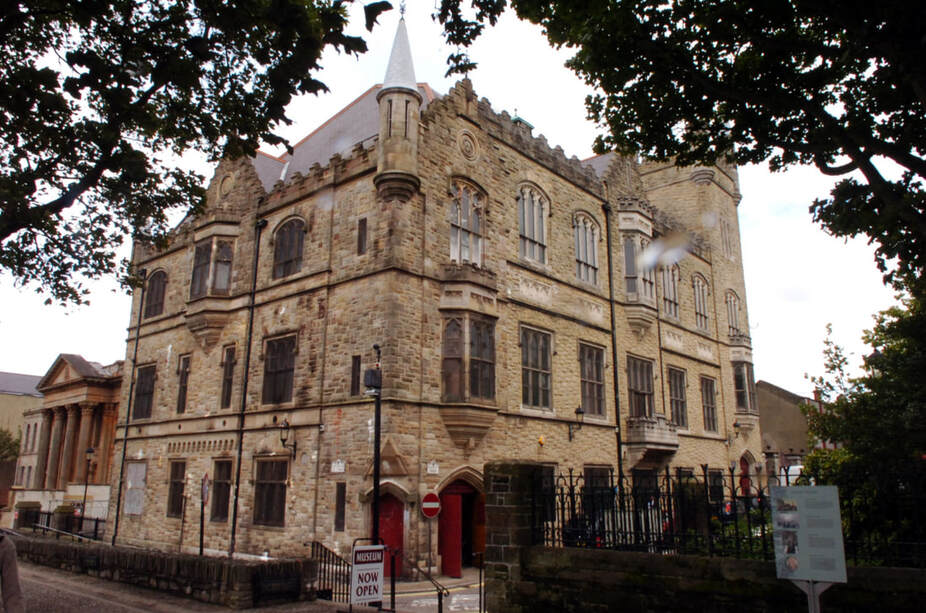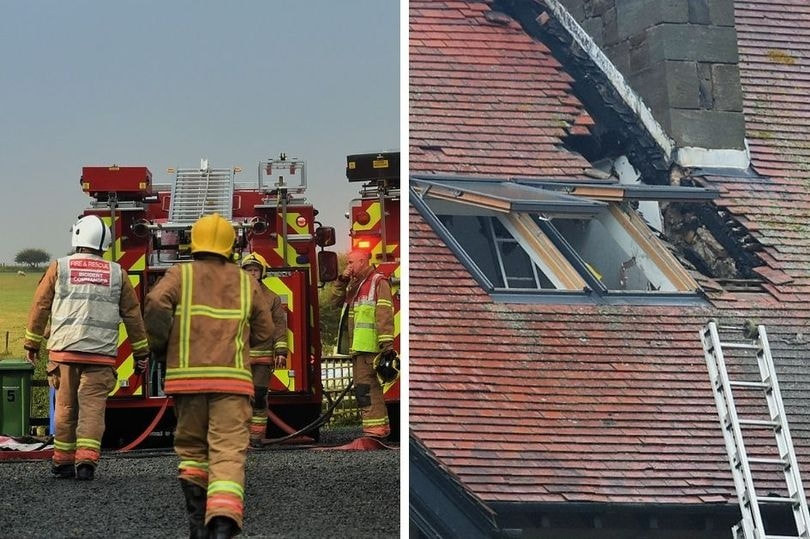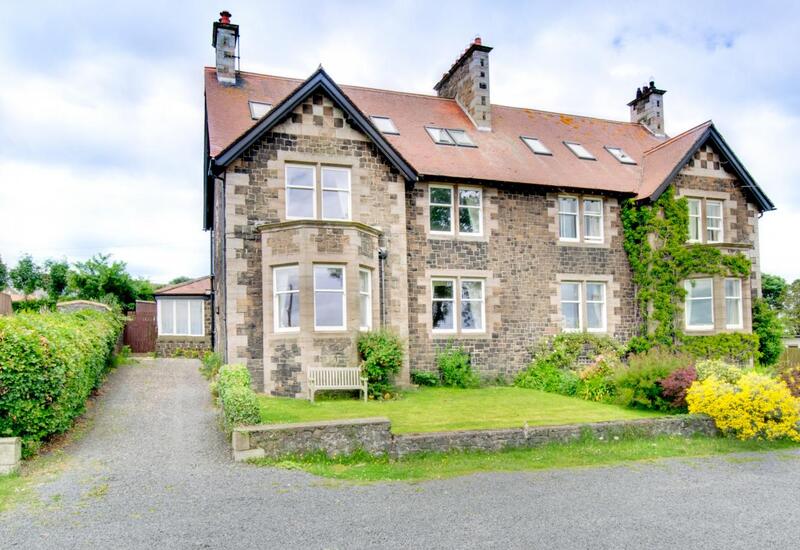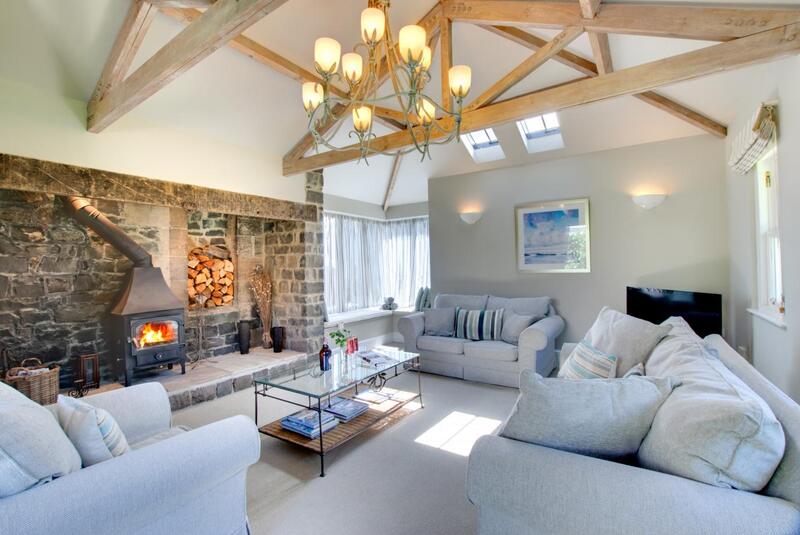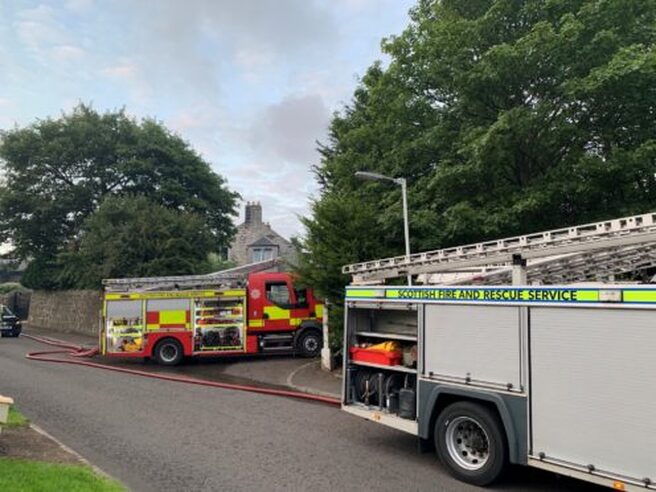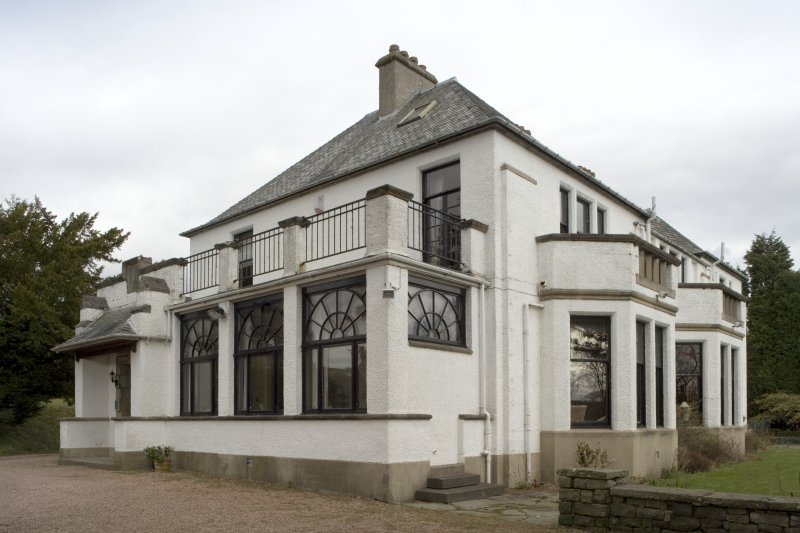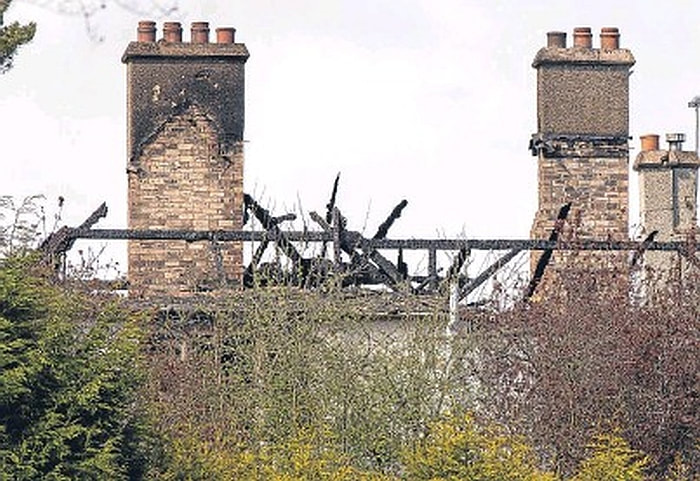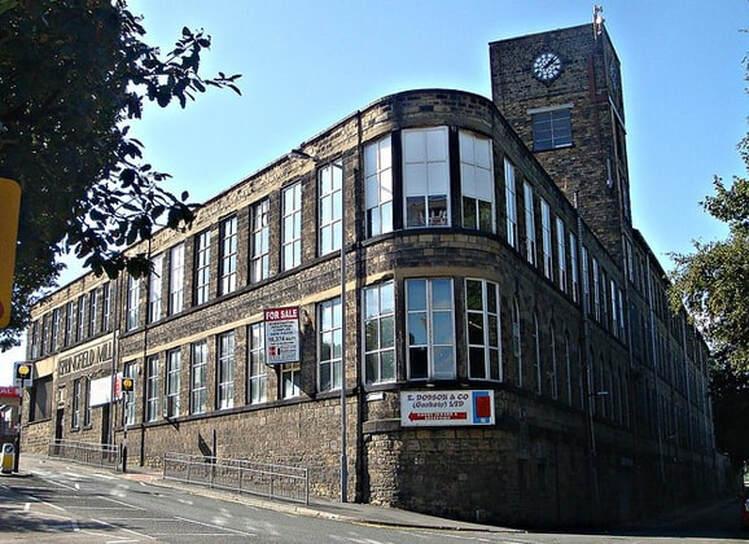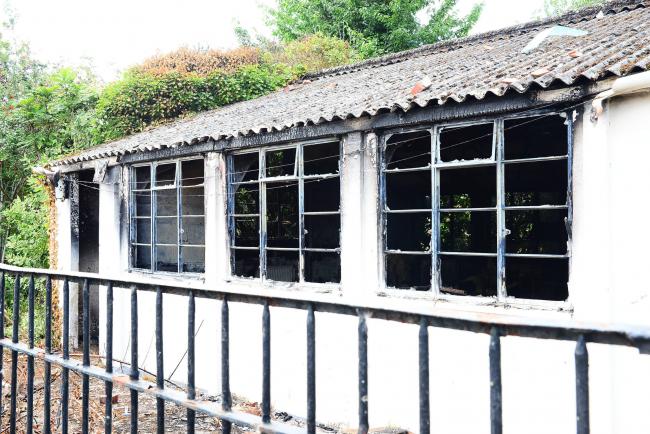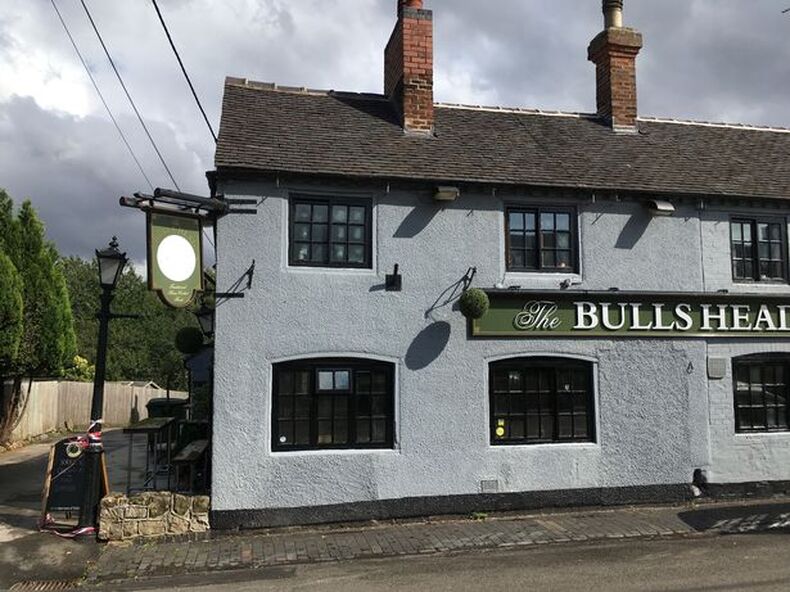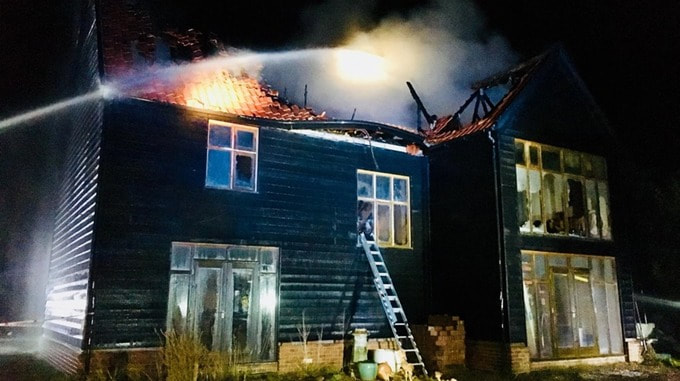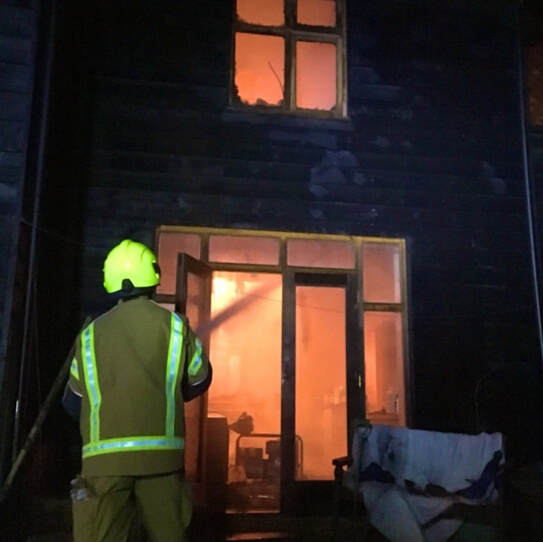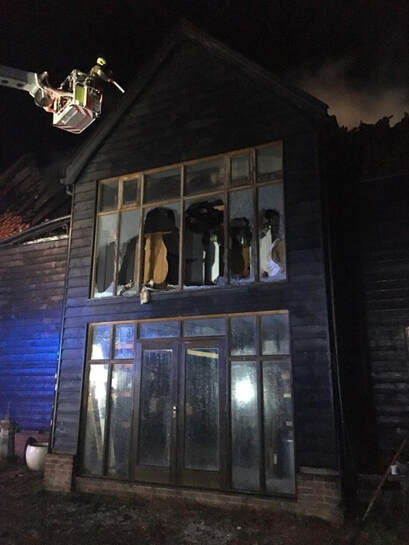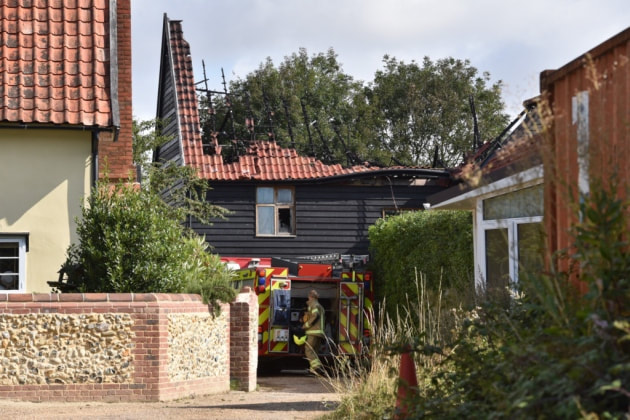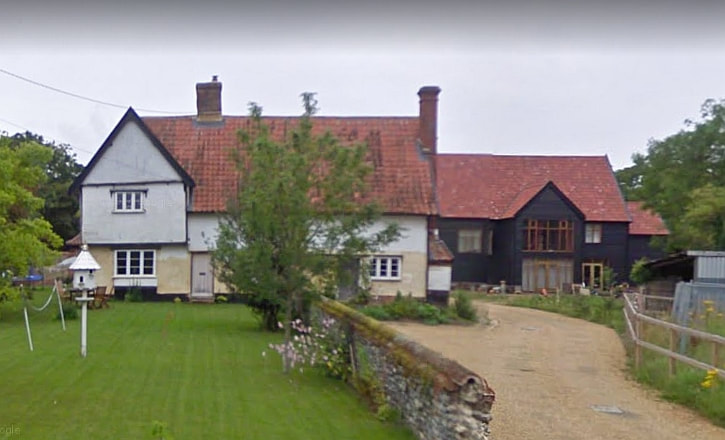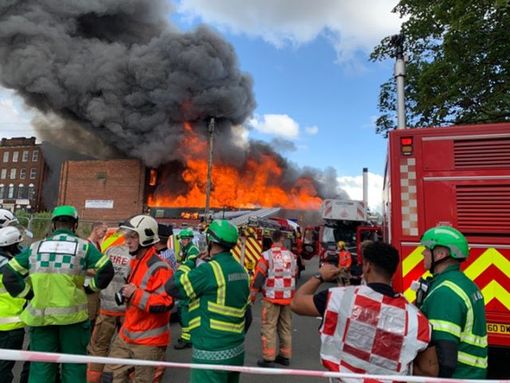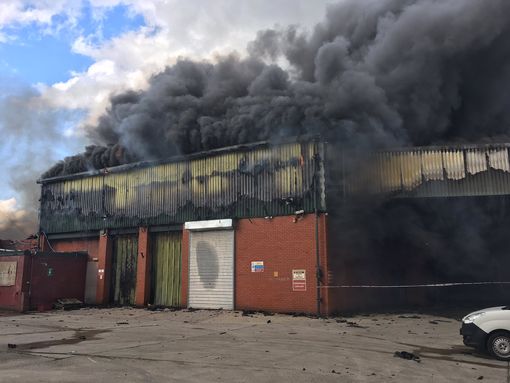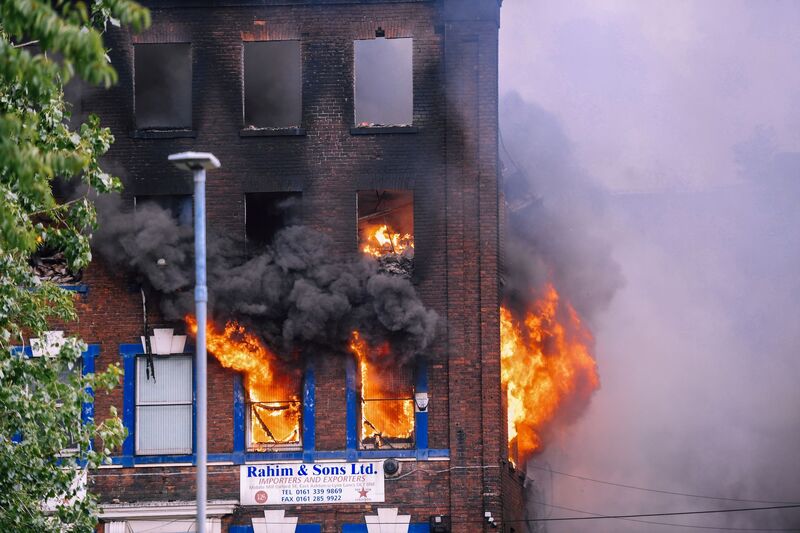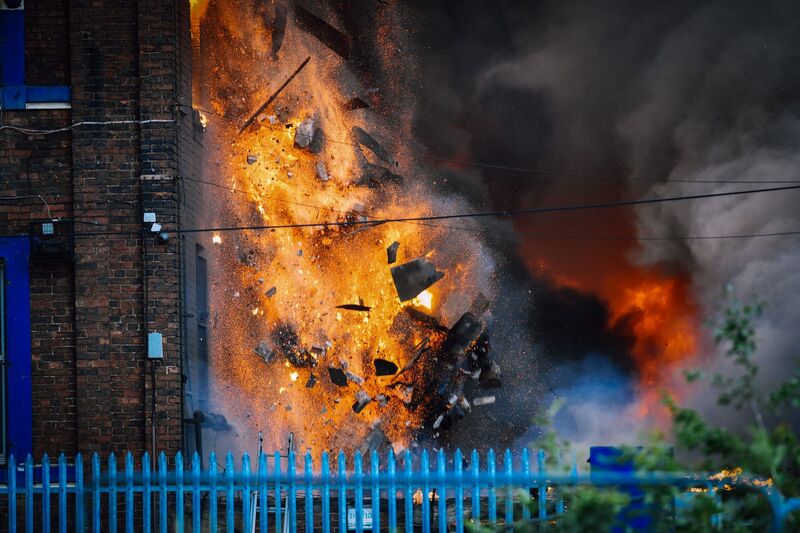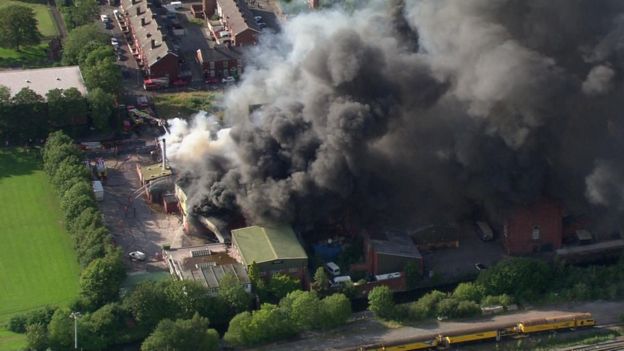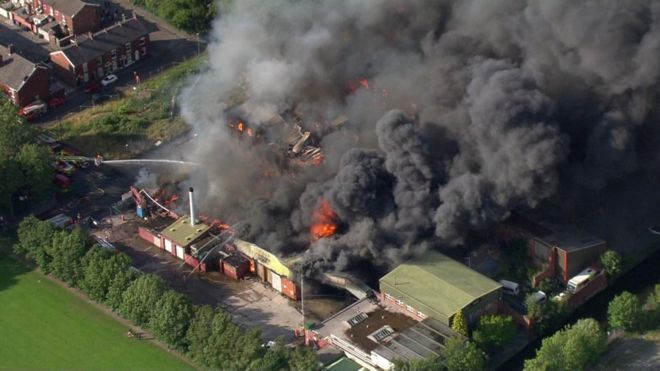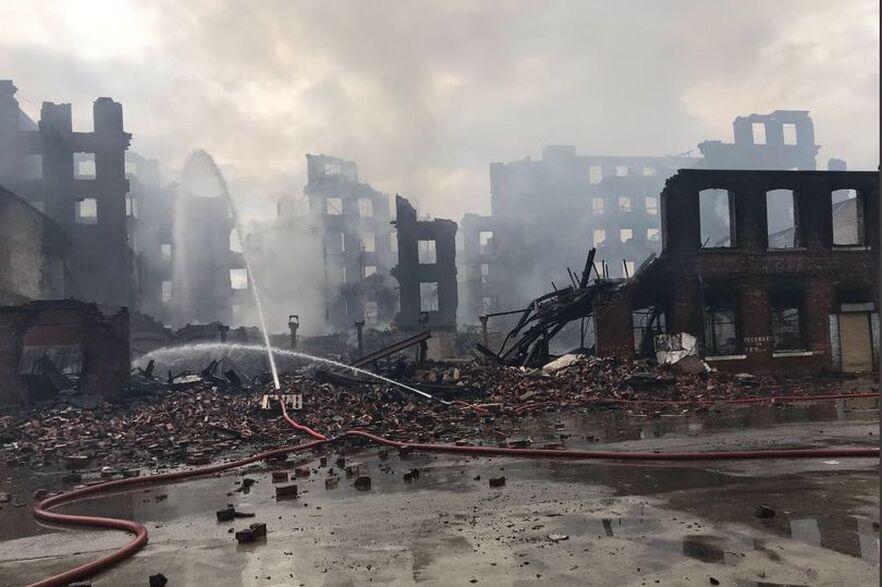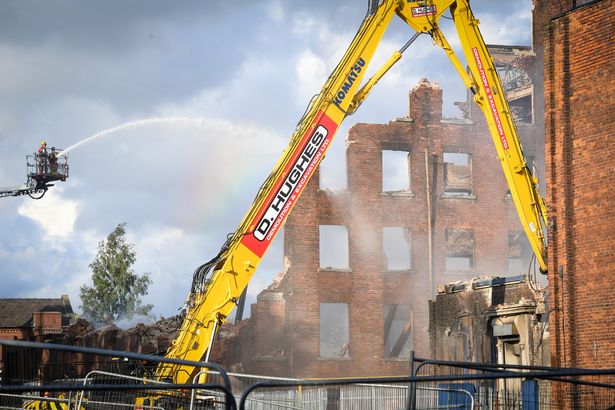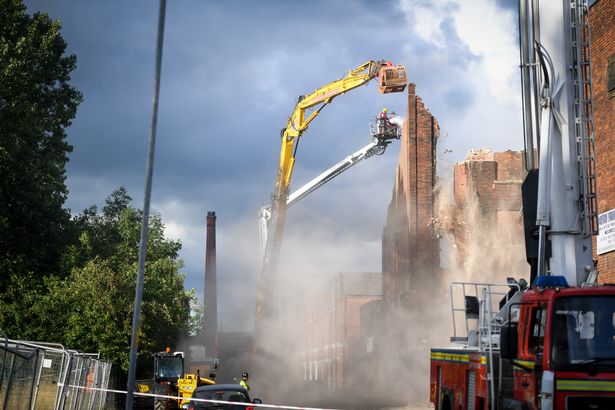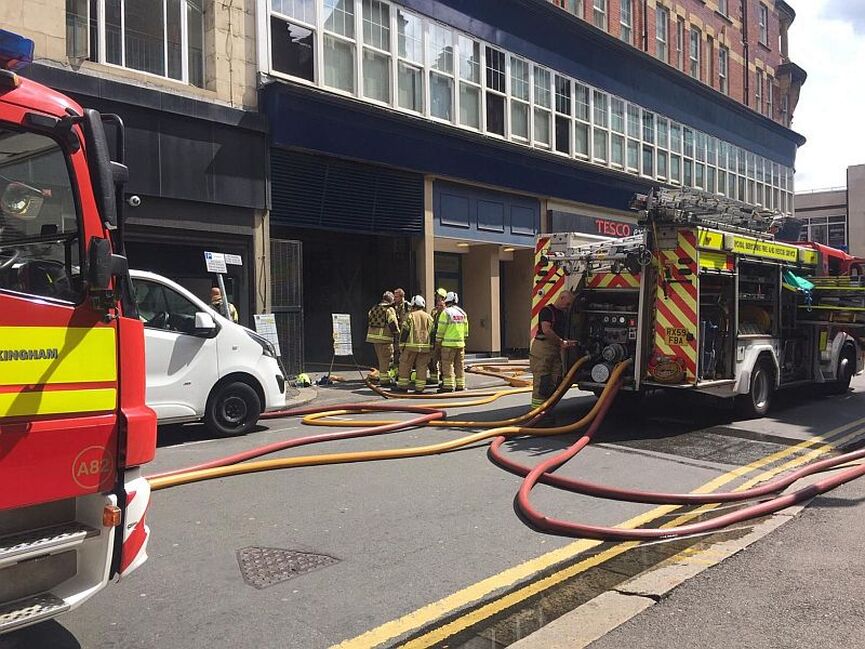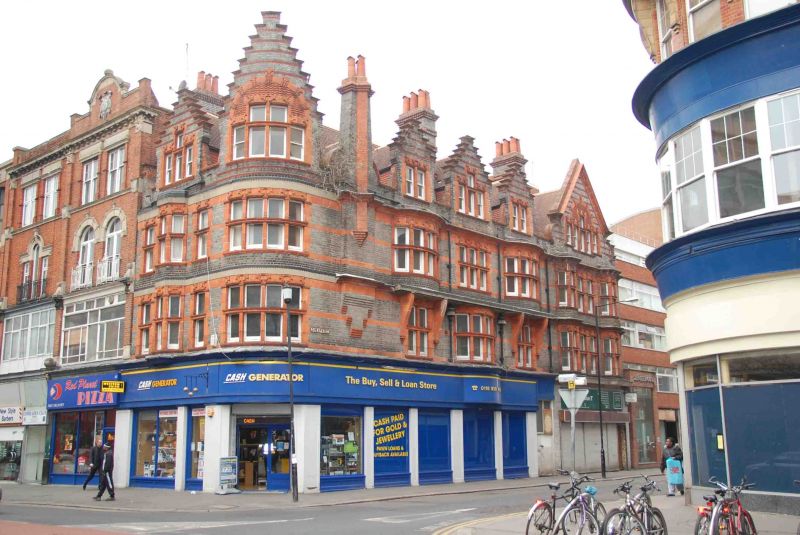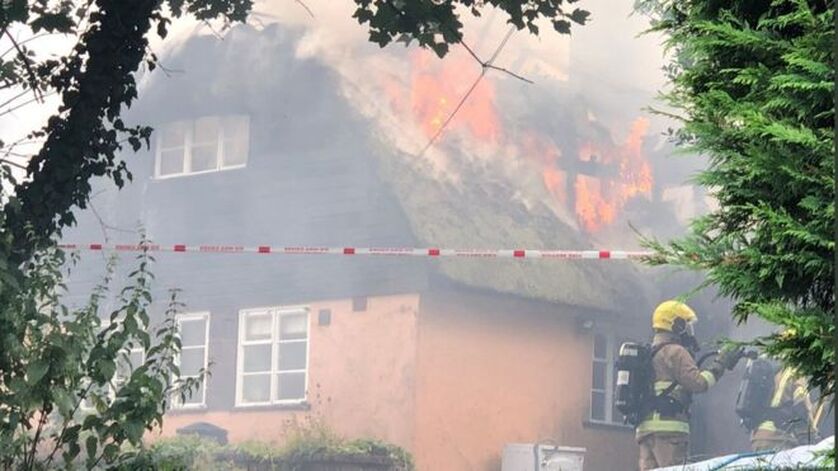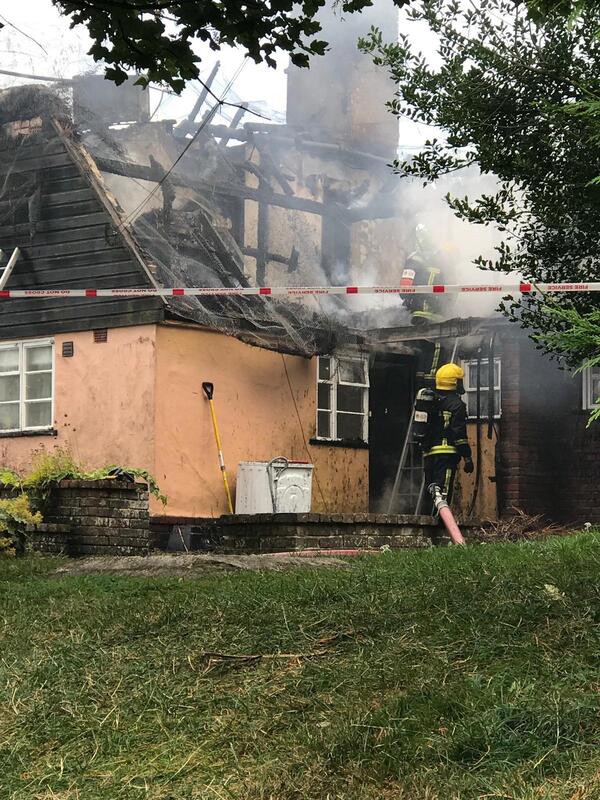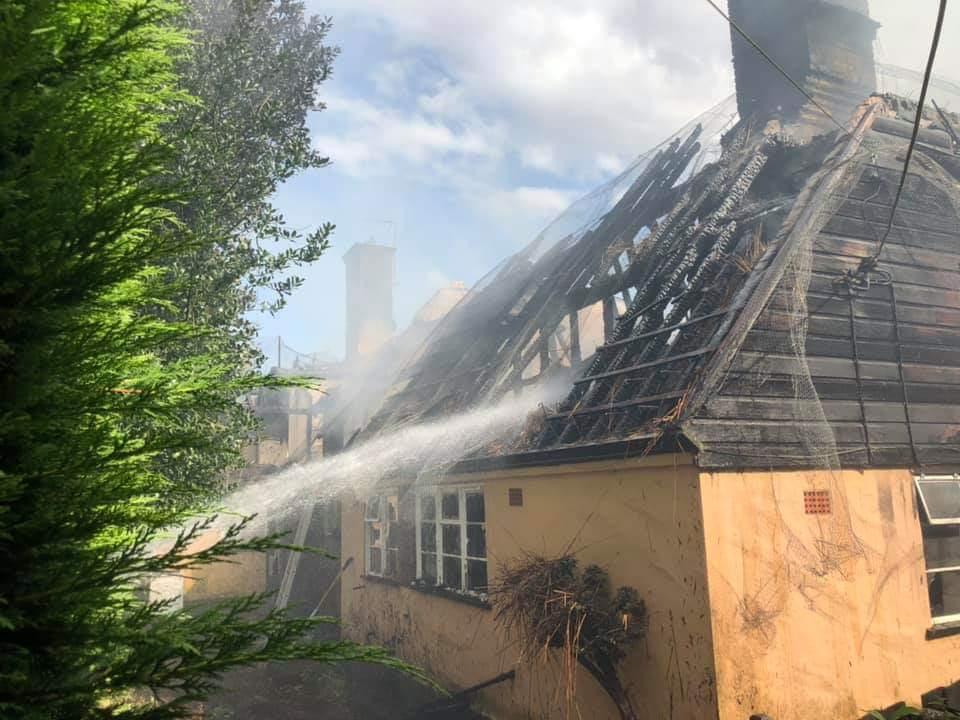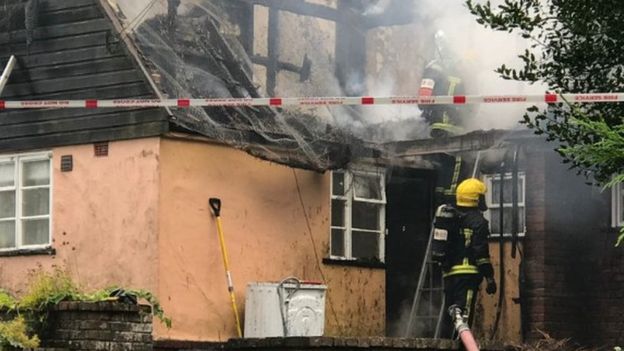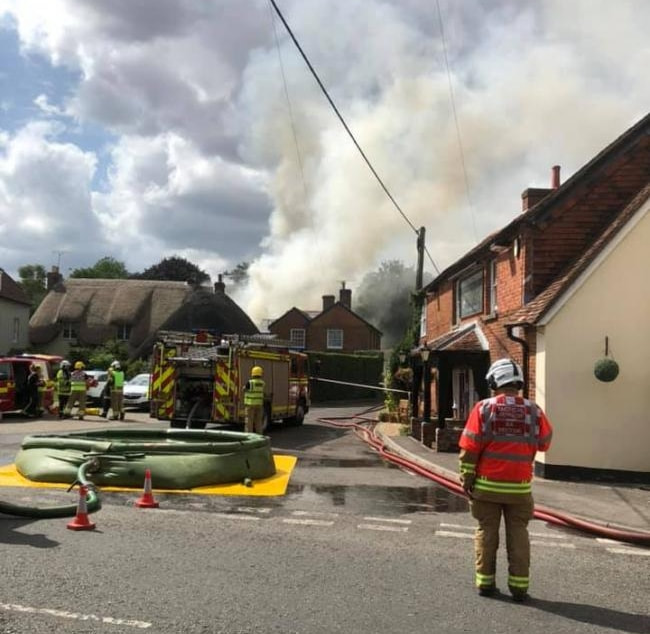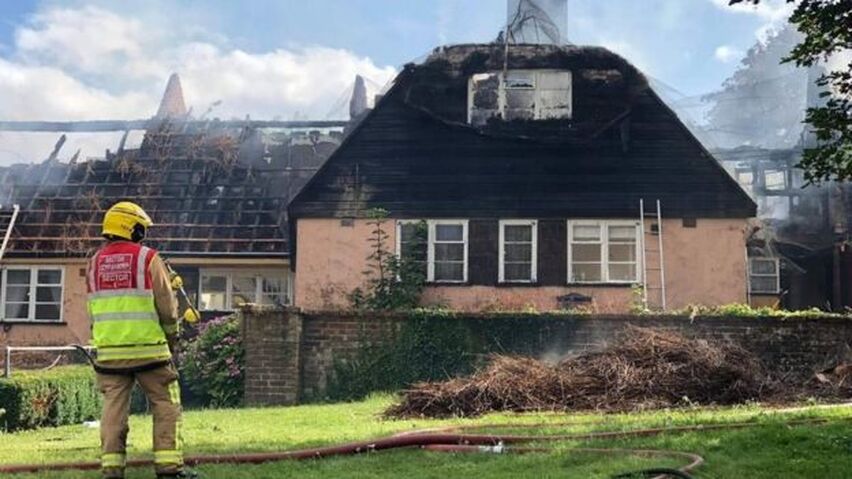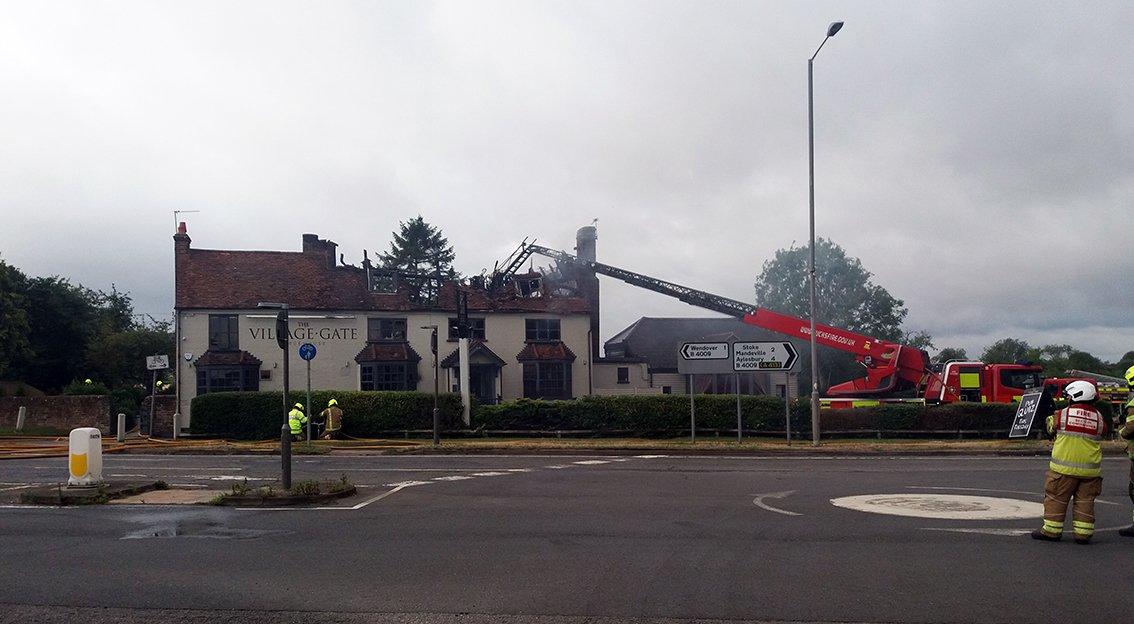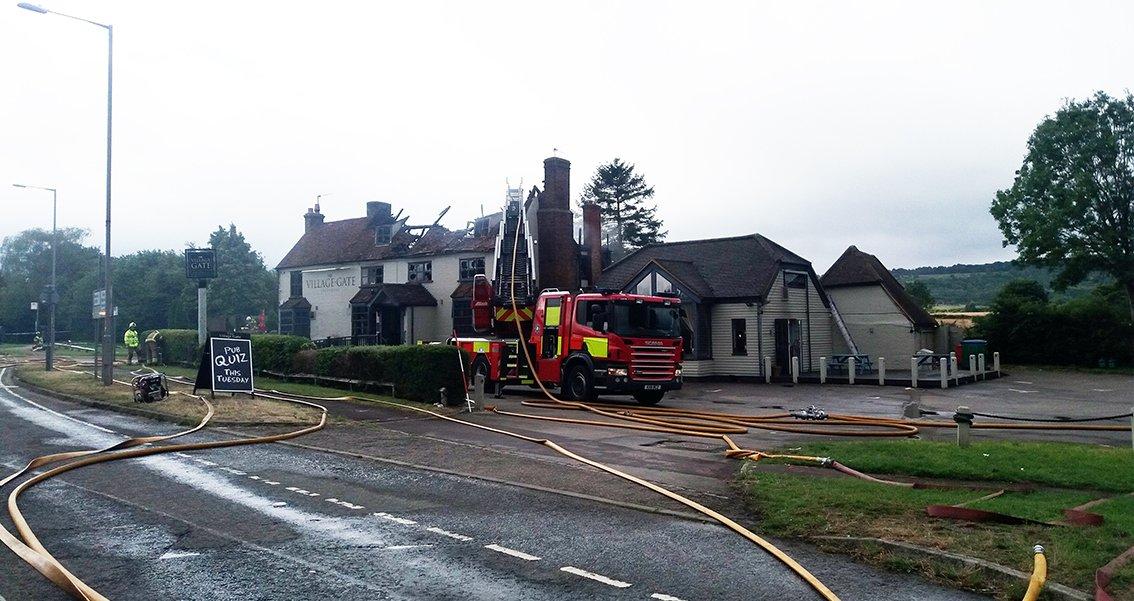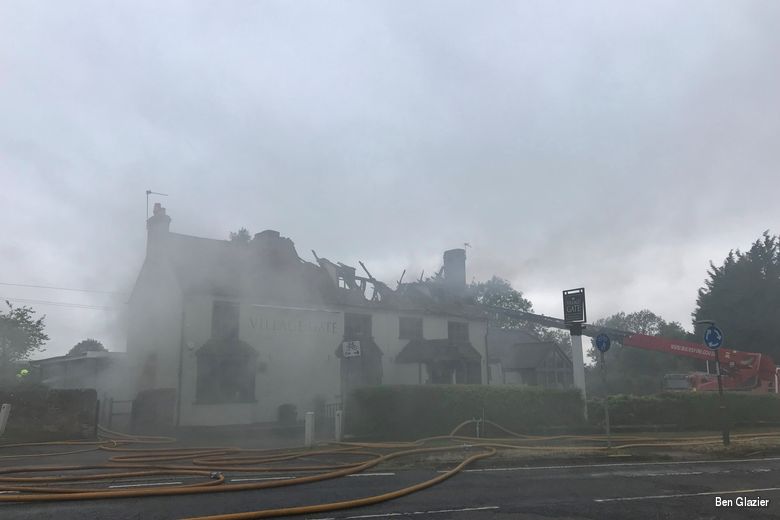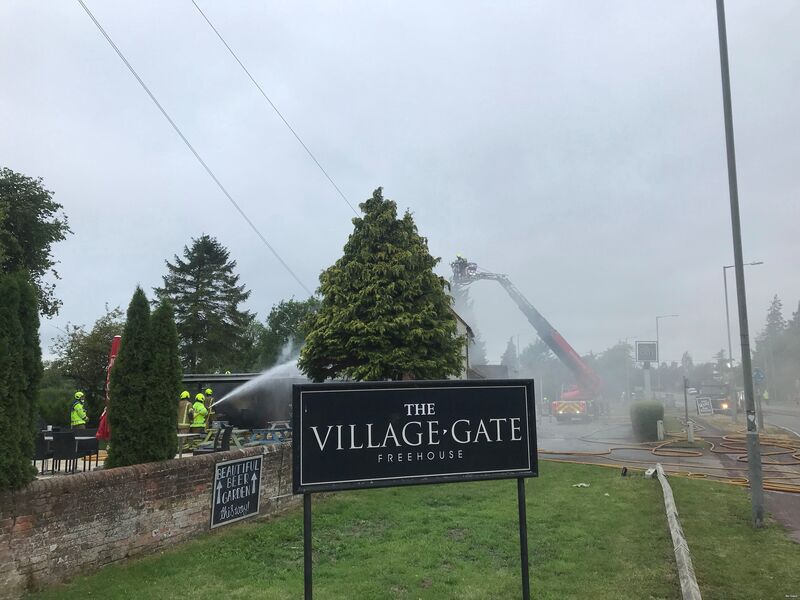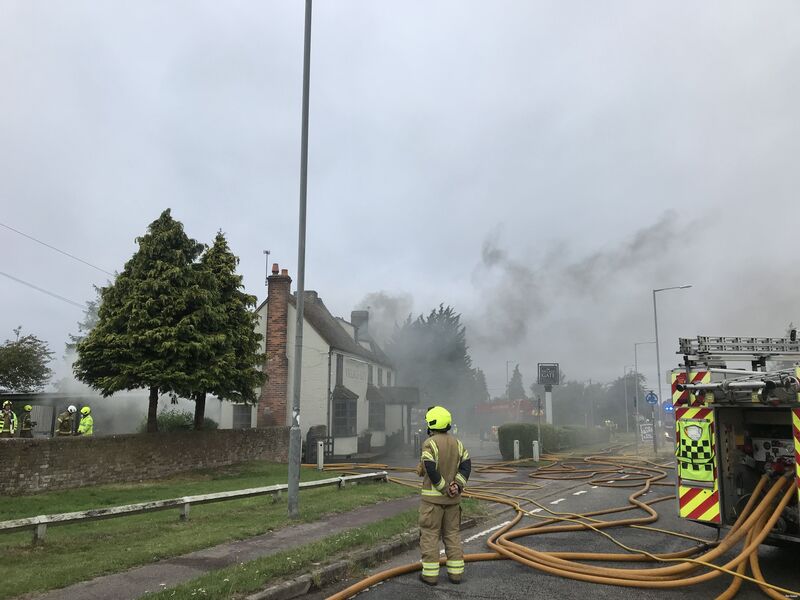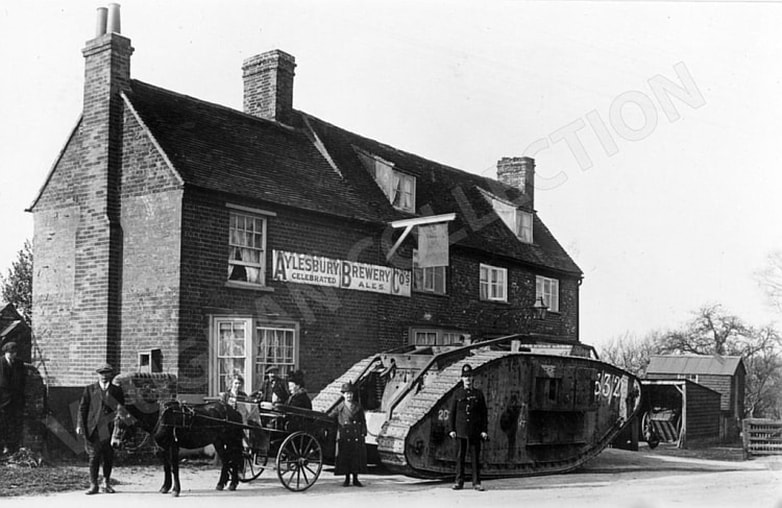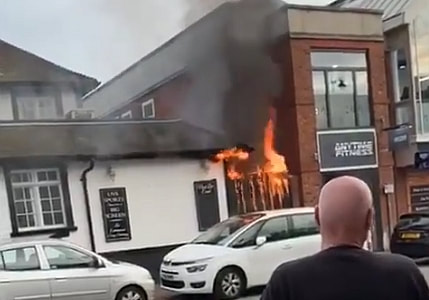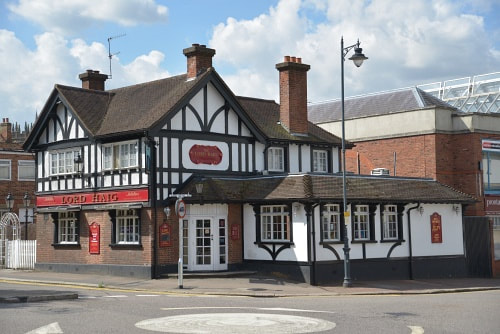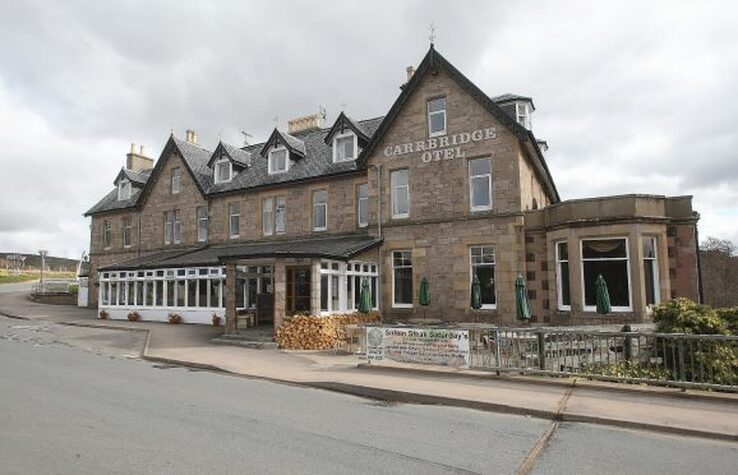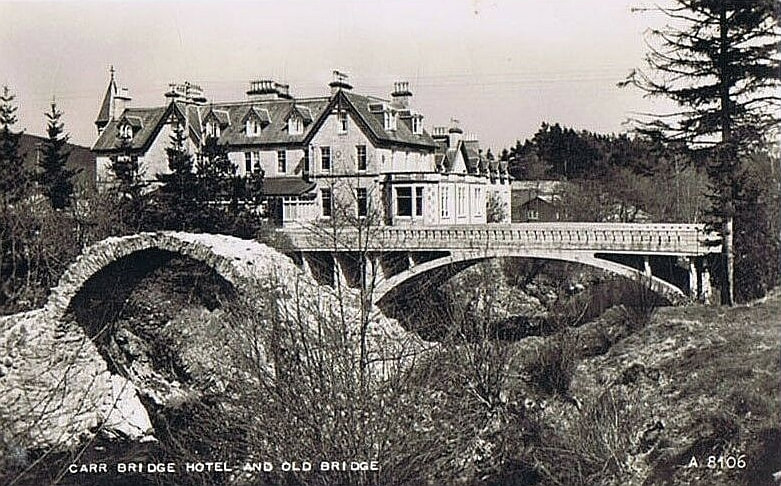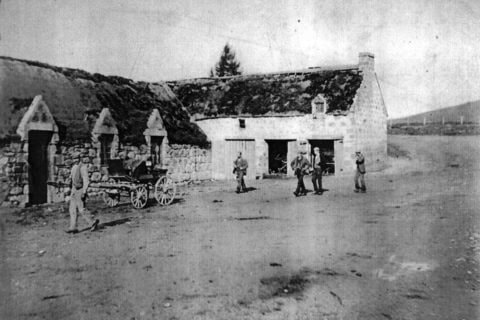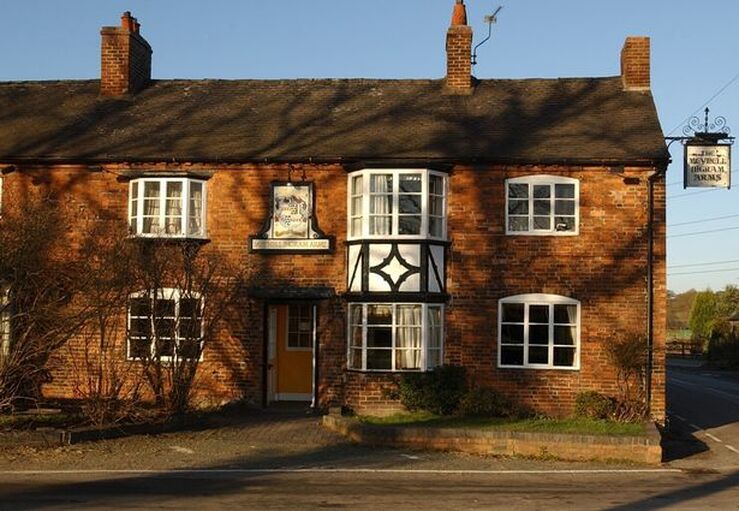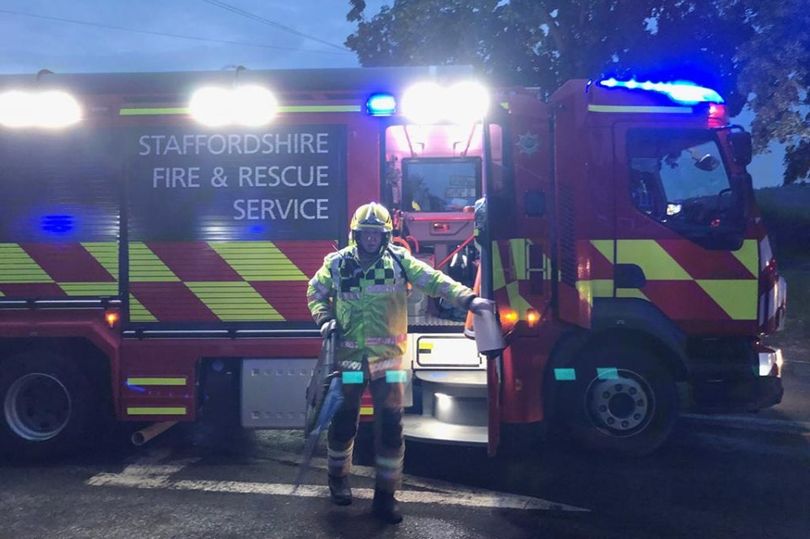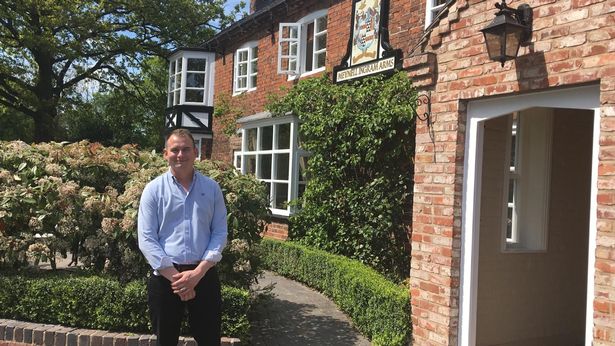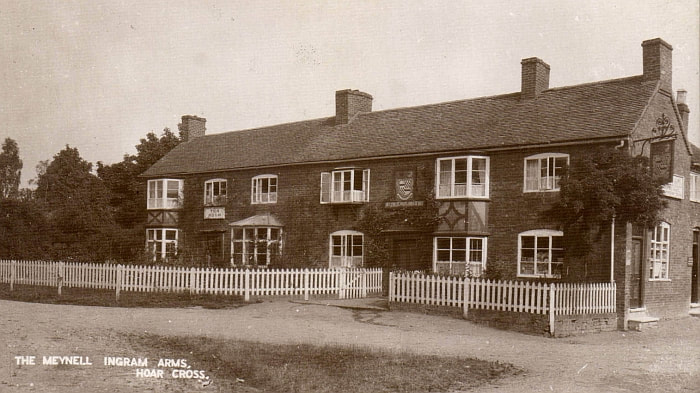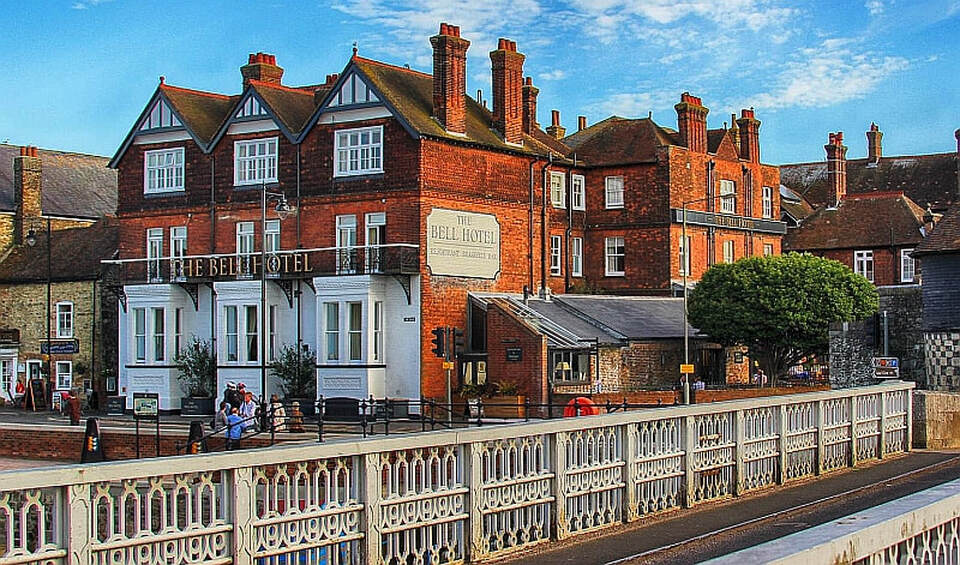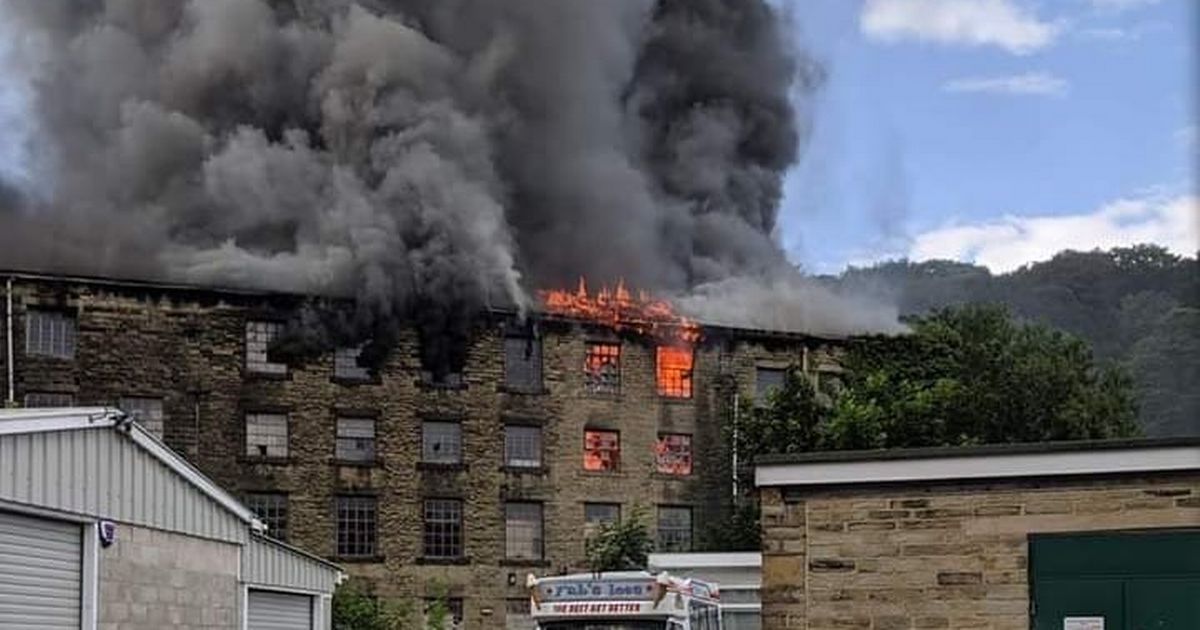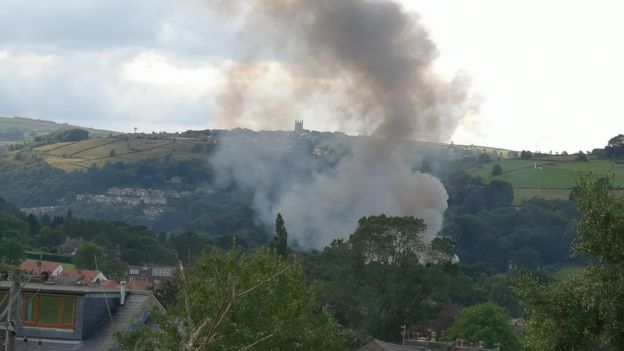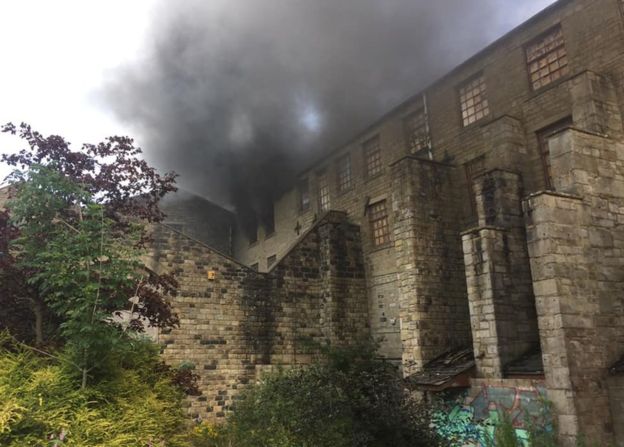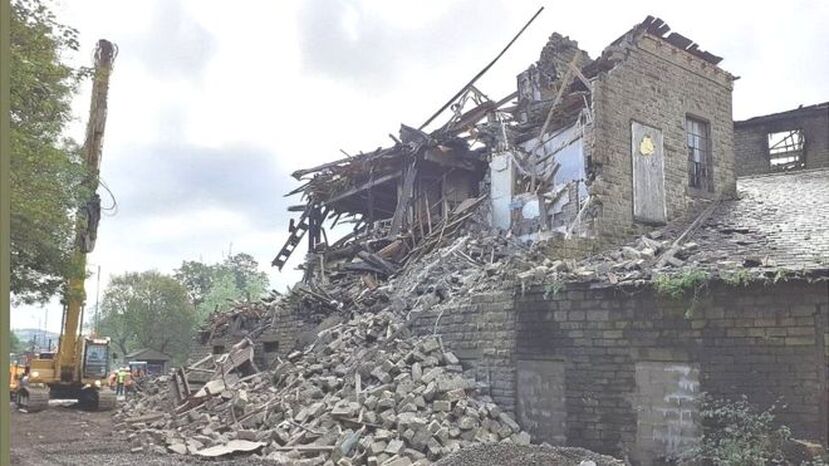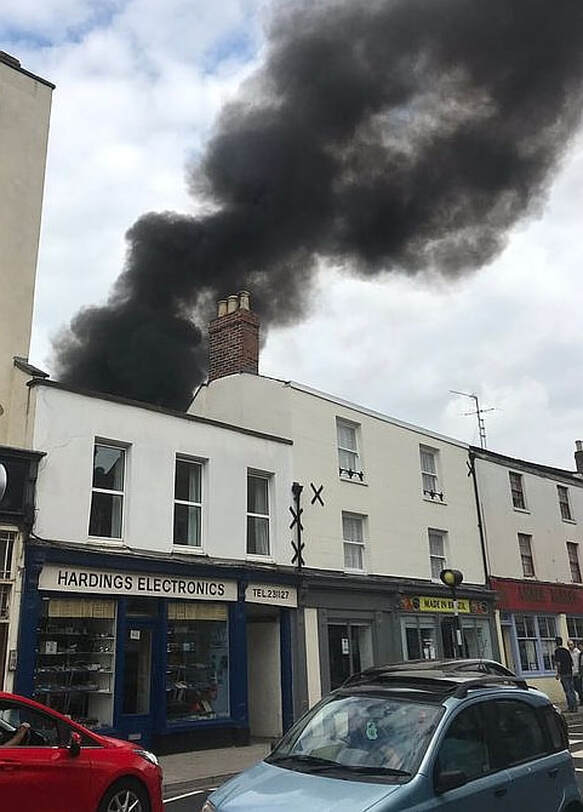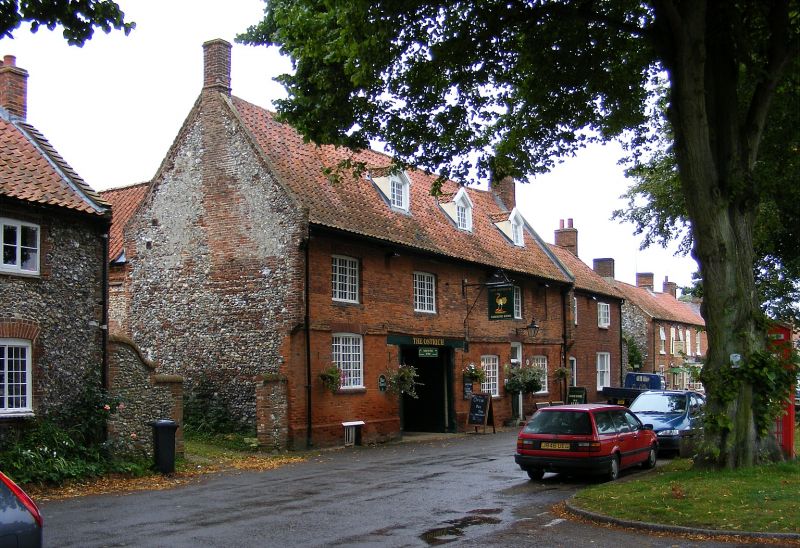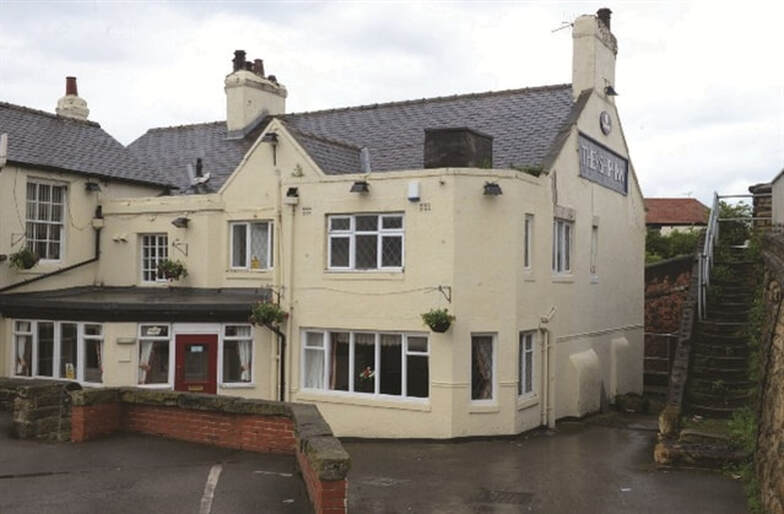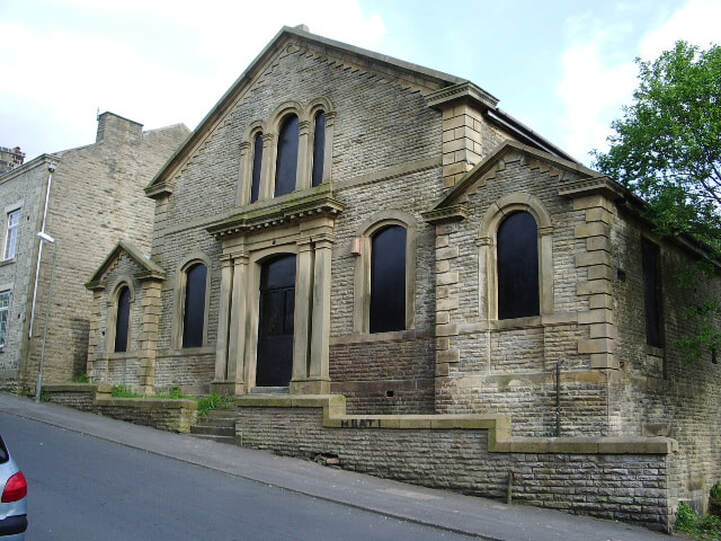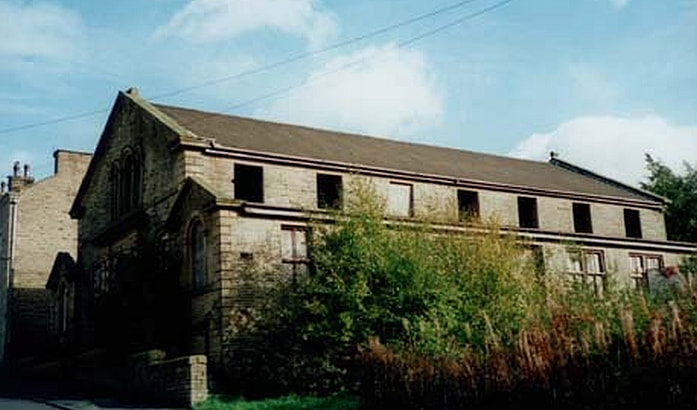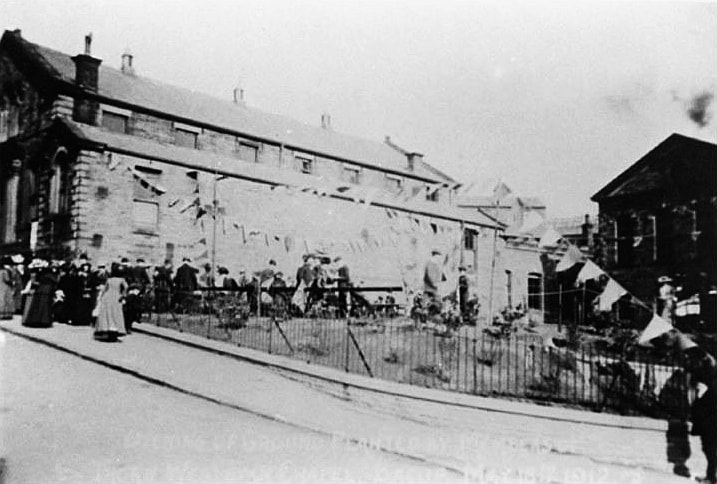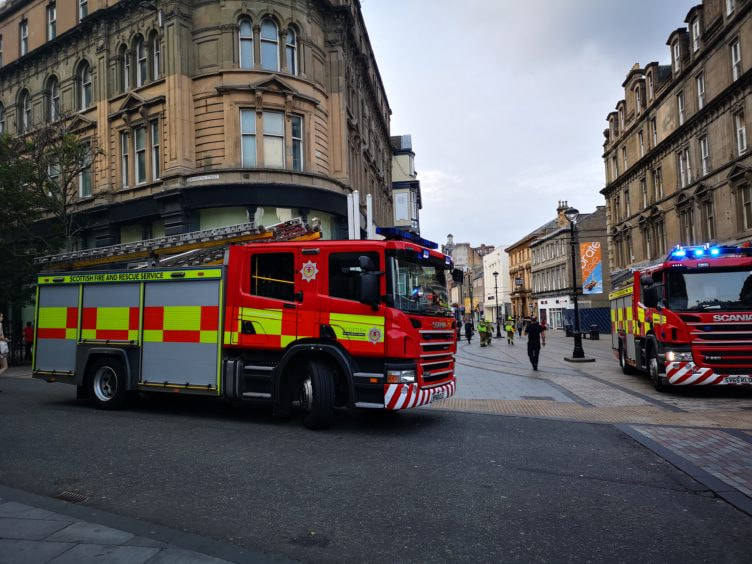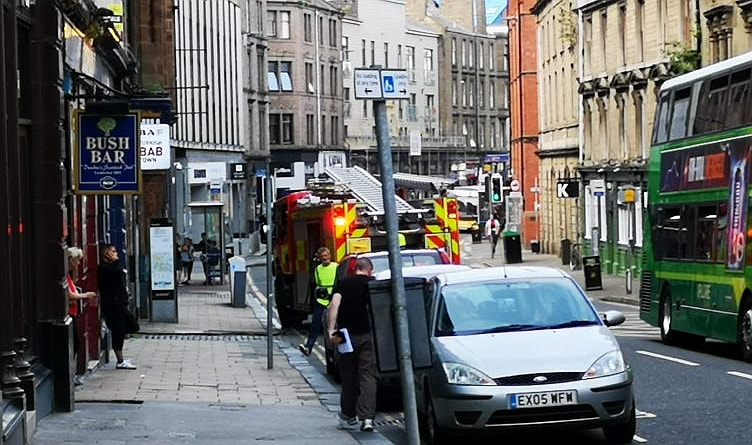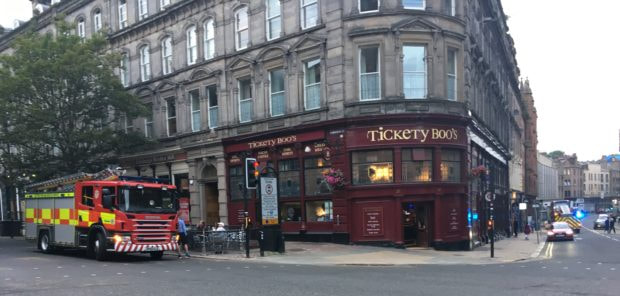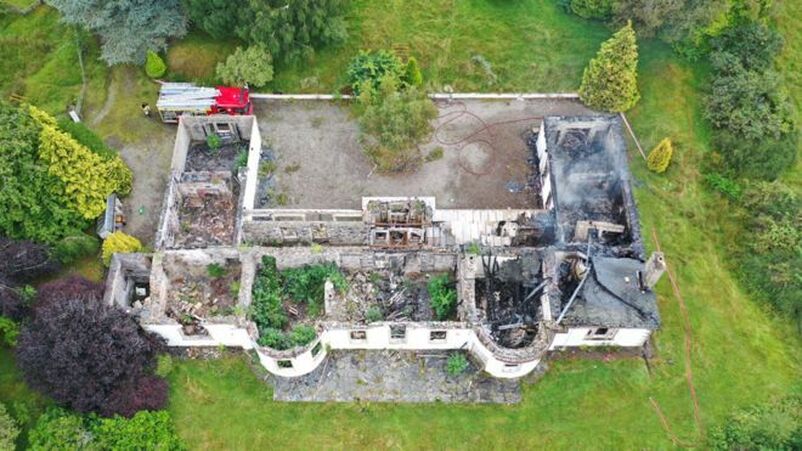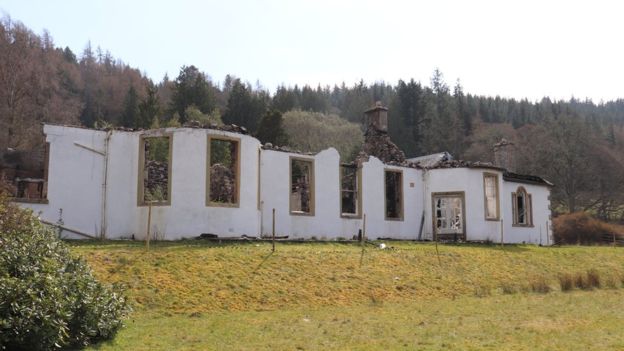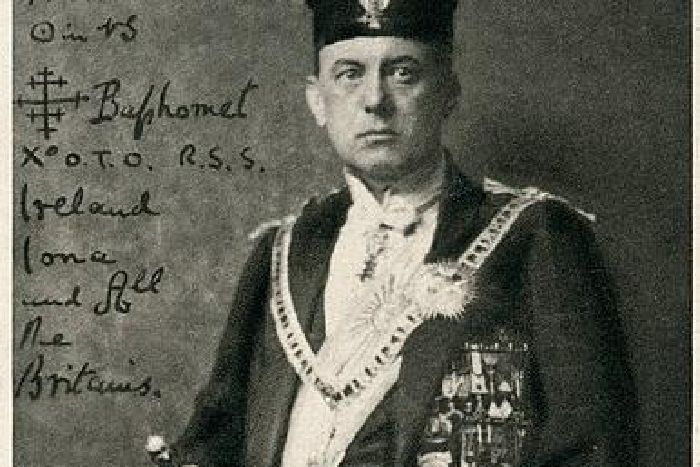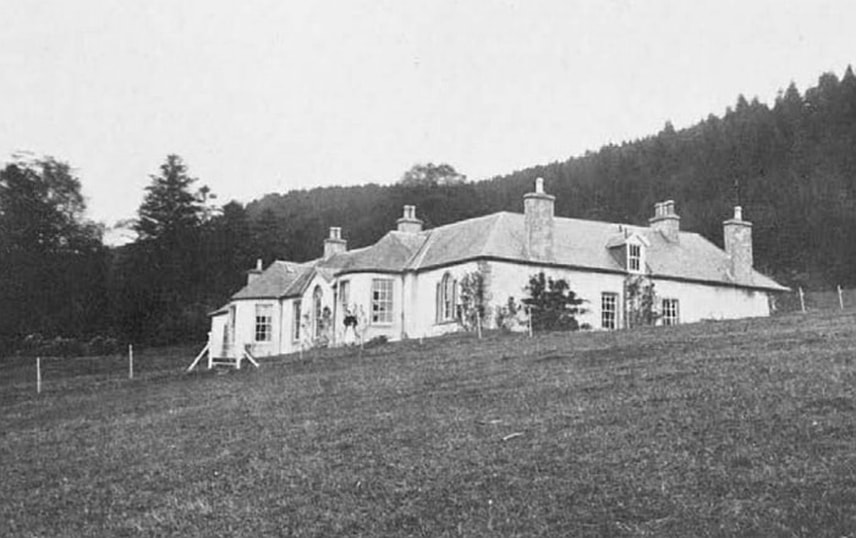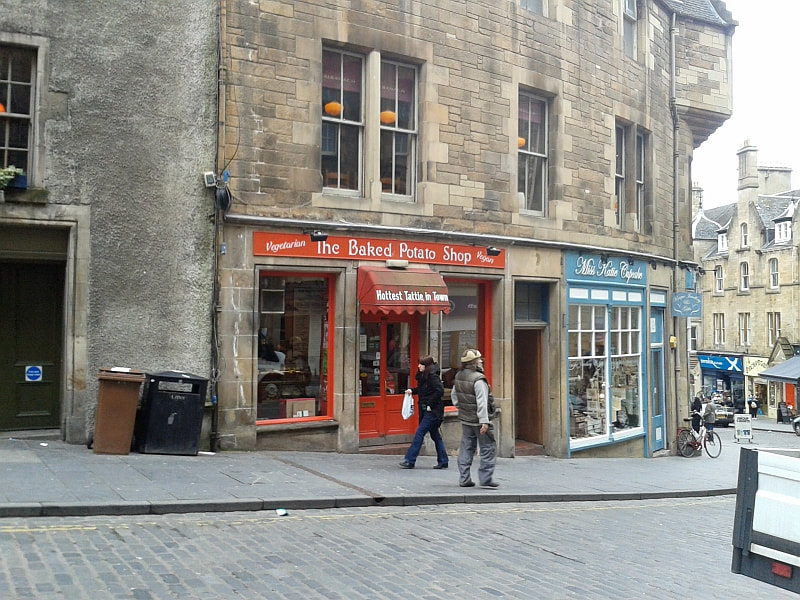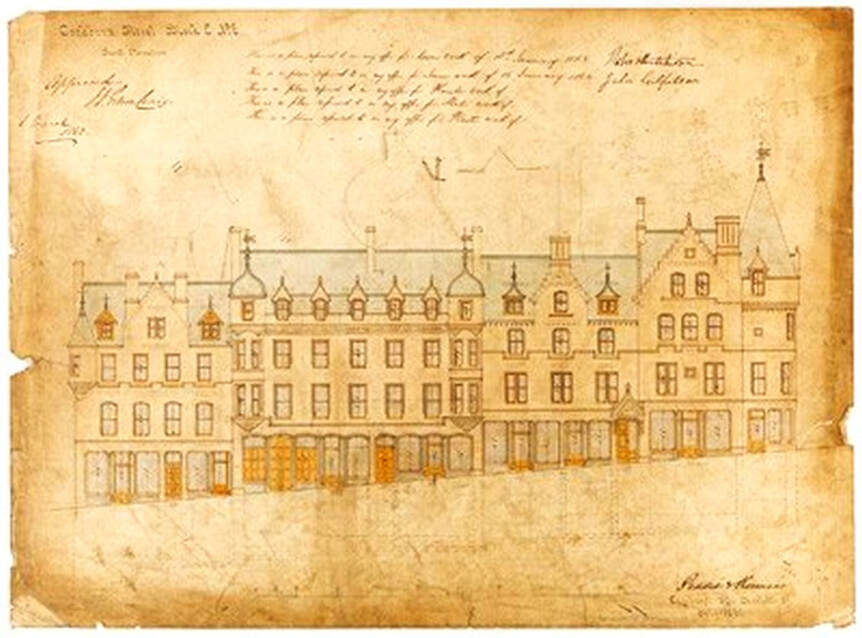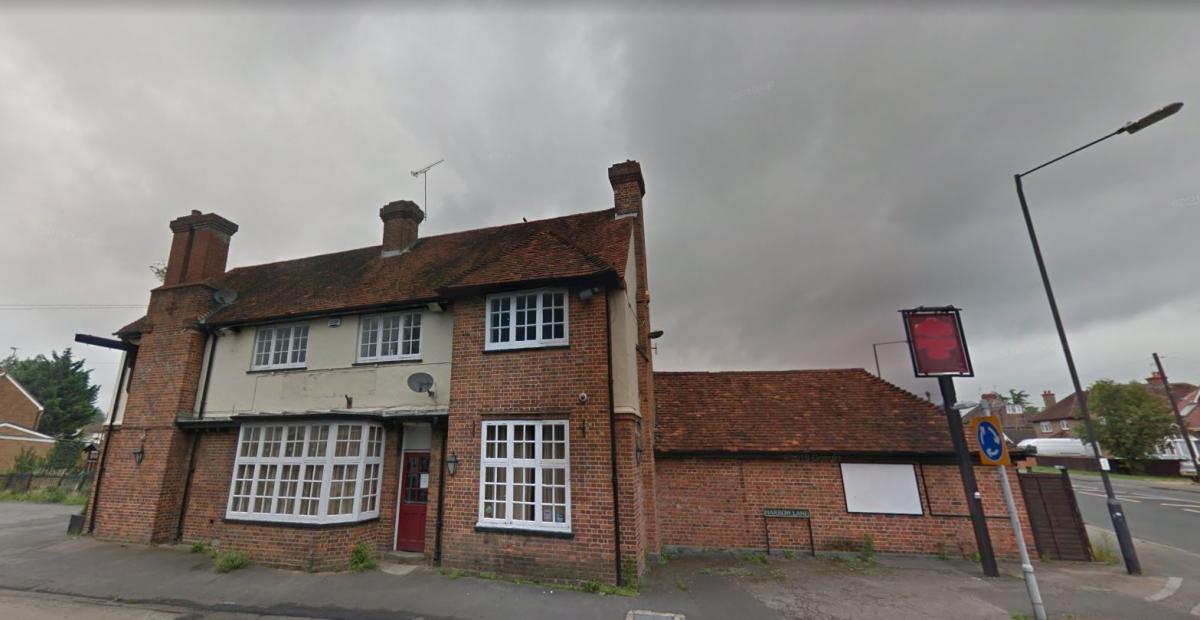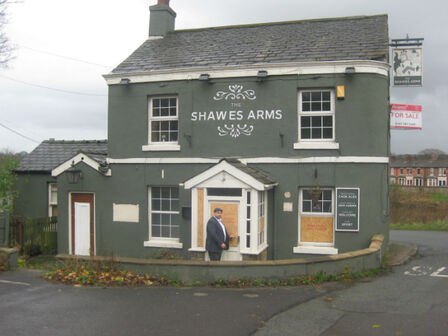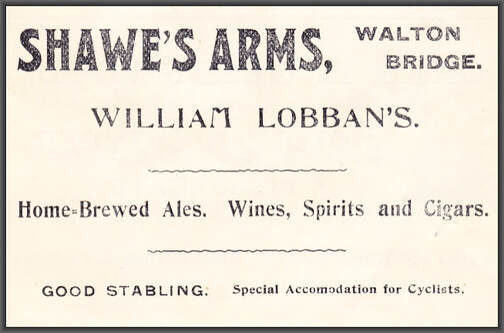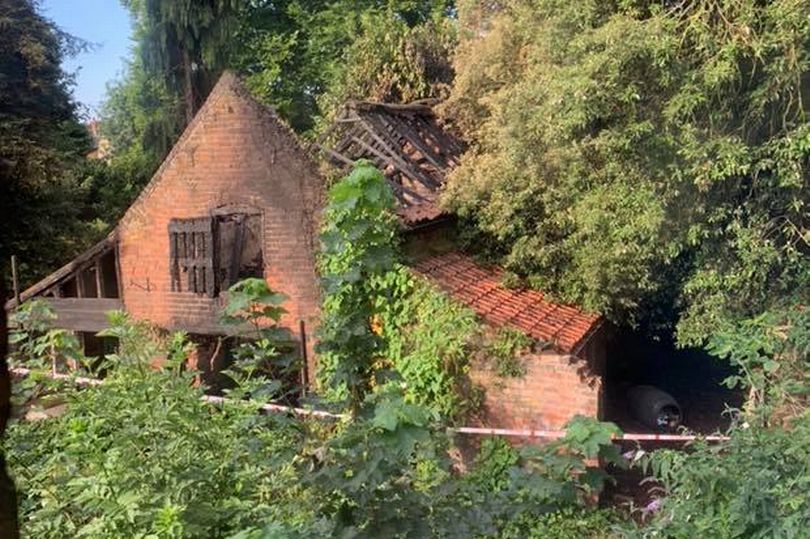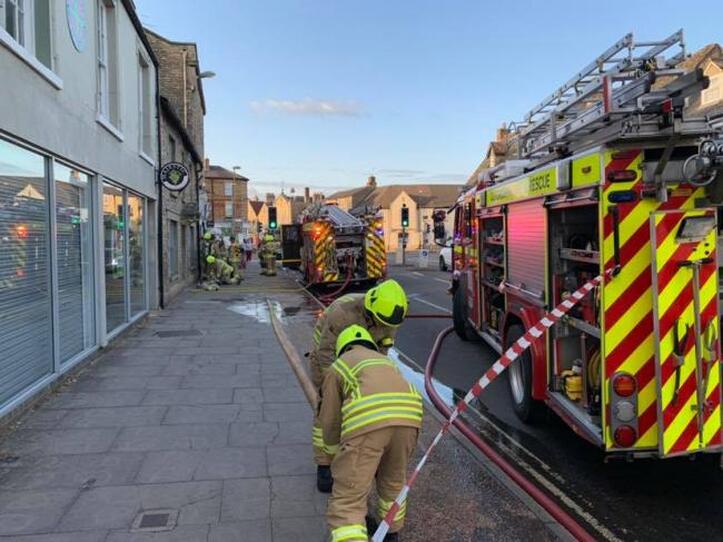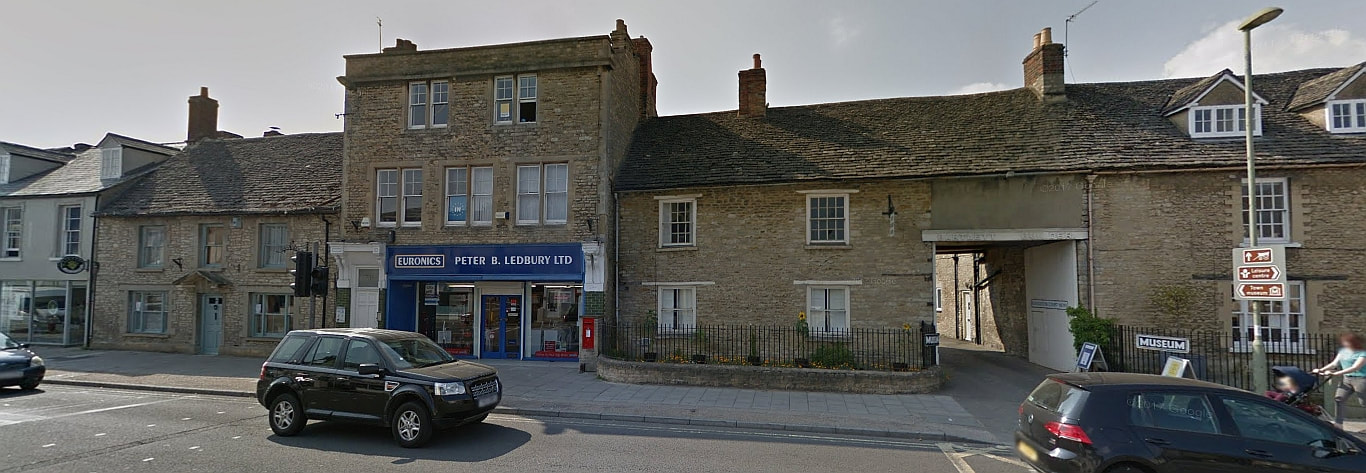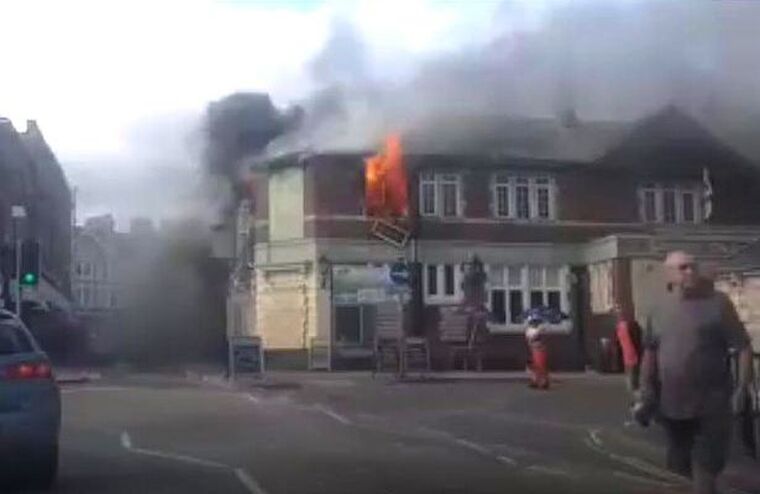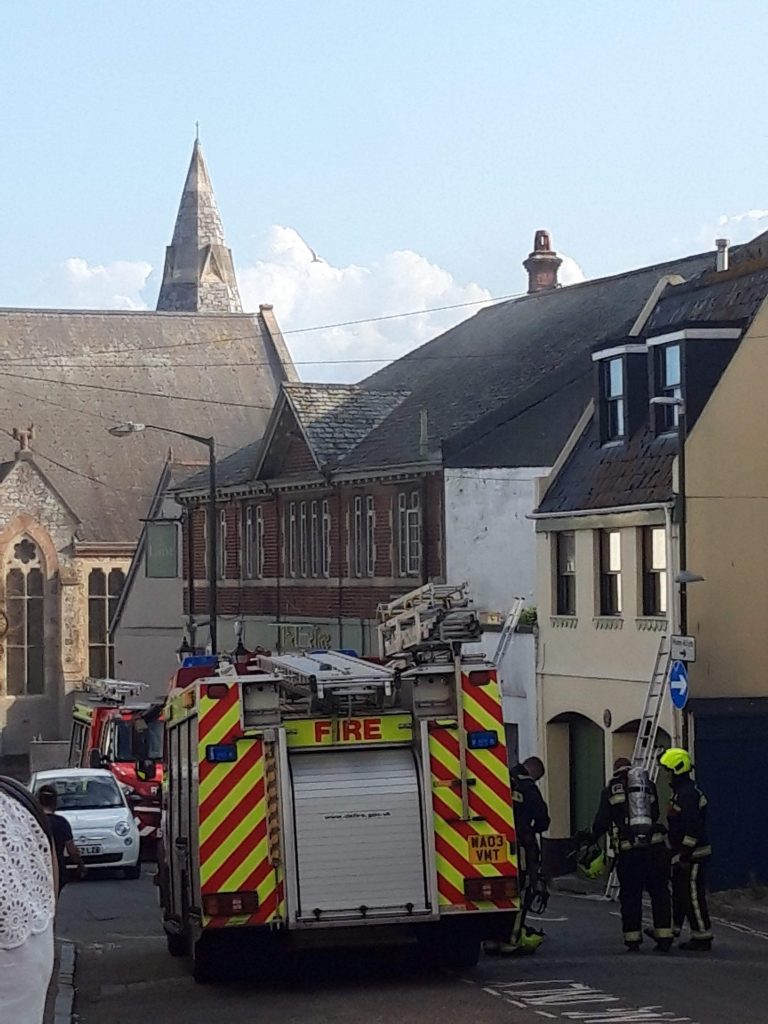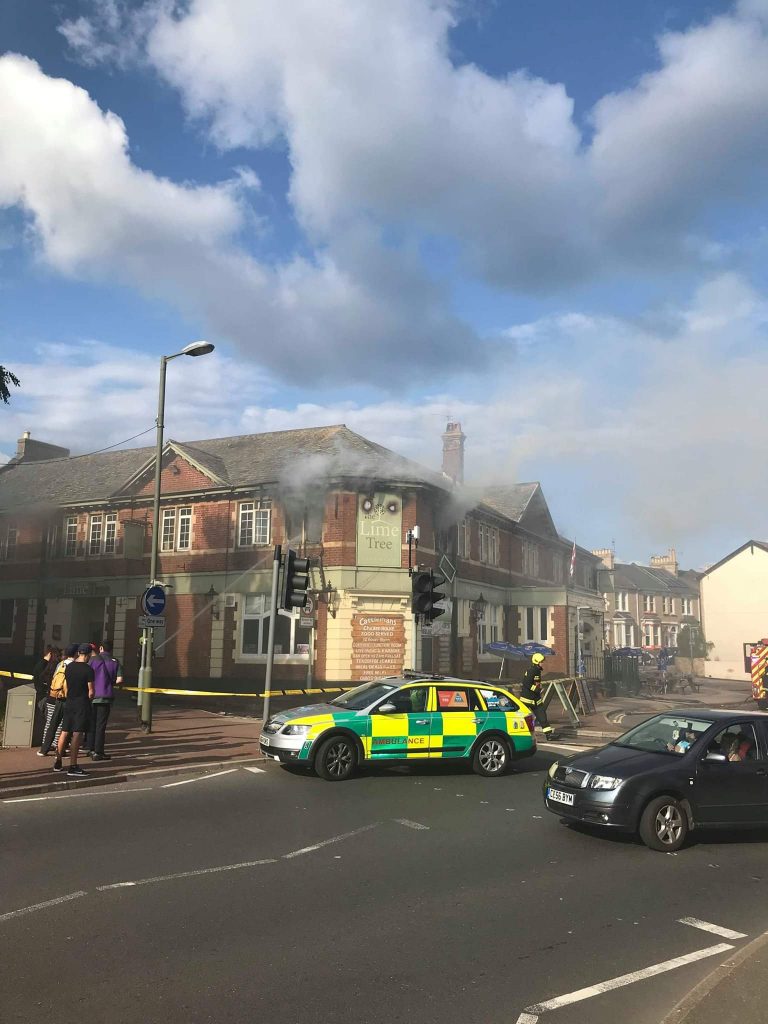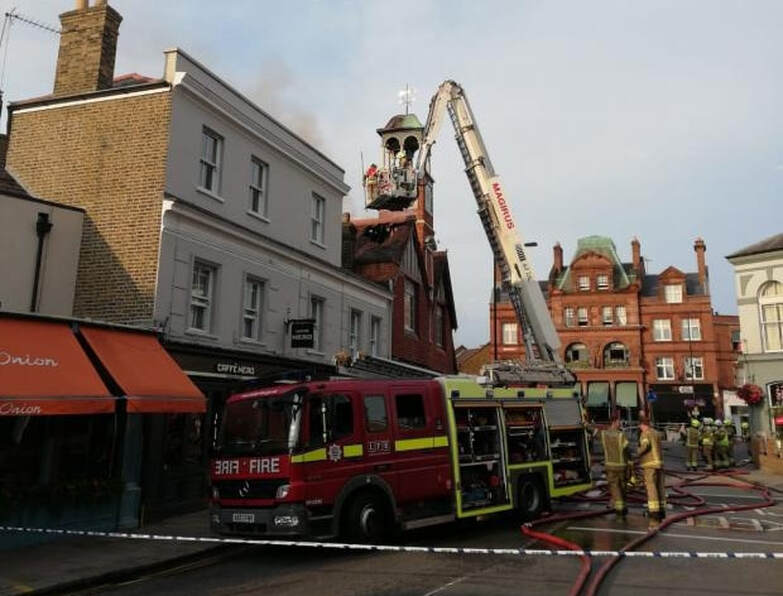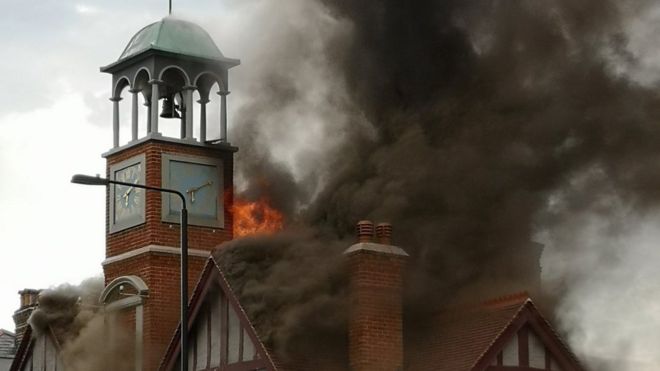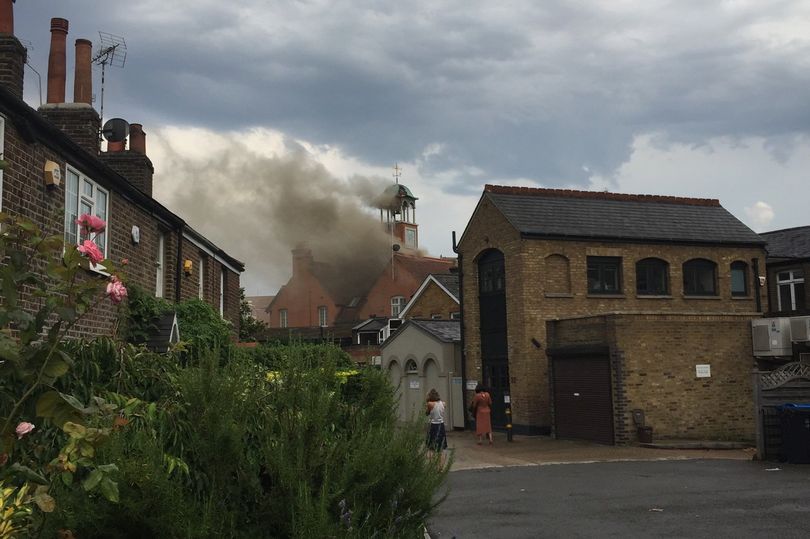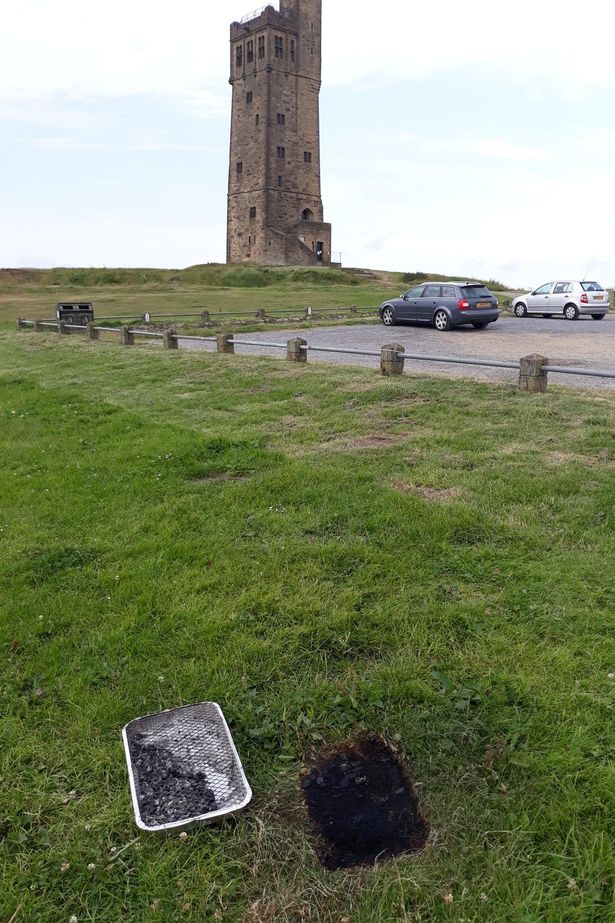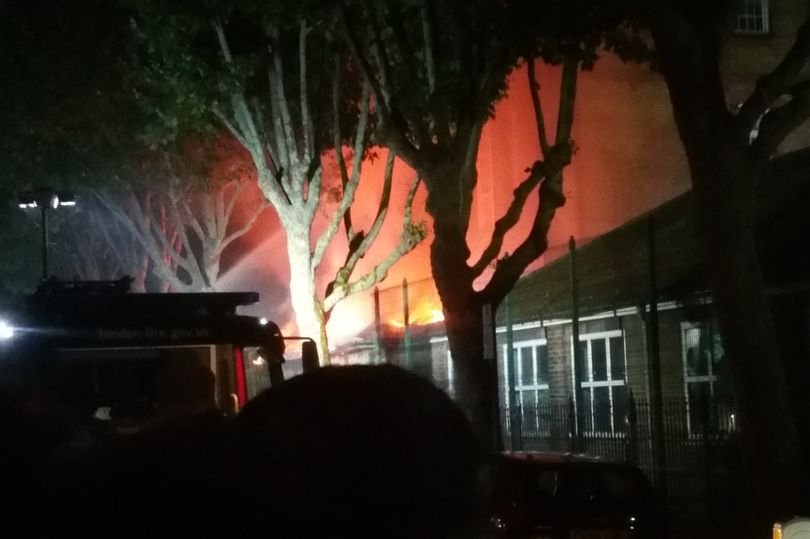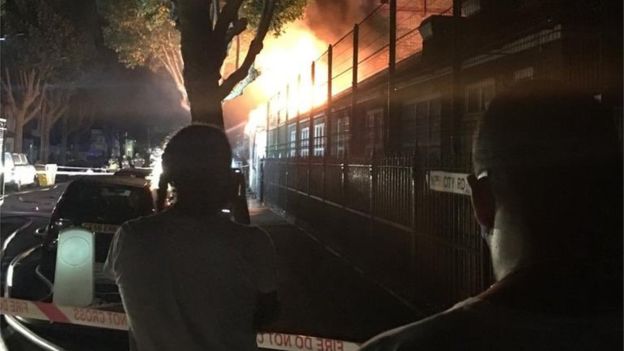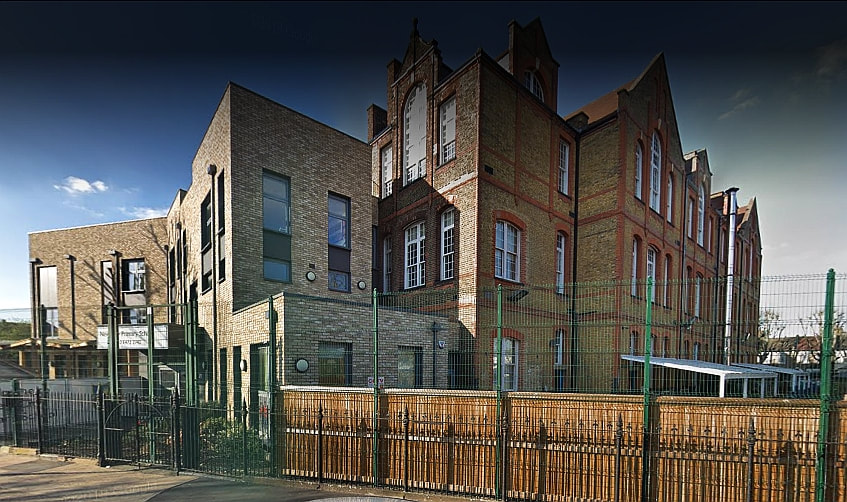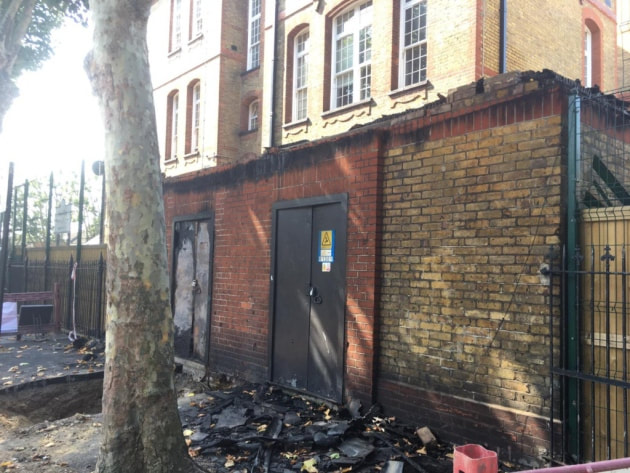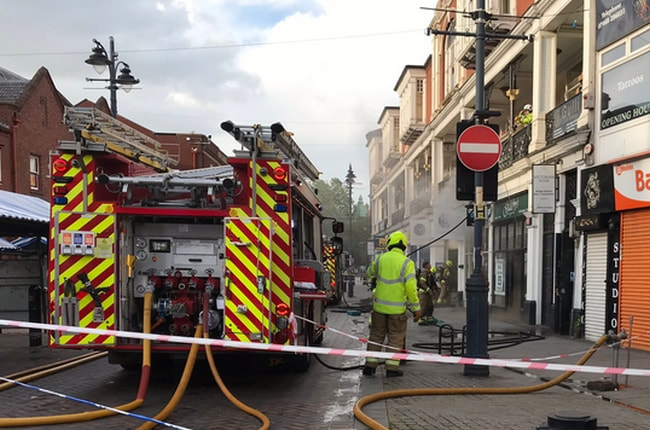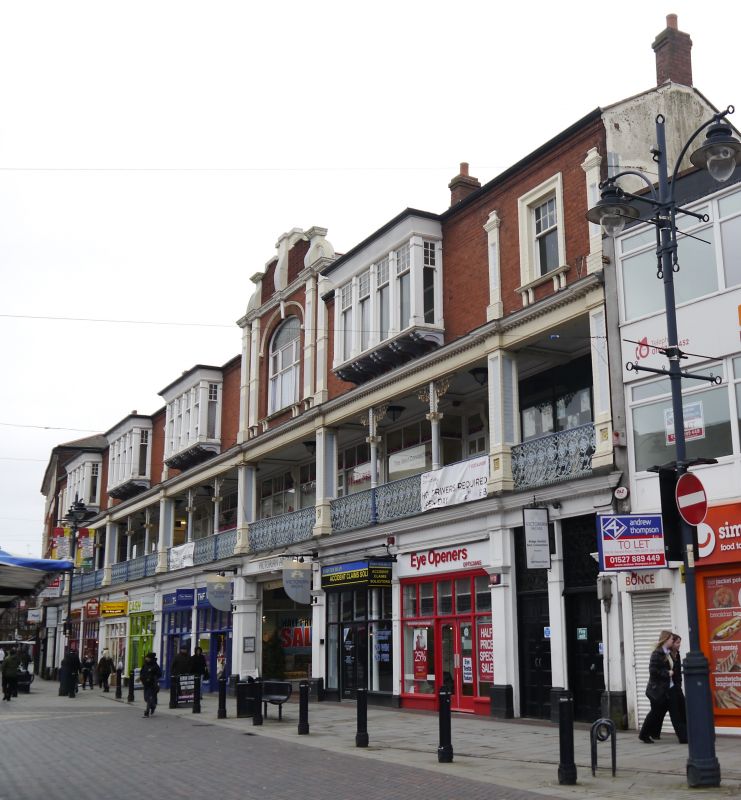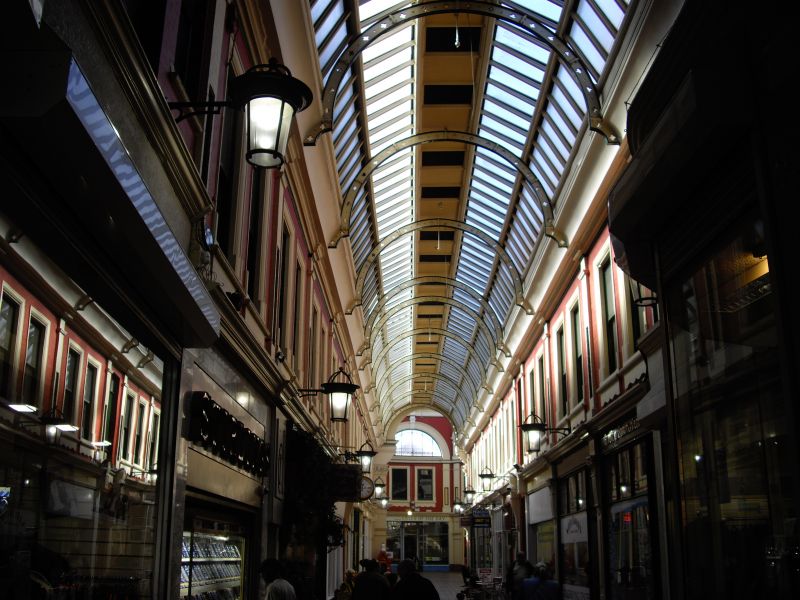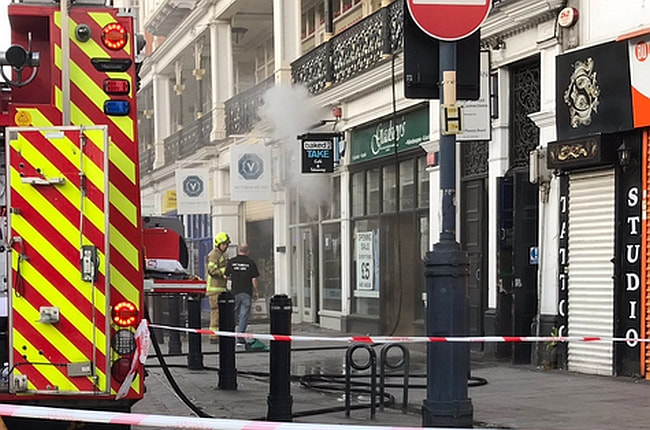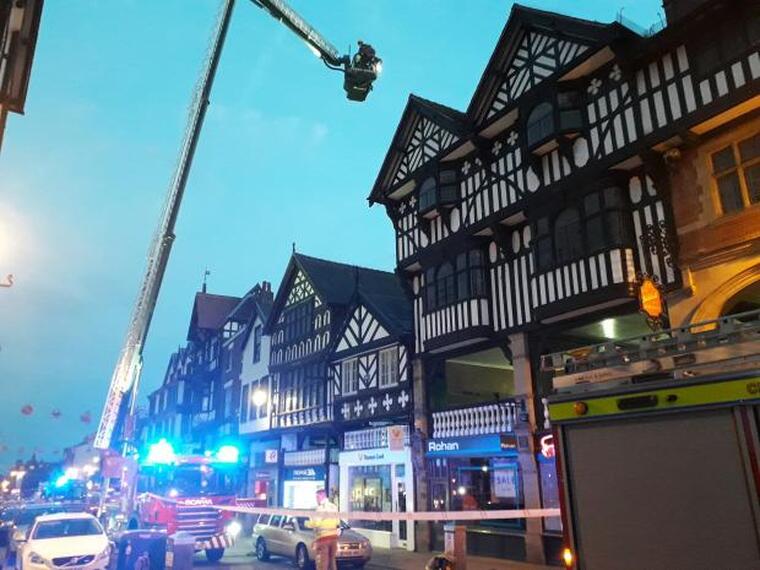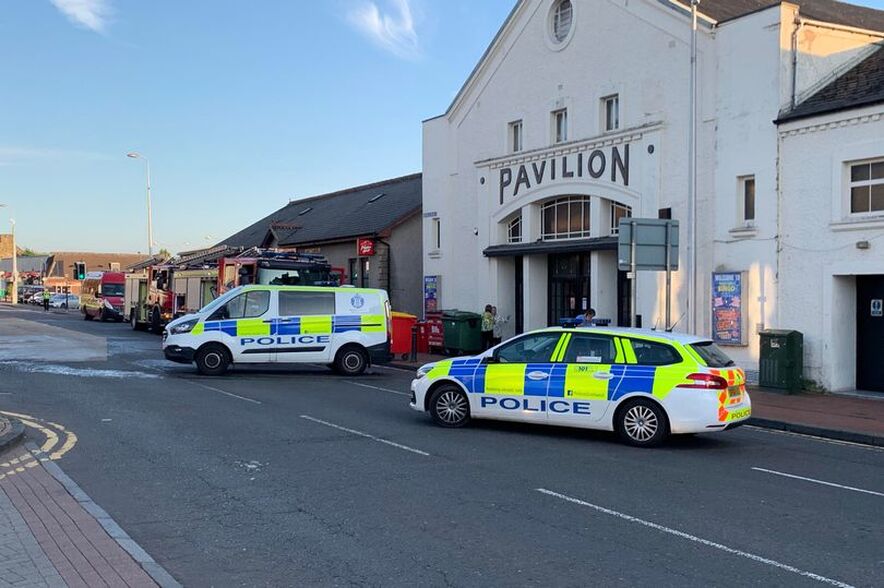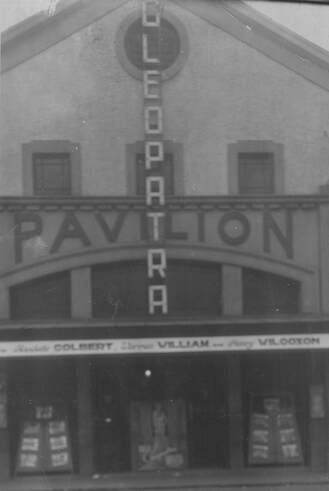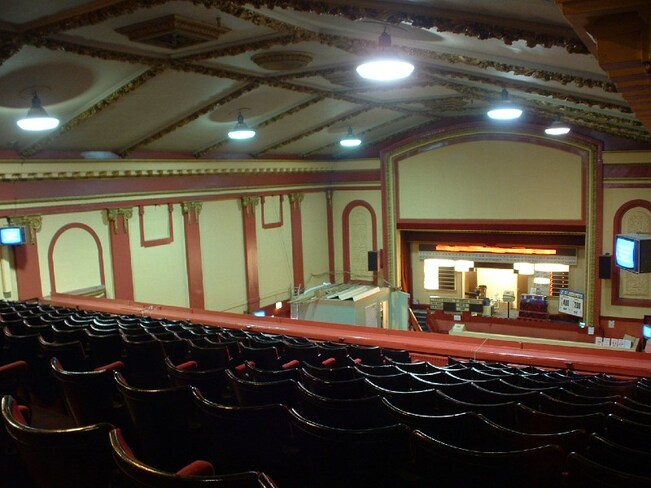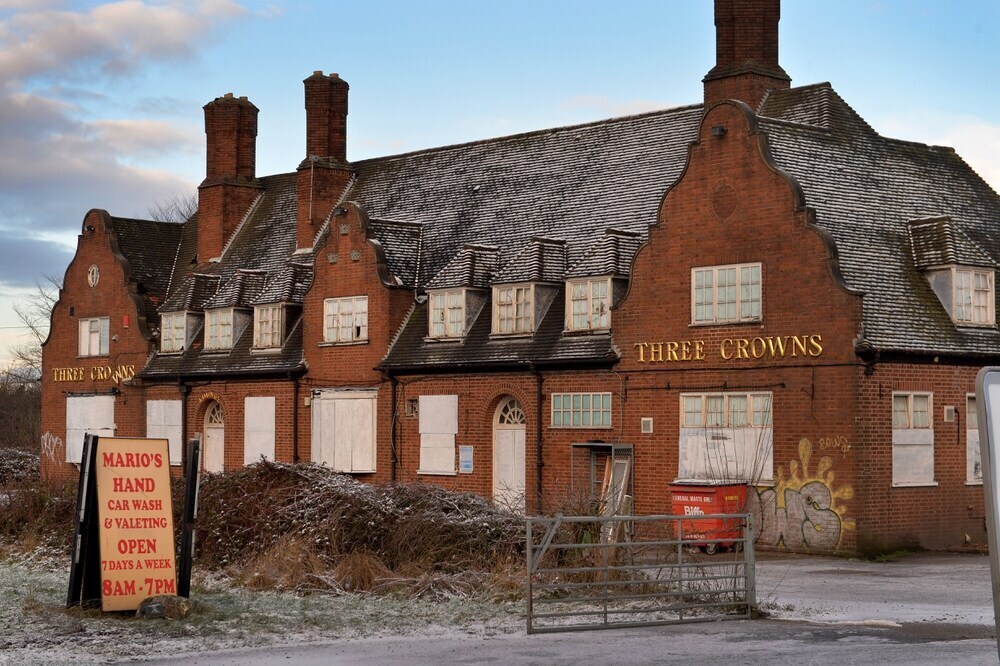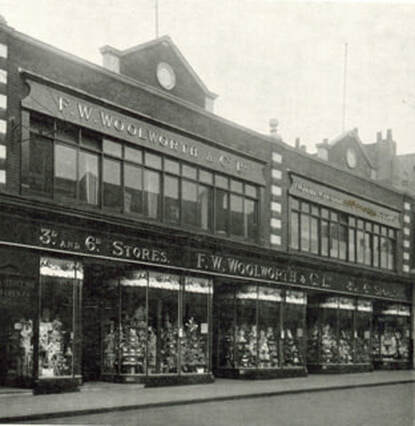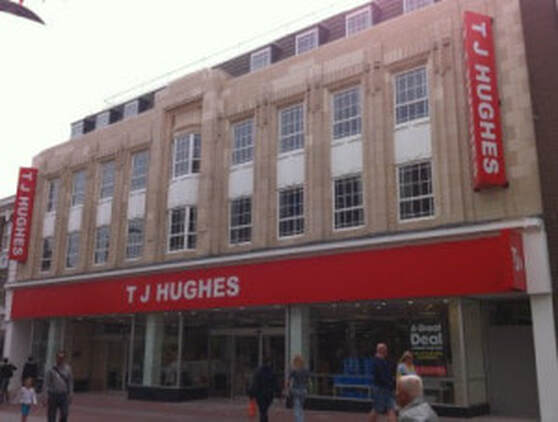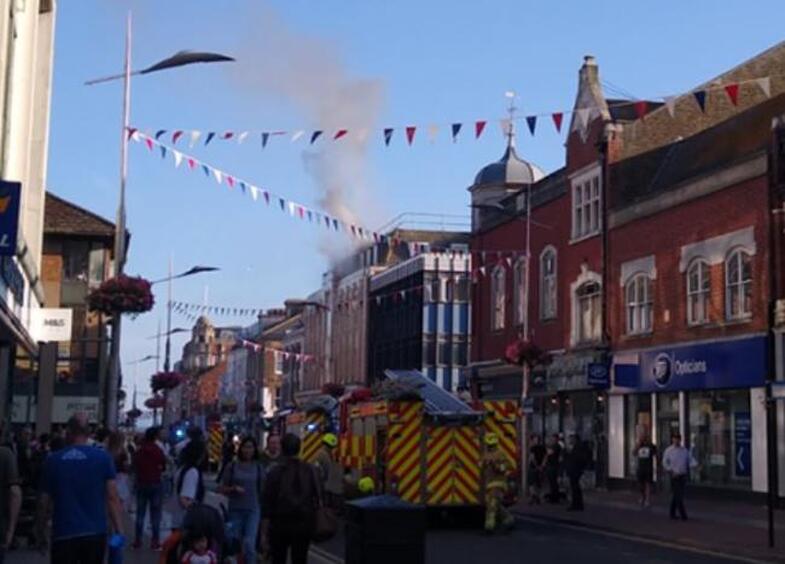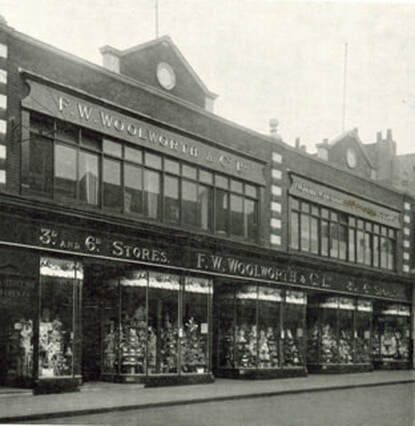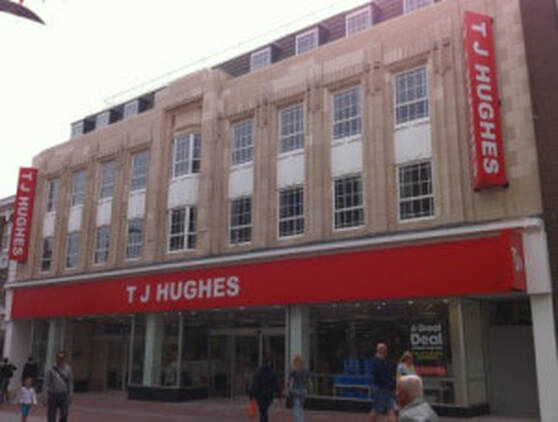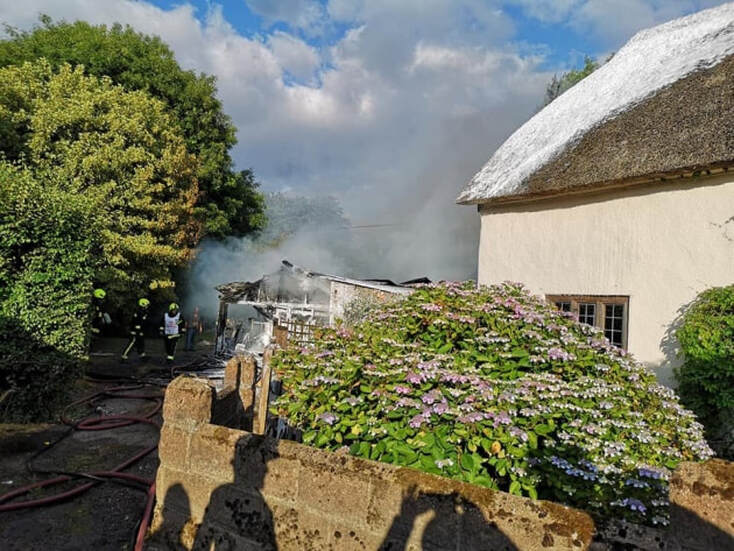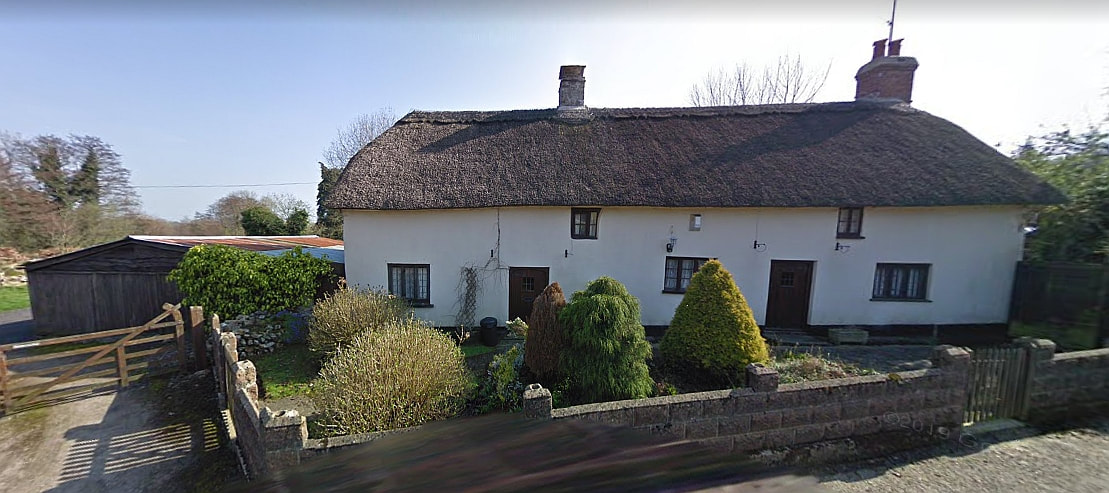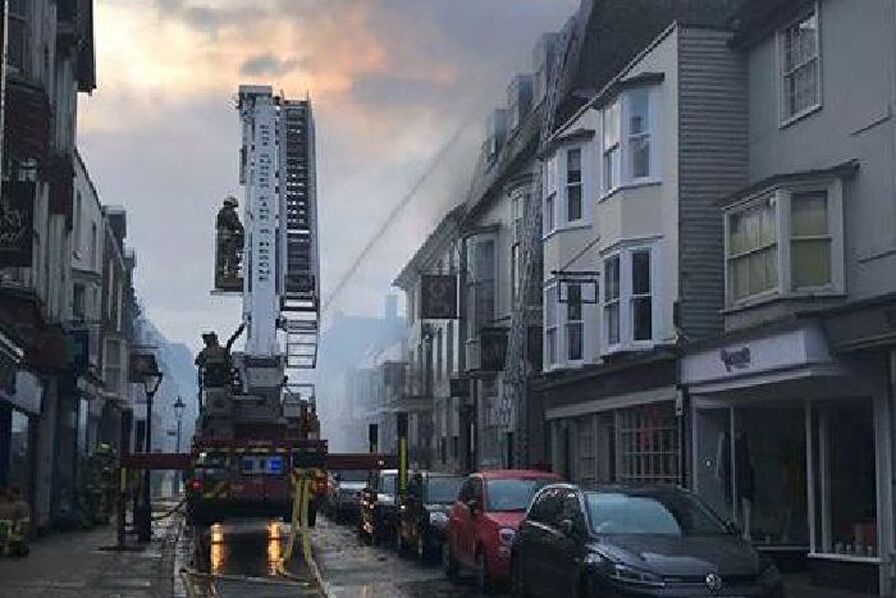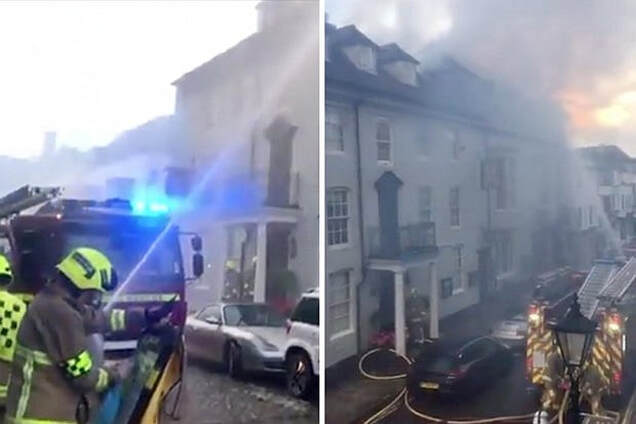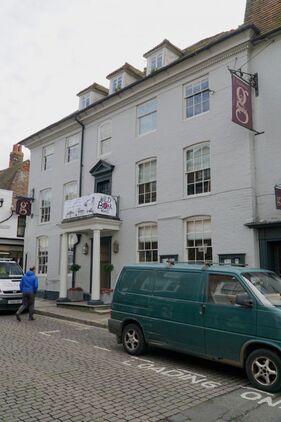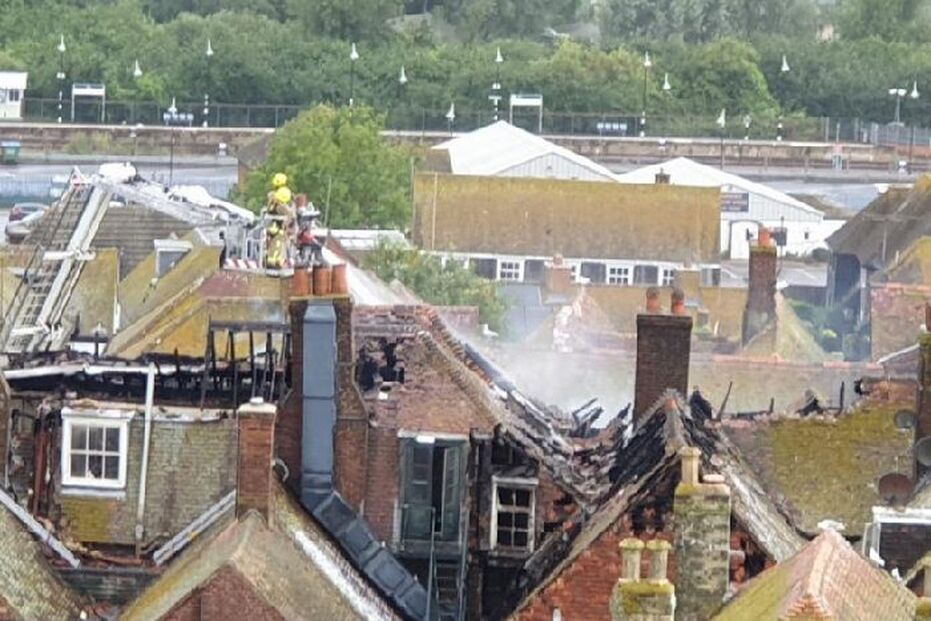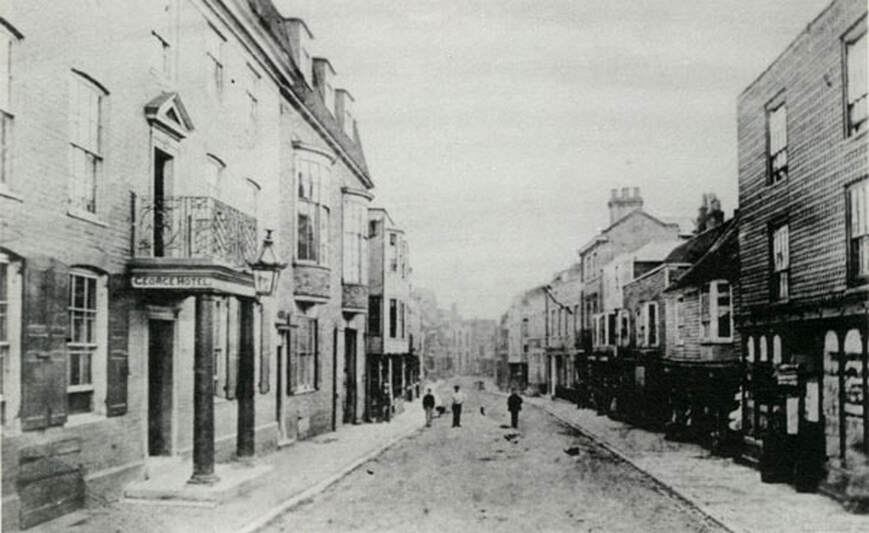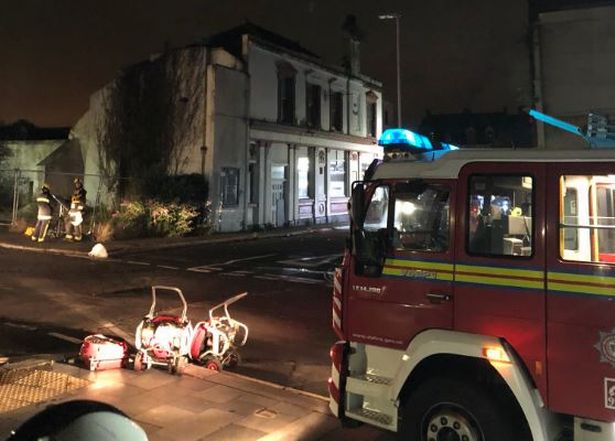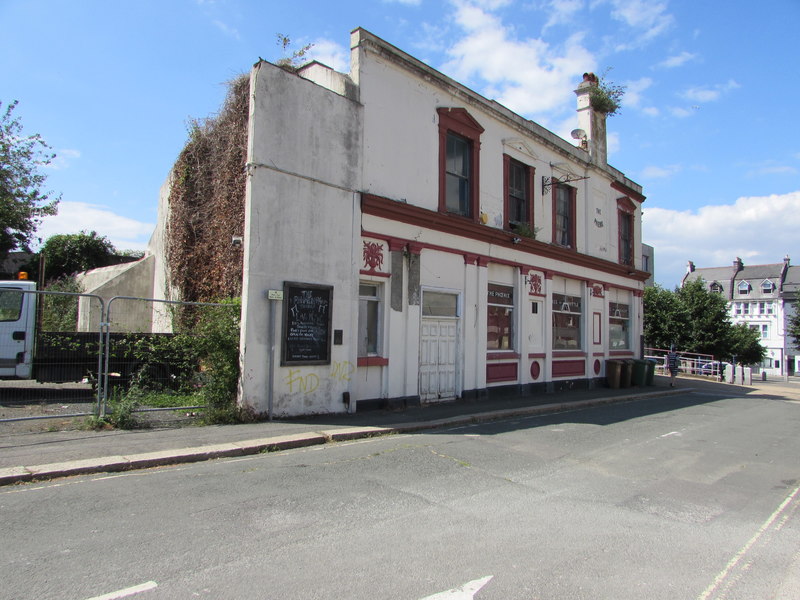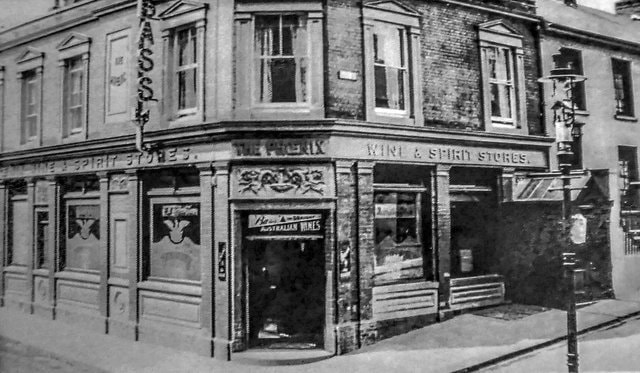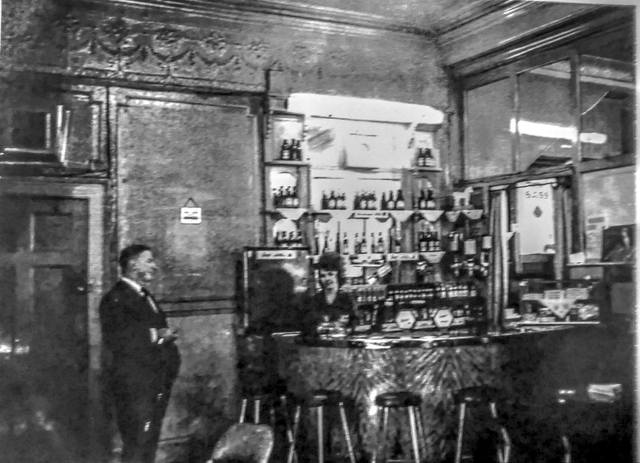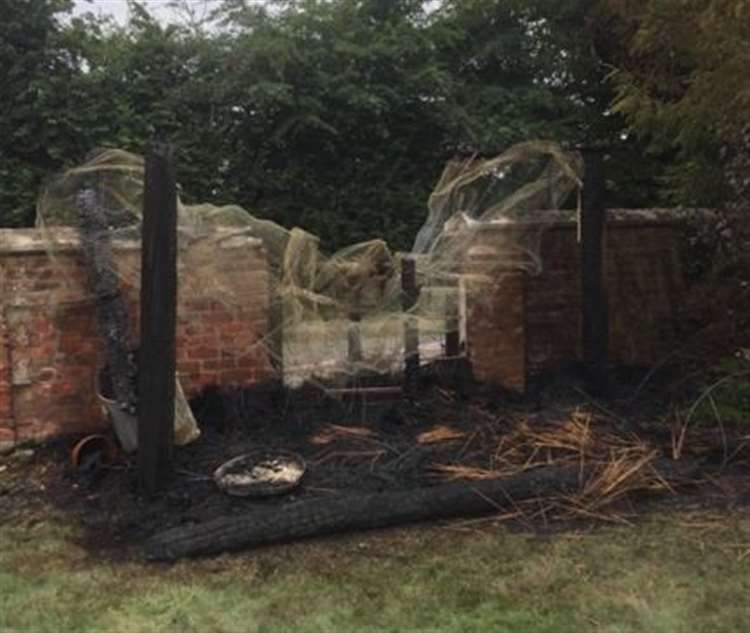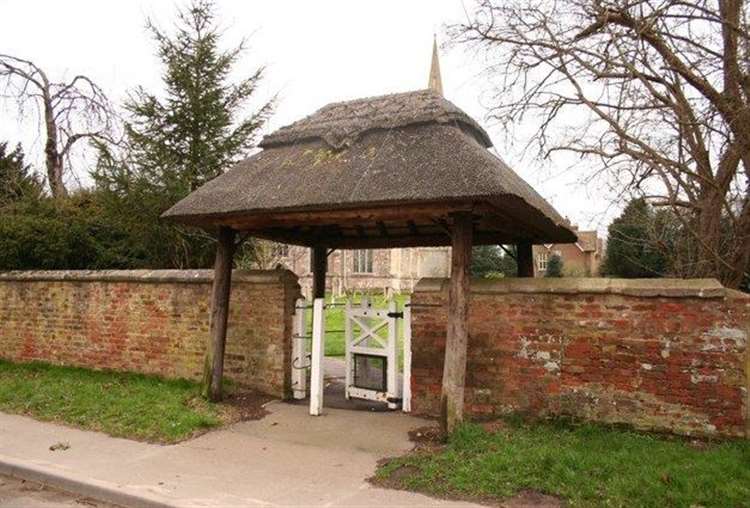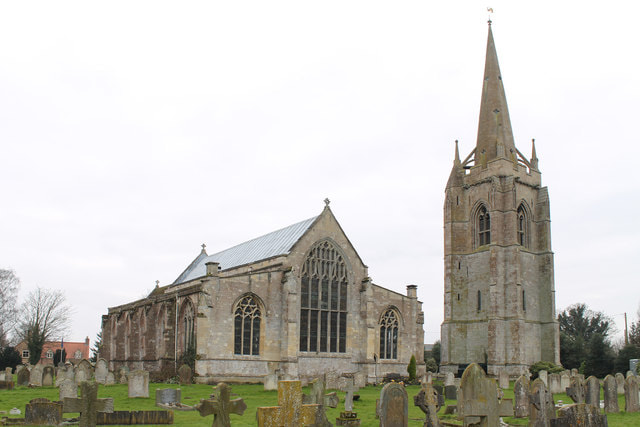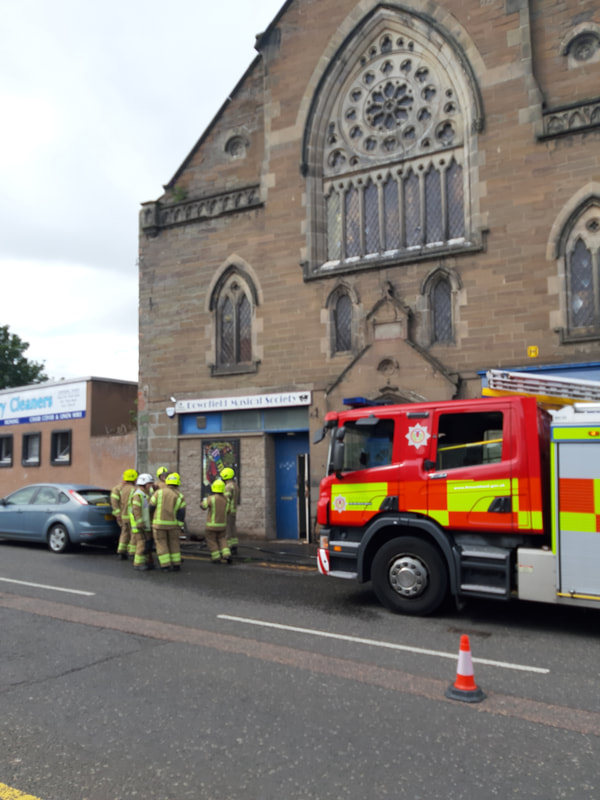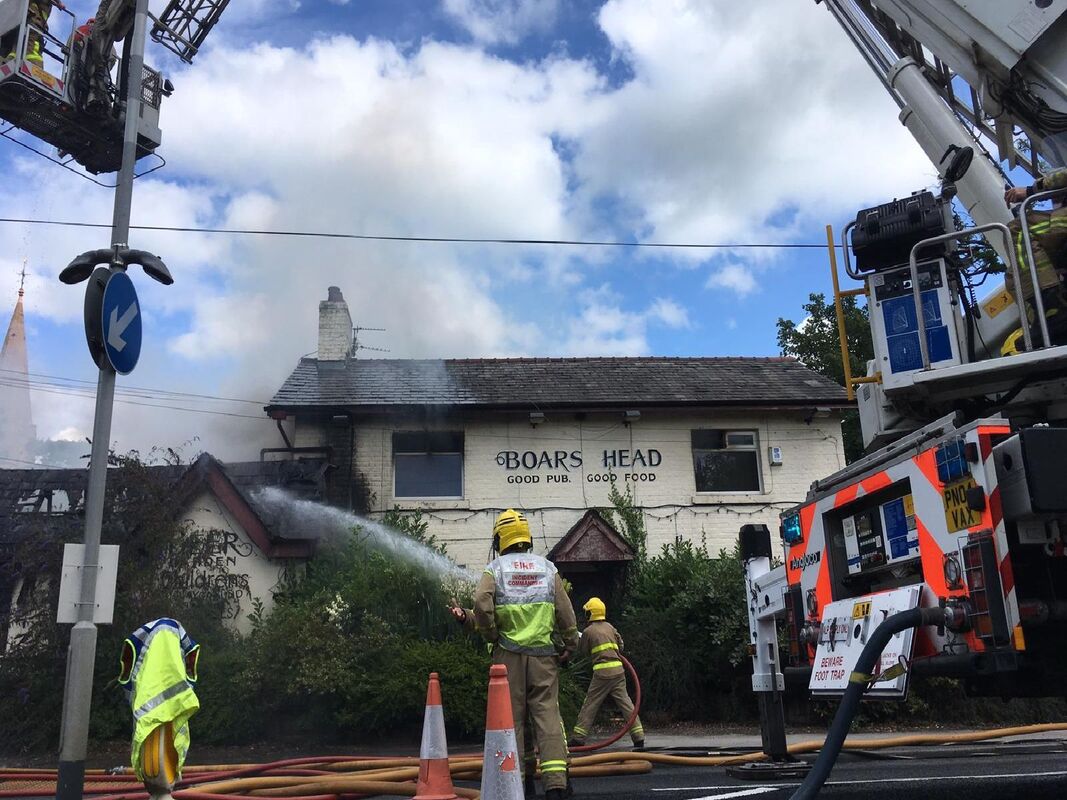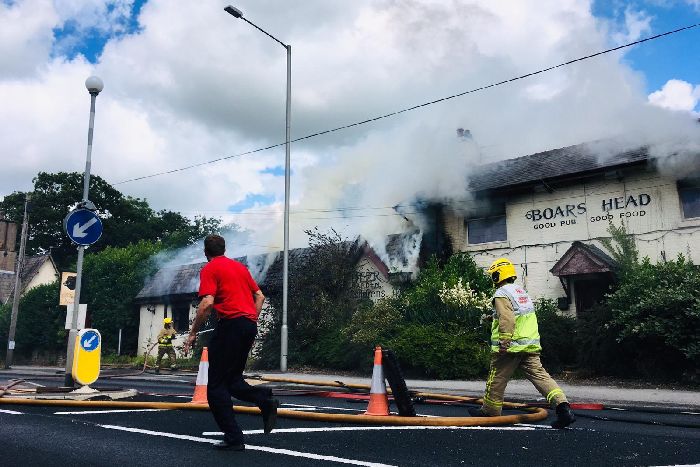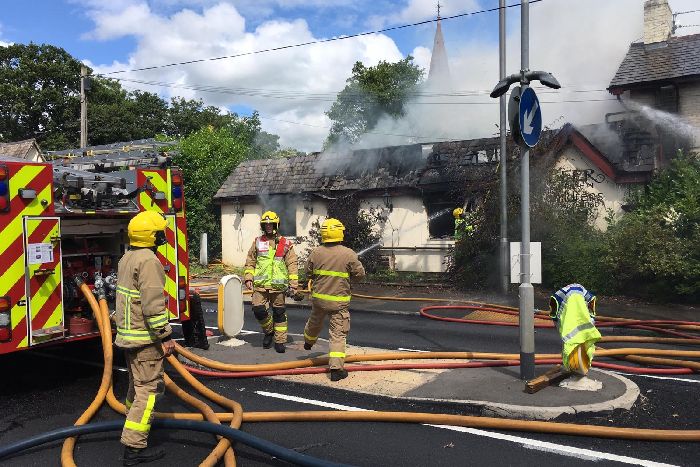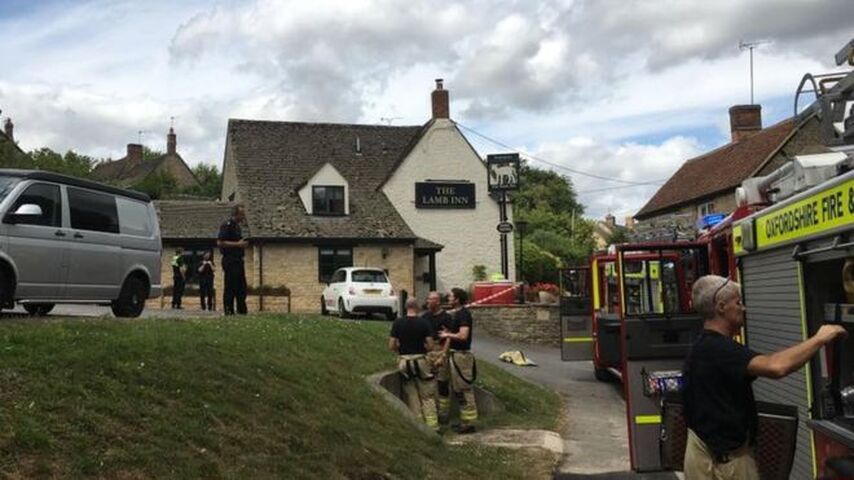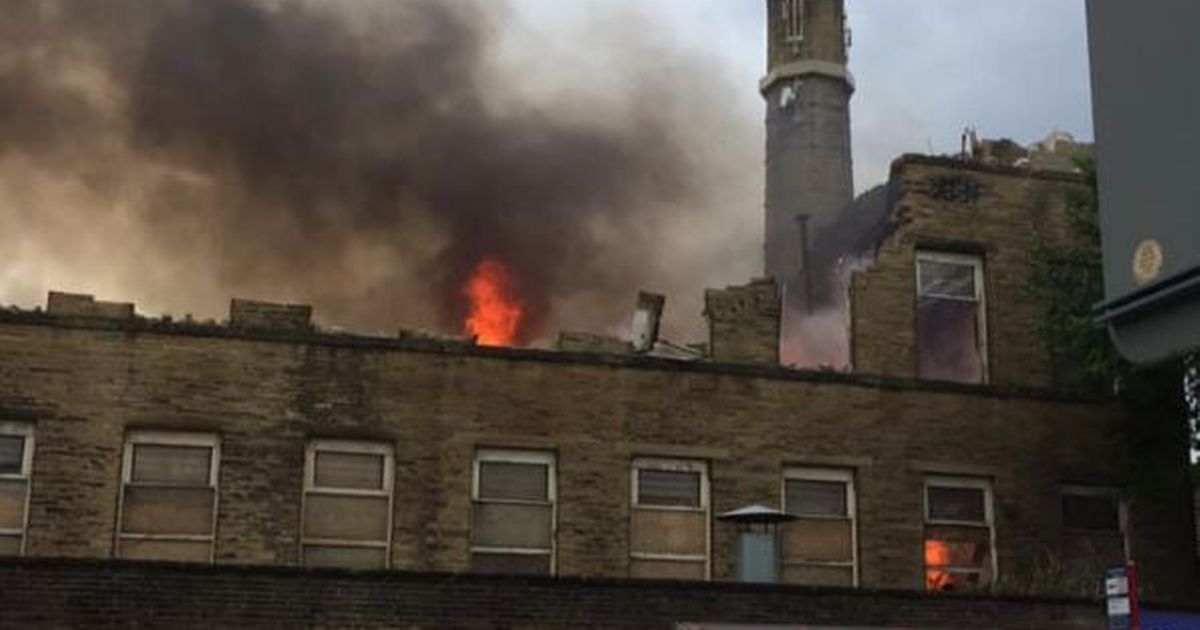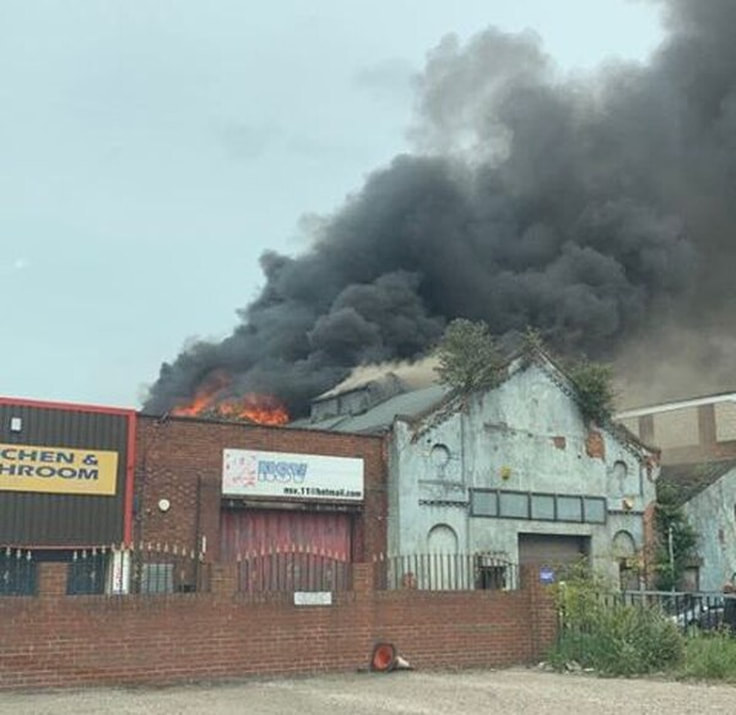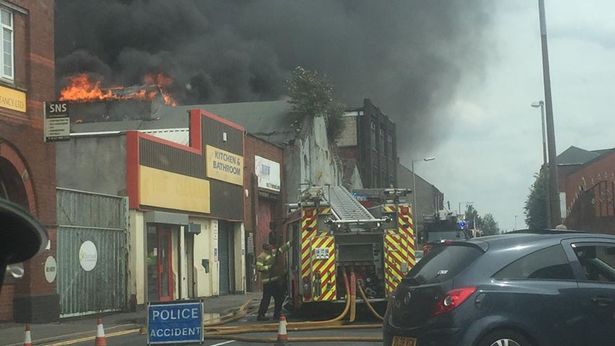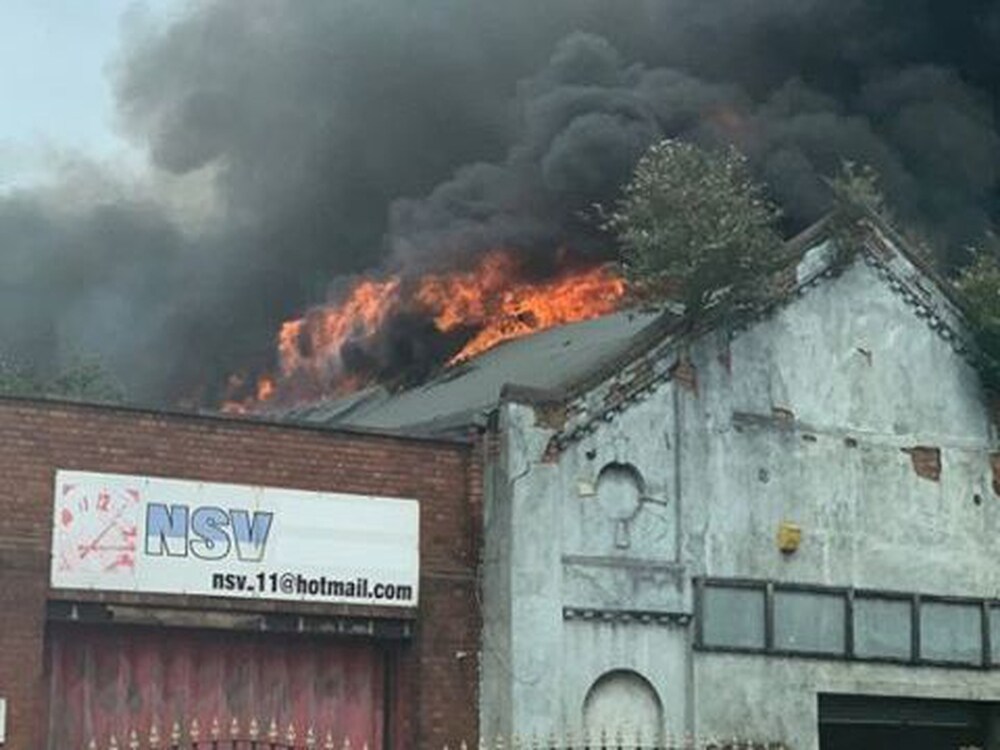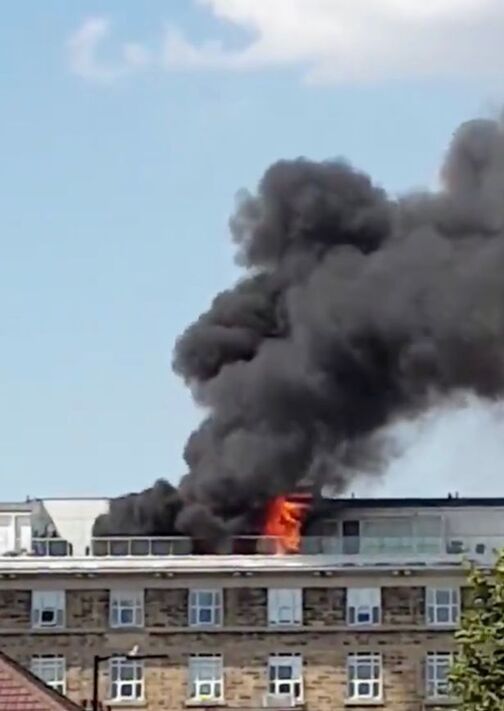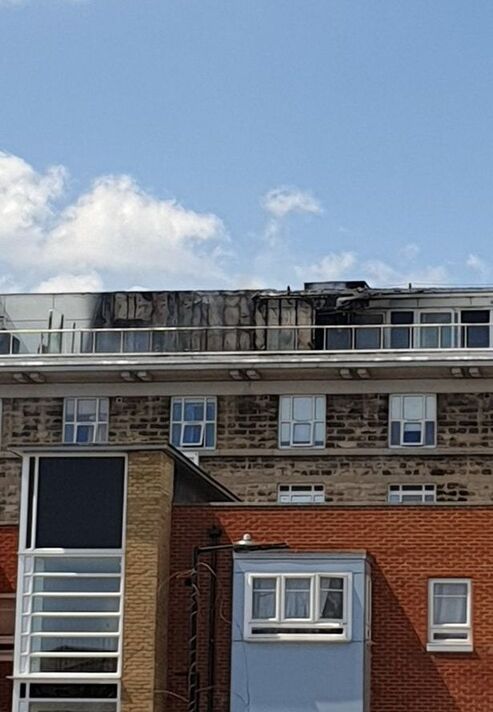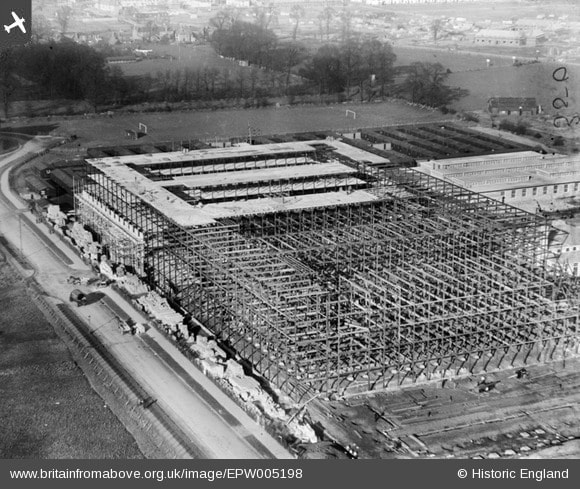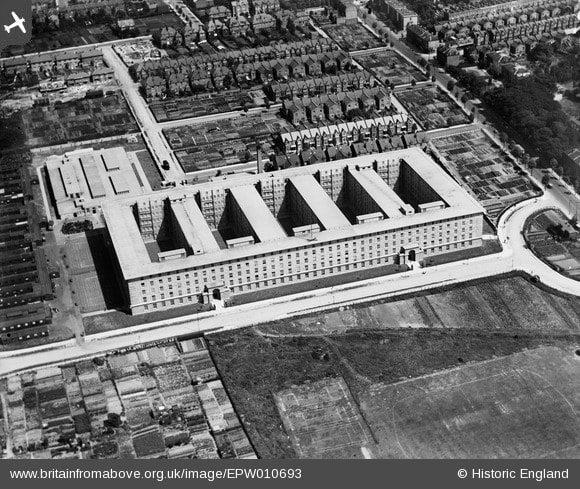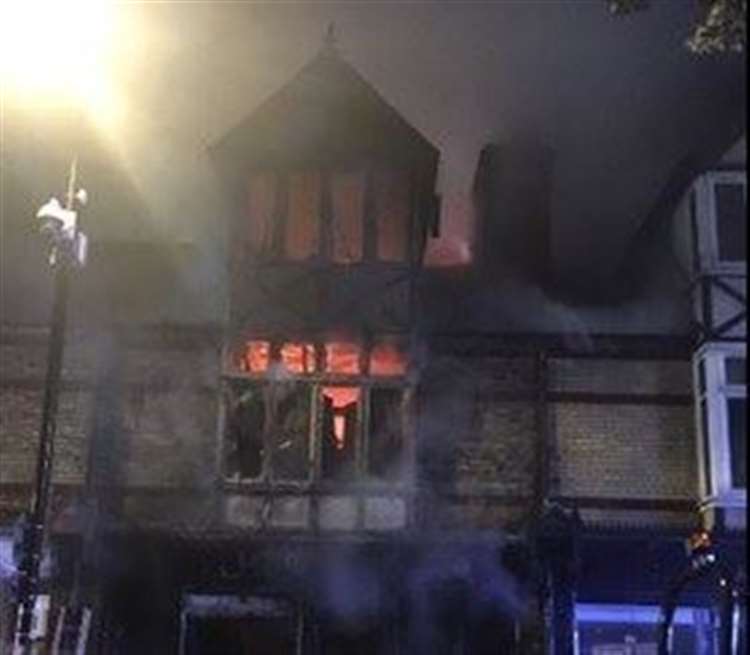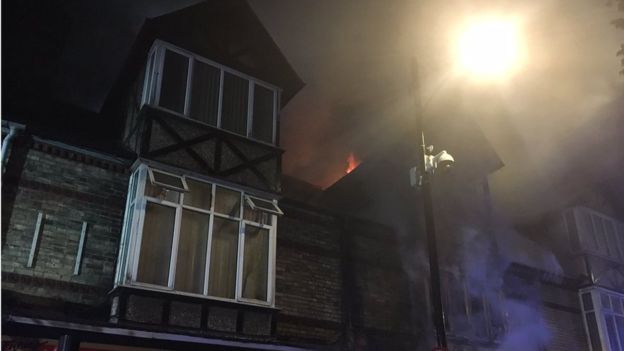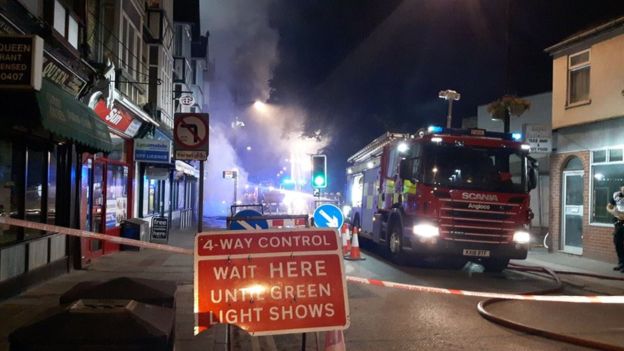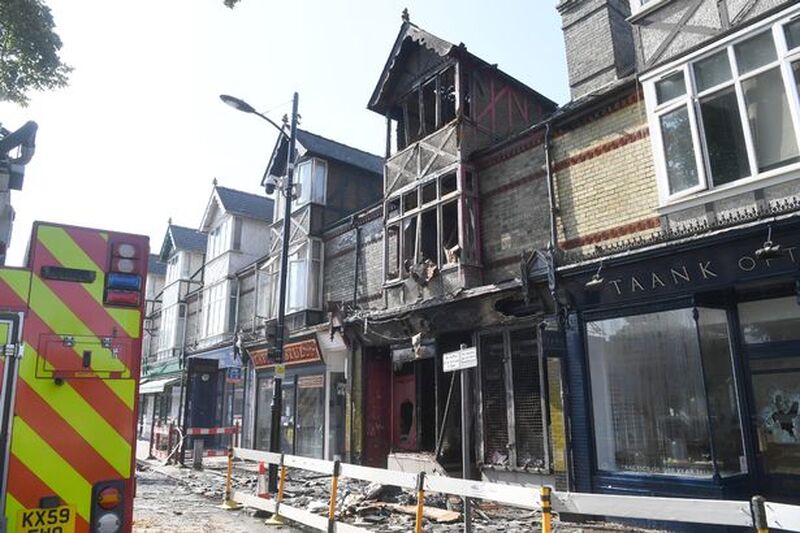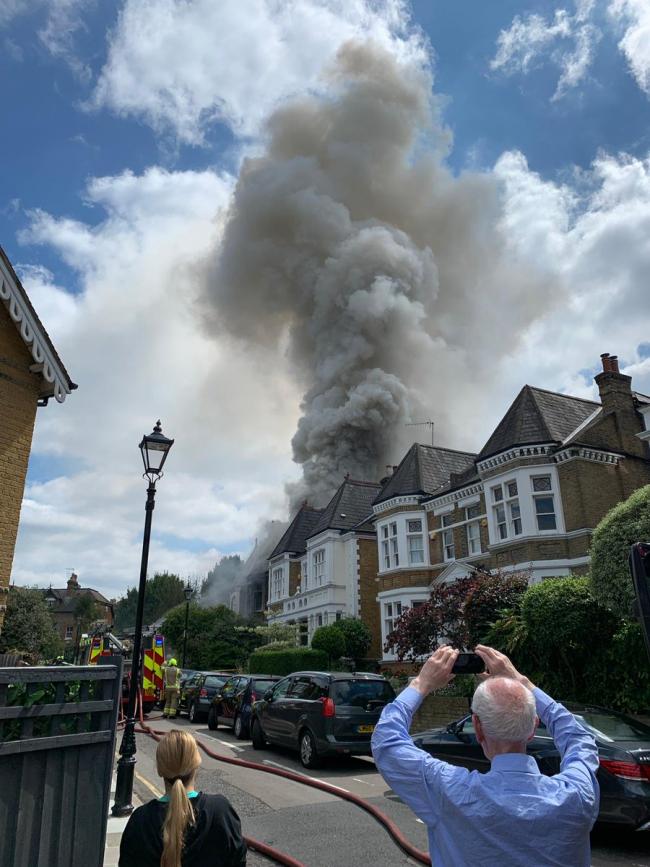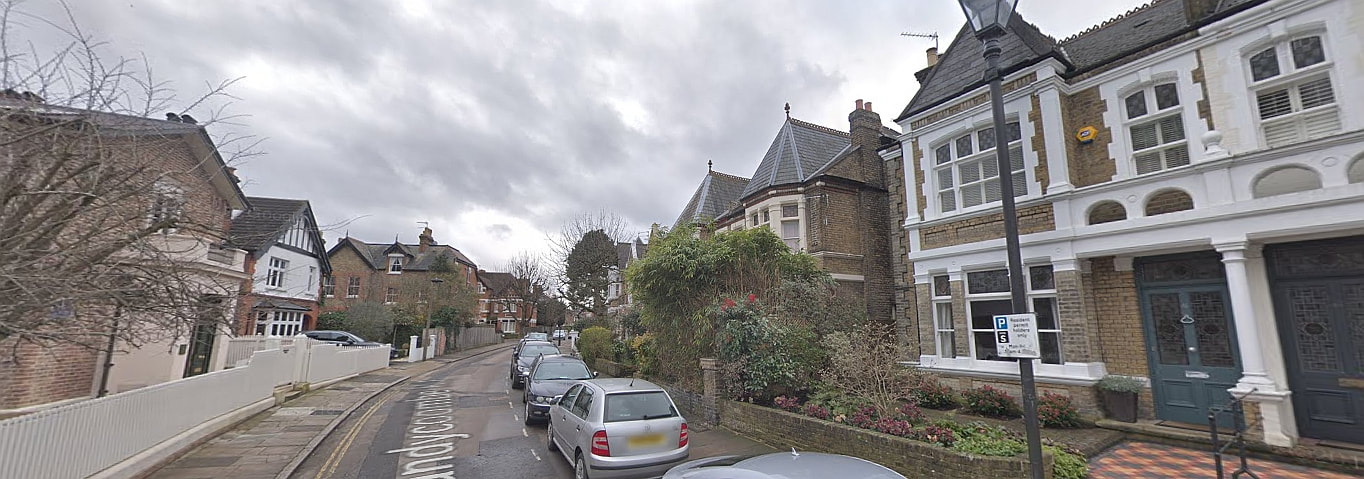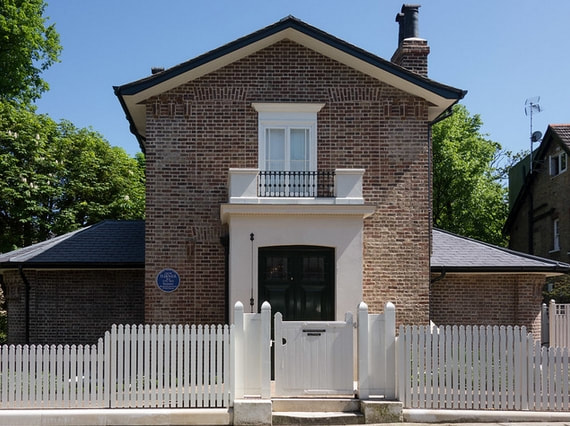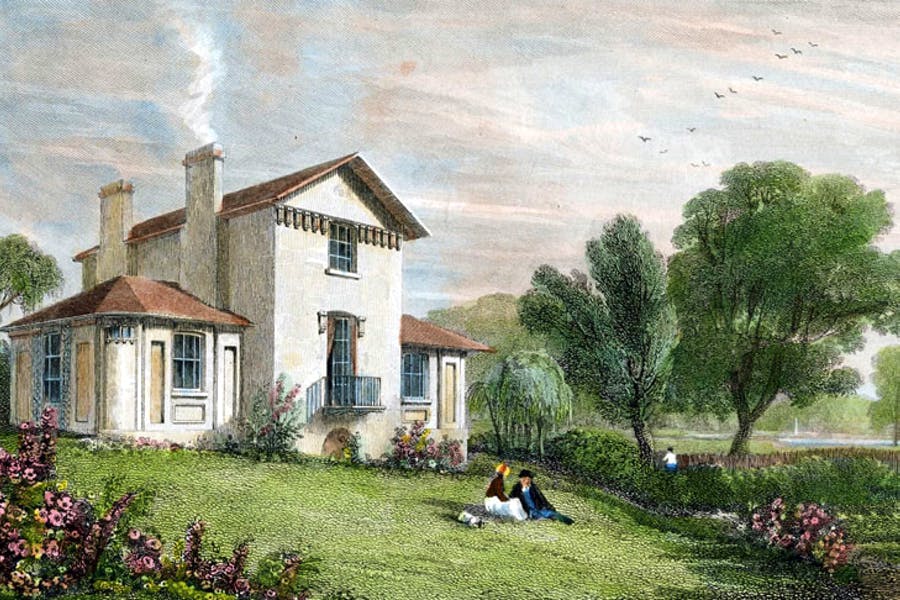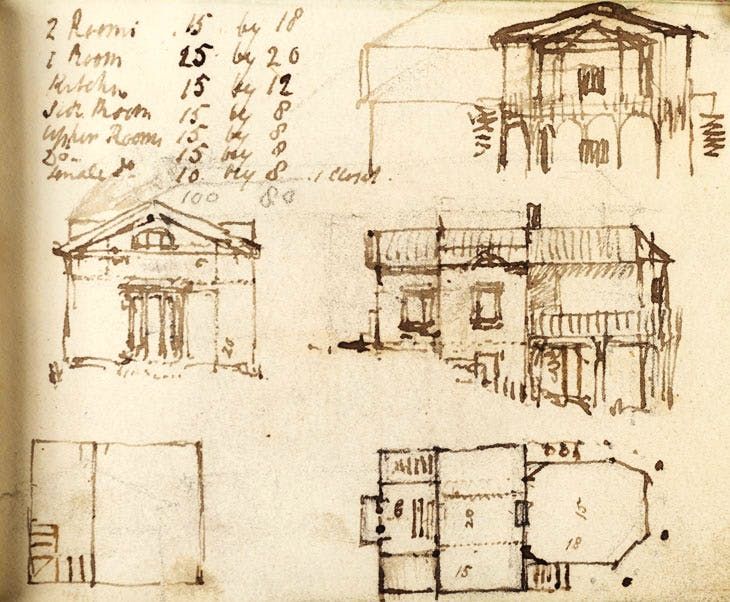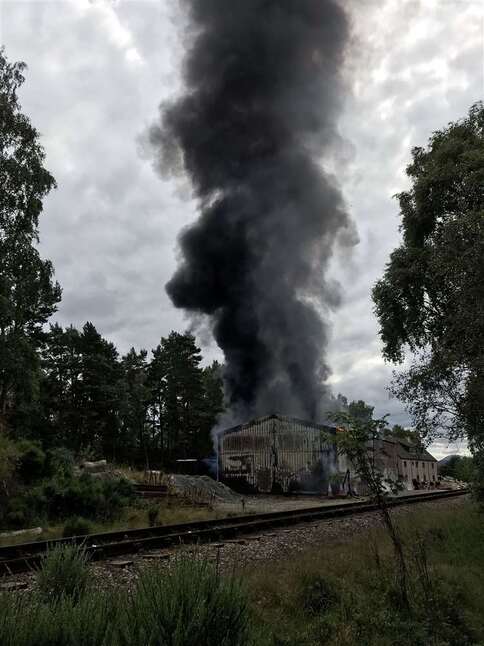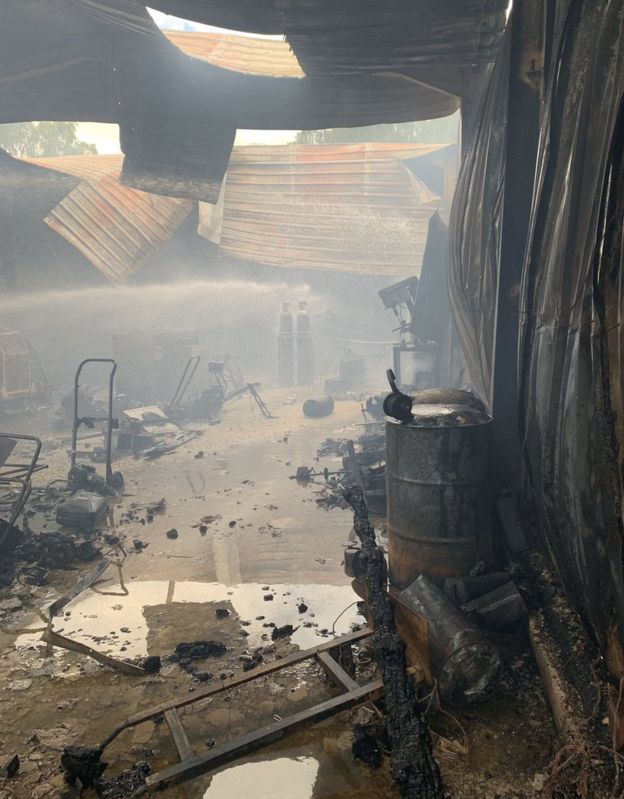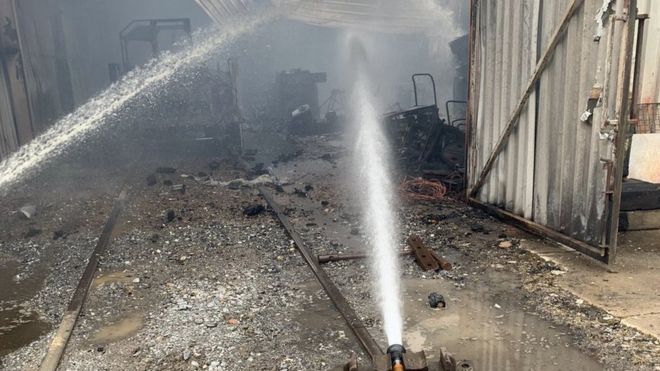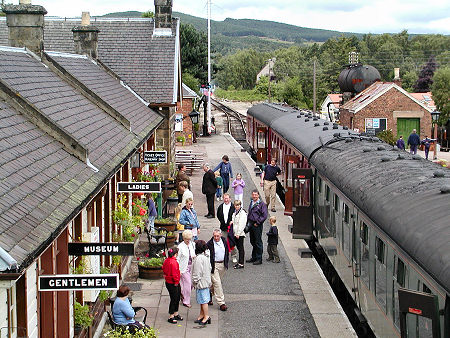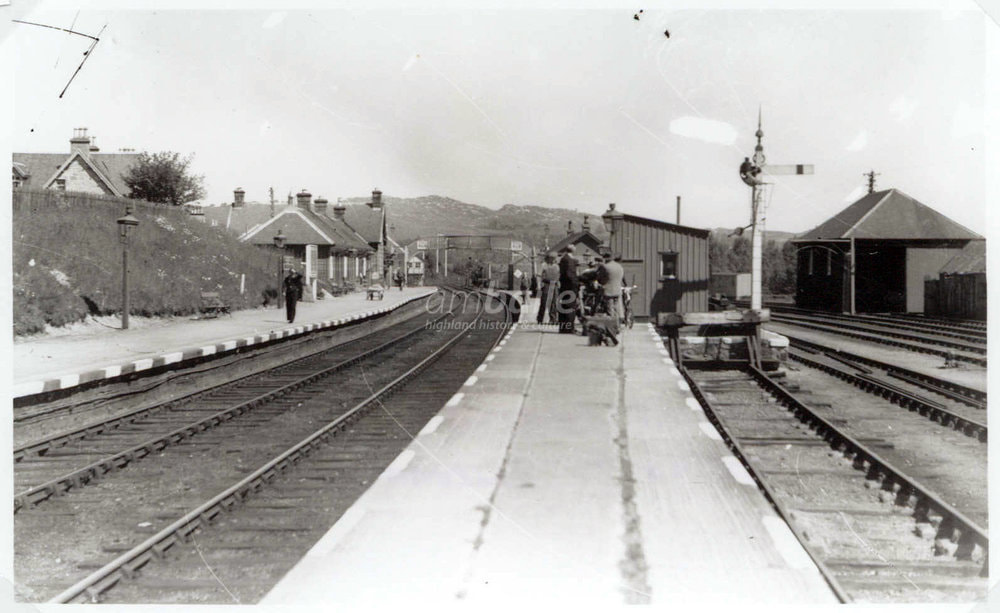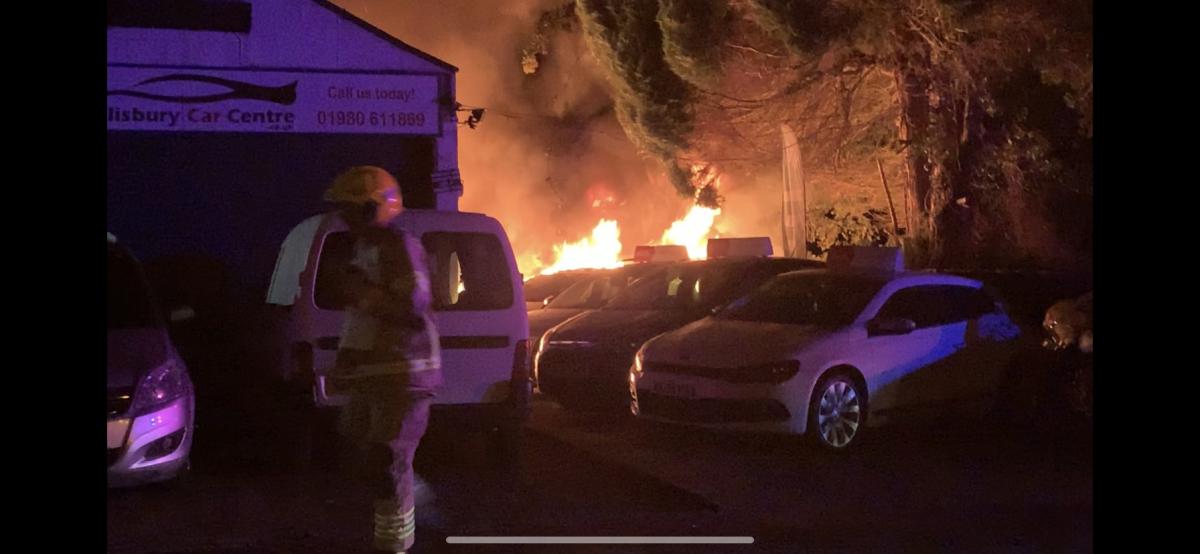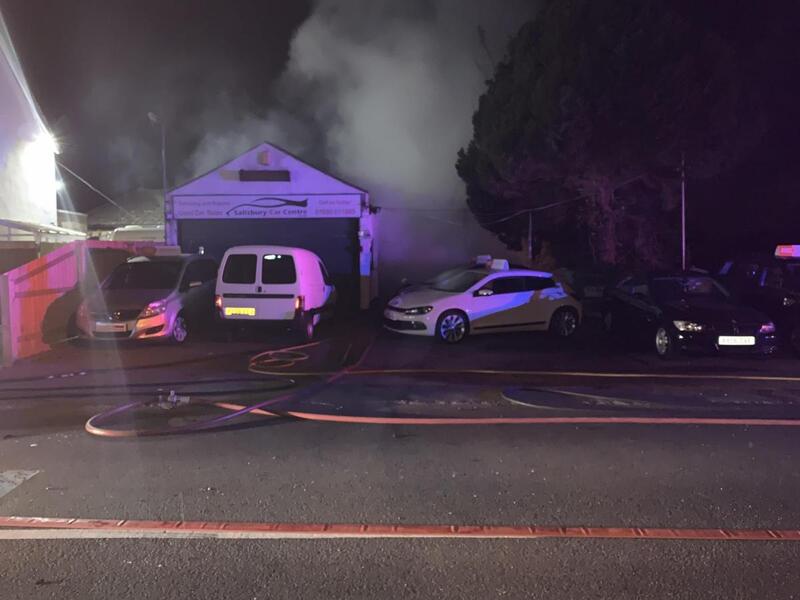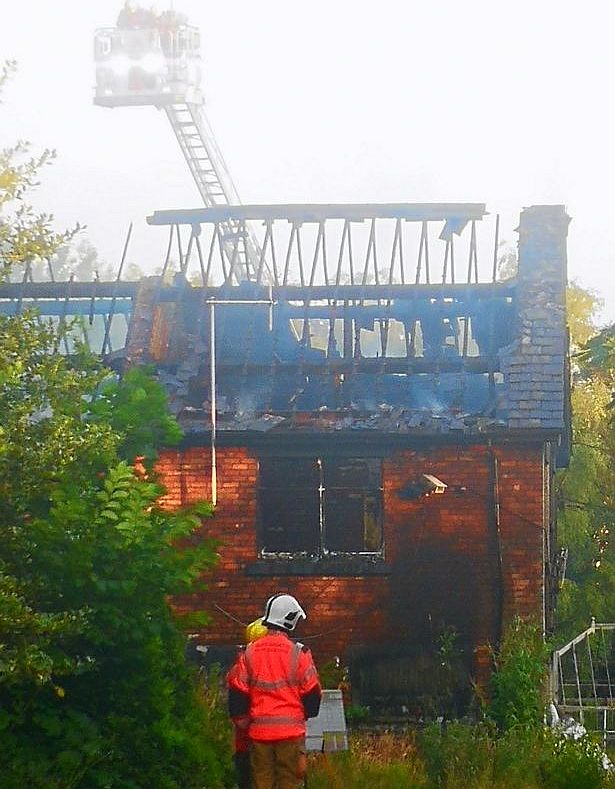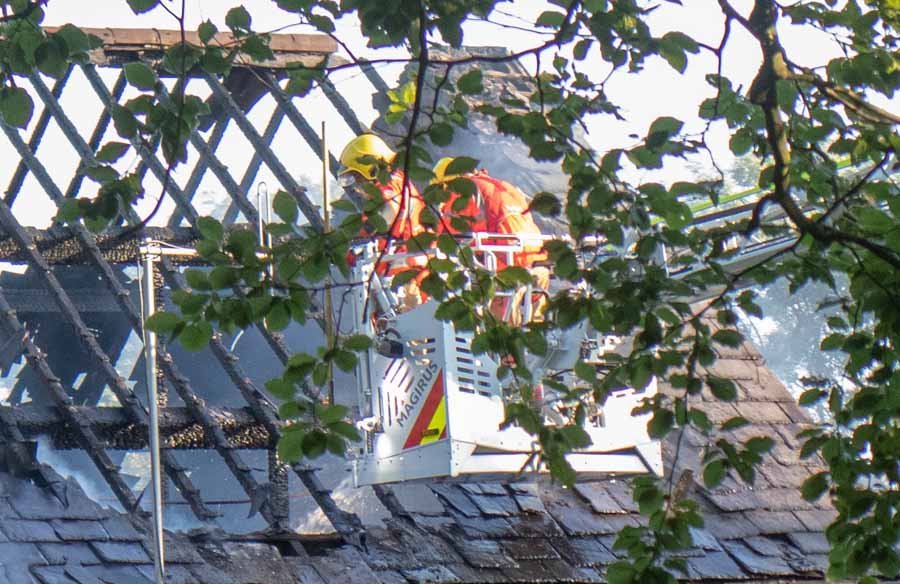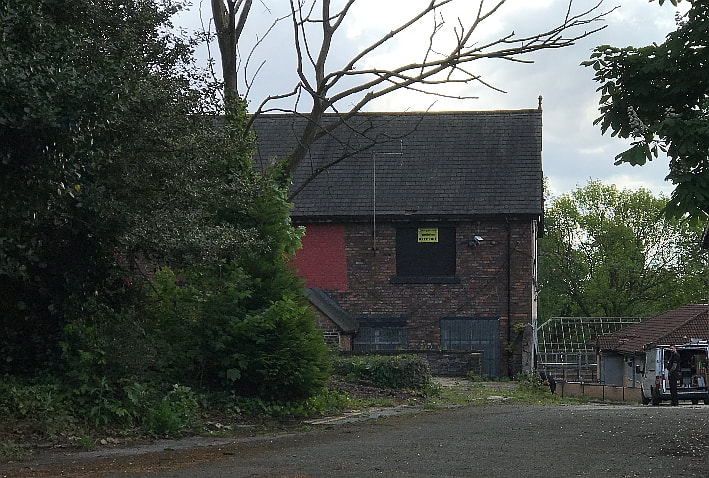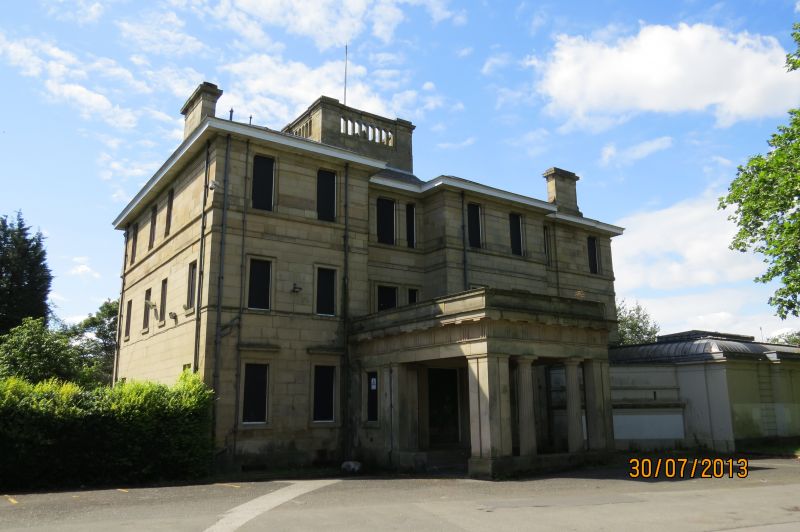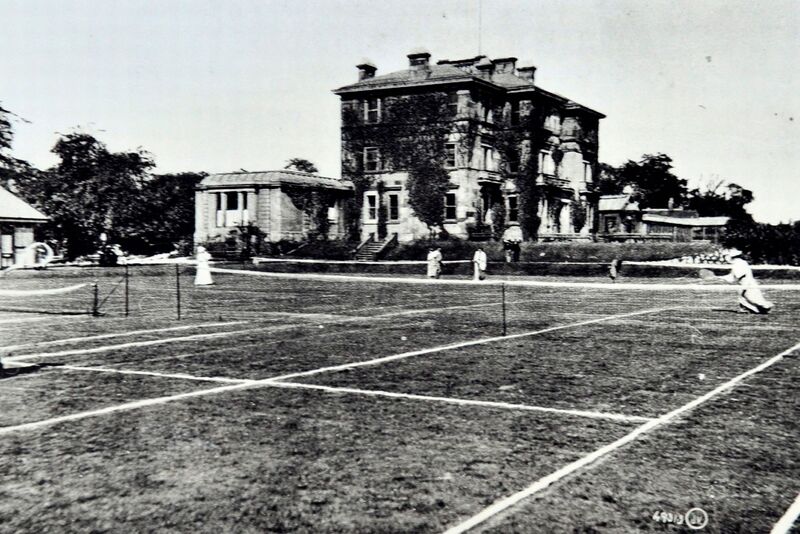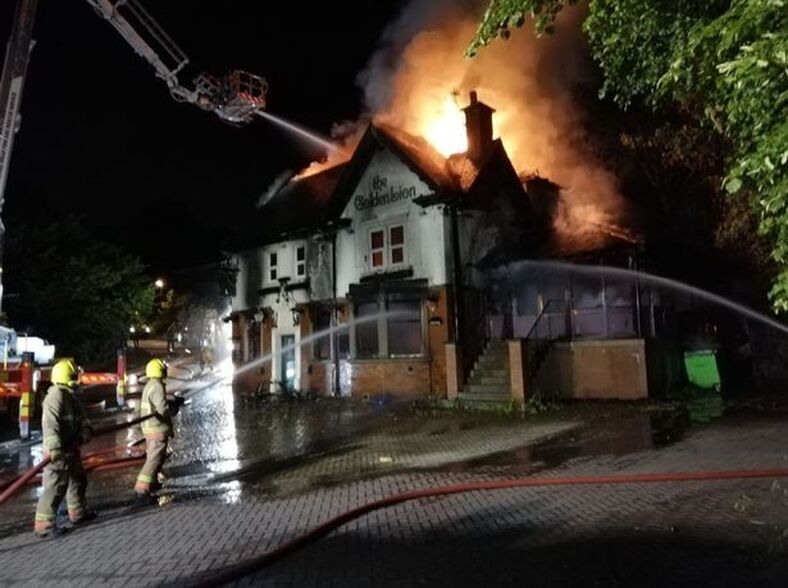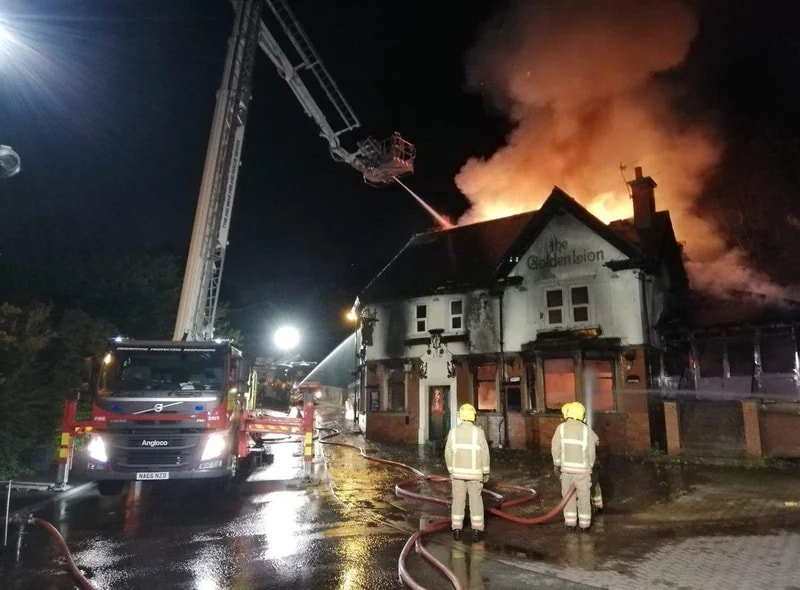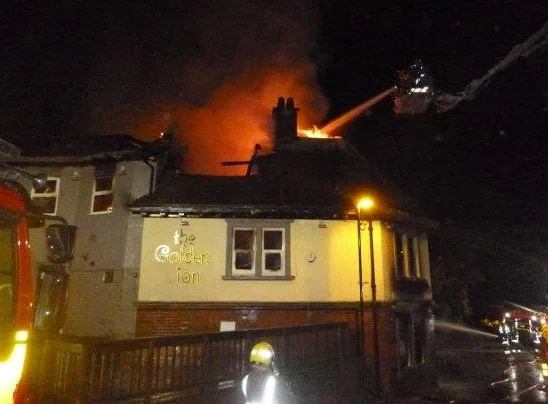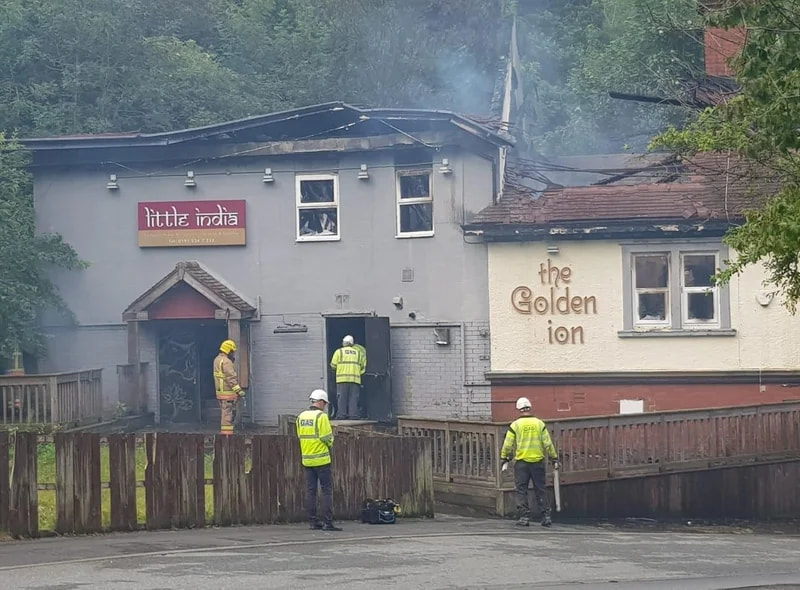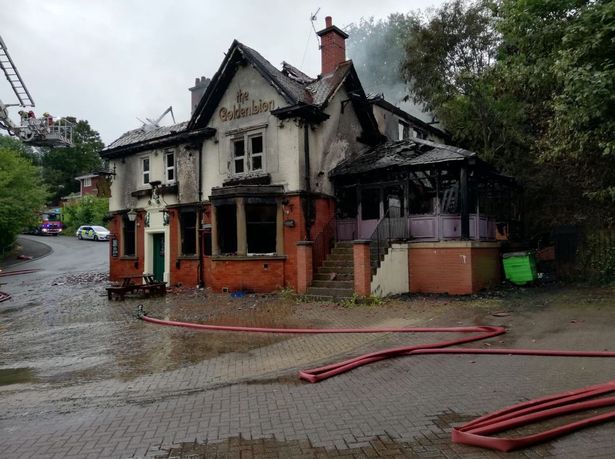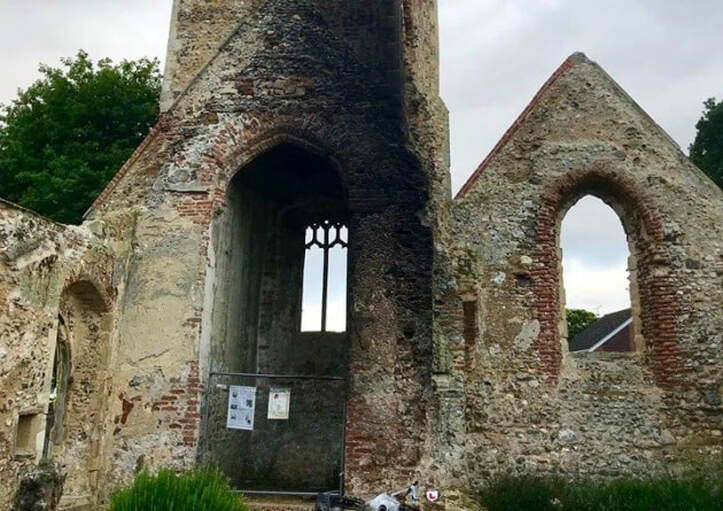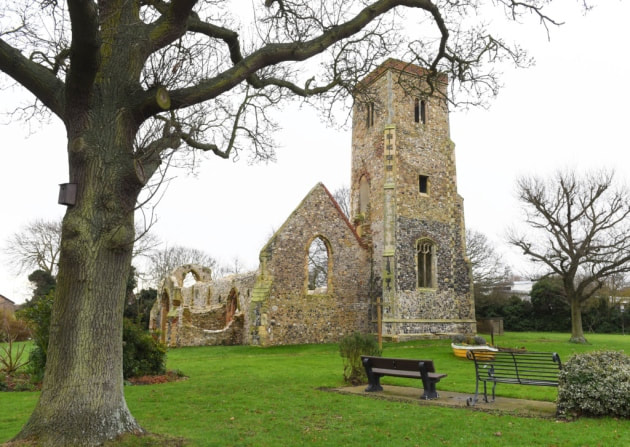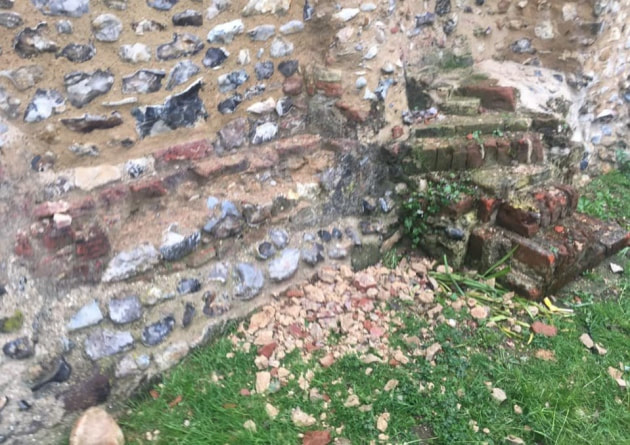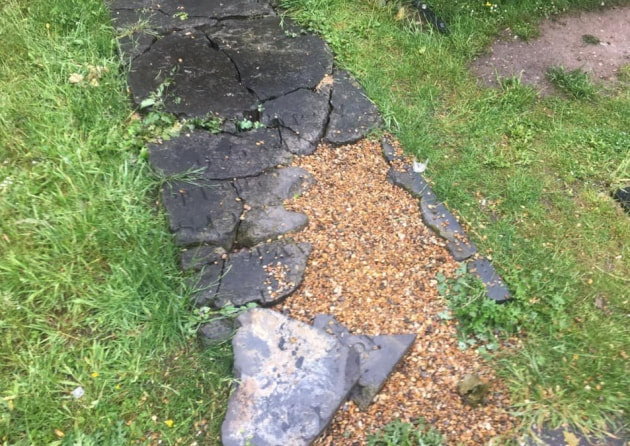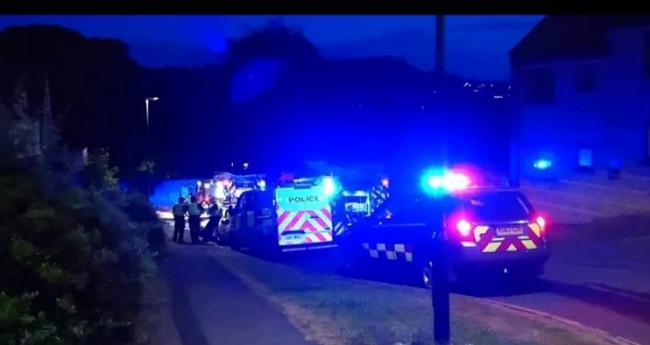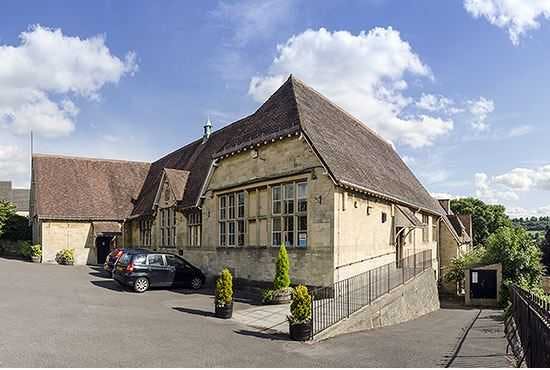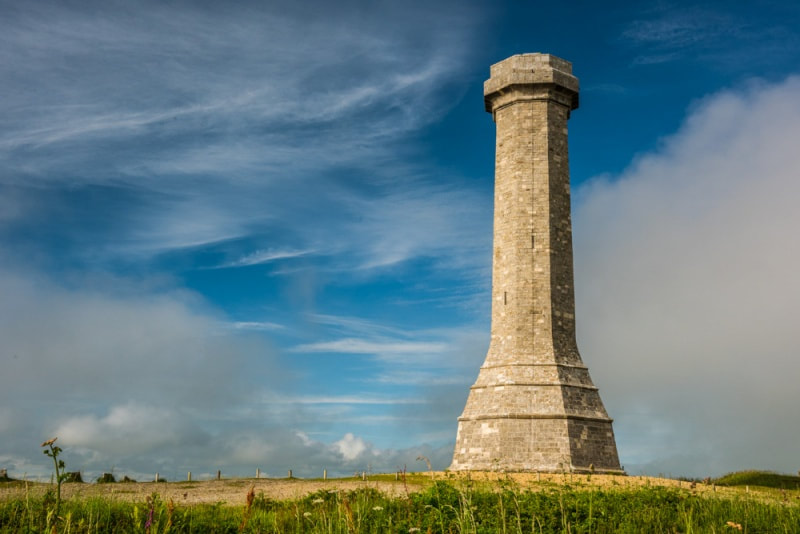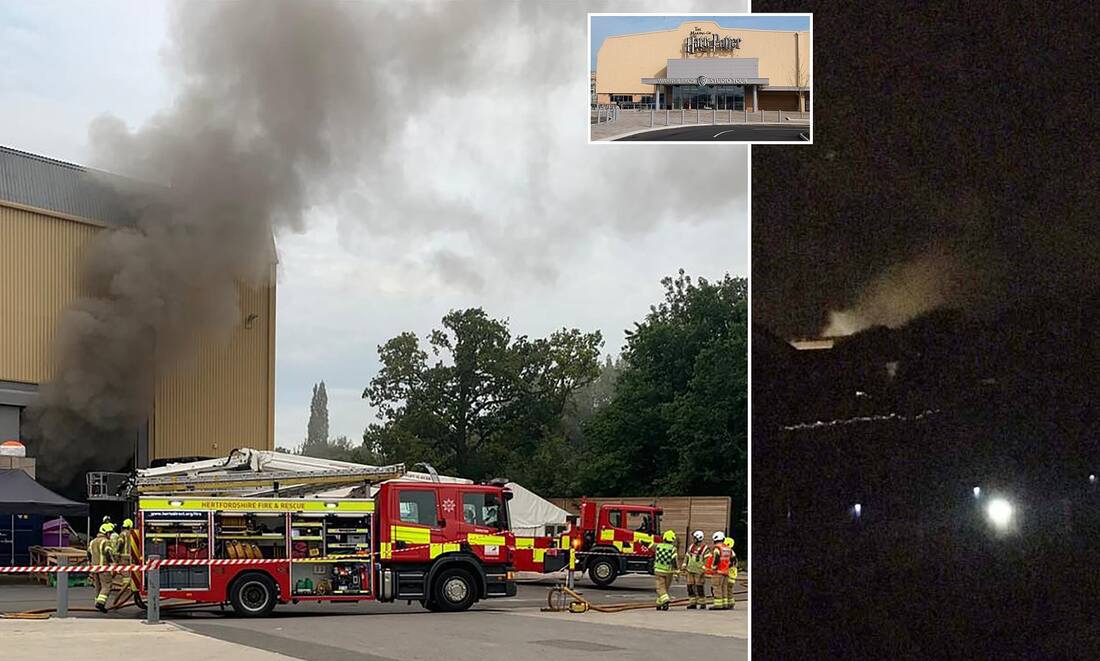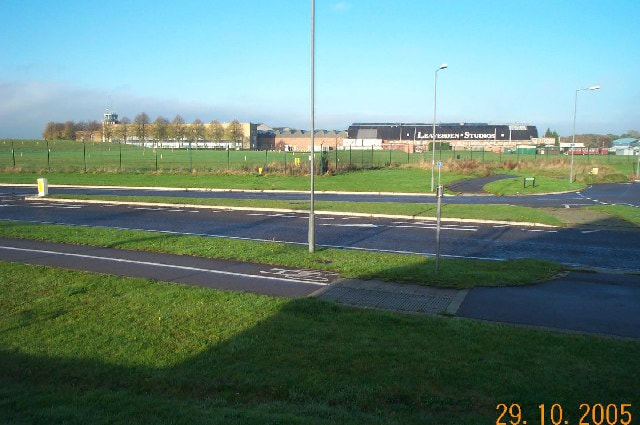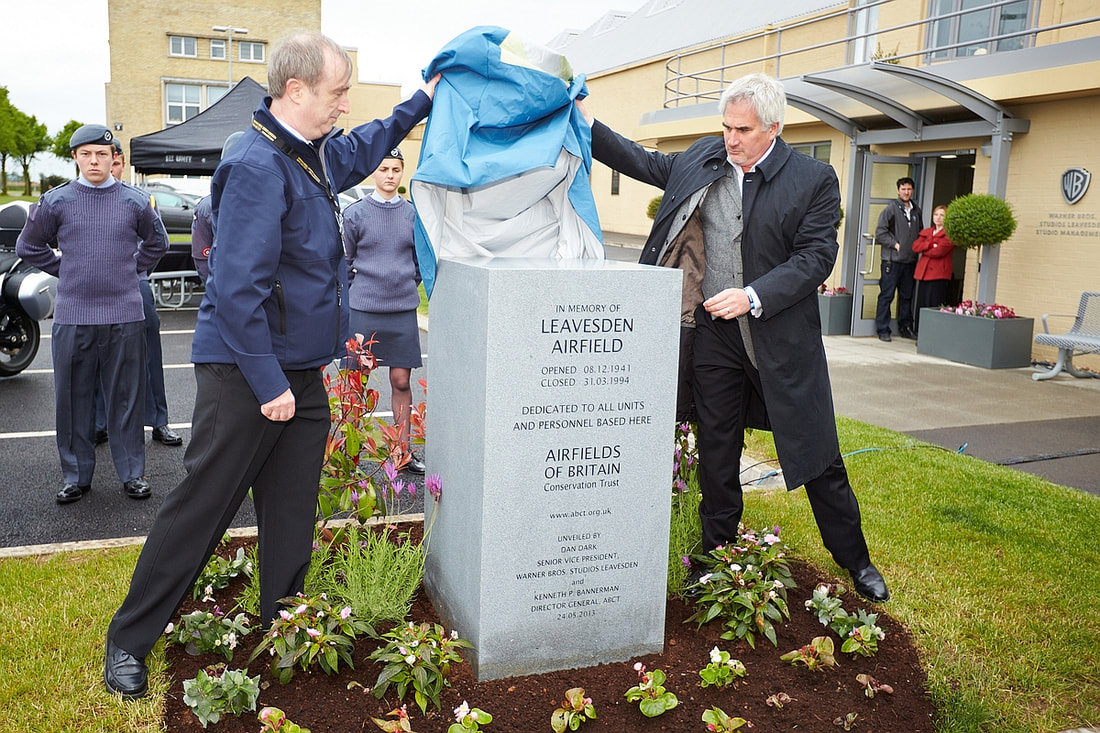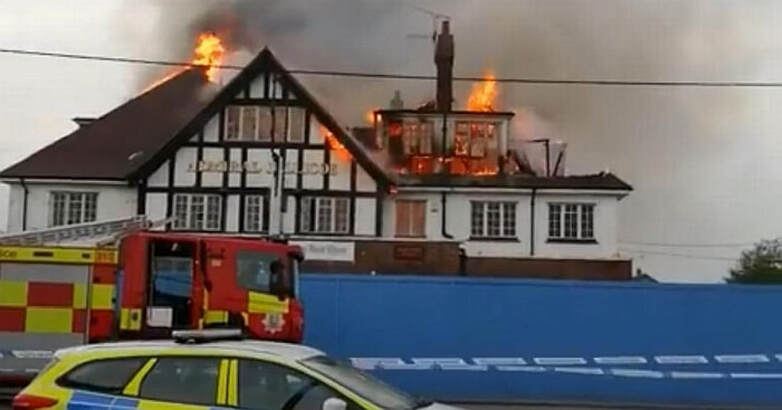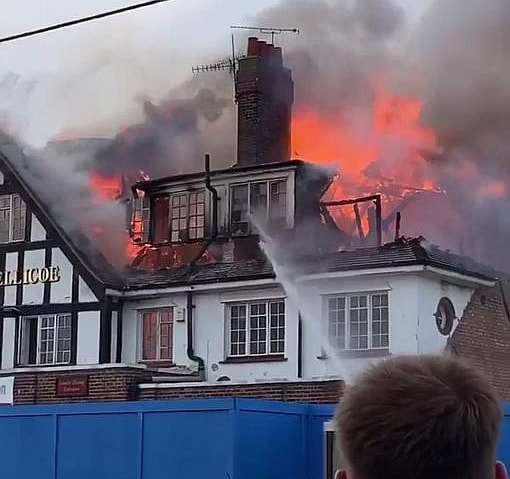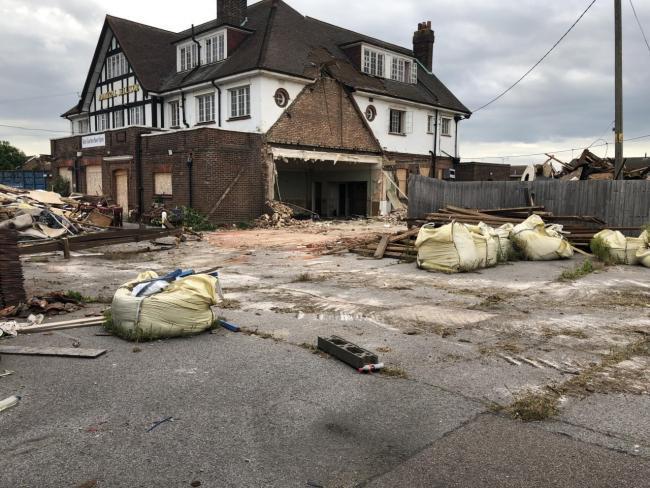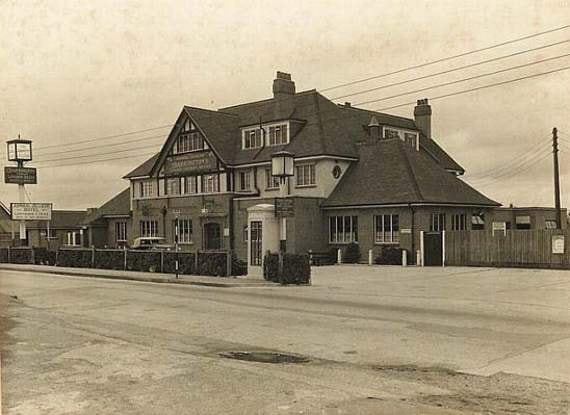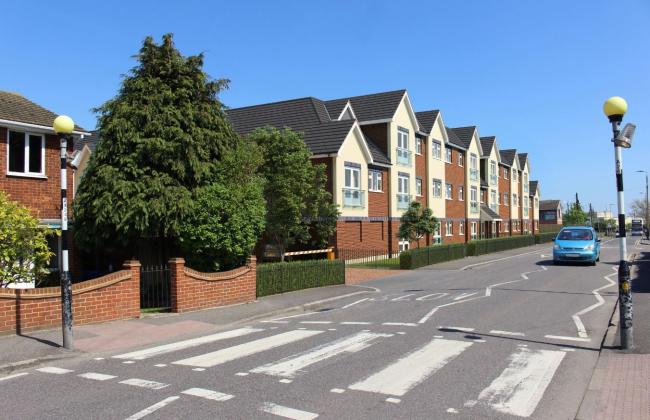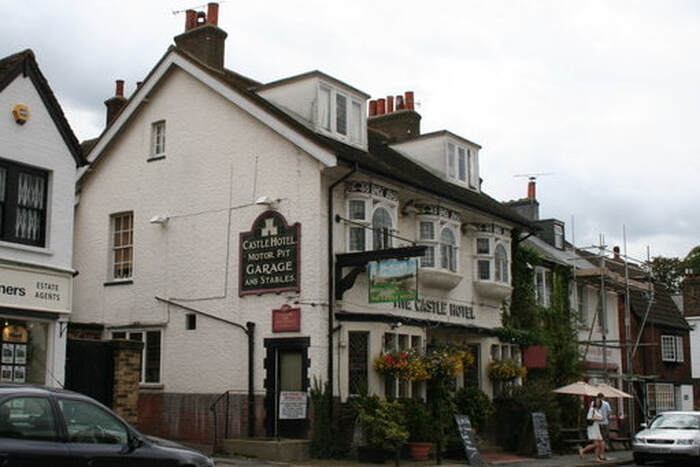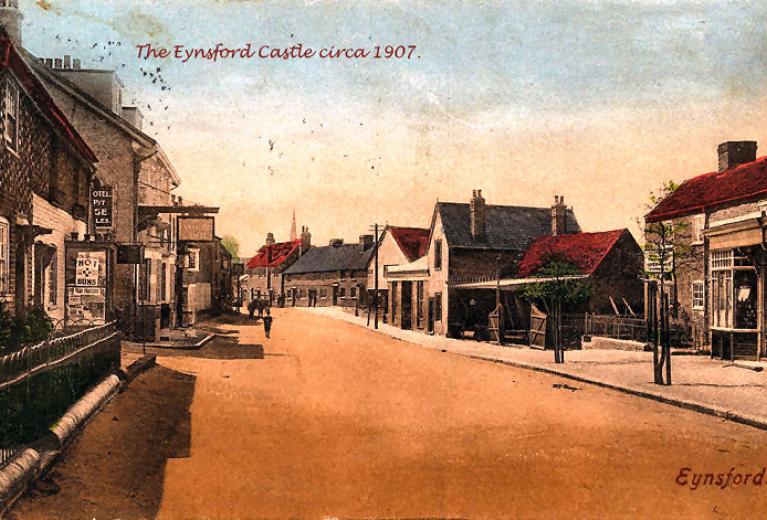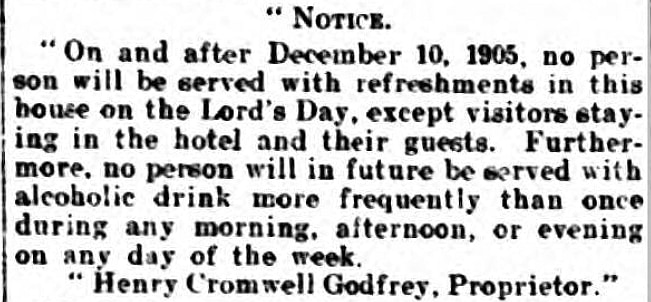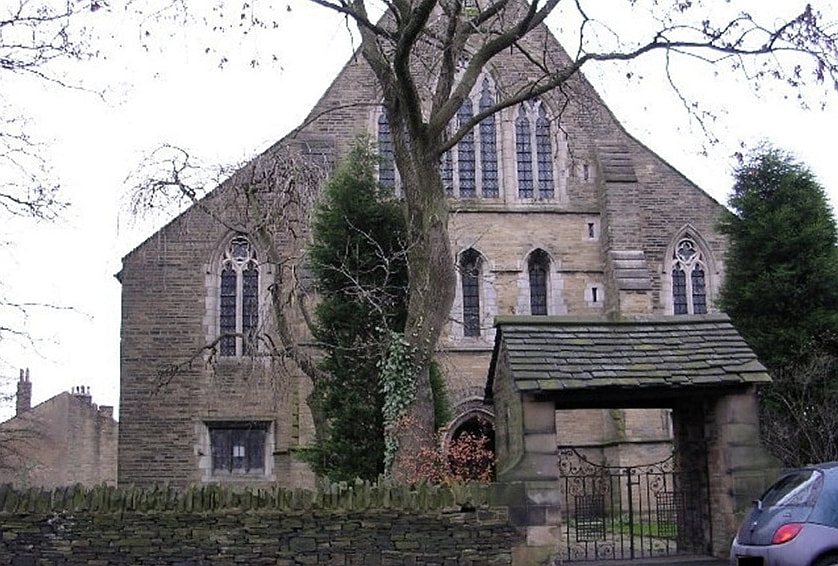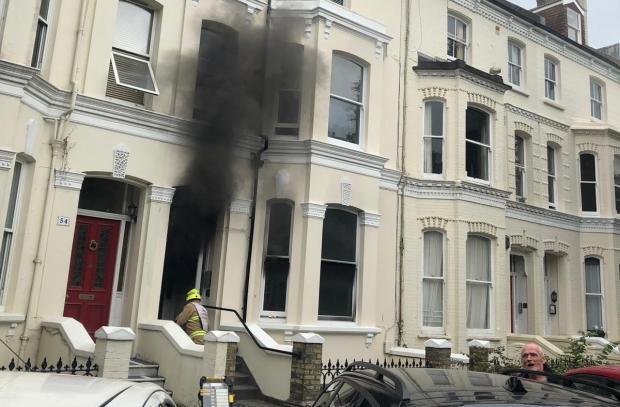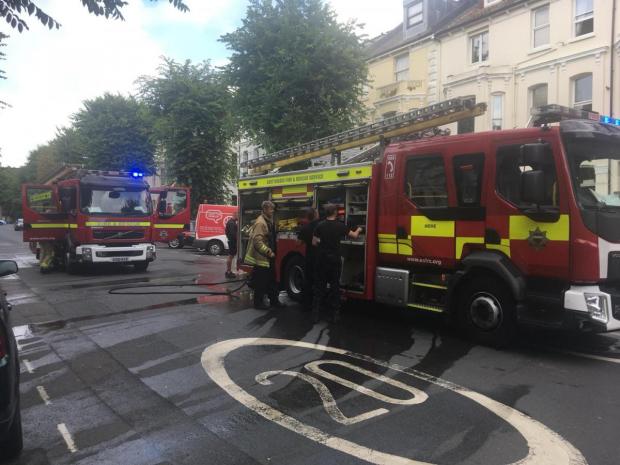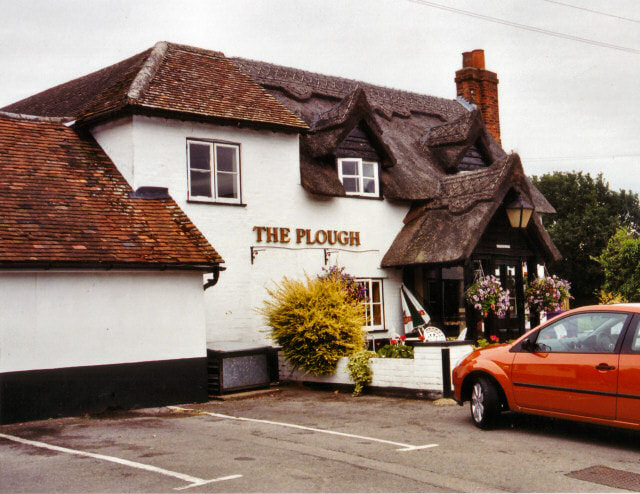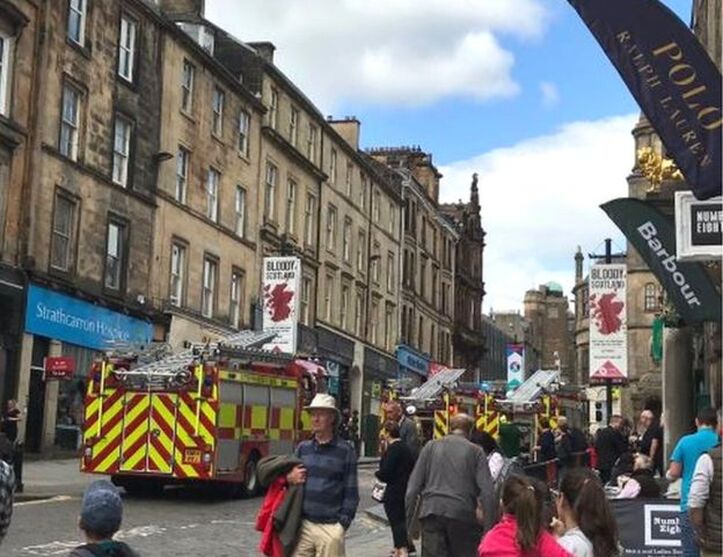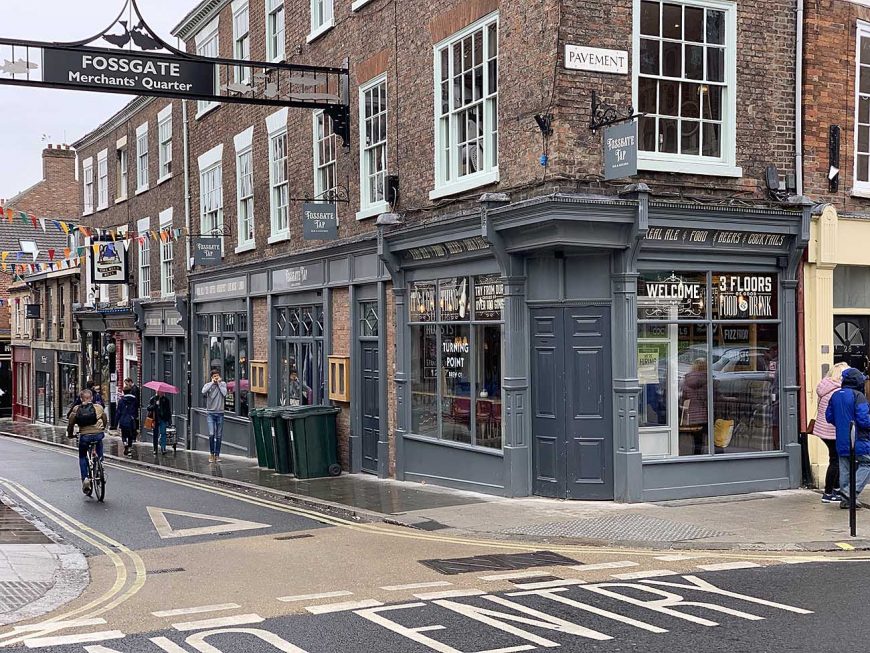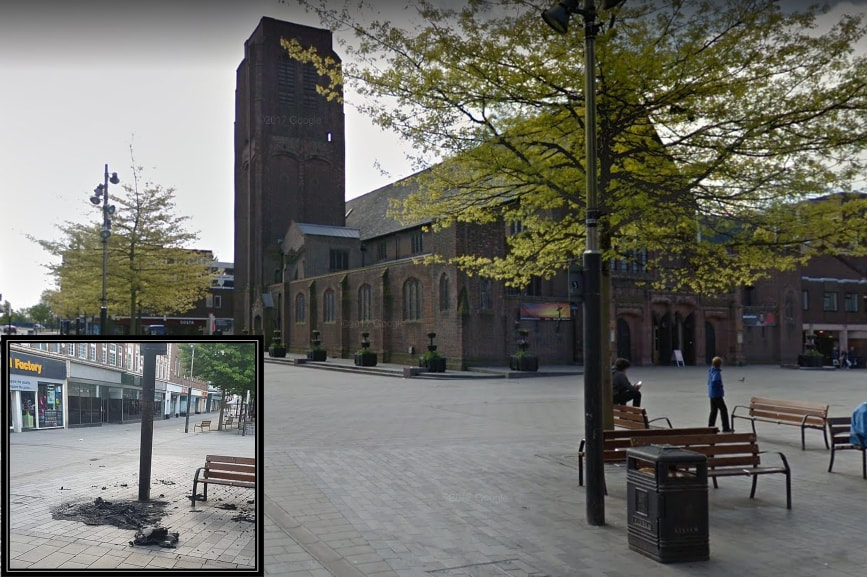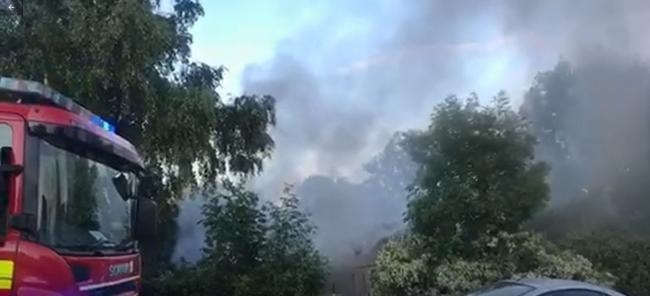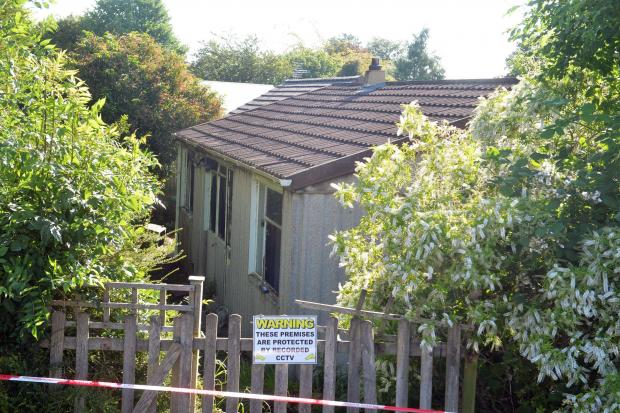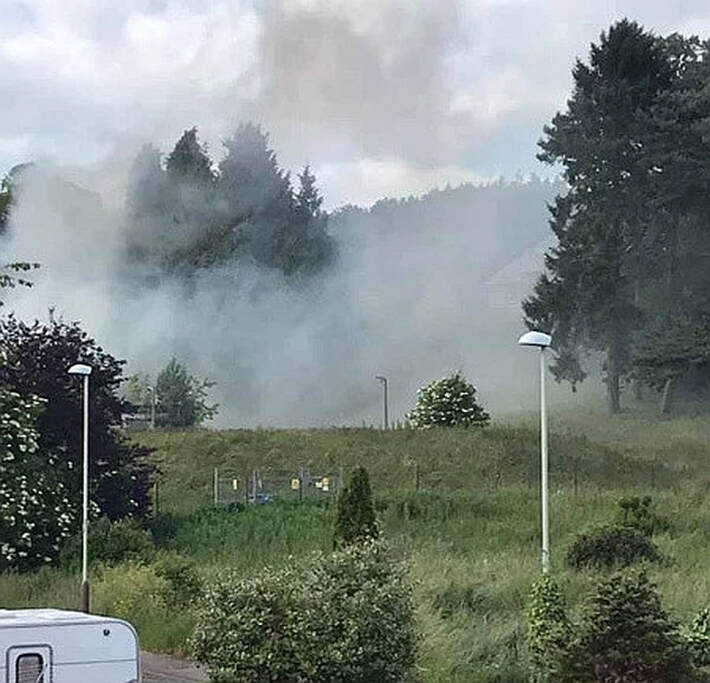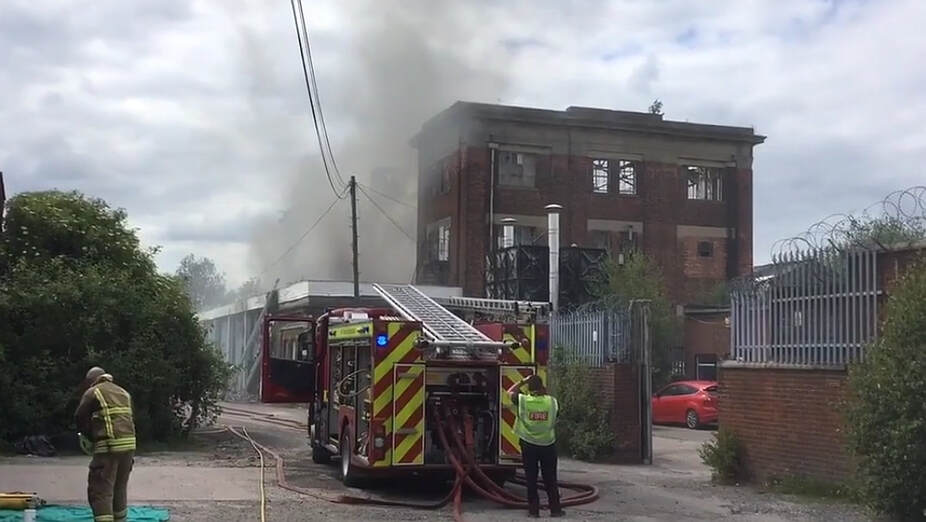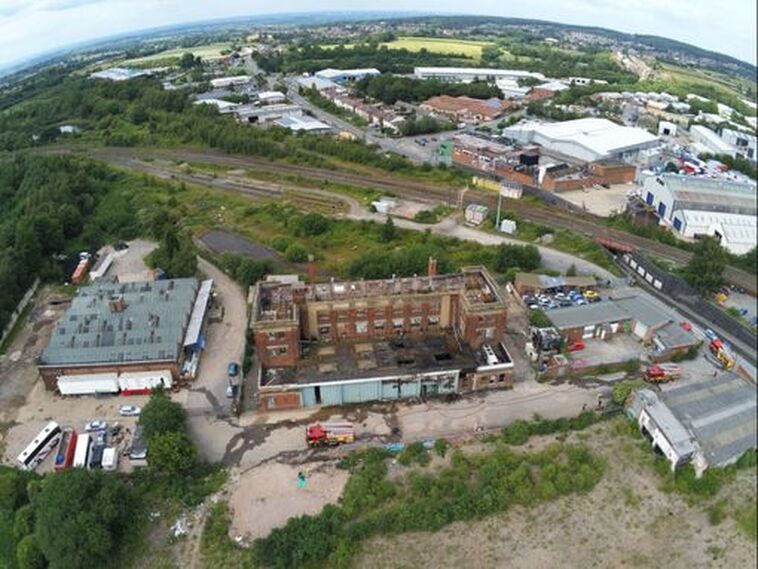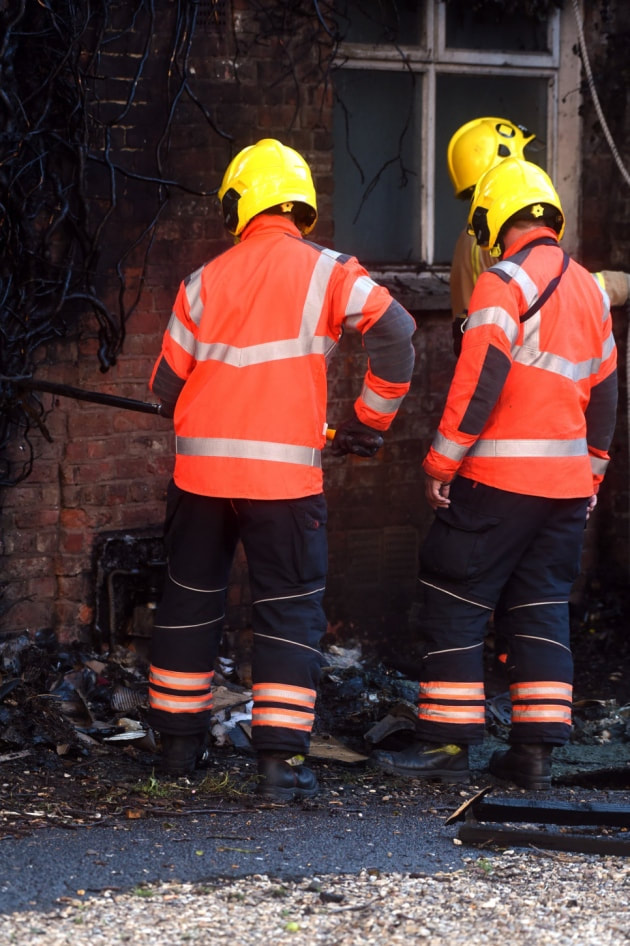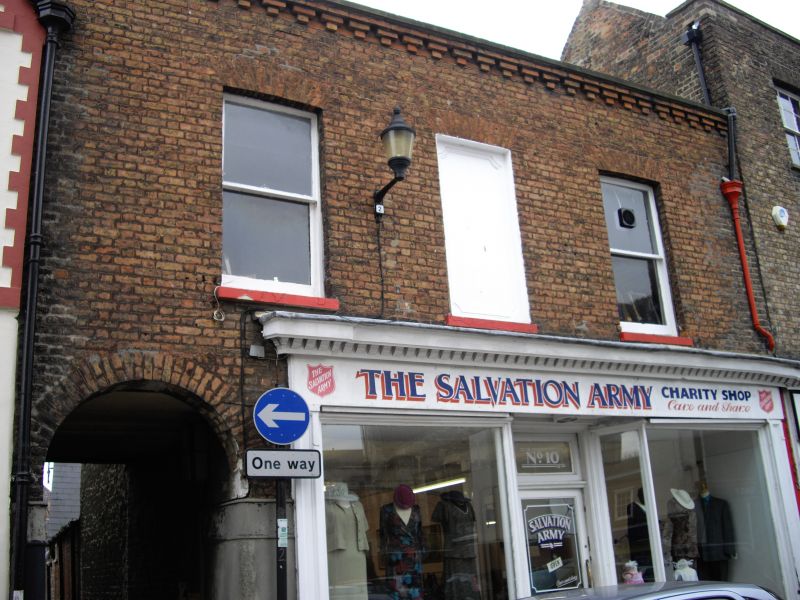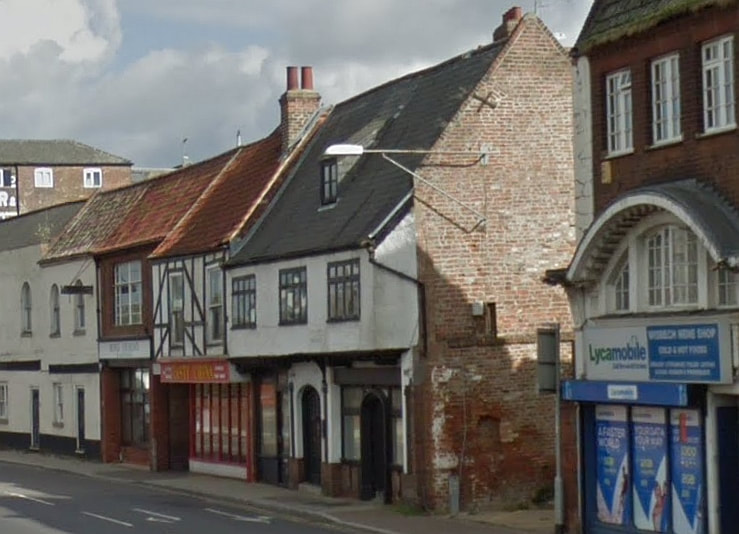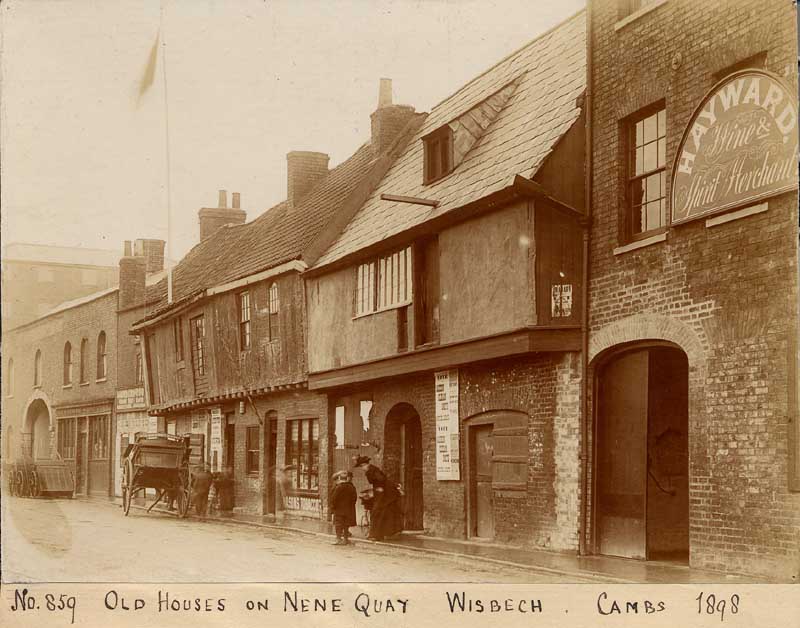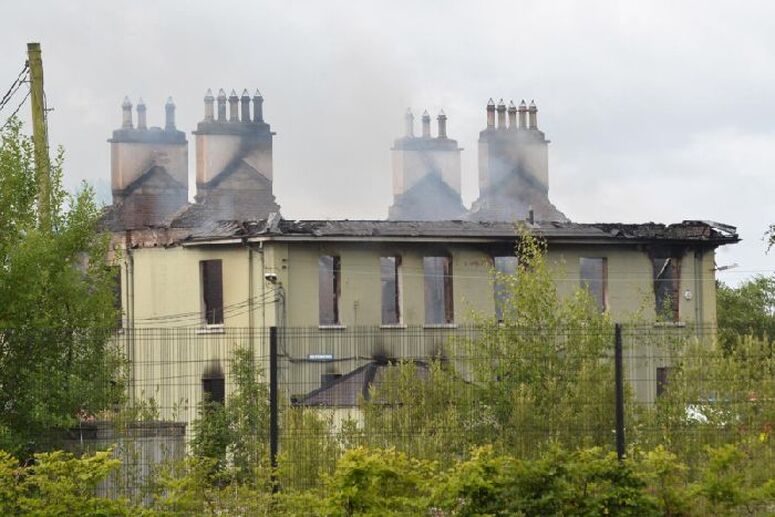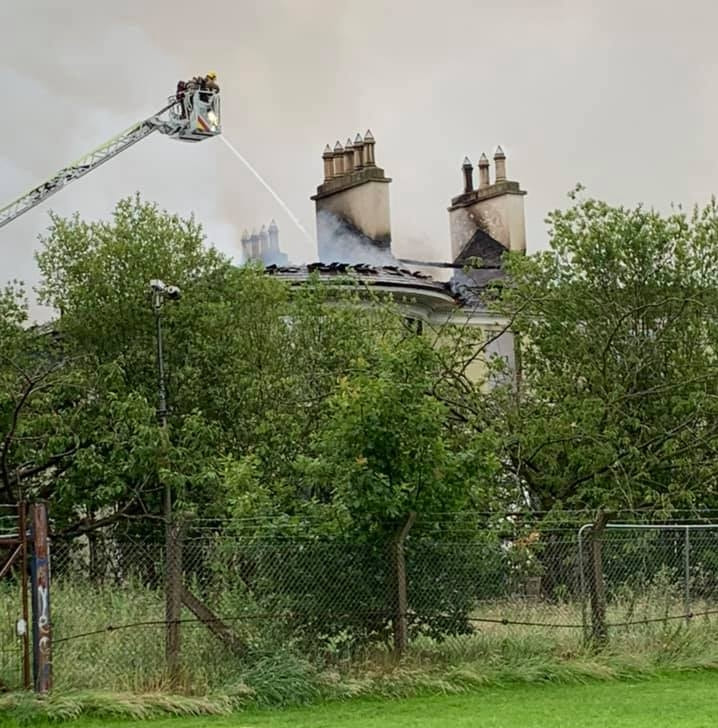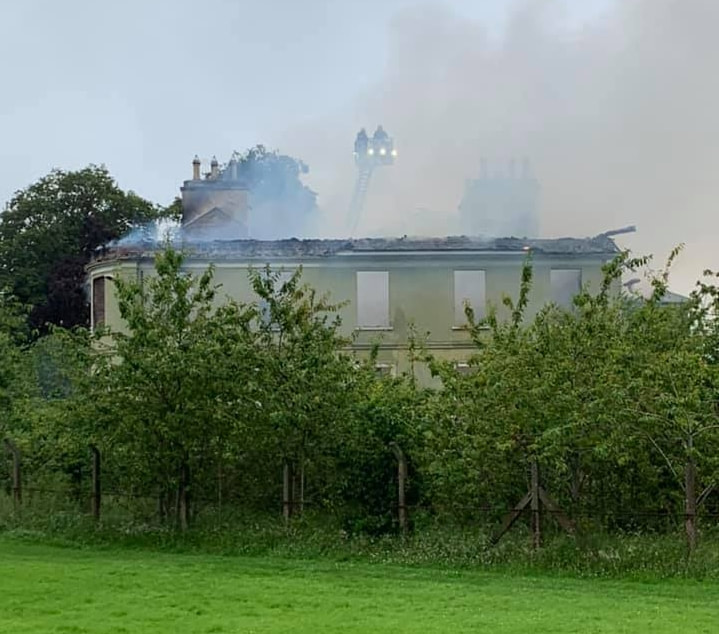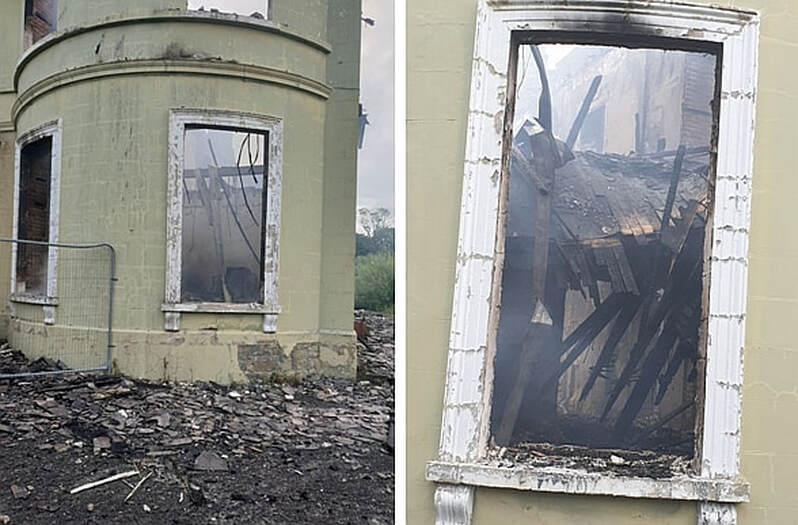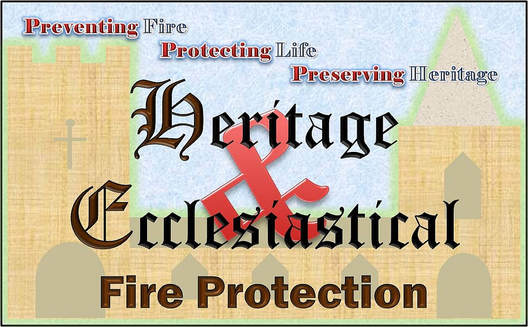73 Fires & 20 Near Misses in
Heritage Buildings Recorded on the 2019 Database in July & August.
(A Fire is defined as an uncontrolled and unwanted burning event (including explosion) causing damage to a heritage building and/or contents by at least one of the following: flame, heat, smoke or blast)
(A Near Miss is defined as an event in a heritage building that had the potential to start a fire, or a fire adjacent to a heritage building that, without intervention, could have spread to that building)
* on the incident time indicates only the approximate time of the incident is known
Heritage Buildings Recorded on the 2019 Database in July & August.
(A Fire is defined as an uncontrolled and unwanted burning event (including explosion) causing damage to a heritage building and/or contents by at least one of the following: flame, heat, smoke or blast)
(A Near Miss is defined as an event in a heritage building that had the potential to start a fire, or a fire adjacent to a heritage building that, without intervention, could have spread to that building)
* on the incident time indicates only the approximate time of the incident is known
Fires Index < Click here
hOME / About / Places of Worship / Heritage Buildings / Domestic listed properties / Country estates / grant /CONTACT US / Fires
|
“It is impossible to find words in which to express our grief over the destruction by fire of the glorious Abbey Church of Selby in Yorkshire. Although the church should be restored, it will be a building without the charm of age and the historic evidences of its structural growth through eight centuries which lent it interest and made it venerable.”
Church Times, 26th October 1906 |
Subscribe to our newsletter
Our Newsletter is out now with articles on all things related to fires, fire prevention, protection and restoration of heritage buildings - See this and our previous Newsletters HERE. "Our Heritage Under Fire" brings interesting, informative and enlightening news and comment for everyone who has an interest in the protection of the UKs built heritage.
Subscribe by clicking the button below to be added to our mailing list. Don't miss an issue. You are signing up only to receive our newsletter, we will not use your contact details, nor pass them on to third parties, for any other purpose. You may unsubscribe from the list at any time. |
Click on the HEADLINE to expand the article.
Heritage & Ecclesiastical Fire Protection
Preventing Fire, Protecting Life, Preserving Heritage
Click HERE for Expert Specialist Fire Safety Risk Assessments for Historic and Listed Buildings
Preventing Fire, Protecting Life, Preserving Heritage
Click HERE for Expert Specialist Fire Safety Risk Assessments for Historic and Listed Buildings
Phone: 07840 351458 Email: hello@fireprotect.me.uk
August - 37 Fires & 4 Near Misses
29 August 2019 (16:30*) - Liverpool city centre building fire leads to major emergency response
There is a large emergency service presence in Liverpool city centre after reports of a fire at an office block. Chapel Street, in the business district, was closed by the fire service shortly after 4pm as smoke could be seen coming from Yorkshire House. A cordon was put in place as crews worked around the building after an evacuation a short time ago. There are currently four fire engines at the scene, with more on the way and community police officers are also helping to maintain the cordon
A large crowd has gathered to watch the fire service operation. Smoke appeared to be coming from a vent underneath Yorkshire House. Workers from the office building watch on as fire crews are at work. Diners leaving the Marco Pierre White restaurant at next-door Hotel Indigo were also gathering to see what was going on. Merseyside Police. have confirmed that the fire began in the underground car park. Officers were called to assist with Merseyside Fire and Rescue Service at 4.40pm. A spokeswoman said the fire appears to be under control.
Landmark building, Yorkshire House was built in 1926 to form the prestigious Liverpool headquarters of the Yorkshire Building Society
News Source: Liverpool Echo
A large crowd has gathered to watch the fire service operation. Smoke appeared to be coming from a vent underneath Yorkshire House. Workers from the office building watch on as fire crews are at work. Diners leaving the Marco Pierre White restaurant at next-door Hotel Indigo were also gathering to see what was going on. Merseyside Police. have confirmed that the fire began in the underground car park. Officers were called to assist with Merseyside Fire and Rescue Service at 4.40pm. A spokeswoman said the fire appears to be under control.
Landmark building, Yorkshire House was built in 1926 to form the prestigious Liverpool headquarters of the Yorkshire Building Society
News Source: Liverpool Echo
29 August 2019 (10:56) - Popular Stourbridge chip shop forced to close after fire
A popular Stourbridge fish and chip shop has been forced to close for a few days after a fire ripped through the shop. Firefighters were called to Ocean Boat in Camp Hill, Wordsley, at 10.56am yesterday (Friday, August 29). A total of 13 firefighters from Brierley Hill and Stourbridge used carbon dioxide extinguishers to tackle the blaze, which involved the extraction system from a deep fat fryer. Crews remained at the scene for several hours after receiving the 999 call, dampening down to ensure the fire was completely out.
The popular chippy ranks up an impressive four stars on Tripadvisor with punters raving about the quality of food and great service. However, the fire will come as a blow to loyal customers as the business has been forced to close its doors for several days. A spokesman for West Midlands Fire Service said the cause was accidental and is not believed to be suspicious. The team from Brierley Hill took to Twitter to share a photograph from the scene with their followers. An accompanying post said: "Our crews have worked with @Stourbridgefire this morning in extinguishing a fire at a chip shop in Wordsley. Fast response and actions limited damage to the property but the shop will be closed for a number of days."
The building was formerly an Inn, built in the late 18th/early 19th century.
News Source: Birmingham Live
The popular chippy ranks up an impressive four stars on Tripadvisor with punters raving about the quality of food and great service. However, the fire will come as a blow to loyal customers as the business has been forced to close its doors for several days. A spokesman for West Midlands Fire Service said the cause was accidental and is not believed to be suspicious. The team from Brierley Hill took to Twitter to share a photograph from the scene with their followers. An accompanying post said: "Our crews have worked with @Stourbridgefire this morning in extinguishing a fire at a chip shop in Wordsley. Fast response and actions limited damage to the property but the shop will be closed for a number of days."
The building was formerly an Inn, built in the late 18th/early 19th century.
News Source: Birmingham Live
Building History
(Researched by Heritage & Ecclesiastical Fire Protection)
The building existed prior to 1822, when it changed its name from Old Jacob’s Well to the Duke of Wellington. The licensee at that time was John Mullett. In 1832 it became the Spotted Leopard and the licensee between 1838 and 1858 was Richard Mills, grandfather of Gerald Rusgrove Mills, the founder of Mills and Boon publishers. It became the Vine in 1864 and the Vine Hotel / Vine Inn a year later.
A Sale by auction 24th September 1915 said “it has a small brewery, recently dismantled, a 15 quarter malthouse” and stabling for six horses” It has a bar, tap room, billiard room, smoke room and private room.” - It was withdrawn at £1,350.
The pub closed in 2008, but reopened on 12th August 2008 as Mad O’Rourke’s Pie and Grill Factory, after a £500,000 refit. It was renamed Vine in July 2010, after the Mad O’Rourke’s chain had financial problems, but closed a month later on 25th August 2010. It was converted into a fish and chip restaurant, which opened in July 2012 as the Ocean Basket, later the Ocean Boat.
(Researched by Heritage & Ecclesiastical Fire Protection)
The building existed prior to 1822, when it changed its name from Old Jacob’s Well to the Duke of Wellington. The licensee at that time was John Mullett. In 1832 it became the Spotted Leopard and the licensee between 1838 and 1858 was Richard Mills, grandfather of Gerald Rusgrove Mills, the founder of Mills and Boon publishers. It became the Vine in 1864 and the Vine Hotel / Vine Inn a year later.
A Sale by auction 24th September 1915 said “it has a small brewery, recently dismantled, a 15 quarter malthouse” and stabling for six horses” It has a bar, tap room, billiard room, smoke room and private room.” - It was withdrawn at £1,350.
The pub closed in 2008, but reopened on 12th August 2008 as Mad O’Rourke’s Pie and Grill Factory, after a £500,000 refit. It was renamed Vine in July 2010, after the Mad O’Rourke’s chain had financial problems, but closed a month later on 25th August 2010. It was converted into a fish and chip restaurant, which opened in July 2012 as the Ocean Basket, later the Ocean Boat.
28 August 2019 (01:45) - Huge fire tears through historic Horncliffe Mansion near Rawtenstall
Residents have spoken of their shock after a historic mansion was gutted in a huge early morning fire. Flames engulfed the Grade II listed Horncliffe mansion in Bury Road, near Rawtentall, at around 1.45am today. Firefighters have tackled the fire at the Victorian building throughout the day.
A spokesman for the fire service said: “The fire started at 1.45am. Six fire engines were called, including units from Lancashire and Greater Manchester as it is on the border, as well as the aerial ladder platform (ALP). When they arrived the building was well alight. There were concerns that there could potentially be people in the building but we don’t believe that’s true. The fire had to be sectorised so it could be tackled from all sides.” The fire has led to the closure of Bury Road from the Whitchaff pub to the junction of Crow Wood Road at Edenfield. A number of bus services have also had to be redirected due to the incident. The cause of the fire is currently unknown and an investigation will take place.
Residents described the fire at the mansion as a 'tragedy and real shame'. One Edenfield resident said: "The fire happened in the middle of the night and I saw smoke from across the valley. It's a tragedy what has happened to such a historic building. Nothing has been done with it for so long and just when it looked like it might be sold, this has happened. It's a real shame." Another resident added: "It's awful what has happened. The building used to be a care home for a long time. It's been vandalised a lot since then and it's really shocking to see what's happened now."
Originally built in 1869 by famous mill owner Henry Hoyle Hardman, the iconic building was previously home to a hotel, wedding venue and care home. There are more than 20 rooms and more than three and a half acres of land. However, the house had been vacant since 2009, after which it fell into an extensive state of disrepair. It was the subject of paranormal investigators and “urban explorers” who nicknamed the property Jag Mansion due to a large number of vintage Jaguar cars found in the grounds.
The building has been "completely gutted" and the fire is being treated as suspicious. A spokeswoman for the Victorian Society said the building had been nominated to be featured in the group's Top 10 Endangered Buildings campaign. She added: "But of course now it is too late as the interior looks as though it has been completely gutted and the historic fabric has been ravaged." The charity is expected to release the top 10 list in two weeks' time to highlight the most at-risk buildings in the country in the hope they can be saved. The spokeswoman continued: "We need only look at the loss of the Fison's fertiliser Factory in Suffolk back in May to realise how serious an issue this is, and how under threat our derelict historic buildings are."
News Source: Lancashire Telegraph
A spokesman for the fire service said: “The fire started at 1.45am. Six fire engines were called, including units from Lancashire and Greater Manchester as it is on the border, as well as the aerial ladder platform (ALP). When they arrived the building was well alight. There were concerns that there could potentially be people in the building but we don’t believe that’s true. The fire had to be sectorised so it could be tackled from all sides.” The fire has led to the closure of Bury Road from the Whitchaff pub to the junction of Crow Wood Road at Edenfield. A number of bus services have also had to be redirected due to the incident. The cause of the fire is currently unknown and an investigation will take place.
Residents described the fire at the mansion as a 'tragedy and real shame'. One Edenfield resident said: "The fire happened in the middle of the night and I saw smoke from across the valley. It's a tragedy what has happened to such a historic building. Nothing has been done with it for so long and just when it looked like it might be sold, this has happened. It's a real shame." Another resident added: "It's awful what has happened. The building used to be a care home for a long time. It's been vandalised a lot since then and it's really shocking to see what's happened now."
Originally built in 1869 by famous mill owner Henry Hoyle Hardman, the iconic building was previously home to a hotel, wedding venue and care home. There are more than 20 rooms and more than three and a half acres of land. However, the house had been vacant since 2009, after which it fell into an extensive state of disrepair. It was the subject of paranormal investigators and “urban explorers” who nicknamed the property Jag Mansion due to a large number of vintage Jaguar cars found in the grounds.
The building has been "completely gutted" and the fire is being treated as suspicious. A spokeswoman for the Victorian Society said the building had been nominated to be featured in the group's Top 10 Endangered Buildings campaign. She added: "But of course now it is too late as the interior looks as though it has been completely gutted and the historic fabric has been ravaged." The charity is expected to release the top 10 list in two weeks' time to highlight the most at-risk buildings in the country in the hope they can be saved. The spokeswoman continued: "We need only look at the loss of the Fison's fertiliser Factory in Suffolk back in May to realise how serious an issue this is, and how under threat our derelict historic buildings are."
News Source: Lancashire Telegraph
Listing Details
|
Mapcode National: GBR DTCV.6L
Mapcode Global: WH97B.LPJN Entry Name: Horncliffe House Listing Date: 30 November 1984 Grade: II Source: Historic England Source ID: 1318001 English Heritage Legacy ID: 185750 Location: Rossendale, Lancashire, BB4 County: Lancashire Electoral Ward/Division: Longholme |
Coordinates
Latitude: 53.6827 / 53°40'57"N Longitude: -2.3031 / 2°18'11"W OS Eastings: 380080 OS Northings: 420731 OS Grid: SD800207 |
25 August 2019 (19:57) - Disused building goes up in flames and four crews race to the scene
Fire crews have rushed to the scene of a blaze in Glasgow's Southside. Four engines are currently battling flames on Scotland Street near to the M8. They rushed into action after being called out this evening. Thick black smoke can be seen rising out the top of a disused building in the area.
Eyewitnesses reported seeing the fire near to Shields Road subway station. It's unclear if anyone has been injured. A Scottish Fire and Rescue Service spokeswoman confirmed they were in attendance. She added: "We currently have four appliances on the scene. We were called out at 7.57pm tonight. Crews are the scene of a disused building".
Niall Murphy, a witness to the incident said on Twitter, “The [Category] B listed Howden’s factory buildings on Scotland Street look to be well ablaze alas...The warehouse on fire is right next door to #Mackintosh’s Scotland Street. Fire tenders were just arriving when we were passing...”
News Source: The Scottish Sun
Eyewitnesses reported seeing the fire near to Shields Road subway station. It's unclear if anyone has been injured. A Scottish Fire and Rescue Service spokeswoman confirmed they were in attendance. She added: "We currently have four appliances on the scene. We were called out at 7.57pm tonight. Crews are the scene of a disused building".
Niall Murphy, a witness to the incident said on Twitter, “The [Category] B listed Howden’s factory buildings on Scotland Street look to be well ablaze alas...The warehouse on fire is right next door to #Mackintosh’s Scotland Street. Fire tenders were just arriving when we were passing...”
News Source: The Scottish Sun
Listing Details
|
Entry Name: 191,193,195,197,199 Scotland Street, Former Howden's Works
Listing Date: 17 June 1986 Category: B Source: Historic Scotland Source ID: 377279 Historic Scotland Designation Reference: LB33533 Building Class: Cultural Location: Glasgow County: Glasgow Town: Glasgow Electoral Ward: Govan Traditional County: Renfrewshire |
Coordinates
Latitude: 55.8492 / 55°50'57"N Longitude: -4.2725 / 4°16'21"W OS Eastings: 257822 OS Northings: 664116 OS Grid: NS578641 Mapcode National: GBR 0GQ.ZY Mapcode Global: WH3P8.B7PR |
Building History
(Researched by Heritage & Ecclesiastical Fire Protection)
Howdens building on Scotland Street was built in 1897 to accommodate James Howden and Co. Engineers. Nisbet Sinclaire was the engineer on the build alongside Bryden and Dykes and Robertson as architects. Originally the building consisted of a single storey, two storey attic, mansard roofed with steel frame appeared later. After 1918 the site expanded further. Howdens is one of the last remaining examples of Victorian engineering work in Scotland. The machine that was used to dig out the Channel Tunnel was born here – in the “red-brick” complex.
The company began in 1856 when James Howden set up his own business as a consulting engineer and a registered patent for machine tools where he began experimenting with axial flow fans to force air into the marine engines. Marine parts such as fans, blowers, compressors, turbines and many more was built here. From the early part of 1940, The Howden Factories were used to build Sunderland flying boat hulls. When the war broke out, Scotland Street employed more than 1700 workers. The complex closed in 1988.
(Researched by Heritage & Ecclesiastical Fire Protection)
Howdens building on Scotland Street was built in 1897 to accommodate James Howden and Co. Engineers. Nisbet Sinclaire was the engineer on the build alongside Bryden and Dykes and Robertson as architects. Originally the building consisted of a single storey, two storey attic, mansard roofed with steel frame appeared later. After 1918 the site expanded further. Howdens is one of the last remaining examples of Victorian engineering work in Scotland. The machine that was used to dig out the Channel Tunnel was born here – in the “red-brick” complex.
The company began in 1856 when James Howden set up his own business as a consulting engineer and a registered patent for machine tools where he began experimenting with axial flow fans to force air into the marine engines. Marine parts such as fans, blowers, compressors, turbines and many more was built here. From the early part of 1940, The Howden Factories were used to build Sunderland flying boat hulls. When the war broke out, Scotland Street employed more than 1700 workers. The complex closed in 1988.
23 August 2019 (18:11) - Former Hotel California in Birkenhead engulfed in flames
Firefighters are battling two large blazes which have engulfed two large buildings less than a mile apart in Birkenhead . The fires took hold at the site of a former barber's shop on Borough Road, next to the old Central Hotel building, and in the former Hotel California and Revolver pub on New Chester Road. Merseyside Fire & Rescue Service deployed four engines and a combined pump ladder to both scenes. A spokeswoman said it was too early to say whether the fires, which both started on the first floor, were deliberately started.
The fire on Borough Road was called in to the fire service at 5.02pm, while calls went in about the New Chester Road fire at 6.11pm. There have been no reports of any injuries in either incident. Road closures are in place on both scenes and Merseyside Police have been informed.
Originally built as a private residence, the Hotel California building was licensed from the early 1800s, at least since 1817. Known by various names, Tranmere Inn, Ferry House, Castle Hotel and became the Royal Castle by 1870, acquired by Threlfalls in mid 1890s and selling Whitbread beers into the 1980s. Later known as Hotel California then Revolver before closure in 2018. Plans for the iconic building to be demolished were approved in February 2019.
The Central Hotel is a more recent building and opened in 1938. It closed in 2014, and had its own major fire in 2016, which was suspected as arson.
News Source: Liverpool Echo
The fire on Borough Road was called in to the fire service at 5.02pm, while calls went in about the New Chester Road fire at 6.11pm. There have been no reports of any injuries in either incident. Road closures are in place on both scenes and Merseyside Police have been informed.
Originally built as a private residence, the Hotel California building was licensed from the early 1800s, at least since 1817. Known by various names, Tranmere Inn, Ferry House, Castle Hotel and became the Royal Castle by 1870, acquired by Threlfalls in mid 1890s and selling Whitbread beers into the 1980s. Later known as Hotel California then Revolver before closure in 2018. Plans for the iconic building to be demolished were approved in February 2019.
The Central Hotel is a more recent building and opened in 1938. It closed in 2014, and had its own major fire in 2016, which was suspected as arson.
News Source: Liverpool Echo
23 August 2019 (16:03) - Fire at Betley Court manor house
A fire has torn through a Grade II* listed manor house in Staffordshire. The blaze at Betley Court, near Newcastle-under-Lyme, was reported at 16:03 BST and six crews were sent to tackle it. The fire service said it wasn't aware of any reported injuries but an ambulance had been sent to the scene. The owner of the building and residents of flats within the property and all 20 residents have "been accounted for".
Posting about the fire on social media, the fire officers said the main road in Betley had been closed while work to tackle the fire continued. Speaking at the scene, chairman of the parish council Robert Bettley-Smith said the owner Prof Nigel Brown had to evacuate the building. It's absolutely terrible," Mr Bettley-Smith said. It's been their life's work to restore the building and turn it into flats and apartments, so it's absolutely heart-breaking what's happened here. The building itself is badly destroyed, possibly a total loss."
Mr Bettley-Smith said, "We are pulling together as a community to do the best we can for the people affected by the fire." Resident Matt Ball said: "It's just heart-breaking. I lived here since I was born and it's the last thing you want to see happen."
Staffordshire Fire and Rescue Service has now revealed what sparked the massive fire. A spokesman said the fire was started accidentally by hot works - things like welding or soldering - that were being carried out to the roof space.
About 20 people lived in the flats, including Jill Sutton who said: "Basically, my world has gone." Mrs Sutton, who had lived at the site for just over a year, said: "My treasured memories, my life with my husband who had passed away, all those memories and belongings - the only things I'd got left is what I was stood up in. When I saw [the damage], I was screaming, I was crying. The devastation of the building and how much damage the fire had caused - I was in total shock."
Betley Court was built in 1716 for John Craddock with 18th century alterations by George
Wilkinson. William Eames was commissioned in 1783 to provide extensive gardens with parterres and water features, linked by newly planted trees. Further alterations were carried out to the house in 1809 by John Nash, and in the late 19th and early 20th century by William Douglas Caroe for Thomas Fletcher-Tremlow. By this time the Fletcher-Tremlows owned much of the land and buildings in the centre and south of Betley including Betley Court Farm. The Manor House lies within Betley Conservation Area.
News Source: BBC News
Posting about the fire on social media, the fire officers said the main road in Betley had been closed while work to tackle the fire continued. Speaking at the scene, chairman of the parish council Robert Bettley-Smith said the owner Prof Nigel Brown had to evacuate the building. It's absolutely terrible," Mr Bettley-Smith said. It's been their life's work to restore the building and turn it into flats and apartments, so it's absolutely heart-breaking what's happened here. The building itself is badly destroyed, possibly a total loss."
Mr Bettley-Smith said, "We are pulling together as a community to do the best we can for the people affected by the fire." Resident Matt Ball said: "It's just heart-breaking. I lived here since I was born and it's the last thing you want to see happen."
Staffordshire Fire and Rescue Service has now revealed what sparked the massive fire. A spokesman said the fire was started accidentally by hot works - things like welding or soldering - that were being carried out to the roof space.
About 20 people lived in the flats, including Jill Sutton who said: "Basically, my world has gone." Mrs Sutton, who had lived at the site for just over a year, said: "My treasured memories, my life with my husband who had passed away, all those memories and belongings - the only things I'd got left is what I was stood up in. When I saw [the damage], I was screaming, I was crying. The devastation of the building and how much damage the fire had caused - I was in total shock."
Betley Court was built in 1716 for John Craddock with 18th century alterations by George
Wilkinson. William Eames was commissioned in 1783 to provide extensive gardens with parterres and water features, linked by newly planted trees. Further alterations were carried out to the house in 1809 by John Nash, and in the late 19th and early 20th century by William Douglas Caroe for Thomas Fletcher-Tremlow. By this time the Fletcher-Tremlows owned much of the land and buildings in the centre and south of Betley including Betley Court Farm. The Manor House lies within Betley Conservation Area.
News Source: BBC News
Listing Details
|
Entry Name: Betley Court, dovecote, and forecourt walls and gates
Listing Date: 13 September 1976 Last Amended: 22 April 1988 Grade: II* Source: Historic England Source ID: 1038584 English Heritage Legacy ID: 273311 Location: Betley, Newcastle-under-Lyme, Staffordshire, CW3 County: Staffordshire District: Newcastle-under-Lyme |
Coordinates
Latitude: 53.0323 / 53°1'56"N Longitude: -2.369 / 2°22'8"W OS Eastings: 375350 OS Northings: 348398 OS Grid: SJ753483 Mapcode National: GBR 02C.V73 Mapcode Global: WH9BL.L13 |
19 August 2019 (18:30*) - Herdman's: Arson suspected in derelict mill fire
A fire at Herdman's Mill in Sion Mills, County Tyrone, was started deliberately, the Northern Ireland Fire and Rescue Service (NIFRS) has said. The fire broke out at the historic site at around 18:30 BST on Monday. Four fire appliances and an aerial appliance were involved in tackling the blaze at the derelict mill. The fire was extinguished at 21:40 BST. A NIFRS spokesman said the fire was started deliberately.
It is the latest in a number of deliberate fires at the derelict site which was bought by local lottery winner Margaret Loughrey for £1m in 2014. It was previously owned by the Herdman family for more than 170 years.
SDLP MLA Daniel McCrossan said the site needs to be afforded better protection. "The history of the area is being allowed to go up in smoke and this should no longer be the case," he said. "Public bodies, including the council and the Department for Communities, need to step in to secure the mill otherwise it will be completely lost. Either that, or private sector investors who are willing to spend money and create much needed jobs for the area."
The mill once employed more than 1,000 staff. It ceased spinning linen in 2004 and the company that owned the mill went into receivership in 2011. It is Grade B+ Listed.
News Source: BBC News
It is the latest in a number of deliberate fires at the derelict site which was bought by local lottery winner Margaret Loughrey for £1m in 2014. It was previously owned by the Herdman family for more than 170 years.
SDLP MLA Daniel McCrossan said the site needs to be afforded better protection. "The history of the area is being allowed to go up in smoke and this should no longer be the case," he said. "Public bodies, including the council and the Department for Communities, need to step in to secure the mill otherwise it will be completely lost. Either that, or private sector investors who are willing to spend money and create much needed jobs for the area."
The mill once employed more than 1,000 staff. It ceased spinning linen in 2004 and the company that owned the mill went into receivership in 2011. It is Grade B+ Listed.
News Source: BBC News
Listing Details
|
HB Ref No: HB10/07/004
Date of Construction: 1880 - 1899 Address : Herdmans' Mill Mill Avenue Sion Mills Liggartown Strabane Co Tyrone BT82 9HE Townland: Liggartown Survey 2: B+ Date of Listing: 17/01/1979 Current Use: Mill Former Use Mill Conservation Area: Yes Industrial Archaeology: Yes |
Coordinates
OS Map No: 72/16 IG Ref: H3437 9335 |
19 August 2019 (10:30*) - Fire in kitchen forces closure of Helensburgh restaurant
A Helensburgh restaurant has been closed "until further notice" after fire broke out in the kitchen. Firefighting crews from Helensburgh and Garelochhead attended the blaze at Padrone Pizza in West Clyde Street at approximately 10.30am on Monday. Pictures taken nearby showed a police and ambulance presence outside the restaurant, while traffic was redirected on to other streets in the town centre.
The owners tweeted @PadronePizza: "We had a small fire in the kitchen this morning. No damage to the restaurant, however the kitchen requires some work. Thanks to the Helensburgh & Garelochhead Stations of the @fire_scot, as well as the other emergency services in attendance. We are closed until further notice."
The closure is a further blow to Padrone Pizza's owners, Milan and Cara Nikolic, who took the decision last month to close one of their other businesses in the town, the Logie Baird pub in James Street. The couple said revenue at the business had fallen since the Argyll and Bute licensing board decided earlier this year to impose limits on the hours during which the pub was licensed to sell alcohol.
The restaurant is part of a Category B listed, mid 19th century tenement building, described in its listing as “in late David Hamilton, early Alexander Thomson school.”
News Source: Helensburgh Advertiser
The owners tweeted @PadronePizza: "We had a small fire in the kitchen this morning. No damage to the restaurant, however the kitchen requires some work. Thanks to the Helensburgh & Garelochhead Stations of the @fire_scot, as well as the other emergency services in attendance. We are closed until further notice."
The closure is a further blow to Padrone Pizza's owners, Milan and Cara Nikolic, who took the decision last month to close one of their other businesses in the town, the Logie Baird pub in James Street. The couple said revenue at the business had fallen since the Argyll and Bute licensing board decided earlier this year to impose limits on the hours during which the pub was licensed to sell alcohol.
The restaurant is part of a Category B listed, mid 19th century tenement building, described in its listing as “in late David Hamilton, early Alexander Thomson school.”
News Source: Helensburgh Advertiser
Listing Details
|
Entry Name: 42-45 (Inclusive Nos) Clyde Street West
Listing Date: 30 June 1993 Category: B Source: Historic Scotland Source ID: 379094 Historic Scotland Designation Reference: LB34748 Building Class: Cultural Location: Helensburgh County: Argyll and Bute Town: Helensburgh Electoral Ward: Helensburgh Central Traditional County: Dunbartonshire |
Coordinates
Latitude: 56.0037 / 56°0'13"N Longitude: -4.7373 / 4°44'14"W OS Eastings: 229411 OS Northings: 682352 OS Grid: NS294823 Mapcode National: GBR 0D.TPQY Mapcode Global: WH2M4.6CCC |
19 August 2019 (07:50) - 'Hazardous material' fears as fire erupts at Somerset pub
Police are investigating after a fire broke out at a disused Somerset pub today (August 19). Five fire crews and a hazardous materials and environmental protection advisor were called to the former Hungerford Arms at Farleigh Hungerford near Trowbridge at 7.50am. On arrival, firefighters discovered a blaze on the ground floor of the building. The fire service has confirmed that nobody was injured, and that Avon and Somerset Constabulary is now investigating the incident.
A spokesman for Devon and Somerset Fire and Rescue Service said: "Fire Control received multiple calls reporting this property on fire this morning. Three fire engines from Frome, Bradford-on-Avon and Trowbridge were quickly mobilised and arrived on scene before 8am. Before long, fire crews then requested the attendance of a further two fire engines and Fire Control quickly mobilised fire engines from Westbury and Bath. A hazardous materials and environmental protection advisor was also requested to attend this incident and was mobilised from Salisbury." The spokesman added: "Firefighters at the incident reported that the fire was located in the ground floor of a public house and access was also being made to the roof of the property externally, to check for any fire spread. No people were injured at this incident and the cause of the fire at this time is unknown."
The Hungerford Arms building dates back to at least the 18th century. It was originally known as Houlton Arms but at sometime between the 1891 and 1901 census it changed its name.
News Source: Somerset Live
A spokesman for Devon and Somerset Fire and Rescue Service said: "Fire Control received multiple calls reporting this property on fire this morning. Three fire engines from Frome, Bradford-on-Avon and Trowbridge were quickly mobilised and arrived on scene before 8am. Before long, fire crews then requested the attendance of a further two fire engines and Fire Control quickly mobilised fire engines from Westbury and Bath. A hazardous materials and environmental protection advisor was also requested to attend this incident and was mobilised from Salisbury." The spokesman added: "Firefighters at the incident reported that the fire was located in the ground floor of a public house and access was also being made to the roof of the property externally, to check for any fire spread. No people were injured at this incident and the cause of the fire at this time is unknown."
The Hungerford Arms building dates back to at least the 18th century. It was originally known as Houlton Arms but at sometime between the 1891 and 1901 census it changed its name.
News Source: Somerset Live
Listing Details
|
Entry Name: Hungerford Arms
Listing Date: 16 November 1984 Grade: II Source: Historic England Source ID: 1345340 English Heritage Legacy ID: 267199 Location: Norton St. Philip, Mendip, Somerset, BA2 County: Somerset District: Mendip Civil Parish: Norton St Philip Traditional County: Somerset Lieutenancy Area (Ceremonial County): Somerset |
Coordinates
Latitude: 51.3165 / 51°18'59"N Longitude: -2.2886 / 2°17'18"W OS Eastings: 379983 OS Northings: 157529 OS Grid: ST799575 Mapcode National: GBR 0RC.J5K Mapcode Global: VH971.85ZL |
17 August 2019 (10.55*) - Fire at flats near Old Woking Broadmead Roundabout
A fire is reported to have broken out in a new block of flats in Old Woking on Saturday afternoon (August 17). Old Woking High Street has been closed while the fire brigade deals with the incident at London House which has recently been turned into flats. Surrey Fire and Rescue Service has confirmed that a total of four fire engines were sent to a roof fire at one of the flats by the roundabout following a call just before 11am.
At 13.08 the fire was reported to be out, and a fire investigation officer has arrived to begin examining the cause of the blaze. The fire engines are also being released, but one will remain on the scene to make sure everything remains safe, according to the fire brigade’s control room.
The building, originally a drapers, eventually became Old Woking Post Office. When this was closed in 2006, the premises was converted into a restaurant, London House Restaurant, which moved out to new premises in 2016. It has now been converted into flats. It appears to have been a timber framed building, built in the 17th or 18th century and is suggested that it was occupied at one time by the manager of the brewery next door. The building lies within Old Woking Conservation Area
News Source: Surrey Live
At 13.08 the fire was reported to be out, and a fire investigation officer has arrived to begin examining the cause of the blaze. The fire engines are also being released, but one will remain on the scene to make sure everything remains safe, according to the fire brigade’s control room.
The building, originally a drapers, eventually became Old Woking Post Office. When this was closed in 2006, the premises was converted into a restaurant, London House Restaurant, which moved out to new premises in 2016. It has now been converted into flats. It appears to have been a timber framed building, built in the 17th or 18th century and is suggested that it was occupied at one time by the manager of the brewery next door. The building lies within Old Woking Conservation Area
News Source: Surrey Live
Building History
(Researched by Heritage & Ecclesiastical Fire Protection)
The building has more than one roof line which indicates that it has undergone a number of alterations over the centuries until achieving its present form. The building is in three parts; the front being the original cottage with the next part constructed in the late 18th or early 19th century. An addition was put on to the back of the building in the mid 20th century followed by a further addition in the early 21st century.
When the building was converted into a restaurant, a well was discovered in the area of the present bar. This well has now been filled in but its presence would seem to confirm that the original building was probably a cottage fronting onto the street with the well at its back door.
Although the commentary to the 1719 John Remnant map contains of a list of all the then residents of the old Woking, it does not show who was living at the premises then. John Goater JR3 may have been the occupier. The 1841 Tithe Map is more specific and the owner and occupier is shown as William Freeland & others.
The Censuses 1851-1901 are also helpful as follows but there is no specific reference for 1841. Perhaps too William Kensett was not living at London House between 1851 and 1856.
1851 - Walter Kensett, draper, his housekeeper Elizabeth Potter, William Jenner draper’s assistant and a visitor, Susanna Kensett.
The Court Rolls show Walter Kensett was admitted as tenant on 7th March 1856
1861 - Walter Kensett, draper, clothier and outfitter, his housekeeper Emma Swayne, George Fairall draper’s assistant and two house servants, John Albery and Emma Wood.
1871 - Walter Kensett, linen draper, his wife Emma plus Jane Hone domestic servant and Harry Prescott draper’s assistant.
1881 - There is no reason to doubt that the premises continued to house a drapers in subsequent years. The census return for the High Street for 1881 shows the following two drapers but there is not indication as to which business was at London House.
Joseph Laker, draper and clothier, his wife Lydia and their children, Lydia, domestic, Agnes, draper’s assistant, Arthur, corn merchant, Kate, draper’s assistant, Charles and Ernest and Edwin Rowland, draper employing two apprentices, his wife, Caroline and their children, Ellen and Albert, Walter R Kelsey, draper’s apprentice, Charles A Smythe, draper’s apprentice and Mary Fisher, housekeeper.
On 11th November 1887 the tenancy of the property was transferred to Francis Muggeridge from Walter Kensett. The property is referred to in the Court Rolls as:
All that customary cottage or tenement with the garden cartilage and appurtenances thereto belonging situate in Town Street in Woking adjoining the messuage formerly of Mary Tucker then of William Harvest since of Thomas Newman and now or late of Samuel Strong in the West and to a messuage formerly of Sarah Bedford widow and since of Francis Albury and now or late of Jane Stevens on the East.
When the fascia board over the front shop window were taken down in 2006 during the conversion to a restaurant a 19th century shop sign board was revealed. This was very faded and beyond renovation. The board carried the name Muggeridge & Cole. Either side of the name in scrolled writing was haberdashers and drapers.
1891 - Francis Mugging (Muggeridge), draper, his wife, Jane, their daughter, Dora, a visitor Mary Philpott and a servant, Phoebe Ede.
1901 High Street - Francis Muggeridge, draper and outfitter, his wife Jane, their daughter Dora and Walter Linton boarder and draper’s assistant.
1921-6 - F Muggeridge draper and outfitter 1927-32 Hughes & Son draper and outfitter 1936-39 WB Gardener draper and outfitter 1948 JC Aker draper and outfitter 1949-57 FW Allen draper and outfitter 1964 FW Allen, draper and post office 1969 FM Latham draper and post office WNM.
(Researched by Heritage & Ecclesiastical Fire Protection)
The building has more than one roof line which indicates that it has undergone a number of alterations over the centuries until achieving its present form. The building is in three parts; the front being the original cottage with the next part constructed in the late 18th or early 19th century. An addition was put on to the back of the building in the mid 20th century followed by a further addition in the early 21st century.
When the building was converted into a restaurant, a well was discovered in the area of the present bar. This well has now been filled in but its presence would seem to confirm that the original building was probably a cottage fronting onto the street with the well at its back door.
Although the commentary to the 1719 John Remnant map contains of a list of all the then residents of the old Woking, it does not show who was living at the premises then. John Goater JR3 may have been the occupier. The 1841 Tithe Map is more specific and the owner and occupier is shown as William Freeland & others.
The Censuses 1851-1901 are also helpful as follows but there is no specific reference for 1841. Perhaps too William Kensett was not living at London House between 1851 and 1856.
1851 - Walter Kensett, draper, his housekeeper Elizabeth Potter, William Jenner draper’s assistant and a visitor, Susanna Kensett.
The Court Rolls show Walter Kensett was admitted as tenant on 7th March 1856
1861 - Walter Kensett, draper, clothier and outfitter, his housekeeper Emma Swayne, George Fairall draper’s assistant and two house servants, John Albery and Emma Wood.
1871 - Walter Kensett, linen draper, his wife Emma plus Jane Hone domestic servant and Harry Prescott draper’s assistant.
1881 - There is no reason to doubt that the premises continued to house a drapers in subsequent years. The census return for the High Street for 1881 shows the following two drapers but there is not indication as to which business was at London House.
Joseph Laker, draper and clothier, his wife Lydia and their children, Lydia, domestic, Agnes, draper’s assistant, Arthur, corn merchant, Kate, draper’s assistant, Charles and Ernest and Edwin Rowland, draper employing two apprentices, his wife, Caroline and their children, Ellen and Albert, Walter R Kelsey, draper’s apprentice, Charles A Smythe, draper’s apprentice and Mary Fisher, housekeeper.
On 11th November 1887 the tenancy of the property was transferred to Francis Muggeridge from Walter Kensett. The property is referred to in the Court Rolls as:
All that customary cottage or tenement with the garden cartilage and appurtenances thereto belonging situate in Town Street in Woking adjoining the messuage formerly of Mary Tucker then of William Harvest since of Thomas Newman and now or late of Samuel Strong in the West and to a messuage formerly of Sarah Bedford widow and since of Francis Albury and now or late of Jane Stevens on the East.
When the fascia board over the front shop window were taken down in 2006 during the conversion to a restaurant a 19th century shop sign board was revealed. This was very faded and beyond renovation. The board carried the name Muggeridge & Cole. Either side of the name in scrolled writing was haberdashers and drapers.
1891 - Francis Mugging (Muggeridge), draper, his wife, Jane, their daughter, Dora, a visitor Mary Philpott and a servant, Phoebe Ede.
1901 High Street - Francis Muggeridge, draper and outfitter, his wife Jane, their daughter Dora and Walter Linton boarder and draper’s assistant.
1921-6 - F Muggeridge draper and outfitter 1927-32 Hughes & Son draper and outfitter 1936-39 WB Gardener draper and outfitter 1948 JC Aker draper and outfitter 1949-57 FW Allen draper and outfitter 1964 FW Allen, draper and post office 1969 FM Latham draper and post office WNM.
16 August 2019 (23:04) - Arsonists destroy Historic barn at Asfordby Hill
Arsonists are being blamed for a fire which destroyed a barn at Asfordby Hill late on Friday night. Two crews of firefighters from the Melton station were deployed to the scene, off Melton Road, at 11.04pm.They spent more than two hours dealing with the blaze and investigators found that it had been started deliberately.
A spokesperson for Leicestershire Fire and Rescue Service said: “A call was received from a passer-by to a fire seen in the distance, but they didn’t know what was involved. An appliance was sent from Melton Station to investigate and, upon arrival, crews called for a second appliance and confirmed this was a disused barn involved in fire. A barn measuring approximately 10 by 20 meters was fully involved in fire.” Crews extinguished the fire using two hose reel jets using a portable pumping unit fed from a river near to the barn, but they were unable to prevent it being burned down.
A spokesman for Leicestershire Police said: “We were called just before 12.30am in the early hours of Saturday morning to reports of a barn being set on fire on Melton Road, Asfordby Hill. The fire service said it was believed to be caused by deliberate ignition. If anyone saw anything suspicious at the time of the incident we would ask them to call us on 101.”
The owner of the rural Asfordby Hlll building has twice tried unsuccessfully to get planning permission to use it as a home and has been left ‘devastated’ after it was destroyed in an arson attack on Friday night. Alain Bonamy bought the barn-style former pump house, off Melton Road, for £65,000 seven years ago after the previous owner had converted it into a dwelling without the borough council’s approval. He applied for retrospective planning permission for the property and for change of use, but Melton Council refused both applications because of the building’s isolated location, and the lack of access to it, and a subsequent planning application for a permanent track also failed after he was told he used the wrong form.
Mr Bonamy, who lives with his family in London but who wanted to relocate them to the property and set up a smallholding on the eight-acre site, was becoming increasingly disillusioned with the situation after squatters and drug-takers moved into it, costing him money to evict them through the courts.
Mr Bonamy said on Monday morning: “It’s devastation that this happened. I cannot understand why anyone would want to do something like - I am so upset about this.” He says he reiterated to the council, in his various applications for planning permission to use it as a dwelling, that by leaving the property unoccupied it was vulnerable to being broken into. “I told them something like this would happen if no-one was living in it,” he added. “The fire brigade apparently had to carry their stuff for half-a-kilometre to the property because I was not allowed to make the track leading to it into a proper access. The council had a nerve to say the building would spoil the landscape because it has already been converted into a five-bedroom home and if we had been living in it I’m sure this fire would never have happened.”
Melton Council said last year that it has been involved in lengthy correspondence with Mr Bonamy over his quest to attain planning permission for his property and that decisions on his applications, like those from every other applicant, are decided purely on planning grounds according to the council’s policies. The property was originally built as a barn in 1900 and has planning approval for light industrial use.
News Source: Melton Times
A spokesperson for Leicestershire Fire and Rescue Service said: “A call was received from a passer-by to a fire seen in the distance, but they didn’t know what was involved. An appliance was sent from Melton Station to investigate and, upon arrival, crews called for a second appliance and confirmed this was a disused barn involved in fire. A barn measuring approximately 10 by 20 meters was fully involved in fire.” Crews extinguished the fire using two hose reel jets using a portable pumping unit fed from a river near to the barn, but they were unable to prevent it being burned down.
A spokesman for Leicestershire Police said: “We were called just before 12.30am in the early hours of Saturday morning to reports of a barn being set on fire on Melton Road, Asfordby Hill. The fire service said it was believed to be caused by deliberate ignition. If anyone saw anything suspicious at the time of the incident we would ask them to call us on 101.”
The owner of the rural Asfordby Hlll building has twice tried unsuccessfully to get planning permission to use it as a home and has been left ‘devastated’ after it was destroyed in an arson attack on Friday night. Alain Bonamy bought the barn-style former pump house, off Melton Road, for £65,000 seven years ago after the previous owner had converted it into a dwelling without the borough council’s approval. He applied for retrospective planning permission for the property and for change of use, but Melton Council refused both applications because of the building’s isolated location, and the lack of access to it, and a subsequent planning application for a permanent track also failed after he was told he used the wrong form.
Mr Bonamy, who lives with his family in London but who wanted to relocate them to the property and set up a smallholding on the eight-acre site, was becoming increasingly disillusioned with the situation after squatters and drug-takers moved into it, costing him money to evict them through the courts.
Mr Bonamy said on Monday morning: “It’s devastation that this happened. I cannot understand why anyone would want to do something like - I am so upset about this.” He says he reiterated to the council, in his various applications for planning permission to use it as a dwelling, that by leaving the property unoccupied it was vulnerable to being broken into. “I told them something like this would happen if no-one was living in it,” he added. “The fire brigade apparently had to carry their stuff for half-a-kilometre to the property because I was not allowed to make the track leading to it into a proper access. The council had a nerve to say the building would spoil the landscape because it has already been converted into a five-bedroom home and if we had been living in it I’m sure this fire would never have happened.”
Melton Council said last year that it has been involved in lengthy correspondence with Mr Bonamy over his quest to attain planning permission for his property and that decisions on his applications, like those from every other applicant, are decided purely on planning grounds according to the council’s policies. The property was originally built as a barn in 1900 and has planning approval for light industrial use.
News Source: Melton Times
16 August 2019 (22:30*) - Fire on third floor of Stroud house
A house fire broke out in Stroud on Friday evening (August 16). Smoke could be seen pouring from the third floor bedroom of a house in Lower Street. Two fire crews from Stroud were called just before 10.30pm. They used two hose reels and two sets of breathing apparatus to exxtinguish the fire before leaving the scene at 1am. The building was 50 per cent damaged by fire but there were no casualties.
The house involved is Castle Bank, part of the Grade II listed mid-19th century semi-detached houses with the entry name Castle Bank and Yarrow.
News Source: Stroud News and Journal
The house involved is Castle Bank, part of the Grade II listed mid-19th century semi-detached houses with the entry name Castle Bank and Yarrow.
News Source: Stroud News and Journal
Listing Details
|
Entry Name: Castle Bank Yarrow
Listing Date: 25 June 1974 Grade: II Source: Historic England Source ID: 1222626 English Heritage Legacy ID: 418001 Location: Stroud, Stroud, Gloucestershire, GL5 County: Gloucestershire District: Stroud Civil Parish: Stroud Built-Up Area: Stroud Traditional County: Gloucestershire Lieutenancy Area (Ceremonial County): Gloucestershire Church of England Parish: Stroud Holy Trinity Church of England Diocese: Gloucester |
Coordinates
Latitude: 51.7434 / 51°44'36"N Longitude: -2.2096 / 2°12'34"W OS Eastings: 385624 OS Northings: 204982 OS Grid: SO856049 Mapcode National: GBR 1ML.L5W Mapcode Global: VH94Y.NF7W |
15 August 2019 (19:03) - Hotel kitchen fire put out in Purton
Firefighters tackled a cooker fire in a Purton hotel right in the centre of the village. Crews from Cricklade, Swindon and Westlea fire stations responded to reports of a small fire in the kitchen of a building on the village's High Street. The first call came in to fire control at 7.03pm on Thursday night and fire engines raced to the scene. A spokesman for the Dorset and Wiltshire Fire and Rescue Service said: "Fire crews have attended reports of a fire at a hotel in Purton, Swindon. Upon arrival, a small fire located behind a commercial cooker was located. This was successfully extinguished using one hose reel jet."
The fire was at The Angel pub, who posted on their Facebook page this morning, “Due to a small fire in our kitchen yesterday evening which was out of our control we are running a limited menu until further notice. The pub will be open at 3pm & Food will be served from 6pm!”
The present building is Grade II listed and dates from 1704 (datestone). An inn probably stood on the same spot even before then. At one time the landlord brewed his own beer and it must have been made on a grand scale if we are to believe a local legend that 6,000 gallons of it were sold during one 18th century Purton fair. What is certain is that Purton folk considered The Angel to be far more than a simple pub. For example, throughout the 18th and 19th centuries the local Magistrates met here monthly and it was inside the same four walls that the Purton Friendly Society was founded in 1787. The Angel changed hands several times during this period and Arkell's purchased it in 1884 at a cost of £1,200. By 1910 it was being advertised as "good accommodation for hunting gentlemen".
News Source: Swindon Advertiser
The fire was at The Angel pub, who posted on their Facebook page this morning, “Due to a small fire in our kitchen yesterday evening which was out of our control we are running a limited menu until further notice. The pub will be open at 3pm & Food will be served from 6pm!”
The present building is Grade II listed and dates from 1704 (datestone). An inn probably stood on the same spot even before then. At one time the landlord brewed his own beer and it must have been made on a grand scale if we are to believe a local legend that 6,000 gallons of it were sold during one 18th century Purton fair. What is certain is that Purton folk considered The Angel to be far more than a simple pub. For example, throughout the 18th and 19th centuries the local Magistrates met here monthly and it was inside the same four walls that the Purton Friendly Society was founded in 1787. The Angel changed hands several times during this period and Arkell's purchased it in 1884 at a cost of £1,200. By 1910 it was being advertised as "good accommodation for hunting gentlemen".
News Source: Swindon Advertiser
Listing Details
|
Entry Name: The Angel Public House
Listing Date: 17 January 1955 Last Amended: 17 April 1986 Grade: II Source: Historic England Source ID: 1283866 English Heritage Legacy ID: 317970 Location: Purton, Wiltshire, SN5 County: Wiltshire Civil Parish: Purton Built-Up Area: Purton Traditional County: Wiltshire Lieutenancy Area (Ceremonial County): Wiltshire Church of England Parish: Purton Church of England Diocese: Bristo |
Coordinates
Latitude: 51.5876 / 51°35'15"N Longitude: -1.8684 / 1°52'6"W OS Eastings: 409213 OS Northings: 187646 OS Grid: SU092876 Mapcode National: GBR 3SM.GF9 Mapcode Global: VHB3C.KCM9 |
15 August (18:34) - Five fire engines and police rushed to scene of Leeds takeaway fire
Five fire engines were scrambled to Ozmo's on Chapeltown Road in Leeds this evening to deal with a fire. The roof of the single storey section to the rear of the takeaway was 100% involved in fire. Crews used 8 breathing apparatus, 3 hose reels and positive pressure ventilation fans to extinguish the fire. The fire also caused smoke logging to neighbouring properties. Four appliances and 1 aerial from Leeds, Moortown and Hunslet attended along with fire investigation officer.
Shocking photographs show the horrific fire and smoke damage to the kitchen. A police cordon remains in place at the scene and Chapeltown Road has been closed while the fire is dealt with. Officers are still at the scene.
Ozmo’s is one of the units in the 19th century Gothic, stone fronted terrace at the south end of the Chapeltown Conservation Area (101-117 Chapeltown Road) The Area Appraisal says that the building is one of the most interesting. “The rhythm of its nine gables that front onto Chapeltown Road and its corner tower are major landmarks and feature prominently in views downhill from the north. The use of stone and the mullioned windows provide a thematic link along the road.”
News Source: Yorkshire Evening Post
Shocking photographs show the horrific fire and smoke damage to the kitchen. A police cordon remains in place at the scene and Chapeltown Road has been closed while the fire is dealt with. Officers are still at the scene.
Ozmo’s is one of the units in the 19th century Gothic, stone fronted terrace at the south end of the Chapeltown Conservation Area (101-117 Chapeltown Road) The Area Appraisal says that the building is one of the most interesting. “The rhythm of its nine gables that front onto Chapeltown Road and its corner tower are major landmarks and feature prominently in views downhill from the north. The use of stone and the mullioned windows provide a thematic link along the road.”
News Source: Yorkshire Evening Post
15 August 2019 (04:44) - Berry Street: 53° Liverpool club hit by major fire
A major blaze has destroyed parts of a nightclub in Liverpool that crews have tackled for more than eight hours. The roof and floors of 53° Liverpool have collapsed in the fire, since it broke out in Berry Street in the city centre at about 04:45 BST. Local residents and businesses were told to keep doors and windows closed because of the extent of the smoke. The club is close to the City of Liverpool College, where students had hoped to pick up their A-level results.
The owners of 53° have vowed to reopen in the wake of the blaze, which is now under control. "We are going to need a bit of time to tidy up the dance floor (and we need a roof) but we will be back soon," a spokesman said. "Thankfully nobody was hurt... thanks to our many industry friends and brilliant customers for your messages."
Merseyside Police have closed a series of roads close to the scene, where there were no reports of any injuries. The building was "well alight" when crews arrived, Merseyside Fire and Rescue Service said. "Due to the high volume of smoke in the area, nearby residents and businesses are advised to keep their windows and doors shut," it said in a statement. Despite being unable to stop the building from collapsing firefighters, who used an aerial platform, were able to stop the blaze from spreading to surrounding properties and businesses.
The building (15-19 Berry Street) was built in March 1912. The first occupier was The Mallard Motor Co., but they went Bankrupt in September 1915. It continued as a car sales showroom as Smith's Garage by November 1916, Alex Matthew, motor car agent between 1935 -1968, Auto Speed by October 1968 and A.A. Car Sales, up to September 1979. In more recent years it has been several different restaurant and bars including Ziba, Shere Khan, Cabin Gin and Prosecco Bar, TriBeCa, Porky’s Ski Hutte and finally, 53°. It lies within the Duke Street Conservation Area.
News Source: BBC News
The owners of 53° have vowed to reopen in the wake of the blaze, which is now under control. "We are going to need a bit of time to tidy up the dance floor (and we need a roof) but we will be back soon," a spokesman said. "Thankfully nobody was hurt... thanks to our many industry friends and brilliant customers for your messages."
Merseyside Police have closed a series of roads close to the scene, where there were no reports of any injuries. The building was "well alight" when crews arrived, Merseyside Fire and Rescue Service said. "Due to the high volume of smoke in the area, nearby residents and businesses are advised to keep their windows and doors shut," it said in a statement. Despite being unable to stop the building from collapsing firefighters, who used an aerial platform, were able to stop the blaze from spreading to surrounding properties and businesses.
The building (15-19 Berry Street) was built in March 1912. The first occupier was The Mallard Motor Co., but they went Bankrupt in September 1915. It continued as a car sales showroom as Smith's Garage by November 1916, Alex Matthew, motor car agent between 1935 -1968, Auto Speed by October 1968 and A.A. Car Sales, up to September 1979. In more recent years it has been several different restaurant and bars including Ziba, Shere Khan, Cabin Gin and Prosecco Bar, TriBeCa, Porky’s Ski Hutte and finally, 53°. It lies within the Duke Street Conservation Area.
News Source: BBC News
13 August 2019 (23:00*) - Londonderry: Petrol bombs thrown at historic walls in third night of violence
More than 20 petrol bombs have been thrown during a third consecutive night of violence in Londonderry. Most of the petrol bombs and stones were thrown across the city's historic walls from the Bogside area. There was a strong police presence on and inside the walls, and police officers in riot gear were on standby. PSNI Supt Gordon McCalmont said that while "extremely young teenagers" were involved, he believed the violence was orchestrated. "I have no doubt that this disorder is being orchestrated by much older people and that these youths are being used to attack police and significant symbolic sites around our city walls," he said. "No one wants to see these despicable scenes on our streets."
Police said between 30 and 40 people took part in the disorder on Monday evening. A total of 24 petrol bombs were thrown in the area of the city walls and police were attacked with bricks and bottles. Paint was also thrown. Two petrol bombs were thrown over its historic walls police said. A makeshift barricade was erected and set on fire in the Fahan Street area of Derry. A laser pen was also shone at the PSNI helicopter. Image caption Officers in riot gear were on stand-by in the Bogside area. Dozens of people, including tourists and some residents from the nearby Fountain estate, came on to the walls to watch the disorder below in the Bogside, reported BBC News NI's Kevin Sharkey. "But with some missiles landing on the walls, the police eventually ordered onlookers away from the area," he added.
Supt McCalmont said anyone with influence should use it positively and "help dissuade young people from participating in public disorder. It must be made clear to them that they are risking their safety and that of others, as well as running the risk of a criminal conviction which could have a long-lasting impact on their future prospects," he said. No arrests have been made but police said a "significant amount of evidence" had been gathered in recent days. The violence comes amid heightened tensions as the city marks 50 years since the Battle of the Bogside saw British troops deployed to Northern Ireland. Later this week, an annual bonfire will be lit in the area: Bonfires are lit in some nationalist areas each 15 August to mark the Catholic Feast of the Assumption.
This is the only remaining completely walled city in Ireland and one of the finest examples of Walled Cities in Europe. The Walls were built during the period 1613-1618 by the honourable, the Irish Society as defences for early seventeenth century settlers from England and Scotland. The Walls, which are approximately 1.5km in circumference, form a walkway around the inner city and provide a unique promenade to view the layout of the original town which still preserves its Renaissance Style street plan to this day. The walls lie within the Londonderry Conservation Area.
News Source: BBC News
Police said between 30 and 40 people took part in the disorder on Monday evening. A total of 24 petrol bombs were thrown in the area of the city walls and police were attacked with bricks and bottles. Paint was also thrown. Two petrol bombs were thrown over its historic walls police said. A makeshift barricade was erected and set on fire in the Fahan Street area of Derry. A laser pen was also shone at the PSNI helicopter. Image caption Officers in riot gear were on stand-by in the Bogside area. Dozens of people, including tourists and some residents from the nearby Fountain estate, came on to the walls to watch the disorder below in the Bogside, reported BBC News NI's Kevin Sharkey. "But with some missiles landing on the walls, the police eventually ordered onlookers away from the area," he added.
Supt McCalmont said anyone with influence should use it positively and "help dissuade young people from participating in public disorder. It must be made clear to them that they are risking their safety and that of others, as well as running the risk of a criminal conviction which could have a long-lasting impact on their future prospects," he said. No arrests have been made but police said a "significant amount of evidence" had been gathered in recent days. The violence comes amid heightened tensions as the city marks 50 years since the Battle of the Bogside saw British troops deployed to Northern Ireland. Later this week, an annual bonfire will be lit in the area: Bonfires are lit in some nationalist areas each 15 August to mark the Catholic Feast of the Assumption.
This is the only remaining completely walled city in Ireland and one of the finest examples of Walled Cities in Europe. The Walls were built during the period 1613-1618 by the honourable, the Irish Society as defences for early seventeenth century settlers from England and Scotland. The Walls, which are approximately 1.5km in circumference, form a walkway around the inner city and provide a unique promenade to view the layout of the original town which still preserves its Renaissance Style street plan to this day. The walls lie within the Londonderry Conservation Area.
News Source: BBC News
13 August 2019 (17:05*) - Fire service: Crumlin Road Courthouse blaze was deliberate
The Northern Ireland Fire and Rescue Service is treating a blaze at the Grade B+ listed old Crumlin Road Courthouse in Belfast as deliberate. The fire service was called to the scene shortly after 5pm on Tuesday and firefighters were met with a "well developed" fire in the basement area of the building. At the height of the blaze, seven fire appliances and 30 firefighters from across Belfast were in attendance, along with a high-reach aerial appliance. Six firefighters wearing breathing apparatus using three jets and thermal imaging cameras extinguished the fire within two hours.
NIFRS personnel, however, were still on the site as of 8pm to deal with smoke which had travelled to the Grade A listed Crumlin Road Gaol across the road, which is connected to the courthouse by an underground tunnel. NIFRS group commander William Johnson hit out at those responsible. "This is the fourth time we have been called to the Crumlin Road Courthouse in the last week-and-a-half. Our investigations tell us this latest incident was a deliberate ignition by fire starters," he said. "These actions put our firefighters at unnecessary risk. The building itself is in very poor condition, with unstable ceilings and missing floors, making it extremely dangerous. I would like to appeal to the public to report any suspicious behaviour at the courthouse to the authorities. I would also appeal to the individuals who started this fire - dealing with these reckless actions means the fire service has less cover for north and west Belfast. Because of incidents like these, we are unable to attend other emergencies and people's lives could be put at risk."
The Crumlin Road Courthouse was designed by the architect Charles Lanyon and completed in 1850, and is one of Belfast's most iconic buildings. The courthouse closed in June 1998. It was sold to local investor Barry Gilligan in September 2003 for £1. His plans for the courthouse included redeveloping it as a tourist attraction and a hotel, but these plans never progressed. This is not the first time a fire has struck Crumlin Road Courthhouse. On the 12th March 2009, the courthouse suffered significant damage in a fire and a series of further fires in August 2009 caused further massive damage to the structure, prompting questions into the cause and leaving the future of the building in question.
Another fire in 2015 also caused minor damage to the building, which the Fire Service said was started deliberately. In March 2017, Lawrence Kenwright, from the Signature Living Group, bought the site and announced plans to develop the listed building into a £10m, 77-bed hotel. Last September, Belfast City Council approved the plans.
News Source: Belfast Telegraph Digital
NIFRS personnel, however, were still on the site as of 8pm to deal with smoke which had travelled to the Grade A listed Crumlin Road Gaol across the road, which is connected to the courthouse by an underground tunnel. NIFRS group commander William Johnson hit out at those responsible. "This is the fourth time we have been called to the Crumlin Road Courthouse in the last week-and-a-half. Our investigations tell us this latest incident was a deliberate ignition by fire starters," he said. "These actions put our firefighters at unnecessary risk. The building itself is in very poor condition, with unstable ceilings and missing floors, making it extremely dangerous. I would like to appeal to the public to report any suspicious behaviour at the courthouse to the authorities. I would also appeal to the individuals who started this fire - dealing with these reckless actions means the fire service has less cover for north and west Belfast. Because of incidents like these, we are unable to attend other emergencies and people's lives could be put at risk."
The Crumlin Road Courthouse was designed by the architect Charles Lanyon and completed in 1850, and is one of Belfast's most iconic buildings. The courthouse closed in June 1998. It was sold to local investor Barry Gilligan in September 2003 for £1. His plans for the courthouse included redeveloping it as a tourist attraction and a hotel, but these plans never progressed. This is not the first time a fire has struck Crumlin Road Courthhouse. On the 12th March 2009, the courthouse suffered significant damage in a fire and a series of further fires in August 2009 caused further massive damage to the structure, prompting questions into the cause and leaving the future of the building in question.
Another fire in 2015 also caused minor damage to the building, which the Fire Service said was started deliberately. In March 2017, Lawrence Kenwright, from the Signature Living Group, bought the site and announced plans to develop the listed building into a £10m, 77-bed hotel. Last September, Belfast City Council approved the plans.
News Source: Belfast Telegraph Digital
Listing Details
|
HB Ref No: HB26/35/006
Date of Construction: 1840 - 1859 Address : The Court-House Crumlin Road Belfast BT14 6AL Townland: None Survey 2: B+ Date of Listing: 04/02/1988 Current Use: Court House Former Use: Court House Conservation Area: No |
Coordinates
OS Map No: 130/9 SW IG Ref: J3297 7529 |
12 August 2019 (20:38) - Fire at Royal Victoria Hospital in Folkestone
Dozens of firefighters have been tackling a blaze at a derelict hospital. Eight fire engines were sent to the Royal Victoria Hospital on Radnor Park Road, Folkestone. Witnesses said police officers were also at the scene. Kent Fire and Rescue said 40 firefighters were tackling the flames.The fire broke out at 8.38pm, a spokesman said. Pictures from the scene show spectators gathered outside the building. Smoke can be seen for miles around. Fire crews wearing breathing apparatus used a main jet and hose reels to fight the fire and carried out a search of the property.
No casualties were reported, but fire investigators and police forensic teams have been seen at the site this morning. The front doors of the historic building are open, with the boards once covering them lying on the steps. Somebody who works on the site, but wouldn’t be named, said the fire broke out in two areas, on two different sides of the building. He said it is suspected arson.
Workers on site are now unable to access the building today until a proper investigation has been carried out. While the site - set to be partially demolished in a flat conversion plan - is fenced off, the minor injury clinic and clinics in the newer part of the hospital remain open. A tweet from the East Kent Hospitals Trust reads: "Royal Victoria Hospital is open as normal for patients today and is unaffected by the fire that took place in the adjacent building last night. Services running as normal. Access to Radnor Park Avenue restricted. Advice is to allow some extra time if travelling to the site." It is not yet known if it will delay demolition work.
The Royal Victoria was a community hospital located on the edge of Radnor Park which
opened in 1846, but has fallen into major disrepair over the last decade. In 2015 an unsuccessful campaign was launched by members of the Women's Institute in Folkestone, who led calls for improved health care or social care at the site. But it has remained empty for more than a decade after its last ward closed in 2006.
Earlier this year work to demolish part of the delapitated building was given the go-ahead. Plans include converting the main hospital building, while the redundant outbuildings and extensions will be torn down to make room for more homes. Documents state: "The proposed demolition of these buildings is necessary to facilitate the redevelopment of the site. The condition of some of the buildings has deteriorated and are in a poor state of repair. Demolition is required to prevent them from becoming a serious health and safety risk."
News Source: Kent Online
No casualties were reported, but fire investigators and police forensic teams have been seen at the site this morning. The front doors of the historic building are open, with the boards once covering them lying on the steps. Somebody who works on the site, but wouldn’t be named, said the fire broke out in two areas, on two different sides of the building. He said it is suspected arson.
Workers on site are now unable to access the building today until a proper investigation has been carried out. While the site - set to be partially demolished in a flat conversion plan - is fenced off, the minor injury clinic and clinics in the newer part of the hospital remain open. A tweet from the East Kent Hospitals Trust reads: "Royal Victoria Hospital is open as normal for patients today and is unaffected by the fire that took place in the adjacent building last night. Services running as normal. Access to Radnor Park Avenue restricted. Advice is to allow some extra time if travelling to the site." It is not yet known if it will delay demolition work.
The Royal Victoria was a community hospital located on the edge of Radnor Park which
opened in 1846, but has fallen into major disrepair over the last decade. In 2015 an unsuccessful campaign was launched by members of the Women's Institute in Folkestone, who led calls for improved health care or social care at the site. But it has remained empty for more than a decade after its last ward closed in 2006.
Earlier this year work to demolish part of the delapitated building was given the go-ahead. Plans include converting the main hospital building, while the redundant outbuildings and extensions will be torn down to make room for more homes. Documents state: "The proposed demolition of these buildings is necessary to facilitate the redevelopment of the site. The condition of some of the buildings has deteriorated and are in a poor state of repair. Demolition is required to prevent them from becoming a serious health and safety risk."
News Source: Kent Online
Building History
(Researched by Heritage & Ecclesiastical Fire Protection / nellyurbex)
Since its construction, the hospital has been known by a few different names......Folkestone Dispensary from 1846 to 1863, then between 1863 and 1890 it was called The Folkestone Dispensary and Infirmary, followed by The Victoria Hospital between 1890 and 1910 and lastly The Royal Victoria Hospital from 1910 onwards.
On the 14th September 1944, the Hospital was hit by a German shell. Two members of staff and a passing member of the home guard were killed.
In 1973 the maternity unit was transferred to Willesborough Hospital and following the opening of the William Harvey Hospital at Ashford in 1979, the Royal Victoria was transformed into a centre for geriatric, stroke rehabilitation, eye surgery and general practitioner patients.
In 2005 it was decided that 2 wards were to close at the hospital, and in 2006 it was announced that the old victorian building at Royal Victoria was to be put up for sale by it’s owners, the East Kent Hospitals NHS Trust. Within a week an action group was setup, Save OUR Royal Victoria.
The East Kent Hospitals NHS Trust confirmed in 2007 that the building would be sold, but did pledge to re-locate some of the services into adjacent hospital buildings which were remaining open. In 2008 the East Kent Hospitals NHS Trust committed to retaining all services at the current hospital
(Researched by Heritage & Ecclesiastical Fire Protection / nellyurbex)
Since its construction, the hospital has been known by a few different names......Folkestone Dispensary from 1846 to 1863, then between 1863 and 1890 it was called The Folkestone Dispensary and Infirmary, followed by The Victoria Hospital between 1890 and 1910 and lastly The Royal Victoria Hospital from 1910 onwards.
On the 14th September 1944, the Hospital was hit by a German shell. Two members of staff and a passing member of the home guard were killed.
In 1973 the maternity unit was transferred to Willesborough Hospital and following the opening of the William Harvey Hospital at Ashford in 1979, the Royal Victoria was transformed into a centre for geriatric, stroke rehabilitation, eye surgery and general practitioner patients.
In 2005 it was decided that 2 wards were to close at the hospital, and in 2006 it was announced that the old victorian building at Royal Victoria was to be put up for sale by it’s owners, the East Kent Hospitals NHS Trust. Within a week an action group was setup, Save OUR Royal Victoria.
The East Kent Hospitals NHS Trust confirmed in 2007 that the building would be sold, but did pledge to re-locate some of the services into adjacent hospital buildings which were remaining open. In 2008 the East Kent Hospitals NHS Trust committed to retaining all services at the current hospital
12 August 2019 (06:54) - Notting Hill fire: More than 100 firefighters tackle blaze
More than 100 fire officers battled a major blaze which tore through a block of restaurants and flats in Notting Hill this morning. At least 16 people escaped as a stretch of the upmarket Westbourne Grove shopping street was sealed off.
Hamid Razi, 44, who owns Persian cafe Sadaf, said the blaze began in basement restaurant Tiroler at just before 7am, and spread to the shops, restaurants and flats above. He described hearing an explosion at about 8.30am today, about an hour and a half after the fire brigade were called. He said: “It’s horrible to build a ten year business and then for it to burn in front of my eyes. I saw all my pictures and my history burning. When it happened I was crying. It’s a business of many, many families. They tried to access it but there was too much fire. The restaurant is completely gone. Even the top flat is gone."
The restaurateur, who also owns the Fresco restaurant next door, estimated the damage and loss of earnings at “probably a million, maybe more”. He added: “It’s summer-time, it’s a busy time for us. But it’s the history...I put all my life in it.” He said a plaque he had bought from his native Iran that hung in the restaurant had cost more than £1,000 alone.
London Fire Brigade sent 15 fire crews and 100 firefighters from across London, and advised people to avoid the area. Station Manager Keith Carmichael said: “This is a difficult fire to fight due to there being a partial ceiling collapse which is reducing access to the seat of the fire.” The cause is being investigated.
Built in the mid 19th century, this is an “unlisted building of merit”, contributing to the unified townscape and the prevailing character of the Westbourne Conservation Area.
News Source: Evening Standard
Hamid Razi, 44, who owns Persian cafe Sadaf, said the blaze began in basement restaurant Tiroler at just before 7am, and spread to the shops, restaurants and flats above. He described hearing an explosion at about 8.30am today, about an hour and a half after the fire brigade were called. He said: “It’s horrible to build a ten year business and then for it to burn in front of my eyes. I saw all my pictures and my history burning. When it happened I was crying. It’s a business of many, many families. They tried to access it but there was too much fire. The restaurant is completely gone. Even the top flat is gone."
The restaurateur, who also owns the Fresco restaurant next door, estimated the damage and loss of earnings at “probably a million, maybe more”. He added: “It’s summer-time, it’s a busy time for us. But it’s the history...I put all my life in it.” He said a plaque he had bought from his native Iran that hung in the restaurant had cost more than £1,000 alone.
London Fire Brigade sent 15 fire crews and 100 firefighters from across London, and advised people to avoid the area. Station Manager Keith Carmichael said: “This is a difficult fire to fight due to there being a partial ceiling collapse which is reducing access to the seat of the fire.” The cause is being investigated.
Built in the mid 19th century, this is an “unlisted building of merit”, contributing to the unified townscape and the prevailing character of the Westbourne Conservation Area.
News Source: Evening Standard
12 August 2019 (03:51) - Former pub wrecked as 60 firefighters tackle blaze next to A41
Around 60 firefighters have been tackling a blaze at a disused pub this morning which shut the A41 for more than three hours. The fire gutted the Countess's Arms pub at Weston Heath, between Newport and Tong, after breaking out in the early hours. Firefighters were forced to fight the flames from the outside of the building only after the roof fell in.
The alarm was raised by a passer-by driving on the A41, who phoned 999.at 3.51am. Crews arriving at the fire found the old pub well alight with flames through the roof and windows shattered from the intense heat. It is believed that there was no-one inside the building. The main trunk road was shut for more than three hours and drivers were forced to make diversions through Damson Lane and King Street in Weston Heath while the emergency services fought to contain the blaze. At the fire's height, there were 11 fire crews at the scene and flames and smoke could be seen for miles around.
Simon Hardiman, from Shropshire Fire and Rescue Service, said that for the safety of firefighters the operation was restricted to fighting the blaze from the outside. "We are using the aerial ladder platform to fight the fire," he said. Due to the structure of the building and firefighter safety, to prevent any injuries we are working from the exterior only. There is significant damage to the pub." The A41 reopened just after 7.30am. The fire is now under control but fire crews will be at the scene for much of the day. "I believe the pub has been shut for some years and we had to gain specialised cutting equipment to get our fire engines onto the pub car park to get them off the A41. Getting water to the site was also an issue." He said special fire investigation officers were on scene this morning.
Reporter Mat Growcott described the scene on Twitter: “Smell of smoke is still thick outside The Countess's Arms on the A41 near Newport. 60 firefighters were here a few hours ago, but the work is far from over. The roof is gone and the windows are pitch black. The shell has held up surprisingly well, incredibly. Still a mad amount of smoke as firefighters shoot water into the building. Rubble flies off as it gets blasted with water. It has been too dangerous to send anybody into the building yet, so the full extent of the damage is unknown. That makes it hard to say what started it, although firefighters aren't ruling anything out. Neighbours tell me the first they knew about the fire was when they woke up this morning and there was no water pressure. One of the risks of rural, disused pubs is it takes someone driving by to notice a blaze.”
The pub was formerly known as The Plough Inn. The age of the building is not certain, but it was shown as an inn on the 1880 OS map (published 1884). It is possible that it was a farmhouse in its earlier days. The pub was bought in 1998 by the Earl of Bradford and turned into a gastro-pub. In 2008 the owners wanted to build a two-storey extension providing 22 bedrooms. They claimed they had received a number of inquiries about the availability of accommodation from passing travellers using the A41 and customers using the pub for meals or functions. Planning permission was granted for the £1.5 million transformation, but the pub closed in 2009 and has been empty and fenced off ever since.
News Source: Shropshire Star
The alarm was raised by a passer-by driving on the A41, who phoned 999.at 3.51am. Crews arriving at the fire found the old pub well alight with flames through the roof and windows shattered from the intense heat. It is believed that there was no-one inside the building. The main trunk road was shut for more than three hours and drivers were forced to make diversions through Damson Lane and King Street in Weston Heath while the emergency services fought to contain the blaze. At the fire's height, there were 11 fire crews at the scene and flames and smoke could be seen for miles around.
Simon Hardiman, from Shropshire Fire and Rescue Service, said that for the safety of firefighters the operation was restricted to fighting the blaze from the outside. "We are using the aerial ladder platform to fight the fire," he said. Due to the structure of the building and firefighter safety, to prevent any injuries we are working from the exterior only. There is significant damage to the pub." The A41 reopened just after 7.30am. The fire is now under control but fire crews will be at the scene for much of the day. "I believe the pub has been shut for some years and we had to gain specialised cutting equipment to get our fire engines onto the pub car park to get them off the A41. Getting water to the site was also an issue." He said special fire investigation officers were on scene this morning.
Reporter Mat Growcott described the scene on Twitter: “Smell of smoke is still thick outside The Countess's Arms on the A41 near Newport. 60 firefighters were here a few hours ago, but the work is far from over. The roof is gone and the windows are pitch black. The shell has held up surprisingly well, incredibly. Still a mad amount of smoke as firefighters shoot water into the building. Rubble flies off as it gets blasted with water. It has been too dangerous to send anybody into the building yet, so the full extent of the damage is unknown. That makes it hard to say what started it, although firefighters aren't ruling anything out. Neighbours tell me the first they knew about the fire was when they woke up this morning and there was no water pressure. One of the risks of rural, disused pubs is it takes someone driving by to notice a blaze.”
The pub was formerly known as The Plough Inn. The age of the building is not certain, but it was shown as an inn on the 1880 OS map (published 1884). It is possible that it was a farmhouse in its earlier days. The pub was bought in 1998 by the Earl of Bradford and turned into a gastro-pub. In 2008 the owners wanted to build a two-storey extension providing 22 bedrooms. They claimed they had received a number of inquiries about the availability of accommodation from passing travellers using the A41 and customers using the pub for meals or functions. Planning permission was granted for the £1.5 million transformation, but the pub closed in 2009 and has been empty and fenced off ever since.
News Source: Shropshire Star
11 August 2019 (15:30*) - Fire breaks out at Chester's Wetherspoons after someone shoved cigarette in intercom
Fire crews were called to a Chester pub this afternoon after someone had 'shoved' a cigarette into an intercom. Cheshire Fire and Rescue were called to the Square Bottle, Wetherspoons pub on Foregate Street, in Chester city centre shortly after 3.30pm. A staff member from the pub said the fire crews were called as a precautionary measure because "someone had shoved a cigarette into the intercom and it was smouldering." Crews used a hose reel jet on a duct by the front door of the premises to put the fire out. Those inside the pub during the incident were evacuated for their safety.
The Square Bottle pub occupies 78-94 Foregate Street. The building is Grade II listed and was built in 1904 – 5 as a Cooperative department store. It was designed by Douglas and Minshull but its design shocked the City Council Improvement Committee; the partial leaded glazing was the price paid for their approval. The building was extended in 1914 and was converted into a row of shops in the 1980s.
News Source: Cheshire Live
The Square Bottle pub occupies 78-94 Foregate Street. The building is Grade II listed and was built in 1904 – 5 as a Cooperative department store. It was designed by Douglas and Minshull but its design shocked the City Council Improvement Committee; the partial leaded glazing was the price paid for their approval. The building was extended in 1914 and was converted into a row of shops in the 1980s.
News Source: Cheshire Live
Listing Details
|
Entry Name: 78-94, Foregate Street
Listing Date: 23 July 1998 Last Amended: 11 September 2000 Grade: II Source: Historic England Source ID: 1375805 English Heritage Legacy ID: 469784 Location: Cheshire West and Chester, CH1 County: Cheshire West and Chester Electoral Ward/Division: Chester City Built-Up Area: Chester Traditional County: Cheshire Lieutenancy Area (Ceremonial County): Cheshire Church of England Parish: Chester St John the Baptist Church of England Diocese: Chester |
Coordinates
Latitude: 53.1913 / 53°11'28"N Longitude: -2.8843 / 2°53'3"W OS Eastings: 341009 OS Northings: 366391 OS Grid: SJ410663 Mapcode National: GBR 7B.2V65 Mapcode Global: WH88F.N1PS |
11 August 2019 (05:32) - Firefighters rescue man out of window at The Old Star pub in Winsford
Firefighters rescued a man from a fire at The Old Star pub in Winsford in the early hours of the morning. Four fire engines from Winsford, Northwich, Crewe and Tarporley were sent to the pub in Swanlow Lane at 5.32am to find the premises on fire. Firefighters immediately set about rescuing a man from an upstairs window and had to break the window to get him out. The man has now been sent to hospital.
A spokesman for Cheshire Fire Service said: “Firefighters were called to reports of a fire in a pub on Swanlow Lane, Winsford. The fire appeared to be coming from a tumble dryer, and crews immediately set about rescuing one male from an upstairs window, who was then passed to the care of paramedics and taken to hospital to be treated for smoke inhalation. The fire was quickly brought under control and extinguished by six firefighters wearing breathing apparatus and using three hose reel jets. An investigation into the fire is under way, and a road closure on Swanlow Lane has remained in place while crews check for further hotspots throughout the premises.”
The pub dates back to at least the 18th century, when ‘The Old Star’ was called The Starr. It subsequently became the ‘Old Star’ in the mid 19th century and remained so until 1969 when it was changed to the ‘Star Inn’, it then reverted back to being ‘The Old Star’ in the 1990s.
News Source: Winsford and Middlewich Guardian
A spokesman for Cheshire Fire Service said: “Firefighters were called to reports of a fire in a pub on Swanlow Lane, Winsford. The fire appeared to be coming from a tumble dryer, and crews immediately set about rescuing one male from an upstairs window, who was then passed to the care of paramedics and taken to hospital to be treated for smoke inhalation. The fire was quickly brought under control and extinguished by six firefighters wearing breathing apparatus and using three hose reel jets. An investigation into the fire is under way, and a road closure on Swanlow Lane has remained in place while crews check for further hotspots throughout the premises.”
The pub dates back to at least the 18th century, when ‘The Old Star’ was called The Starr. It subsequently became the ‘Old Star’ in the mid 19th century and remained so until 1969 when it was changed to the ‘Star Inn’, it then reverted back to being ‘The Old Star’ in the 1990s.
News Source: Winsford and Middlewich Guardian
Building History
(Researched by Heritage & Ecclesiastical Fire Protection / Tony Bostock / Paul Hurley)
According to Cowdroy’s Directory of Cheshire, 1789, a ‘Mr Darlington’ was the inn-keeper and three years later ‘the Starr’ was owned by James Tomkinson, Esquire, of Bostock Hall, and occupied by ‘Widow Darlington’ who paid a land tax of 11s 8d. In 1803, two years before the Battle of Trafalgar, Samuel Buckley was the owner and occupier of ‘The Star’ and paid a land tax of 9s 9d. In the mid-nineteenth century census returns (from 1841) and a survey known as the Tithe Apportionment in 1840 give us some detailed information.
In 1841 the ‘beer house’ was owned by John Baker, senior, and occupied by John Prince and his wife. At that time, alongside, on what is now the car park there were a number of cottages owned by Baker and occupied by William Foster and others according to the tithe return. These tenants also had the use of the gardens on the opposite side of the road now a grassed area.
In 1851 John Prince, (born in Tarporley in 1816) was still the occupant of the ‘Old Star’. In the neighbouring cottages, William Foster, a salt boiler, lived in one of these cottages with his wife and their three children, whilst next door lived labourer Joseph Sproston, his wife and their two children. In 1854 and in 1856 John Baker is recorded as the owner and John Prince operated the beer house and paid a tax of 4 shillings and then 4s 6d.
In 1861 John Prince and his sixty-years old wife, Ann, are listed as beer retailers at the ‘Old Star’. In 1871 George Hamlet, a thirty-eight years old local man, ran the public house with his wife Elizabeth. He also farmed 53 acres of land nearby employing nine men and nine boys. Living in the Old Star with him were his seven children and two servants. About this time a George Cross of Sandiway was the owner of the premises.
In 1881 thirty-nine years old Joseph Viggor was the beer retailer at the ‘Old Star’. He lived here with his wife, Sarah, and their three infant children and a fifteen years old female domestic servant. Joseph’s father, also named Joseph, was the licensee of the ‘Blue Bell’ public house that stood next door to the church. He was licensee of the Blue Bell from 1851 until 1885 when his daughter Ellen took it over and kept it until 1928. In 1891 Peter Bates, who was born in Darnhall in 1830, was the publican. He lived at the Old Star, which was number 47 Swanlow Lane, with his wife, Fanny, and their eight children.
In 1892 the mantle of licensee was placed upon the shoulders of Joseph Fletcher. It is his name that adorns the board at the front of the pub in one of the oldest photographs taken of it. Joseph was a married man and lived at the pub with his wife Elizabeth and whilst there, they started to raise a family. The life of a licensee caring for a pub in a quiet part of Over was not too difficult; the pub was a happy one and catered for farmers from the area and people from the cottages along the lane. There would also be a steady trickle of passing trade coming from the road to Nantwich that passed the front door. But as time went by Joseph became less and less happy with the cards that fate had dealt him.
On the 7th of April 1913, after 21 years at the helm, Joseph tied one end of a scarf around the cast iron bed post and the other end around his neck committing suicide. His young son Harry found him and tried to cut him down with a knife, the knife was blunt however and he had to seek his mothers help. By then it was too late to save Joseph and Elizabeth was left alone to care for Harry. The family remained at the pub and Elizabeth took over the licence, it wasn’t long however before she re-married and with her new husband remained at the Star.
The spectre of tragedy however had not left the Star with the death of Joseph. Not long after the birth of Nancy, Elizabeth fell down the cellar steps causing a serious head injury from which she died in hospital a short time later. Amanda Charlesworth took over the pub in 1923 and remained as licensee until 1969. Frederick Kendrick then took over and decided upon a name change out went the Star Inn and in came The Old Star, the name that it trades under today.
In October 2002, Deborah Capper who, with her partner Mark Massey, ran The Old Star at that time, experienced a ghostly encounter. In the early hours of the morning after washing up the glasses of the night before, Deborah saw a young boy walk along the landing. She said that she saw him clearly; he was dressed in a floor length old fashioned night shirt and he had collar length dark hair that covered most of his face. Has a child fitting that description died in the building? It wasn’t young Harry who tried to save his father; he died of old age in America. Is there another secret that the Star Inn or The Old Star is keeping to itself, at least for the time being!
(Researched by Heritage & Ecclesiastical Fire Protection / Tony Bostock / Paul Hurley)
According to Cowdroy’s Directory of Cheshire, 1789, a ‘Mr Darlington’ was the inn-keeper and three years later ‘the Starr’ was owned by James Tomkinson, Esquire, of Bostock Hall, and occupied by ‘Widow Darlington’ who paid a land tax of 11s 8d. In 1803, two years before the Battle of Trafalgar, Samuel Buckley was the owner and occupier of ‘The Star’ and paid a land tax of 9s 9d. In the mid-nineteenth century census returns (from 1841) and a survey known as the Tithe Apportionment in 1840 give us some detailed information.
In 1841 the ‘beer house’ was owned by John Baker, senior, and occupied by John Prince and his wife. At that time, alongside, on what is now the car park there were a number of cottages owned by Baker and occupied by William Foster and others according to the tithe return. These tenants also had the use of the gardens on the opposite side of the road now a grassed area.
In 1851 John Prince, (born in Tarporley in 1816) was still the occupant of the ‘Old Star’. In the neighbouring cottages, William Foster, a salt boiler, lived in one of these cottages with his wife and their three children, whilst next door lived labourer Joseph Sproston, his wife and their two children. In 1854 and in 1856 John Baker is recorded as the owner and John Prince operated the beer house and paid a tax of 4 shillings and then 4s 6d.
In 1861 John Prince and his sixty-years old wife, Ann, are listed as beer retailers at the ‘Old Star’. In 1871 George Hamlet, a thirty-eight years old local man, ran the public house with his wife Elizabeth. He also farmed 53 acres of land nearby employing nine men and nine boys. Living in the Old Star with him were his seven children and two servants. About this time a George Cross of Sandiway was the owner of the premises.
In 1881 thirty-nine years old Joseph Viggor was the beer retailer at the ‘Old Star’. He lived here with his wife, Sarah, and their three infant children and a fifteen years old female domestic servant. Joseph’s father, also named Joseph, was the licensee of the ‘Blue Bell’ public house that stood next door to the church. He was licensee of the Blue Bell from 1851 until 1885 when his daughter Ellen took it over and kept it until 1928. In 1891 Peter Bates, who was born in Darnhall in 1830, was the publican. He lived at the Old Star, which was number 47 Swanlow Lane, with his wife, Fanny, and their eight children.
In 1892 the mantle of licensee was placed upon the shoulders of Joseph Fletcher. It is his name that adorns the board at the front of the pub in one of the oldest photographs taken of it. Joseph was a married man and lived at the pub with his wife Elizabeth and whilst there, they started to raise a family. The life of a licensee caring for a pub in a quiet part of Over was not too difficult; the pub was a happy one and catered for farmers from the area and people from the cottages along the lane. There would also be a steady trickle of passing trade coming from the road to Nantwich that passed the front door. But as time went by Joseph became less and less happy with the cards that fate had dealt him.
On the 7th of April 1913, after 21 years at the helm, Joseph tied one end of a scarf around the cast iron bed post and the other end around his neck committing suicide. His young son Harry found him and tried to cut him down with a knife, the knife was blunt however and he had to seek his mothers help. By then it was too late to save Joseph and Elizabeth was left alone to care for Harry. The family remained at the pub and Elizabeth took over the licence, it wasn’t long however before she re-married and with her new husband remained at the Star.
The spectre of tragedy however had not left the Star with the death of Joseph. Not long after the birth of Nancy, Elizabeth fell down the cellar steps causing a serious head injury from which she died in hospital a short time later. Amanda Charlesworth took over the pub in 1923 and remained as licensee until 1969. Frederick Kendrick then took over and decided upon a name change out went the Star Inn and in came The Old Star, the name that it trades under today.
In October 2002, Deborah Capper who, with her partner Mark Massey, ran The Old Star at that time, experienced a ghostly encounter. In the early hours of the morning after washing up the glasses of the night before, Deborah saw a young boy walk along the landing. She said that she saw him clearly; he was dressed in a floor length old fashioned night shirt and he had collar length dark hair that covered most of his face. Has a child fitting that description died in the building? It wasn’t young Harry who tried to save his father; he died of old age in America. Is there another secret that the Star Inn or The Old Star is keeping to itself, at least for the time being!
Near Miss
10 August 2019 (22:45) - Apprentice Boys hall attacked with petrol bombs during disorder after parade
10 August 2019 (22:45) - Apprentice Boys hall attacked with petrol bombs during disorder after parade
Police and the Apprentice Boys Memorial Hall were attacked with petrol bombs in Londonderry on Saturday night. The attacks followed the annual Apprentice Boys parade in the city on Saturday. Around 10.45pm police received a report that two petrol bombs had been thrown close the Apprentice Boys Memorial Hall on Society Street. Police were deployed to the area and were attacked by people who threw 15-20 petrol bombs and other missiles in the area of Fahan Steet. A number of pallets were also placed on the street and set on fire.
Superintendent Gordon McCalmont said that nobody had been injured in either attack. “Last night the Memorial Hall was busy with people socialising after the parade in the City and, while no one was injured, this could have been much different had it not been for the actions of police," he said. "Fortunately, no injuries were sustained by officers, but this violent behaviour cannot be tolerated. Calm was restored shortly after 1am and Police remained in the area and monitored the situation throughout the night. A thorough police investigation is now underway to identify those responsible and seek to bring them before the courts and I would appeal to anyone who has any information about what happened last night to contact police. Alternatively information can also be provided to the independent charity Crimestoppers on 0800 555 111.”
The Apprentice Boys Memorial Hall is best known as the headquarters of the Apprentice Boys of Derry and is affectionately known as “The Mem”. The hall is Grade B+ listed. Building commenced in 1873 and it was extended along Society Street in 1937. The hall is an architecturally important building within the walled city. It lies within the “Historic City Conservation Area.”
The Apprentice Boys have as their only function the continuation of the memory of the ’brave thirteen’ original ’apprentice boys’ who, on December 7 1688, shut the gates of the city against the advance of soldiers loyal to James II.
News Source: Belfast Telegraph Digital
Superintendent Gordon McCalmont said that nobody had been injured in either attack. “Last night the Memorial Hall was busy with people socialising after the parade in the City and, while no one was injured, this could have been much different had it not been for the actions of police," he said. "Fortunately, no injuries were sustained by officers, but this violent behaviour cannot be tolerated. Calm was restored shortly after 1am and Police remained in the area and monitored the situation throughout the night. A thorough police investigation is now underway to identify those responsible and seek to bring them before the courts and I would appeal to anyone who has any information about what happened last night to contact police. Alternatively information can also be provided to the independent charity Crimestoppers on 0800 555 111.”
The Apprentice Boys Memorial Hall is best known as the headquarters of the Apprentice Boys of Derry and is affectionately known as “The Mem”. The hall is Grade B+ listed. Building commenced in 1873 and it was extended along Society Street in 1937. The hall is an architecturally important building within the walled city. It lies within the “Historic City Conservation Area.”
The Apprentice Boys have as their only function the continuation of the memory of the ’brave thirteen’ original ’apprentice boys’ who, on December 7 1688, shut the gates of the city against the advance of soldiers loyal to James II.
News Source: Belfast Telegraph Digital
Listing Details
|
HB Ref No: HB01/19/011
Extent of Listing: Hall Date of Construction: 1860 - 1879 Address : Apprentice Boys Memorial Hall 13 Society Street Londonderry County Londonderry BT48 6PJ Townland: LONDONDERRY Survey 2: B+ Date of Listing: 26/02/1979 Current Use: Hall Former Use Hall Conservation Area: Yes |
Coordinates
OS Map No: 36-8NW IG Ref: C4331 1664 |
9 August 2019 (16:00*) - Lightning strikes house and sets fire to roof in Embleton
A house has been hit by lightning during a storm passing over the region at around 4pm on Friday. The storm hit the coastal village of Embleton on the Northumberland coast. Pictures show the shocking damage caused when the lightning strike started a fire in the roof of the home, which is believed to have been used as a holiday let. Five fire engines from Alnwick, Seahouses, Belford, Berwick and Amble, and the aerial ladder platform from Gosforth stations were all at the scene. Northumberland Fire and Rescue crews used hose reels to put out the fire which left a large hole in the roof and caused damage to an attic room. Nobody was injured and firefighters were stood down just after 10.30pm.
Although built only in the 1940s, this small row of cottages, known as The Villas lie within the Embleton Conservation Area where they are specifically noted as unlisted buildings of architectural interest and described as a “good buildings from this period.”
News Source: Chronicle Live
Although built only in the 1940s, this small row of cottages, known as The Villas lie within the Embleton Conservation Area where they are specifically noted as unlisted buildings of architectural interest and described as a “good buildings from this period.”
News Source: Chronicle Live
8 August 2019 (20:00*) - Firefighters tackle blaze at former Fife hotel
Firefighters were called to extinguish a blaze at a former Fife hotel last night (Thursday). Scottish Fire and Rescue Service sent three crews - two from Glenrothes and one from Kirkcaldy - to tackle the fire at the derelict Rescobie House Hotel in Leslie. They arrived at the scene at around 8pm to discover the roof of the building was well alight. But firefighters were able to bring the blaze under control in around an hour, shortly before 9pm. A spokeswoman for the fire service said no-one was injured in the incident and it is not known what caused the fire.
The former hotel was previously destroyed by a fire in the Spring of 2017 and in August that same year, a listed building consent application was submitted to have the building torn down. However, the demolition proposals were later withdrawn.
The building is a Category C listed, designed by McKay and Scott and built in 1928.
News Source: Fife Today
The former hotel was previously destroyed by a fire in the Spring of 2017 and in August that same year, a listed building consent application was submitted to have the building torn down. However, the demolition proposals were later withdrawn.
The building is a Category C listed, designed by McKay and Scott and built in 1928.
News Source: Fife Today
Listing Details
|
Entry Name: Valley Drive, Rescobie Hotel with Terrace Walls, Sundial, Gatepiers and Boundary Walls
Listing Date: 22 December 1994 Category: C Source: Historic Scotland Source ID: 382419 Historic Scotland Designation Reference: LB37345 Building Class: Cultural Location: Leslie County: Fife Town: Leslie Electoral Ward: Glenrothes North, Leslie and Markinch Traditional County: Fife |
Coordinates
Latitude: 56.1994 / 56°11'57"N Longitude: -3.216 / 3°12'57"W OS Eastings: 324651 OS Northings: 701420 OS Grid: NO246014 Mapcode National: GBR 27.FHF7 Mapcode Global: WH6RF.KFST |
7 August 2019 (18:36) - Fire breaks out at Springfield Mills flats in Keighley
Two people have been treated for smoke inhalation after a fire broke out at a block of flats. Firefighters from Keighley, Shipley and Bingley attended the blaze at Springfield Mills, in Oakworth Road, Keighley, at 6.36pm on Wednesday. The blaze was confined to the kitchen and crews used breathing apparatus, a hose reel and positive pressure ventiliation to extinguish the fire.
Springfield Mill was built in about 1870 by James Collingham and bought in 1879 by Smith & McLaren. When Walter SB McLaren withdrew from the partnership, Sir Swire Smith continued the business becoming Swire Smith & Brothers, worsted spinners. It later became Wolsey Ltd, hosiery manufacturers. Wolsey is the oldest British menswear brand. Established in 1755 by Henry and Ann Wood, Wolsey’s heritage dates back to the emergence of the ‘cottage industry’ where businesses and manufacturing activities were carried out in people's homes.
News Source: The Telegraph and Argus
Springfield Mill was built in about 1870 by James Collingham and bought in 1879 by Smith & McLaren. When Walter SB McLaren withdrew from the partnership, Sir Swire Smith continued the business becoming Swire Smith & Brothers, worsted spinners. It later became Wolsey Ltd, hosiery manufacturers. Wolsey is the oldest British menswear brand. Established in 1755 by Henry and Ann Wood, Wolsey’s heritage dates back to the emergence of the ‘cottage industry’ where businesses and manufacturing activities were carried out in people's homes.
News Source: The Telegraph and Argus
7 August 2019 (16:50*) - Arson suspected on former School
Fire crews were called to a fire at the former Somerset Bridge school at Hamp Bridge yesterday (August 7) at around 4.50pm. The site has been left derelict and badly vandalised over the last few years since it closed and it is believed that the fire which was started at one of the outbuildings deliberately. Devon and Somerset Fire and Rescue Service received reports of smoke issuing from a derelict building at the above location. Fire control immediately mobilised two fire appliances from Bridgwater.
On arrival the incident commander confirmed smoke and flames issuing and due to poor water supply made up for the water bowser which was also sent from Bridgwater. The fire involved a single storey derelict building measuring approx. 20m x 10m. Crews got to work extinguishing the fire using one 45mm jet and one hose reel jet. At 1713hrs crews were using two hose reel jets, one 45mm jet and one thermal imaging camera to detect any further hotspots and fire spread. At 1741hrs the fire was confirmed to be out. The fire involved a single storey derelict building that caused 40% damage to the entire building. The fire was extinguished using two hose reel jets, one 45mm jet, one thermal imaging camera, drag forks and ceiling hooks. Police were informed as the cause of the fire was believed to be deliberate.
The county school at Somerset Bridge, opened in 1903, had 168 pupils in 1910, 160 in 1915, and 192 in 1935. In 1983 there were 102 children on the register. The historic building, which has been closed since 2010, will be demolished to make way for nine new homes after plans were approved in December 2018.
News Source: Bridgewater Mercury
On arrival the incident commander confirmed smoke and flames issuing and due to poor water supply made up for the water bowser which was also sent from Bridgwater. The fire involved a single storey derelict building measuring approx. 20m x 10m. Crews got to work extinguishing the fire using one 45mm jet and one hose reel jet. At 1713hrs crews were using two hose reel jets, one 45mm jet and one thermal imaging camera to detect any further hotspots and fire spread. At 1741hrs the fire was confirmed to be out. The fire involved a single storey derelict building that caused 40% damage to the entire building. The fire was extinguished using two hose reel jets, one 45mm jet, one thermal imaging camera, drag forks and ceiling hooks. Police were informed as the cause of the fire was believed to be deliberate.
The county school at Somerset Bridge, opened in 1903, had 168 pupils in 1910, 160 in 1915, and 192 in 1935. In 1983 there were 102 children on the register. The historic building, which has been closed since 2010, will be demolished to make way for nine new homes after plans were approved in December 2018.
News Source: Bridgewater Mercury
7 August 2019 (01:55) - Pub closed after being 'gutted' by 'serious fire'
A pub near Melbourne, Derbyshire has closed due to a fire. A resident described seeing flames from the back of The Bulls Head, in Main Street, Wilson, on the night of Wednesday, August 7. It has been closed since. Crews from Leicestershire Fire and Rescue Service attended the scene for around 17 hours after they were called out to ensure the site was safe. According to firefighters, a small amount of damage was done to the roof and the rest of the building was affected by smoke.
In a Facebook post on the Bulls Head Wilson page, owners said the fire has "gutted the pub". They wrote: "Ian and Jo are sorry to inform you all that The Bulls Head Wilson is closed due to a very serious fire that has gutted the pub. We are not sure when we will be back open but hopefully we will get it up and running as soon as possible. Thank you all for your support."
A spokesperson for Leicestershire Fire and Rescue Service said they received a call at 1.55am on Wednesday, August 7, to reports of a "public house involved in a fire". They added: "Castle Donington and Coalville crews were in attendance along with East Midlands Ambulance Service. The fire was extinguished and crews stayed until 7.15pm to ensure there weren't any hot spots in the area at risk of igniting. Roof tiles were removed to identify roof damage. There is 20% of damage to the roof area. The rest of the property was affected by smoke." The cause of the fire has not yet been confirmed by the fire service.
A reporter, who visited the pub earlier, said she could not see any visible damage to the building from the road but reported a burning smell which still lingers in the air. A resident of Main Street, who did not wish to be named, said: “We were stood outside when it happened. There weren’t any flames I could see but there was a lot of smoke. I think it’s more smoke damage.” Another resident said: “It was about two o’clock in the morning, I could see the flames coming from the back of the building. There were three fire engines outside.” There is a sign outside the premises which reads: 'Sorry we closed due to fire damage.'
The timber framed Bulls Head was formerly known as the Fox and Hounds Inn dates from the early 1700s It is designated as a “Principal unlisted building of architectural or historic interest which makes a positive contribution to the streetscape of the Wilson Conservation Area.”
News Source: Derbyshire Live
In a Facebook post on the Bulls Head Wilson page, owners said the fire has "gutted the pub". They wrote: "Ian and Jo are sorry to inform you all that The Bulls Head Wilson is closed due to a very serious fire that has gutted the pub. We are not sure when we will be back open but hopefully we will get it up and running as soon as possible. Thank you all for your support."
A spokesperson for Leicestershire Fire and Rescue Service said they received a call at 1.55am on Wednesday, August 7, to reports of a "public house involved in a fire". They added: "Castle Donington and Coalville crews were in attendance along with East Midlands Ambulance Service. The fire was extinguished and crews stayed until 7.15pm to ensure there weren't any hot spots in the area at risk of igniting. Roof tiles were removed to identify roof damage. There is 20% of damage to the roof area. The rest of the property was affected by smoke." The cause of the fire has not yet been confirmed by the fire service.
A reporter, who visited the pub earlier, said she could not see any visible damage to the building from the road but reported a burning smell which still lingers in the air. A resident of Main Street, who did not wish to be named, said: “We were stood outside when it happened. There weren’t any flames I could see but there was a lot of smoke. I think it’s more smoke damage.” Another resident said: “It was about two o’clock in the morning, I could see the flames coming from the back of the building. There were three fire engines outside.” There is a sign outside the premises which reads: 'Sorry we closed due to fire damage.'
The timber framed Bulls Head was formerly known as the Fox and Hounds Inn dates from the early 1700s It is designated as a “Principal unlisted building of architectural or historic interest which makes a positive contribution to the streetscape of the Wilson Conservation Area.”
News Source: Derbyshire Live
Near Miss
6 August 2019 (21:08) - 'Flames were billowing out' - Shocked neighbours on moment fire engulfed home
6 August 2019 (21:08) - 'Flames were billowing out' - Shocked neighbours on moment fire engulfed home
Billowing flames could be seen by a street of concerned neighbours when a converted barn in Finningham, Suffolk, was gutted by a fire. Suffolk Fire and Rescue Service were called shortly after 9pm on Tuesday with reports of a house fire in Gislingham Road. A total of 15 crews from across the region, including two from Norfolk, were called to the scene last night to discover a converted barn engulfed in flames. The blaze is thought to have gone through the roof and spread throughout the house, which was fully alight when firefighters arrived. Two crews were sent out again on August 7 to dowse areas continuing to smoulder and a further inspection will be carried out later this afternoon.
Suffolk Fire and Rescue Service mobilised the following fire appliances: 1 from Diss, 1 from Harleston, 1 from Woodbridge, 1 from Framlingham, 1 from Stradbroke, 1 from Eye, 1 from Debenham, 1 from Needham Market, 1 from Stowmarket, 2 from Haverhill, 2 from Bury St Edmunds, 1 from Elmswell, 2 from Ixworth
Karen Hudgell, who lives just metres from the scene, said: "Even from my garden you could see the flames billowing out to the top of the building. I got a call from a friend in Bacton telling me about it, she told me to get a dressing gown on and get outside. It was after the first fire engine arrived that I got out there I saw a group of the neighbours already watching what was happening." The barn was close to a number of other homes, as well as an open field to the rear of the property, prompting fears of a potential field fire.
Mrs Hudgell added: "The real worry was the wind because the barn only had a small garden behind it and then it was the field - we didn't want the situation to get any worse than it already was. We called the rest of the houses to make sure everyone nearby knew what was happening and to make sure they were okay. People have been offering out spare rooms to help out. It's just what you do in these situations. The neighbour who lives opposite the fire said she had come home maybe 30 minutes before fire engines turned up in our road, so that fire must have taken hold pretty quickly."
The fire had left windows shattered throughout the property, a gaping hole in the roof and belongings left inside charred. A spokeswoman for the fire service said there is no indication anybody was hurt in the blaze. The cause of the fire is not known. Jackie Atter, who also lives in Gislingham Road was taken by surprise when a fire engine parked on her driveway, almost 100m from the scene. We thought the house opposite was in trouble, then it turned out to be the one down the road," Mrs Atter said. “Me and my husband were sat in out living room about 10.15pm and we knew we could smell smoke, then we came out and saw the fire service just outside the house." Firefighters had extinguished the fire by 11pm, with work continuing at the scene until after 1am.
The building is an old barn, converted to a house and known as Drivers Farm Barn. It stands just metres away from Grade II listed Drivers Farmhouse, an early to mid 16th century house with 17th and 19th century alterations. The barn would have been associated with the farmhouse, and is therefore an historic building in its own right.
News Source: EADT
Suffolk Fire and Rescue Service mobilised the following fire appliances: 1 from Diss, 1 from Harleston, 1 from Woodbridge, 1 from Framlingham, 1 from Stradbroke, 1 from Eye, 1 from Debenham, 1 from Needham Market, 1 from Stowmarket, 2 from Haverhill, 2 from Bury St Edmunds, 1 from Elmswell, 2 from Ixworth
Karen Hudgell, who lives just metres from the scene, said: "Even from my garden you could see the flames billowing out to the top of the building. I got a call from a friend in Bacton telling me about it, she told me to get a dressing gown on and get outside. It was after the first fire engine arrived that I got out there I saw a group of the neighbours already watching what was happening." The barn was close to a number of other homes, as well as an open field to the rear of the property, prompting fears of a potential field fire.
Mrs Hudgell added: "The real worry was the wind because the barn only had a small garden behind it and then it was the field - we didn't want the situation to get any worse than it already was. We called the rest of the houses to make sure everyone nearby knew what was happening and to make sure they were okay. People have been offering out spare rooms to help out. It's just what you do in these situations. The neighbour who lives opposite the fire said she had come home maybe 30 minutes before fire engines turned up in our road, so that fire must have taken hold pretty quickly."
The fire had left windows shattered throughout the property, a gaping hole in the roof and belongings left inside charred. A spokeswoman for the fire service said there is no indication anybody was hurt in the blaze. The cause of the fire is not known. Jackie Atter, who also lives in Gislingham Road was taken by surprise when a fire engine parked on her driveway, almost 100m from the scene. We thought the house opposite was in trouble, then it turned out to be the one down the road," Mrs Atter said. “Me and my husband were sat in out living room about 10.15pm and we knew we could smell smoke, then we came out and saw the fire service just outside the house." Firefighters had extinguished the fire by 11pm, with work continuing at the scene until after 1am.
The building is an old barn, converted to a house and known as Drivers Farm Barn. It stands just metres away from Grade II listed Drivers Farmhouse, an early to mid 16th century house with 17th and 19th century alterations. The barn would have been associated with the farmhouse, and is therefore an historic building in its own right.
News Source: EADT
Listing Details
|
Entry Name: Drivers Farmhouse
Listing Date: 29 July 1955 Grade: II Source: Historic England Source ID: 1033146 English Heritage Legacy ID: 279466 Location: Finningham, Mid Suffolk, Suffolk, IP14 County: Suffolk Civil Parish: Finningham Built-Up Area: Finningham Traditional County: Suffolk Lieutenancy Area (Ceremonial County): Suffolk Church of England Parish: Finningham St Bartholomew Church of England Diocese: St.Edmundsbury and Ipswich |
Coordinates
Latitude: 52.2855 / 52°17'7"N Longitude: 1.0295 / 1°1'46"E OS Eastings: 606728 OS Northings: 269585 OS Grid: TM067695 Mapcode National: GBR TJT.P2S Mapcode Global: VHKD3.STM9 |
6 August 2019 (15:15) - Massive fire breaks out at Ashton-under-Lyne mill
Dozens of firefighters are battling a blaze at a mill in Ashton-under-Lyne. Crews were called to Oxford Street East, in Guide Bridge, just before 3.15pm on Tuesday. The fire is said to involve the first floor of a commercial building, understood to be within Oxford Mill, which has been evacuated. Photos from nearby show huge plumes of thick grey smoke billowing from the mill. Road closures are in place and people are being urged to avoid the area.
A statement shared on the GMFRS website reads: “At 3.12pm on August 6, 2019, ten fire engines were mobilised to a fire at a commercial unit in Oxford Street East, Ashton-under-Lyne. Fire crew currently in attendance are wearing breathing apparatus to tackle the fire from inside the building using jets. The building was evacuated prior to the arrival of the fire service. Firefighters will continue to carry out a search of the building. The three storey commercial building is now fully involved in fire, and fire has spread to an adjacent building. Eleven pumps are in attendance along with two aerial appliances which are putting water onto the fire from above. A large amount of smoke has been discharged over the local area and is travelling in a north easterly direction towards Saddleworth and Mossley. If you are local to the area please keep your doors and windows closed and avoid the immediate vicinity of the fire to allow our crew to work efficiently.”
Ashton-under-Lyne MP Angela Rayner said in a tweet: “Massive fire has broken out in my constituency this afternoon, many thanks to the many firefighters tackling this huge blaze, as always our community recognises the tremendous work of our brave firefighters and our emergency services. An always grateful MP.”
Paul Etches, GMFRS area manager praised 'hardworking' firefighters who have been working steadily all evening. "We expect to be at the scene into the early hours and have just provided fresh crews to handle the incident," he said. "We have separated the scene into different sectors of firefighting, which is allowing us to focus our efforts on specific pockets and make steady progress. This fire is ongoing. I want to reassure local people that, although there is a lot of smoke in the area and we are still asking nearby residents to keep windows and doors closed, we are continuing to do everything we can to bring this fire fully under control."
A spokesperson for the service said electricity to some local properties has been affected and the council is assisting residents from around 50 homes which will have no power overnight. Stockport Road, the A6017 between Guide Bridge railway station and St Peter’s Church, is closed to traffic. It is likely to remain closed into the morning.
The Oxford Mills is Grade II listed. It was an integrated cotton mill comprising 2 spinning mills either side of a warehouse and office block, with weaving sheds attached to one mill. The first mill is dated 1840, the second, 1851. The warehouse building about 1850. The weaving sheds were possibly a later addition.
The Oxford Mills settlement was founded in 1845 by the local industrialist and mill-owner Hugh Mason who saw it as a model industrial community. The community was provided with a recreational ground, a gymnasium, and an institute containing public baths, a library, and a reading room. Mason estimated that establishing the settlement cost him around £10,000 and would require a further £1,000 a year to maintain (about £600,000 and £60,000 respectively as of 2019), and that its annual mortality rate was significantly lower than in the rest of the town.
News Source: Manchester Evening News
A statement shared on the GMFRS website reads: “At 3.12pm on August 6, 2019, ten fire engines were mobilised to a fire at a commercial unit in Oxford Street East, Ashton-under-Lyne. Fire crew currently in attendance are wearing breathing apparatus to tackle the fire from inside the building using jets. The building was evacuated prior to the arrival of the fire service. Firefighters will continue to carry out a search of the building. The three storey commercial building is now fully involved in fire, and fire has spread to an adjacent building. Eleven pumps are in attendance along with two aerial appliances which are putting water onto the fire from above. A large amount of smoke has been discharged over the local area and is travelling in a north easterly direction towards Saddleworth and Mossley. If you are local to the area please keep your doors and windows closed and avoid the immediate vicinity of the fire to allow our crew to work efficiently.”
Ashton-under-Lyne MP Angela Rayner said in a tweet: “Massive fire has broken out in my constituency this afternoon, many thanks to the many firefighters tackling this huge blaze, as always our community recognises the tremendous work of our brave firefighters and our emergency services. An always grateful MP.”
Paul Etches, GMFRS area manager praised 'hardworking' firefighters who have been working steadily all evening. "We expect to be at the scene into the early hours and have just provided fresh crews to handle the incident," he said. "We have separated the scene into different sectors of firefighting, which is allowing us to focus our efforts on specific pockets and make steady progress. This fire is ongoing. I want to reassure local people that, although there is a lot of smoke in the area and we are still asking nearby residents to keep windows and doors closed, we are continuing to do everything we can to bring this fire fully under control."
A spokesperson for the service said electricity to some local properties has been affected and the council is assisting residents from around 50 homes which will have no power overnight. Stockport Road, the A6017 between Guide Bridge railway station and St Peter’s Church, is closed to traffic. It is likely to remain closed into the morning.
The Oxford Mills is Grade II listed. It was an integrated cotton mill comprising 2 spinning mills either side of a warehouse and office block, with weaving sheds attached to one mill. The first mill is dated 1840, the second, 1851. The warehouse building about 1850. The weaving sheds were possibly a later addition.
The Oxford Mills settlement was founded in 1845 by the local industrialist and mill-owner Hugh Mason who saw it as a model industrial community. The community was provided with a recreational ground, a gymnasium, and an institute containing public baths, a library, and a reading room. Mason estimated that establishing the settlement cost him around £10,000 and would require a further £1,000 a year to maintain (about £600,000 and £60,000 respectively as of 2019), and that its annual mortality rate was significantly lower than in the rest of the town.
News Source: Manchester Evening News
Update 7 August: Firefighters worked through the night battling a huge fire which tore through three buildings at a former cotton mill in Tameside. At the height of the inferno, around 75 firefighters tackled fire at Oxford Mills on Oxford Street East in Ashton-under-Lyne. This morning (Wednesday), 30 firefighters remain at the scene. Pockets of the fire are still burning. An investigation will be launched into the cause once it is out. Firefighters continue to douse the flames with water, some from atop aerial platforms.
Crews raced to the scene at around 3.10pm after one building caught fire. The blaze later spread to adjacent buildings and extra firefighters were called in. Electricity was cut from around 50 nearby homes. The power has now been restored to most of those properties, apart from those on Gibson Terrace, where residents were evacuated. People on that street should be allowed back home later this morning. Sections of all the three buildings partially collapsed as the flames took hold.
A meeting with the emergency services and the council is due to take place at 9am. Jason Rain, group manager for Greater Manchester Fire and Rescue Service (GMFRS), said: “Our firefighters have done an exceptional job tackling this large-scale fire over quite a long period of time – GMFRS have been on the scene since just after 3pm yesterday afternoon. The three mill structures affected have each caught fire and there is still active firefighting taking place. All three structures have suffered partial collapse and are unstable, so safety cordons are in place across the site. We continue to fight the fire from the ground and above and are also monitoring the potential spread of airborne embers. I would like to thank local residents for their support and co-operation – roughly 50 local people were helped into alternative accommodation by colleagues from Tameside council overnight and it won’t be until mid-morning at the earliest before some are able to return home. It is too early at this stage for us to know the cause of this incident and we expect to remain at the scene throughout the day, damping down the fire and monitoring the site for hotspots.”
Crews raced to the scene at around 3.10pm after one building caught fire. The blaze later spread to adjacent buildings and extra firefighters were called in. Electricity was cut from around 50 nearby homes. The power has now been restored to most of those properties, apart from those on Gibson Terrace, where residents were evacuated. People on that street should be allowed back home later this morning. Sections of all the three buildings partially collapsed as the flames took hold.
A meeting with the emergency services and the council is due to take place at 9am. Jason Rain, group manager for Greater Manchester Fire and Rescue Service (GMFRS), said: “Our firefighters have done an exceptional job tackling this large-scale fire over quite a long period of time – GMFRS have been on the scene since just after 3pm yesterday afternoon. The three mill structures affected have each caught fire and there is still active firefighting taking place. All three structures have suffered partial collapse and are unstable, so safety cordons are in place across the site. We continue to fight the fire from the ground and above and are also monitoring the potential spread of airborne embers. I would like to thank local residents for their support and co-operation – roughly 50 local people were helped into alternative accommodation by colleagues from Tameside council overnight and it won’t be until mid-morning at the earliest before some are able to return home. It is too early at this stage for us to know the cause of this incident and we expect to remain at the scene throughout the day, damping down the fire and monitoring the site for hotspots.”
Update 7 August p.m.: The fire ravaged buildings of a former cotton mill are being demolished after a devastating blaze tore through the 19th century buildings. Firefighters were still “damping down” pockets of fire and heat this evening as crews began to demolish what was left of the historic mill. Dramatic images show a long arm reach demolition excavator pulling the walls of the building down piece by piece. Meanwhile, a firefighter atop a cherry picker can be seen dousing the building with water as they continue to damp down.
Black smoke continues to billow out from parts of the the buildings. Crews will be working closely with the demolition company as they pull down the affected buildings in sections, allowing firefighters to tackle remaining pockets of fire, Greater Manchester Fire and Rescue Service said.
Black smoke continues to billow out from parts of the the buildings. Crews will be working closely with the demolition company as they pull down the affected buildings in sections, allowing firefighters to tackle remaining pockets of fire, Greater Manchester Fire and Rescue Service said.
Listing Details
|
Entry Name: The Oxford Mills
Listing Date: 21 July 1993 Grade: II Source: Historic England Source ID: 1084307 English Heritage Legacy ID: 358727 Location: Tameside, OL7 County: Tameside Electoral Ward/Division: St Peter's Built-Up Area: Ashton-under-Lyne Traditional County: Lancashire Lieutenancy Area (Ceremonial County): Greater Manchester Church of England Parish: Ashton-under-Lyne The Good Shepherd Church of England Diocese: Manchester |
Coordinates
Latitude: 53.4779 / 53°28'40"N Longitude: -2.1069 / 2°6'24"W OS Eastings: 393003 OS Northings: 397915 OS Grid: SJ930979 Mapcode National: GBR FXQ6.NZ Mapcode Global: WHB9J.LVY4 |
6 August 2019 (12:43) - Fire crews close Reading town centre road
A fire that broke out at Tesco Express in Oxford Road has been extinguished. The fire was apparently caused by an electrical fault in the basement of the store, where plumes of smoke could be seen coming out of the building.
Royal Berkshire Fire and Rescue Service said: "At 12:43pm on Tuesday, 6 August, we received reports of a basement fire in a commercial premise on Oxford Road, Reading. Royal Berkshire Fire and Rescue Service crews from Dee Road, Wokingham Road, Wokingham, Bracknell, Whitley Wood and the Incident Command Unit from Maidenhead were sent to the scene, along with two Officers. Crews worked with the local electricity board to extinguish the fire using CO2 extinguishers in the electrical intake and to isolate the power to make the property safe. Firefighters will remain on scene for a short period to ventilate the property and ensure scene safety. Cheapside will remain closed while they remain on scene."
A manager at the Tesco store said she could “smell burning coming from the basement” and immediately evacuated everyone from the store. A Tesco spokesperson said: “The fire service were called earlier today to the building at 28 Oxford Road, Reading where our Oxford Road Express store is located. The store was safely evacuated and currently remains closed. We apologise to customers for any inconvenience caused.”
Tesco is one of the occupiers of a large Grade II listed building on the corner of Oxford Road and Cheapside. It was constructed about 1900 and designed by Architects, Joseph Morris and Son.
News Source: The Reading Chronicle
Royal Berkshire Fire and Rescue Service said: "At 12:43pm on Tuesday, 6 August, we received reports of a basement fire in a commercial premise on Oxford Road, Reading. Royal Berkshire Fire and Rescue Service crews from Dee Road, Wokingham Road, Wokingham, Bracknell, Whitley Wood and the Incident Command Unit from Maidenhead were sent to the scene, along with two Officers. Crews worked with the local electricity board to extinguish the fire using CO2 extinguishers in the electrical intake and to isolate the power to make the property safe. Firefighters will remain on scene for a short period to ventilate the property and ensure scene safety. Cheapside will remain closed while they remain on scene."
A manager at the Tesco store said she could “smell burning coming from the basement” and immediately evacuated everyone from the store. A Tesco spokesperson said: “The fire service were called earlier today to the building at 28 Oxford Road, Reading where our Oxford Road Express store is located. The store was safely evacuated and currently remains closed. We apologise to customers for any inconvenience caused.”
Tesco is one of the occupiers of a large Grade II listed building on the corner of Oxford Road and Cheapside. It was constructed about 1900 and designed by Architects, Joseph Morris and Son.
News Source: The Reading Chronicle
Listing Details
|
Entry Name: 3 and 5, Cheapside
Listing Date: 14 December 1978 Last Amended: 16 May 1979 Grade: II Source: Historic England Source ID: 1113436 English Heritage Legacy ID: 38839 Location: Reading, RG1 County: Reading Electoral Ward/Division: Abbey Built-Up Area: Reading Traditional County: Berkshire Lieutenancy Area (Ceremonial County): Berkshire Church of England Parish: Reading Greyfriars Church of England Diocese: Oxford |
Coordinates
Latitude: 51.4555 / 51°27'19"N Longitude: -0.9773 / 0°58'38"W OS Eastings: 471157 OS Northings: 173437 OS Grid: SU711734 Mapcode National: GBR QKF.LP Mapcode Global: VHDWT.0PQ3 |
5 August 2019 (13:19) - Four homes alight in large thatch fire in Sutton Scotney
Road closures have been put in place while nearly a dozen fire crews tackle a blaze affecting a row of thatched-roofed properties near Winchester. A spokesman for Hampshire Fire and Rescue Service (HFRS) confirmed 11 crews had been sent to the fire in Stockbridge Road, Sutton Scotney.
Firefighters were first called to the scene at 1.19pm, and are still working to put out the flames. They are warning people to avoid the area. Currently, the A30 Stockbridge Road West junction with Stockbridge Road has been closed, along with the A30 Stockbridge Rd West junction with Oxford Road and outside the Gratton Road Surgery.
Lisa Matthews, who works at 3V Natural Foods next door to the properties, told The Hampshire Chronicle: "When we first came in earlier today we all thought it smelt like a bonfire. Then one of our staff members popped out and came back in shouting 'fire!'. I've never experienced anything like this in my life. It's been very scary, and I was really shocked when I found out how serious the fire was. I didn't see the flames at first, because the smoke just made everything so unclear."
A resident who lives just down the road from the affected thatched-roof houses, who wishes to remain anonymous, said: "Thankfully, my property won't be affected, because of the brilliant job the fire service have done, putting in the protection needed. But I can only feel very sorry for my fellow neighbours, who I'm sure are absolutely devastated."
Dave Bomfrey, of Gratton Close, about a five minute walk from Stockbridge Road, said: "I only came down here because I couldn't believe how much smoke was in the village green."
The row of four properties involved are known simply as Thatch Cottages. They were built in the 20th century and are unlisted but compliment the older thatched, and other listed, cottages that surround it making a Positive Contribution the Sutton Scotney Conservation Area. The cottages are part of the Sutton Scotney Estate, of 23 houses and 4,200 acres of woods and farmland, which was bought by Irish horse breeders, the Magnier family, two years ago. It was sold by Zurich Insurance, for an undisclosed but multi-million pound sum.
News Source: Andover Advertiser
Firefighters were first called to the scene at 1.19pm, and are still working to put out the flames. They are warning people to avoid the area. Currently, the A30 Stockbridge Road West junction with Stockbridge Road has been closed, along with the A30 Stockbridge Rd West junction with Oxford Road and outside the Gratton Road Surgery.
Lisa Matthews, who works at 3V Natural Foods next door to the properties, told The Hampshire Chronicle: "When we first came in earlier today we all thought it smelt like a bonfire. Then one of our staff members popped out and came back in shouting 'fire!'. I've never experienced anything like this in my life. It's been very scary, and I was really shocked when I found out how serious the fire was. I didn't see the flames at first, because the smoke just made everything so unclear."
A resident who lives just down the road from the affected thatched-roof houses, who wishes to remain anonymous, said: "Thankfully, my property won't be affected, because of the brilliant job the fire service have done, putting in the protection needed. But I can only feel very sorry for my fellow neighbours, who I'm sure are absolutely devastated."
Dave Bomfrey, of Gratton Close, about a five minute walk from Stockbridge Road, said: "I only came down here because I couldn't believe how much smoke was in the village green."
The row of four properties involved are known simply as Thatch Cottages. They were built in the 20th century and are unlisted but compliment the older thatched, and other listed, cottages that surround it making a Positive Contribution the Sutton Scotney Conservation Area. The cottages are part of the Sutton Scotney Estate, of 23 houses and 4,200 acres of woods and farmland, which was bought by Irish horse breeders, the Magnier family, two years ago. It was sold by Zurich Insurance, for an undisclosed but multi-million pound sum.
News Source: Andover Advertiser
5 August 2019 (03:30*) - 40 firefighters battle blaze at popular Wendover pub
Forty firefighters rushed to Wendover in the early hours of the morning after a fire in a pub. Emergency services arrived at The Village Gate pub on Aylesbury Road at around 3.30am. A total of ten fire engines from Aylesbury, High Wycombe, Bletchley, Gerrards Cross, Tring, Wheatley and Maidenhead were called to the pub.
Much of the pub's roof has been destroyed. Smoke was still seen coming from the top of the building as firefighters continued to battle the blaze as daylight emerged. Firefighters wearing breathing apparatus used hose reels, main jets and a turntable ladder to extinguish the blaze. The full extent of the damage is unclear at this point. Everyone at the scene has been accounted for.
The pub's Facebook page said: "Unfortunately a fire has destroyed the pub...We are all absolutely devastated." Buckinghamshire Fire Service is investigating the cause and the pub is closed "until further notice". The service also thanked local people and businesses for their "support and understanding" while they brought the blaze under control.
Formerly known as 'The Marquis of Granby' the building can be traced back to the
16th century. It was faced with brick in the 17th century. Licensing records show that it was a pub by 1763.
News Source: Bucks Free Press
Much of the pub's roof has been destroyed. Smoke was still seen coming from the top of the building as firefighters continued to battle the blaze as daylight emerged. Firefighters wearing breathing apparatus used hose reels, main jets and a turntable ladder to extinguish the blaze. The full extent of the damage is unclear at this point. Everyone at the scene has been accounted for.
The pub's Facebook page said: "Unfortunately a fire has destroyed the pub...We are all absolutely devastated." Buckinghamshire Fire Service is investigating the cause and the pub is closed "until further notice". The service also thanked local people and businesses for their "support and understanding" while they brought the blaze under control.
Formerly known as 'The Marquis of Granby' the building can be traced back to the
16th century. It was faced with brick in the 17th century. Licensing records show that it was a pub by 1763.
News Source: Bucks Free Press
4 August 2019 (19:54) - Hertford's Lord Haig pub on fire as crews rush to scene
Footage has emerged of a popular Hertford pub up in flames as fire crews rushed to tackle the blaze. The Lord Haig, located on South Street next to Anytime Fitness gym, caught alight yesterday, with the flames appearing to come from the back of the building (Sunday, August 4). Shocked onlookers took to social media to post footage of the blaze from the opposite side of the street.
The video shows a wooden gate and part of the building of the pub on fire, with one fire engine arriving on scene. A Hertfordshire Fire and Rescue Service spokesperson said: "Hertfordshire Fire and Rescue Service was called at 7.54pm on Sunday August 4 to an exterior roof fire of a public house in South Street, Hertford. Two crews from Hertford and appliances from Ware and Welwyn Garden City attended the fire, with firefighters using two sets of breathing apparatus, one hose reel and a triple extension ladder to extinguish the flames. Damping down began at 8.25pm and the stop message was received at 10.54pm."
The main building of The Lord Haig, named after the determined WW1 General, is two storeys probably dating from the late 19th/early 20th century. In the Appraisal document of the Hertford Conservation Area, in which the pub lies, it is one of the buildings categorised as follows:
“Non listed buildings that make an important architectural or historic contribution. This Appraisal identifies other buildings of high quality that are not listed but that should be retained. These date from the 19th/early 20th centuries and are an important element in the high environmental quality of the conservation area and make a contribution to its built form and historical evolution. Any Important architectural features they possess and worthy of retention are identified.” For The Lord Haig, it identifies “the good quality early windows. Canopies on carved wooden supports to windows on ground floor.”
News Source: Hertfordshire Mercury
The video shows a wooden gate and part of the building of the pub on fire, with one fire engine arriving on scene. A Hertfordshire Fire and Rescue Service spokesperson said: "Hertfordshire Fire and Rescue Service was called at 7.54pm on Sunday August 4 to an exterior roof fire of a public house in South Street, Hertford. Two crews from Hertford and appliances from Ware and Welwyn Garden City attended the fire, with firefighters using two sets of breathing apparatus, one hose reel and a triple extension ladder to extinguish the flames. Damping down began at 8.25pm and the stop message was received at 10.54pm."
The main building of The Lord Haig, named after the determined WW1 General, is two storeys probably dating from the late 19th/early 20th century. In the Appraisal document of the Hertford Conservation Area, in which the pub lies, it is one of the buildings categorised as follows:
“Non listed buildings that make an important architectural or historic contribution. This Appraisal identifies other buildings of high quality that are not listed but that should be retained. These date from the 19th/early 20th centuries and are an important element in the high environmental quality of the conservation area and make a contribution to its built form and historical evolution. Any Important architectural features they possess and worthy of retention are identified.” For The Lord Haig, it identifies “the good quality early windows. Canopies on carved wooden supports to windows on ground floor.”
News Source: Hertfordshire Mercury
4 August 2019 (08:59) - Fire crews attending chimney fire at Highland hotel
Firefighters remain on scene at a Highland hotel after the building’s chimney was reported to be ablaze earlier this morning. The incident at the Carrbridge Hotel was first reported to the fire service at 8.59am, with single crews from Aviemore and Grantown racing to provide assistance. A spokeswoman said: “Our crews are still on scene at a small chimney fire at the Carrbridge Hotel. Small gear and a thermal imaging camera are currently in use. We have not received any reports of any injuries.”
Originally established as an Coaching Inn in 1803, the Hotel has been sympathetically extended and refurbished over the years. The first Inn-keeper was George Ellis, junior, son of a Huntly weaver who had moved to Grantown to supervise the work at the Grantown-on-Spey Linen Company’s factory.
News Source: The Press and Journal
Originally established as an Coaching Inn in 1803, the Hotel has been sympathetically extended and refurbished over the years. The first Inn-keeper was George Ellis, junior, son of a Huntly weaver who had moved to Grantown to supervise the work at the Grantown-on-Spey Linen Company’s factory.
News Source: The Press and Journal
3 August 2019 (20:30) - Packed pub near Burton evacuated during fire
A pub which has just undergone a £750,000 transformation had to be evacuated after a fire broke out.The fire happened at the The Meynell Ingram Arms, in Hoar Cross. Today the pub's bosses have thanked customers and staff for their understanding, saying they believe a faulty meter connection to the pub's electricity supply sparked the fire on Saturday night, August 3.
The fire happened at around 8.30pm, with the pub's fire alarm system sounding and after smoke was spotted staff quickly evacuated the premises of customers.The fire was contained to the electrical cabinet, with no-one injured or damage to the building, said a pub spokesman. The owners have thanked customers for their understanding on the night as they left the building in a "brisk but orderly fashion". They also thanked Staffordshire Fire and Rescue Service crews which "responded quickly with their usual professionalism ensuring the building was made safe in a short amount of time".
The fire has led to a short closure of the pub. It was shut to customers yesterday, Sunday, August 4, and will remain closed this lunchtime. It is hoped it will be open tonight as usual. This is because the building has no power and is awaiting the installation of a new meter, so the business is in the hands of the electricity company as to when they can reopen, said the spokesman. General manager Tom Cross said: "Whilst being extremely grateful that nobody was hurt or ultimately in serious danger, I would like to sincerely apologise to our customers present at the time, and those with bookings, we will be contacting everyone to ensure that they are aware of the short term closure. We had a full house when the incident occurred and I am aware that we had several people celebrating special occasions, anniversaries and birthdays etc - their evenings certainly ruined. I hope we get the opportunity to repay their understanding and serve them again in the near future."
Howard Thacker, managing director of Berkeley Inns Ltd which owns the pub, said: "I clearly concur with Tom's sentiments and would also like to express special gratitude to our staff team. We had 42 people on duty and all handled themselves in a professional manner with primary concern for our customers' safety. From all the initial reports I have received, it would appear that the likely cause was a loose connection into the electricity meter on the supply side. I am also happy that our recently deployed emergency, fire safety systems and policies worked efficiently resulting in no injuries or substantial damage. The re-launch of The Meynell Ingram in May has been a tremendous success and we will be working extremely hard to be open in the next day or so."
Praise was also give to Western Power Distribution who arrived on the scene quickly and isolated the meter ensuing no further issues. During the revamp, the pub was gutted and kitted out with new fittings, including the bar. The outside area at the pub was also revamped.
The Meynell Ingram Arms began its life as a Tudor farmhouse, converted to a pub in the 18th century. It lies within the Hoar Cross Conservation Area.
News Source: Derbyshire Live
The fire happened at around 8.30pm, with the pub's fire alarm system sounding and after smoke was spotted staff quickly evacuated the premises of customers.The fire was contained to the electrical cabinet, with no-one injured or damage to the building, said a pub spokesman. The owners have thanked customers for their understanding on the night as they left the building in a "brisk but orderly fashion". They also thanked Staffordshire Fire and Rescue Service crews which "responded quickly with their usual professionalism ensuring the building was made safe in a short amount of time".
The fire has led to a short closure of the pub. It was shut to customers yesterday, Sunday, August 4, and will remain closed this lunchtime. It is hoped it will be open tonight as usual. This is because the building has no power and is awaiting the installation of a new meter, so the business is in the hands of the electricity company as to when they can reopen, said the spokesman. General manager Tom Cross said: "Whilst being extremely grateful that nobody was hurt or ultimately in serious danger, I would like to sincerely apologise to our customers present at the time, and those with bookings, we will be contacting everyone to ensure that they are aware of the short term closure. We had a full house when the incident occurred and I am aware that we had several people celebrating special occasions, anniversaries and birthdays etc - their evenings certainly ruined. I hope we get the opportunity to repay their understanding and serve them again in the near future."
Howard Thacker, managing director of Berkeley Inns Ltd which owns the pub, said: "I clearly concur with Tom's sentiments and would also like to express special gratitude to our staff team. We had 42 people on duty and all handled themselves in a professional manner with primary concern for our customers' safety. From all the initial reports I have received, it would appear that the likely cause was a loose connection into the electricity meter on the supply side. I am also happy that our recently deployed emergency, fire safety systems and policies worked efficiently resulting in no injuries or substantial damage. The re-launch of The Meynell Ingram in May has been a tremendous success and we will be working extremely hard to be open in the next day or so."
Praise was also give to Western Power Distribution who arrived on the scene quickly and isolated the meter ensuing no further issues. During the revamp, the pub was gutted and kitted out with new fittings, including the bar. The outside area at the pub was also revamped.
The Meynell Ingram Arms began its life as a Tudor farmhouse, converted to a pub in the 18th century. It lies within the Hoar Cross Conservation Area.
News Source: Derbyshire Live
Building History
(Researched by Heritage & Ecclesiastical Fire Protection)
A former farmhouse dating back to the early 16th-century when it was part of the Earl of Shrewsbury's estate. It is thought to have been converted into a pub in the 18th century. It was originally named the Shoulder of Mutton, but renamed circa 1860 after the Meynell Ingram family who owned nearby Hoar Cross Hall (now a health spa). There is little information on early owners, but it appears to have been bought in 1898 by the Peoples’ Refreshment House Association (founded 1896; bought by Charrington’s in 1962).
It came into the Meynell Ingram family’s hands at some stage as the pub was sold in 1998 by Freddie Meynell to Roger Mercer (local businessman/farmer), who sold it to Mercury Inns in 2007. The latter went into administration in 2009 and it seems to have been run by an associated company Quicksilver for the Meynell Pub Company, which also went into administration in late 2012. The pub was then bought privately in March 2013, radically refurbished at great expense and re-opened in October 2013, but then closed abruptly with no explanation in October 2014. Most recently it was bought by Berkeley Inns November 2018, refurbished again, and re-opened May 2019.
The Meynell Ingram Arms has been visited several times by Prince Charles (due to his connection with the Meynell Hunt, which has socialised there in the past) and former England boss Roy Hodgson. The pub has also raised thousands for charity - and provided some brilliant photo opportunities - as the home of the famous Hoar Cross downhill soapbox rally.
(Researched by Heritage & Ecclesiastical Fire Protection)
A former farmhouse dating back to the early 16th-century when it was part of the Earl of Shrewsbury's estate. It is thought to have been converted into a pub in the 18th century. It was originally named the Shoulder of Mutton, but renamed circa 1860 after the Meynell Ingram family who owned nearby Hoar Cross Hall (now a health spa). There is little information on early owners, but it appears to have been bought in 1898 by the Peoples’ Refreshment House Association (founded 1896; bought by Charrington’s in 1962).
It came into the Meynell Ingram family’s hands at some stage as the pub was sold in 1998 by Freddie Meynell to Roger Mercer (local businessman/farmer), who sold it to Mercury Inns in 2007. The latter went into administration in 2009 and it seems to have been run by an associated company Quicksilver for the Meynell Pub Company, which also went into administration in late 2012. The pub was then bought privately in March 2013, radically refurbished at great expense and re-opened in October 2013, but then closed abruptly with no explanation in October 2014. Most recently it was bought by Berkeley Inns November 2018, refurbished again, and re-opened May 2019.
The Meynell Ingram Arms has been visited several times by Prince Charles (due to his connection with the Meynell Hunt, which has socialised there in the past) and former England boss Roy Hodgson. The pub has also raised thousands for charity - and provided some brilliant photo opportunities - as the home of the famous Hoar Cross downhill soapbox rally.
2 August 2019 (17:29) - Fire at The Bell hotel in The Quay, Sandwich
Four fire engines have been sent to the scene of a blaze at a hotel in Sandwich. Crews were called to the three-storey property in The Quay at around 5.30pm. The fire is believed to have started in ducting in the kitchen and firefighters wore breathing apparatus and used hose reel jets and fog spike to put it out and they remained at the scene, cutting away to check for hot spots, until 1.15am.
The fire has caused damage to the kitchen and function room above. There is also smoke and water damage to a number of bedrooms and hotel furnishings. A spokeswoman said: "All staff and guests were immediately evacuated and the fire brigade was called to extinguish the blaze. No-one was injured as a result of the fire. The Bell is currently closed and we arranged for taxis to transfer all guests to local hotels where they will remain while we assess the damage.”
Grade II listed The Bell Hotel is mainly a late 19th century building but the south east corner dates from the early century. The building has an elegant double height Regency Room, once used as the town’s Assembly Room, with deep original Georgian sash windows and Minstrels’ Gallery. There has been a Bell Hotel / Bell Inn in medieval Sandwich since one was first recorded in the 1300s.
News Source: Kent Online
The fire has caused damage to the kitchen and function room above. There is also smoke and water damage to a number of bedrooms and hotel furnishings. A spokeswoman said: "All staff and guests were immediately evacuated and the fire brigade was called to extinguish the blaze. No-one was injured as a result of the fire. The Bell is currently closed and we arranged for taxis to transfer all guests to local hotels where they will remain while we assess the damage.”
Grade II listed The Bell Hotel is mainly a late 19th century building but the south east corner dates from the early century. The building has an elegant double height Regency Room, once used as the town’s Assembly Room, with deep original Georgian sash windows and Minstrels’ Gallery. There has been a Bell Hotel / Bell Inn in medieval Sandwich since one was first recorded in the 1300s.
News Source: Kent Online
Listing Details
|
Entry Name: The Bell Hotel
Listing Date: 23 April 1976 Grade: II Source: Historic England Source ID: 1069666 English Heritage Legacy ID: 177461 Location: Sandwich, Dover, Kent, CT13 County: Kent Civil Parish: Sandwich Built-Up Area: Sandwich Traditional County: Kent Lieutenancy Area (Ceremonial County): Kent |
Coordinates
Latitude: 51.2754 / 51°16'31"N Longitude: 1.342 / 1°20'31"E OS Eastings: 633192 OS Northings: 158217 OS Grid: TR331582 Mapcode National: GBR X12.XTN Mapcode Global: VHLGS.66VN |
1 August 2019 (17:45*) - Fifteen fire engines tackling huge fire at old Walkleys Clogs mill
Firefighters are tackling a blaze at a mill building in Mytholmroyd. The old Walkleys Clogs Mill building is on fire. Initially four fire engines and an aerial appliance dispatched to the scene, but crews on route to this incident have increased this incident to 15 fire engines. The fire at the mill, on Burnley Road, Mytholmroyd, has closed a 'substantial stretch' of the road, between Hebden Bridge and Mytholmroyd.
Just after 7pm a spokesperson for the fire service said, “The mill fire in Burnley Road, Mytholmroyd, Hebden Bridge, is now under control and is well surrounded by firefighters. Police and council are dealing with traffic management due to closed road. Thank you for your patience.” An hour later attendance was being scaled back.
Update 11pm: Calderdale Council has announced that the building is "damaged beyond repair" and will be demolished. Motorists face diversions as the A646 Burnley Road will remain closed until at least Saturday to allow the demolition work to be carried out. A council spokesperson said: "West Yorkshire Fire and Rescue Service and our highways teams are at Walkley Clogs with building control and structural engineers to carry out a demolition, following a large fire earlier today, meaning Burnley Road will remain closed tonight and all day tomorrow. Partial closure on Saturday is possible depending on how the demolition goes."
Although known locally as Walkleys Clogs Mill, the building has had a much longer lifetime, dating back to 1851 (See Building History, below).
News Source: Examiner Live
Just after 7pm a spokesperson for the fire service said, “The mill fire in Burnley Road, Mytholmroyd, Hebden Bridge, is now under control and is well surrounded by firefighters. Police and council are dealing with traffic management due to closed road. Thank you for your patience.” An hour later attendance was being scaled back.
Update 11pm: Calderdale Council has announced that the building is "damaged beyond repair" and will be demolished. Motorists face diversions as the A646 Burnley Road will remain closed until at least Saturday to allow the demolition work to be carried out. A council spokesperson said: "West Yorkshire Fire and Rescue Service and our highways teams are at Walkley Clogs with building control and structural engineers to carry out a demolition, following a large fire earlier today, meaning Burnley Road will remain closed tonight and all day tomorrow. Partial closure on Saturday is possible depending on how the demolition goes."
Although known locally as Walkleys Clogs Mill, the building has had a much longer lifetime, dating back to 1851 (See Building History, below).
News Source: Examiner Live
Building History
(Researched by Heritage & Ecclesiastical Fire Protection)
Built 168 years ago, in 1851 as Canal Wharf Saw Mills, the building occupies a prime position alongside the A646 Burnley Road, Rochdale Canal, and River Calder at Hebden Royd between the village of Mytholmroyd and the town of Hebden Bridge in Calderdale, West Yorkshire. Because of its closeness to the canal and river it has suffered from flooding on several occasions.
Clogs have been made in the building since 1870, a business started by James Maude. It did not make full clogs but turned nothing but clog soles! At its heyday it had over 100 employees and James’ sons continued the business on after his death in 1914.
In 1978 Frank Walkley, whose Clog-making business was founded in 1946, bought out the famous Maude clog sole works. Walkey Clogs used the old machines for turning the wooden clog soles, and manufacturing the irons. The clog making skills used are those skills that have been passed down from generations of Walkley Clogs clog makers. The main styles manufactured at that time were the Safety boot clog, Derby, Gibson and the Bar clog. With slip-on styles being produced much later.
The mill was significantly damaged by fire due to arson in 1990. After this it was refurbished and became a major tourist attraction with a visitor centre and museum for the clog making and a number of small craft shops occupying parts of the mill. Sadly due to its popularity, pressure was put on the owners to pay for road improvements around the mill as the traffic was causing congestion.
Despite a number of schemes going before planning all were rejected leading to the tourist attraction closing in 2002. Since then there has been applications to convert the mill in to apartments each time being rejected because of the problem with flooding, access and poor parking facilities. The building has stood abandoned and empty ever since.
(Researched by Heritage & Ecclesiastical Fire Protection)
Built 168 years ago, in 1851 as Canal Wharf Saw Mills, the building occupies a prime position alongside the A646 Burnley Road, Rochdale Canal, and River Calder at Hebden Royd between the village of Mytholmroyd and the town of Hebden Bridge in Calderdale, West Yorkshire. Because of its closeness to the canal and river it has suffered from flooding on several occasions.
Clogs have been made in the building since 1870, a business started by James Maude. It did not make full clogs but turned nothing but clog soles! At its heyday it had over 100 employees and James’ sons continued the business on after his death in 1914.
In 1978 Frank Walkley, whose Clog-making business was founded in 1946, bought out the famous Maude clog sole works. Walkey Clogs used the old machines for turning the wooden clog soles, and manufacturing the irons. The clog making skills used are those skills that have been passed down from generations of Walkley Clogs clog makers. The main styles manufactured at that time were the Safety boot clog, Derby, Gibson and the Bar clog. With slip-on styles being produced much later.
The mill was significantly damaged by fire due to arson in 1990. After this it was refurbished and became a major tourist attraction with a visitor centre and museum for the clog making and a number of small craft shops occupying parts of the mill. Sadly due to its popularity, pressure was put on the owners to pay for road improvements around the mill as the traffic was causing congestion.
Despite a number of schemes going before planning all were rejected leading to the tourist attraction closing in 2002. Since then there has been applications to convert the mill in to apartments each time being rejected because of the problem with flooding, access and poor parking facilities. The building has stood abandoned and empty ever since.
Near Miss
1 August 2019 (14:17) - Massive plume of black smoke seen over Cheltenham town centre
1 August 2019 (14:17) - Massive plume of black smoke seen over Cheltenham town centre
A massive plume of black smoke was seen billowing over Cheltenham town centre this afternoon. Two fire engines attended the scene of the fire after being alerted by shocked members of the public. Passers-by said the smoke appeared to be coming from the back of Hardings electrical shop on the High Street but it was not involved in the blaze. The blaze was in a garage at the back of the former Happy Garden takeaway on Lower High Street which is now known as the Amber Palace. A woman at the takeaway said: "It wasn't the restaurant, it was the a garage at the back. We are not the owners us so I have no idea what was in it. It's all over now." It is understood that nobody was hurt in the fire.
A spokesman for Gloucestershire Fire and Rescue Service said: "We were contacted at 2.17pm by several members of the public with reports of a fire at a property in the vicinity of Cheltenham High Street. Two crews from Cheltenham attended." Police were also requested to attend but stood down soon afterwards.
The middle building (with chimney) in the picture below is a Grade II listed, late 17th century building, originally a house. The buildings on either side are considered to be “positive buildings” in the Cheltenham Central Conservation Area.
News Source: Gloucester Live
A spokesman for Gloucestershire Fire and Rescue Service said: "We were contacted at 2.17pm by several members of the public with reports of a fire at a property in the vicinity of Cheltenham High Street. Two crews from Cheltenham attended." Police were also requested to attend but stood down soon afterwards.
The middle building (with chimney) in the picture below is a Grade II listed, late 17th century building, originally a house. The buildings on either side are considered to be “positive buildings” in the Cheltenham Central Conservation Area.
News Source: Gloucester Live
Listing Details
|
Entry Name: 331, High Street
Listing Date: 26 November 1998 Grade: II Source: Historic England Source ID: 1104364 English Heritage Legacy ID: 474792 Location: Cheltenham, Gloucestershire, GL50 County: Gloucestershire District: Cheltenham Town: Cheltenham Electoral Ward/Division: St Paul's Built-Up Area: Cheltenham Traditional County: Gloucestershire Lieutenancy Area (Ceremonial County): Gloucestershire Church of England Parish: Cheltenham St Paul Church of England Diocese: Gloucester |
Coordinates
Latitude: 51.9035 / 51°54'12"N Longitude: -2.0799 / 2°4'47"W OS Eastings: 394596 OS Northings: 222777 OS Grid: SO945227 Mapcode National: GBR 2M4.NYT Mapcode Global: VH947.WFS3 |
Near Miss
1 August 2019 (12:02) - Firefighters quell vehicle blaze near village pub
1 August 2019 (12:02) - Firefighters quell vehicle blaze near village pub
Crews were pressed into action to deal with a vehicle fire in a Norfolk village. Norfolk Fire and Rescue Service received a 999 call at 12.02pm this afternoon (August 1) relating a vehicle fire at Stocks Green in Castle Acre, near to The Ostrich Inn.
Firefighters from Dereham and Massingham arrived on the scene at 12.17pm and quickly managed to extinguish the blaze. A imaging camera was subsequently used to check for hot spots and the scene was considered safe by 12.35pm.
The Ostrich is a Grade II listed pub, and is an 18th century reworking of a much older core.
News Source: Watton and Swaffham Times
Firefighters from Dereham and Massingham arrived on the scene at 12.17pm and quickly managed to extinguish the blaze. A imaging camera was subsequently used to check for hot spots and the scene was considered safe by 12.35pm.
The Ostrich is a Grade II listed pub, and is an 18th century reworking of a much older core.
News Source: Watton and Swaffham Times
Listing Details
|
Entry Name: The Ostrich Public House with Attached Cottage at East
Listing Date: 19 October 1951 Grade: II Source: Historic England Source ID: 1171492 English Heritage Legacy ID: 221882 Location: Castle Acre, King's Lynn and West Norfolk, Norfolk, PE32 County: Norfolk District: King's Lynn and West Norfolk Civil Parish: Castle Acre Built-Up Area: Castle Acre Traditional County: Norfolk Lieutenancy Area (Ceremonial County): Norfolk Church of England Parish: Castle Acre St James Church of England Diocese: Norwich |
Coordinates
Latitude: 52.7035 / 52°42'12"N Longitude: 0.6873 / 0°41'14"E OS Eastings: 581660 OS Northings: 315145 OS Grid: TF816151 Mapcode National: GBR Q7C.DL5 Mapcode Global: WHKQP.J9HS |
1 August 2019 (04:00) - Cannabis set-up discovered after fire at Kilnhurst pub
A cannabis set-up has been discovered after a fire engulfed two floors of a pub in Kilnhurst this morning (Thursday), police said. Five fire crews battled the fire at the Ship Inn for almost three hours — and police were called to the scene after an "abandoned cannabis growing set-up was found inside the building".
"There was an incident at 4am this morning at the Ship Inn in Hooton Road, Kilnhurst, there was a fire on both floors and five fire crews were on scene," said a spokesman for South Yorkshire Fire and Rescue. "The cause has gone down as deliberate and the crews left at 6.50am." Police and the fire service described the pub as "disused".
A South Yorkshire Police spokeswoman added: "As the fire was large the road was closed to enable five pumps to gain control of the site. The road re-opened just before 8am. Nobody was injured and investigations are ongoing into the cause of the fire, however, an abandoned cannabis growing set-up was found inside the building." An investigation is now underway and police will remain at the scene throughout the day, she added.
The Ship Inn is the oldest building in the village of Kilnhurst, built in 1752. Stables were provided to house barge horses from the canal which runs at the back, and the building was also used for Church services!
News Source: Rotherham Advertiser
"There was an incident at 4am this morning at the Ship Inn in Hooton Road, Kilnhurst, there was a fire on both floors and five fire crews were on scene," said a spokesman for South Yorkshire Fire and Rescue. "The cause has gone down as deliberate and the crews left at 6.50am." Police and the fire service described the pub as "disused".
A South Yorkshire Police spokeswoman added: "As the fire was large the road was closed to enable five pumps to gain control of the site. The road re-opened just before 8am. Nobody was injured and investigations are ongoing into the cause of the fire, however, an abandoned cannabis growing set-up was found inside the building." An investigation is now underway and police will remain at the scene throughout the day, she added.
The Ship Inn is the oldest building in the village of Kilnhurst, built in 1752. Stables were provided to house barge horses from the canal which runs at the back, and the building was also used for Church services!
News Source: Rotherham Advertiser
Heritage & Ecclesiastical Fire Protection
Preventing Fire, Protecting Life, Preserving Heritage
Click HERE for Expert Specialist Fire Safety Risk Assessments for Historic and Listed Buildings
Preventing Fire, Protecting Life, Preserving Heritage
Click HERE for Expert Specialist Fire Safety Risk Assessments for Historic and Listed Buildings
Phone: 07840 351458 Email: hello@fireprotect.me.uk
July - 36 Fires & 16 Near Misses
31 July 2019 (19:20) - Fire at derelict church in Bacup
A fire took place at a derelict church in Bacup last night. The incident took place on July 31 at 7.20pm after reports of a blaze on Alma Street. Watch manager Chris Howarth said: "We were called to a fire in a derelict church and the caller said there were youths in the building. On arrival crews found a small fire on the ground floor. After searching the building, crews found no people inside. Crews used 1 hose reel to extinguish the fire and four breathing apparatus wearers. We would urge people not to go inside the church. There is evidence of drug use within the property including used hypodermic needles. Youths setting fires inside the property puts them at risk and ties up valuable fire service resources and appliances. Four fire engines attended this property leaving Rossendale with little fire cover should there be time critical emergency taking place the same time."
Thorn Wesleyan Methodist chapel was built in 1871-2. It is a “positive building” in the Bacup Conservation Area and is described as a building that could be considered for local or even statutory listing.
News Source: Lancashire Telegraph
Thorn Wesleyan Methodist chapel was built in 1871-2. It is a “positive building” in the Bacup Conservation Area and is described as a building that could be considered for local or even statutory listing.
News Source: Lancashire Telegraph
Building History
(Researched by Heritage & Ecclesiastical Fire Protection)
Thorn Wesleyan Methodist chapel, though formally opened on 5th May 1872, had its origins some twenty years earlier at premises in Union Street. Theses premises were officially known as "Union Street School", but it was better known locally as the "Chapel for the destitute" or "Bacup Ragged School" and was conducted under the auspices of Mount Pleasant Wesleyan Methodist church.
By 1854 there were 103 scholars on the books with an average attendance of 68. By 1855 there was 136 scholars and it was in that year as well as 1858 and 1865 that the committee at Mount Pleasant were asked to consider the crowded state of the school. In August 1867 ten of the teachers resigned and the following month six more resigned including the Superintendent. This brought about a concentration of activity towards the erection of the premises at Thorn.
At a public meeting on the 4th April 1870 things started move and £1,329 was pledged towards the new building. The building committee was formed in March 1871 and by April 1872 the Thorn School - Chapel was completed. The total cost was £2,476 of which over £2,000 had been raised, leaving a debt of £395 which had been cleared by 1874. The seating accommodation provided was 137 seats for scholars, 38 free seats and 320 for seat holders, giving a total of 395. In 1884-5 a gallery was erected increasing the capacity to 523.
During the First World War, 12 boys of Thorn Chapel lost their lives and were remembered on a marble tablet that was in the entrance of the church, but has now been lost.
(Researched by Heritage & Ecclesiastical Fire Protection)
Thorn Wesleyan Methodist chapel, though formally opened on 5th May 1872, had its origins some twenty years earlier at premises in Union Street. Theses premises were officially known as "Union Street School", but it was better known locally as the "Chapel for the destitute" or "Bacup Ragged School" and was conducted under the auspices of Mount Pleasant Wesleyan Methodist church.
By 1854 there were 103 scholars on the books with an average attendance of 68. By 1855 there was 136 scholars and it was in that year as well as 1858 and 1865 that the committee at Mount Pleasant were asked to consider the crowded state of the school. In August 1867 ten of the teachers resigned and the following month six more resigned including the Superintendent. This brought about a concentration of activity towards the erection of the premises at Thorn.
At a public meeting on the 4th April 1870 things started move and £1,329 was pledged towards the new building. The building committee was formed in March 1871 and by April 1872 the Thorn School - Chapel was completed. The total cost was £2,476 of which over £2,000 had been raised, leaving a debt of £395 which had been cleared by 1874. The seating accommodation provided was 137 seats for scholars, 38 free seats and 320 for seat holders, giving a total of 395. In 1884-5 a gallery was erected increasing the capacity to 523.
During the First World War, 12 boys of Thorn Chapel lost their lives and were remembered on a marble tablet that was in the entrance of the church, but has now been lost.
Near Miss
31 July 2019 (18:15) - Firefighters called out twice to Dundee city centre
31 July 2019 (18:15) - Firefighters called out twice to Dundee city centre
Firefighters made two visits within less than three hours to the same part of Dundee city centre on Wednesday night. The first incident broke out between Commercial Street, Murraygate and Seagate at about 6.15pm. Smoke was seen billowing down Commercial Street as firefighters attended the incident.
The Scottish Fire and Rescue Service said the outbreak had involved a small quantity of rubbish outside premises in the Murraygate. Two appliances from Blackness Road attended and the small fire was quickly dealt with using a single hose reel. Fire alarms were set off at Costa Coffee and the Yorkshire Building Society following the blaze. Around 8.30pm, two appliances were back in the same area after the fire alarm again activated at the building society premises.
This large Category A listed building was designed by Alexander Johnston and was built in 1877. It lies within the Central Conservation Area.
News Source: The Courier
The Scottish Fire and Rescue Service said the outbreak had involved a small quantity of rubbish outside premises in the Murraygate. Two appliances from Blackness Road attended and the small fire was quickly dealt with using a single hose reel. Fire alarms were set off at Costa Coffee and the Yorkshire Building Society following the blaze. Around 8.30pm, two appliances were back in the same area after the fire alarm again activated at the building society premises.
This large Category A listed building was designed by Alexander Johnston and was built in 1877. It lies within the Central Conservation Area.
News Source: The Courier
Listing Details
|
Entry Name: 51-65 (Odd Nos) Commercial Street/1, 3, 5 Murraygate/20-26 (Even Nos) Seagate
Listing Date: 15 August 1979 Category: A Source: Historic Scotland Source ID: 361219 Historic Scotland Designation Reference: LB25071 Building Class: Cultural Location: Dundee County: Dundee Town: Dundee Electoral Ward: Maryfield Traditional County: Angus |
Coordinates
Latitude: 56.4617 / 56°27'42"N Longitude: -2.9682 / 2°58'5"W OS Eastings: 340435 OS Northings: 730367 OS Grid: NO404303 Mapcode National: GBR ZB4.ZZ Mapcode Global: WH7RB.CVT8 |
31 July 2019 (15:46) - New fire rips through historic Boleskine House
Firefighters have tackled another blaze at the ruined former home of notorious occultist Aleister Crowley. Boleskine House, overlooking Loch Ness, was badly damaged by a blaze in 2015 and the ruin was sold earlier this year. Crowley was said to have performed occultist rituals at the property when he lived there between 1899 and 1913. The Category B listed Georgian building was later owned by musician Jimmy Page, of Led Zeppelin.
The Scottish Fire and Rescue Service said the alarm was raised shortly before 16:00 and two appliances were sent to the property. Crews tackled separate blazes in Boleskine House and the neighbouring coach house. The Friends of Boleskine House later posted on Facebook that the coach house had been saved but what was left of the roof of Boleskine House had collapsed. The group said the fires were started deliberately.
Crowley, who died in 1947, was infamous in the late 19th Century and early 20th Century for his promotion of the occult. During World War I, he wrote anti-British propaganda. He was also an experienced climber and was part of an ill-fated attempt to scale K2, in modern day Pakistan, in 1902. Jimmy Page bought Boleskine House in the 1970s because of the Crowley connection, before later selling it.
News Source: BBC News
The Scottish Fire and Rescue Service said the alarm was raised shortly before 16:00 and two appliances were sent to the property. Crews tackled separate blazes in Boleskine House and the neighbouring coach house. The Friends of Boleskine House later posted on Facebook that the coach house had been saved but what was left of the roof of Boleskine House had collapsed. The group said the fires were started deliberately.
Crowley, who died in 1947, was infamous in the late 19th Century and early 20th Century for his promotion of the occult. During World War I, he wrote anti-British propaganda. He was also an experienced climber and was part of an ill-fated attempt to scale K2, in modern day Pakistan, in 1902. Jimmy Page bought Boleskine House in the 1970s because of the Crowley connection, before later selling it.
News Source: BBC News
Listing Details
|
Entry Name: Boleskine House
Listing Date: 5 October 1971 Category: B Source: Historic Scotland Source ID: 332607 Historic Scotland Designation Reference: LB1849 Building Class: Cultural Location: Boleskine and Abertarff County: Highland Electoral Ward: Aird and Loch Ness Parish: Boleskine And Abertarff Traditional County: Inverness-shire |
Coordinates
Latitude: 57.2653 / 57°15'55"N Longitude: -4.4748 / 4°28'29"W OS Eastings: 250847 OS Northings: 822116 OS Grid: NH508221 Mapcode National: GBR H9BJ.700 Mapcode Global: WH3G6.7ND6 |
Near Miss
31 July 2019 (09:00*) - Bizarre fire outside baked potato Edinburgh shop
31 July 2019 (09:00*) - Bizarre fire outside baked potato Edinburgh shop
It's not exactly something you see every day. A bin fire outside a baked potato shop off the Royal Mile caused a bizarre meltdown, with dripping plastic and scorched spuds oozing onto the pavement. The aftermath of the blaze on Wednesday was posted on Twitter, with one user saying "the Fringe does strange things to Edinburgh." Puzzled and disgusted tweeters responded: "Never have tatties looked so disturbing," "It’s no a Banksy, it’s a Binsy" and "Like a scene from Alien." Another said: "Those must have been very hot potatoes."The bin is outside The Baked Potato Shop on Cockburn Street. The shop has been contacted to try and find out what caused the meltdown.
On a more serious note, the bin fire was outside a Category B listed building designed by Peddie and Kinnear, Architects, in 1859-61. In fact all the buildings in Cockburn Street are Category A or B listed and lie within the Old Town Conservation Area and the Edinburgh World Heritage Site.
News Source: Edinburgh Live
On a more serious note, the bin fire was outside a Category B listed building designed by Peddie and Kinnear, Architects, in 1859-61. In fact all the buildings in Cockburn Street are Category A or B listed and lie within the Old Town Conservation Area and the Edinburgh World Heritage Site.
News Source: Edinburgh Live
Listing Details
|
Entry Name: 52-56 (Even Nos) Cockburn Street
Listing Date: 12 December 1974 Category: B Source: Historic Scotland Source ID: 370863 Historic Scotland Designation Reference: LB30094 Building Class: Cultural Location: Edinburgh County: Edinburgh Town: Edinburgh Electoral Ward: City Centre Traditional County: Midlothian |
Coordinates
Latitude: 55.9503 / 55°57'1"N Longitude: -3.1885 / 3°11'18"W OS Eastings: 325879 OS Northings: 673671 OS Grid: NT258736 Mapcode National: GBR 8PG.MG Mapcode Global: WH6SL.ZPVR |
Building History
(Researched by Heritage & Ecclesiastical Fire Protection)
The building Group comprises 1-63 (Odd Nos) and 2-6 and 18-56 (Even Nos) Cockburn Street. (8-16 is the rear of the Category A listed City Chambers, which fronts High Street).Known briefly as Lord Cockburn Street, Cockburn Street was named after the doyen of conservationists, Lord Cockburn, who died in 1854. It was built by the High Street and Railway Station Access Company, under the Railway Station Acts of 1853 and 1860, to provide access to Waverley Station from the High Street. The serpentine curve of the street (anticipated in Thomas Hamilton's Victoria Street) gives a gradient of not more than 1:14; James Peddie and Henry J Wylie were the engineers. One of the aims of the design was to conceal the diagonal line of the street from Princes Street.
A watercolour perspective drawing of the street by John Laing, published in THE BUILDER of 1860, shows how this was to be achieved. Stylistically, the intention was 'to preserve as far as possible the architectural style and antique character of the locality.' Peddie and Kinnear's Cockburn Street designs are an innovative application (much imitated later) of the Scots Baronial style, previously used by Burn and Bryce in country houses, to the urban situation, with shops and tenements enlivened by crowstepped gables, corbelling and turrets, linked by moulded string courses.
(Researched by Heritage & Ecclesiastical Fire Protection)
The building Group comprises 1-63 (Odd Nos) and 2-6 and 18-56 (Even Nos) Cockburn Street. (8-16 is the rear of the Category A listed City Chambers, which fronts High Street).Known briefly as Lord Cockburn Street, Cockburn Street was named after the doyen of conservationists, Lord Cockburn, who died in 1854. It was built by the High Street and Railway Station Access Company, under the Railway Station Acts of 1853 and 1860, to provide access to Waverley Station from the High Street. The serpentine curve of the street (anticipated in Thomas Hamilton's Victoria Street) gives a gradient of not more than 1:14; James Peddie and Henry J Wylie were the engineers. One of the aims of the design was to conceal the diagonal line of the street from Princes Street.
A watercolour perspective drawing of the street by John Laing, published in THE BUILDER of 1860, shows how this was to be achieved. Stylistically, the intention was 'to preserve as far as possible the architectural style and antique character of the locality.' Peddie and Kinnear's Cockburn Street designs are an innovative application (much imitated later) of the Scots Baronial style, previously used by Burn and Bryce in country houses, to the urban situation, with shops and tenements enlivened by crowstepped gables, corbelling and turrets, linked by moulded string courses.
31 July 2019 (03:30) - Fire tears through derelict pub after suspected break-in
Police are investigating after a derelict pub in Maidenhead was broken into and set fire to. Fire crews were called to the former Farmer's Boy in Harrow Lane after reports of a fire at 3.30am on Wednesday, July 31. Crews from Slough , Maidenhead, Windsor and Langley all attended. They found a fire had engulfed most of the ground floor of the empty building. Crews using wearing breathing apparatus and using hoses put out the fire, but the building suffered serious damage from the heat and smoke. The crews were there for about two hours and say it is thought someone broke in and set the fire deliberately. About 20 per cent of the ground floor of the pub was badly damaged. A spokeswoman from Thames Valley Police confirmed the blaze was being treated as suspicious.
The pub has existed since at least 1875, when there is a reference to the license being transferred from Jane Pearce to Henry Burfoot
News Source: GetReading
The pub has existed since at least 1875, when there is a reference to the license being transferred from Jane Pearce to Henry Burfoot
News Source: GetReading
30 July 2019 (21:40) - Preston fire crews tackle blaze at derelict pub in London Road
An investigation is underway after a derelict pub caught fire in Preston. Two fire crews from Preston and Bamber Bridge were called to the old Shawes Arms pub in London Road at 9.40pm last night (Tuesday, July 30).
Firefighters used two jets, one hose reel and a ventilation unit to battle the blaze. The fire is not believed to be suspicious, but the cause is yet to be established. No injuries were reported, but the fire service said an investigation will be carried out. The blaze has been reported to police, but the force said there "will be no further involvement from ourselves."
The historic 19th century pub overlooks the River Ribble and is adjacent to Fishwick Nature Reserve. It was a favourite watering hole for thirsty Guild Wheel walkers and cyclists before it closed its doors in 2014. There were plans in 2015 to reopen it as a Café / Bar / Restaurant, but nothing came from it. The building dates back to at least 1824, when it was then known as the Black Horse, and George Latham was the landlord. In 1843, it changed its name to Shawe’s Arms.
News Source: Lancashire Post
Firefighters used two jets, one hose reel and a ventilation unit to battle the blaze. The fire is not believed to be suspicious, but the cause is yet to be established. No injuries were reported, but the fire service said an investigation will be carried out. The blaze has been reported to police, but the force said there "will be no further involvement from ourselves."
The historic 19th century pub overlooks the River Ribble and is adjacent to Fishwick Nature Reserve. It was a favourite watering hole for thirsty Guild Wheel walkers and cyclists before it closed its doors in 2014. There were plans in 2015 to reopen it as a Café / Bar / Restaurant, but nothing came from it. The building dates back to at least 1824, when it was then known as the Black Horse, and George Latham was the landlord. In 1843, it changed its name to Shawe’s Arms.
News Source: Lancashire Post
Near Miss
28 July 2019 (22:55) - Fears for historic Ely House in Wisbech following second fire at the property in a month
28 July 2019 (22:55) - Fears for historic Ely House in Wisbech following second fire at the property in a month
Ely House, the oldest home in Wisbech, has been hit by fire for the second time in a month. This time the cause of Sunday night's blaze was accidental, but it still took three fire crews over two-and-a-half hours to deal with it.
A spokesman for Cambridgeshire Fire and Rescue said: "On Sunday (28) at 10.55pm one crew from Wisbech, one crew from Outwell and one crew from West Walton from Norfolk Fire and Rescue Service were called to a shed fire on Lynn Road, Wisbech. "Crews arrived to find an outbuilding on fire measuring 10 x 5 metres. Wearing breathing apparatus, firefighters used two hose reels to extinguish the fire before returning to their stations by 1.20am. The cause of the fire was accidental."
On June 26 a fire in the outbuilding at the historic Grade II listed building, was blamed on arsonists and led to a local councillor calling for urgent action to safeguard the house from future vandalism and damage. Councillor Dave Patrick had already raised concerns about the future of the house which dates back to the early 17th century and called for action by Fenland District Council to protect it from squatters by getting a closure order put on building. He said: “A closure order will prevent anyone from entering the building, and will mean anyone who breaches it will face prosecution. The pictures posted on Facebook at the weekend are really concerning, it looks as if a hole has been knocked in one wall and you can see just how bad it is.”
For more information, see entry on 26 June 2019
News Source: Fenland Citizen
A spokesman for Cambridgeshire Fire and Rescue said: "On Sunday (28) at 10.55pm one crew from Wisbech, one crew from Outwell and one crew from West Walton from Norfolk Fire and Rescue Service were called to a shed fire on Lynn Road, Wisbech. "Crews arrived to find an outbuilding on fire measuring 10 x 5 metres. Wearing breathing apparatus, firefighters used two hose reels to extinguish the fire before returning to their stations by 1.20am. The cause of the fire was accidental."
On June 26 a fire in the outbuilding at the historic Grade II listed building, was blamed on arsonists and led to a local councillor calling for urgent action to safeguard the house from future vandalism and damage. Councillor Dave Patrick had already raised concerns about the future of the house which dates back to the early 17th century and called for action by Fenland District Council to protect it from squatters by getting a closure order put on building. He said: “A closure order will prevent anyone from entering the building, and will mean anyone who breaches it will face prosecution. The pictures posted on Facebook at the weekend are really concerning, it looks as if a hole has been knocked in one wall and you can see just how bad it is.”
For more information, see entry on 26 June 2019
News Source: Fenland Citizen
Listing Details
|
Entry Name: Ely House
Listing Date: 31 October 1983 Grade: II Source: Historic England Source ID: 1331636 English Heritage Legacy ID: 48279 Location: Wisbech, Fenland, Cambridgeshire, PE13 County: Cambridgeshire District: Fenland Civil Parish: Wisbech Built-Up Area: Wisbech Traditional County: Cambridgeshire Lieutenancy Area (Ceremonial County): Cambridgeshire Church of England Parish: Walsoken All Saints Church of England Diocese: Ely |
Coordinates
Latitude: 52.6713 / 52°40'16"N Longitude: 0.1687 / 0°10'7"E OS Eastings: 546733 OS Northings: 310384 OS Grid: TF467103 Mapcode National: GBR M32.FGZ Mapcode Global: WHJPH.K3JY |
28 July 2019 (19:30) - Firefighters in High Street, Witney, after smoke seen in shop
Firefighters saved a Witney shop from destruction after tracing smoke to a small blaze outside. The flames in the town's High Street last night 'could have escalated into a significant fire', Oxfordshire Fire and Rescue Service said, if not for a working alarm system and quick reaction of residents who called for help. At least three crews attended after receiving the call-out at 7.30pm, and were initially baffled by the burning smell and smoke inside an electrical shop.
A statement issued on the fire service's Facebook page said: "Crews found light smoke logging to the ground floor shop and a smell of burning, although no evidence of fire." After hunting for the source, they found a small hidden fire and concluded that a dumped cigarette butt was the likely cause. The statement added: "Eventually [the smoke] was traced to a small fire in an inaccessible recess outside the rear of the shop, where possibly a discarded cigarette had set light to accumulated rubbish. Fortunately the fire alarm activated and raised the alarm for the residents of flats above who called us, and we were able to eventually locate the source. Proof of how a functioning and maintained system prevented what could have escalated into a significant fire unnoticed."
Images shared elsewhere on Facebook show a fire cordon outside the Peter B Ledbury Ltd store. The building is Locally Listed and is sandwiched between two Grade II listed buildings, one of them housing the Witney and District Museum. It lies within the Witney and Cogges Conservation Area.
News Source: Oxford Mail
A statement issued on the fire service's Facebook page said: "Crews found light smoke logging to the ground floor shop and a smell of burning, although no evidence of fire." After hunting for the source, they found a small hidden fire and concluded that a dumped cigarette butt was the likely cause. The statement added: "Eventually [the smoke] was traced to a small fire in an inaccessible recess outside the rear of the shop, where possibly a discarded cigarette had set light to accumulated rubbish. Fortunately the fire alarm activated and raised the alarm for the residents of flats above who called us, and we were able to eventually locate the source. Proof of how a functioning and maintained system prevented what could have escalated into a significant fire unnoticed."
Images shared elsewhere on Facebook show a fire cordon outside the Peter B Ledbury Ltd store. The building is Locally Listed and is sandwiched between two Grade II listed buildings, one of them housing the Witney and District Museum. It lies within the Witney and Cogges Conservation Area.
News Source: Oxford Mail
27 July 2019 (17:45*) - Paignton in shock after devastating fire at The Lime Tree pub
The Paignton community has suffered a great blow today after a devastating fire broke out above The Lime Tree pub. The blaze, which took hold at around 5.45pm, is believed to have started in a flat on the first floor of the building. Dramatic pictures and videos have been shared across social media this evening, showing flames licking the front of the building.
Earlier today, a number of firefighters attended and slowly managed to take control of the fire.A spokesman for Devon and Somerset Fire and Rescue Service said: "We currently have five appliances there and the aerial ladder platform. It is described as a first floor residential building well-alight. It looks as if it is flats above the pub. We have four hoses and three safety jets. It looks as if we are going to be increasing the cover to seven pumps shortly." It was later confirmed that no injuries were sustained during the course of the fire and that no residents were rescued from the building.
A post from Cattlemans Chicken House on Facebook, which operates from the building, stated: "Yes there is currently a large fire within our premises that the fire brigade currently have under control. No we are not hosting karaoke tonight like some people are asking. Please have some consideration to the people that have lost their homes and possessions by not writing silly comments. Ye Olde Well House is open until 1am for anyone that would like a beverage this evening. Please avoid any messages to us we will update everyone when we know more."
This evening, messages of support have been shared to those that live or work within the building. Freda Bamford Dwane, who owns The Clifton at Paignton with her husband, said: "I am always sorry to hear anything like that has happened locally. I wasn’t aware of any road closures so it hasn’t really affected us." James, manager at The Harbour Inn, added: "It’s really bad for Torbay and it’s not good to see for the town. It hasn't affected us. At the top of town they might have been affected by the road closures but that’s what happens when the firefighters need to get access." Writing on Facebook earlier today, one woman said: "I wondered what all the sirens were for. I hope there are no casualties." Another added: "Thinking of you guys."
Today’s blaze is the latest in a string of high-profile fires in Paignton town centre in recent years. Scoffs fish and chip shop just reopened this month after second major fire in nearby Torbay Road. Torbay MP Kevin Foster had tweeted about campaigning in Paignton today against fire service cutbacks.
Update 10pm - crews made good and steady progress after sectorising the incident for the most efficient firefighting. All persons were accounted for, with no casualties. At 10.15pm confirmation was received that the fire had been extinguished and the incident was under control. In total crews used various ladders, safe working at heights equipment, six breathing apparatus, four main jets, two hose reel jets, an aerial ladder platform and four thermal imaging cameras. All crews have now come away from the incident but a revisit has been scheduled to check for hotspots. The fire, which started accidentally, caused 50% fire damage and 100% smoke and heat damage to the whole building.
Built around a century ago, The Lime Tree pub lies centrally in the Old Paignton Conservation Area where it is categorised under key buildings and building groups of architectural importance or which make a significant contribution to the townscape. The pub faces across the street to the Sunday School of the closed United Reform Church. The complex, built as a Congregational Church in 1886 by Bridgman and Couldey, is Grade II listed.
News Source: Devon Live
Earlier today, a number of firefighters attended and slowly managed to take control of the fire.A spokesman for Devon and Somerset Fire and Rescue Service said: "We currently have five appliances there and the aerial ladder platform. It is described as a first floor residential building well-alight. It looks as if it is flats above the pub. We have four hoses and three safety jets. It looks as if we are going to be increasing the cover to seven pumps shortly." It was later confirmed that no injuries were sustained during the course of the fire and that no residents were rescued from the building.
A post from Cattlemans Chicken House on Facebook, which operates from the building, stated: "Yes there is currently a large fire within our premises that the fire brigade currently have under control. No we are not hosting karaoke tonight like some people are asking. Please have some consideration to the people that have lost their homes and possessions by not writing silly comments. Ye Olde Well House is open until 1am for anyone that would like a beverage this evening. Please avoid any messages to us we will update everyone when we know more."
This evening, messages of support have been shared to those that live or work within the building. Freda Bamford Dwane, who owns The Clifton at Paignton with her husband, said: "I am always sorry to hear anything like that has happened locally. I wasn’t aware of any road closures so it hasn’t really affected us." James, manager at The Harbour Inn, added: "It’s really bad for Torbay and it’s not good to see for the town. It hasn't affected us. At the top of town they might have been affected by the road closures but that’s what happens when the firefighters need to get access." Writing on Facebook earlier today, one woman said: "I wondered what all the sirens were for. I hope there are no casualties." Another added: "Thinking of you guys."
Today’s blaze is the latest in a string of high-profile fires in Paignton town centre in recent years. Scoffs fish and chip shop just reopened this month after second major fire in nearby Torbay Road. Torbay MP Kevin Foster had tweeted about campaigning in Paignton today against fire service cutbacks.
Update 10pm - crews made good and steady progress after sectorising the incident for the most efficient firefighting. All persons were accounted for, with no casualties. At 10.15pm confirmation was received that the fire had been extinguished and the incident was under control. In total crews used various ladders, safe working at heights equipment, six breathing apparatus, four main jets, two hose reel jets, an aerial ladder platform and four thermal imaging cameras. All crews have now come away from the incident but a revisit has been scheduled to check for hotspots. The fire, which started accidentally, caused 50% fire damage and 100% smoke and heat damage to the whole building.
Built around a century ago, The Lime Tree pub lies centrally in the Old Paignton Conservation Area where it is categorised under key buildings and building groups of architectural importance or which make a significant contribution to the townscape. The pub faces across the street to the Sunday School of the closed United Reform Church. The complex, built as a Congregational Church in 1886 by Bridgman and Couldey, is Grade II listed.
News Source: Devon Live
25 July 2019 (18:30) - Famous building on fire in Wimbledon after lightning strike
The old fire station in Wimbledon Village is on fire after being hit by a lightning bolt in a freak strike. The famous and historic building with a clocktower on the High Street was struck at 6.25pm on Thursday, July 25.
Firefighters using an aerial appliance with a ladder have been at the scene working to put out the flames from above. Police officers from the Metropolitan Police also attended. In a statement a spokesperson for the police said: "Police were called by London Fire Brigade at approximately 6:25pm to assist with road closures following reports of a fire in High Street, Wimbledon. Officers remain on scene."
Despite today being the hottest day of the year warnings of thunder and lightning have been in place. One twitter user who witnessed the fire posted: "Crikey! Direct lightning strike and the loudest rumble of thunder I have ever heard in Wimbledon Village just now." Councillor Edward Foley also tweeted about the fire. He said: "Sad to see the old fire station in Wimbledon Village damaged by lightning. Hope nobody injured, and glad to see firefighters on scene. The landlord has put that building back to its best in recent years."
Stuart Fraser praised the work of the emergency services. “I was sitting in my living room with the windows open cause it’s been roasting hot all day and, possibly around half five, there was one of the loudest rumbles of thunder I’ve ever heard," he said. I quickly went to shut all my windows cause I figured it’s lightening, and rain was on the way. I went upstairs to the top bedroom which has a skylight in it. And just after I shut the window, I was just putting some towels away actually, there was just this flash which lit up the room and I was thought ‘Christ, that was close’. So I then looked out the window, I actually thought it hit the Dog and Fox pub but when I looked out the window I could see people looking forwards towards there [Old Fire Station]. Smoke was billowing out initially and then gradually got worse over the next 20 minutes. The fire brigade have done an amazing job, they were so quick on the scene. I think they’ve hopefully prevented a lot of damage.”
Built in 1890 as a fire station, it is now Grade II listed and has been converted into shops, currently a furniture shop. The 'WLB' inscribed on the tower stands for the Wimbledon Local Board, the local authority at the time. The clock pre-dates the building, being originally on the stables at Eagle House. The clock tower was heavily restored in 1968.
News Source: My London
Firefighters using an aerial appliance with a ladder have been at the scene working to put out the flames from above. Police officers from the Metropolitan Police also attended. In a statement a spokesperson for the police said: "Police were called by London Fire Brigade at approximately 6:25pm to assist with road closures following reports of a fire in High Street, Wimbledon. Officers remain on scene."
Despite today being the hottest day of the year warnings of thunder and lightning have been in place. One twitter user who witnessed the fire posted: "Crikey! Direct lightning strike and the loudest rumble of thunder I have ever heard in Wimbledon Village just now." Councillor Edward Foley also tweeted about the fire. He said: "Sad to see the old fire station in Wimbledon Village damaged by lightning. Hope nobody injured, and glad to see firefighters on scene. The landlord has put that building back to its best in recent years."
Stuart Fraser praised the work of the emergency services. “I was sitting in my living room with the windows open cause it’s been roasting hot all day and, possibly around half five, there was one of the loudest rumbles of thunder I’ve ever heard," he said. I quickly went to shut all my windows cause I figured it’s lightening, and rain was on the way. I went upstairs to the top bedroom which has a skylight in it. And just after I shut the window, I was just putting some towels away actually, there was just this flash which lit up the room and I was thought ‘Christ, that was close’. So I then looked out the window, I actually thought it hit the Dog and Fox pub but when I looked out the window I could see people looking forwards towards there [Old Fire Station]. Smoke was billowing out initially and then gradually got worse over the next 20 minutes. The fire brigade have done an amazing job, they were so quick on the scene. I think they’ve hopefully prevented a lot of damage.”
Built in 1890 as a fire station, it is now Grade II listed and has been converted into shops, currently a furniture shop. The 'WLB' inscribed on the tower stands for the Wimbledon Local Board, the local authority at the time. The clock pre-dates the building, being originally on the stables at Eagle House. The clock tower was heavily restored in 1968.
News Source: My London
Listing Details
|
Entry Name: 70 70a 70b, High Street Sw19
Listing Date: 2 September 1988 Grade: II Source: Historic England Source ID: 1080931 English Heritage Legacy ID: 205076 Location: Merton, London, SW19 County: London District: Merton Electoral Ward/Division: Village Built-Up Area: Merton Traditional County: Surrey Lieutenancy Area (Ceremonial County): Greater London Church of England Parish: Wimbledon Church of England Diocese: Southwark |
Coordinates
Latitude: 51.4254 / 51°25'31"N Longitude: -0.218 / 0°13'4"W OS Eastings: 523993 OS Northings: 171109 OS Grid: TQ239711 Mapcode National: GBR BL.XC8 Mapcode Global: VHGRB.5FMM |
Near Miss
25 July 2019 (Approx) - Castle Hill monument put at risk by barbecue fans
25 July 2019 (Approx) - Castle Hill monument put at risk by barbecue fans
Castle Hill was put at fire risk during the hottest day ever in Huddersfield. Kirklees Council rangers have today revealed they found evidence that a barbecue was had on grass land close to the historic Victoria Tower at some point during the record breaking heatwave. The empty disposable barbecue has singed grass close to the car park and could have sparked a fire on the 4,000 year old monument, putting the Grade II listed, 1897 built, tower at risk of damage. A fire, barbecue and Chinese lantern ban has been in place at Castle Hill for years.
In November last year, a significant fire at Castle Hill was sparked by a stray firework. Following a series of devastating blazes at Marsden Moor, Kirklees Council recently extended its by-laws to ban barbecues on the moor. Exasperated council officials posted on Facebook to highlight the danger of the barbecue. They wrote: "Even after a record temperature of 35c on the summit of Castle Hill, some irresponsible visitors decided to have a barbecue on the middle bailey. It is very fortunate that a fire did not occur, putting not only the attraction in danger but also people's safety. Barbecues, sky lanterns, fires and fireworks are prohibited on all Kirklees Council land and can incur a fine of £75. Please be safe and responsible for the welfare of Castle Hill so everyone can enjoy safely and peacefully."
News Source: Examiner Live
In November last year, a significant fire at Castle Hill was sparked by a stray firework. Following a series of devastating blazes at Marsden Moor, Kirklees Council recently extended its by-laws to ban barbecues on the moor. Exasperated council officials posted on Facebook to highlight the danger of the barbecue. They wrote: "Even after a record temperature of 35c on the summit of Castle Hill, some irresponsible visitors decided to have a barbecue on the middle bailey. It is very fortunate that a fire did not occur, putting not only the attraction in danger but also people's safety. Barbecues, sky lanterns, fires and fireworks are prohibited on all Kirklees Council land and can incur a fine of £75. Please be safe and responsible for the welfare of Castle Hill so everyone can enjoy safely and peacefully."
News Source: Examiner Live
Listing Details
|
Entry Name: Victoria Tower
Listing Date: 29 September 1978 Grade: II Source: Historic England Source ID: 1210385 English Heritage Legacy ID: 339662 Location: Kirklees, HD4 County: Kirklees Electoral Ward/Division: Newsome Traditional County: Yorkshire Lieutenancy Area (Ceremonial County): West Yorkshire Church of England Parish: Almondbury with Farnley Tyas Team Parish Church of England Diocese: Leeds |
Coordinates
Latitude: 53.6222 / 53°37'20"N Longitude: -1.7722 / 1°46'19"W OS Eastings: 415163 OS Northings: 413990 OS Grid: SE151139 Mapcode National: GBR JV2K.38 Mapcode Global: WHCB7.R68Y |
Building History
(Researched by Heritage & Ecclesiastical Fire Protection)
The scheduled ancient monument of Castle Hill comprises the remains of a late-Bronze Age or early Iron Age univallate hillfort with a single raised bank, a later Iron Age multivallate hillfort, a 12th-century motte and bailey castle and the site of a deserted medieval village. The Grade II listed Tower on the summit of Castle Hill is by far the most conspicuous landmark in Huddersfield. The hill has been a place of recreation for hundreds of years and the easily discernible remains of past occupation have made it a subject for legend, speculation and scientific study. The Tower was built
to commemorate Queen Victoria's Jubilee, instead of a Free Public Library, the alternative suggestion.
The architect was Isaac Jones, of Herne Hill, London and the contractors were Messrs
Ben Graham of Crosland Moor.
(Researched by Heritage & Ecclesiastical Fire Protection)
The scheduled ancient monument of Castle Hill comprises the remains of a late-Bronze Age or early Iron Age univallate hillfort with a single raised bank, a later Iron Age multivallate hillfort, a 12th-century motte and bailey castle and the site of a deserted medieval village. The Grade II listed Tower on the summit of Castle Hill is by far the most conspicuous landmark in Huddersfield. The hill has been a place of recreation for hundreds of years and the easily discernible remains of past occupation have made it a subject for legend, speculation and scientific study. The Tower was built
to commemorate Queen Victoria's Jubilee, instead of a Free Public Library, the alternative suggestion.
The architect was Isaac Jones, of Herne Hill, London and the contractors were Messrs
Ben Graham of Crosland Moor.
24 July 2019 (22:04) - Power out in London E13 as fire 'rips through primary school'
A massive blaze is tearing through a school in east London. Panicked residents in Plaistow say they are experiencing a power cut after the electrical fire at New city Primary School.Photos shared online show shocked witnesses lining the streets near the school. A London Fire Brigade spokesman said: "The force was called at 10.04pm to reports an electrical substation was alight on New City Road, Plaistow. Four fire engines are at the scene and still in attendance. There are no reports of injuries."
Witnesses described the inferno is "getting worse" less than one hour after it was first reported.
"Turns out theres a massive fire at New City Primary School with the electrical box. The fire is getting worse. Everyone is out in the streets shocked," one person tweeted. Another posted: "Massive fire outbreak in a primary school in New city road." One witness, who has put a video of the fire on Twitter, said: "Fire at New City Road Primary School in East London. The power has been cut off in the entire E13 post code during one of the hottest day of the year." Another shared: "Huge fire at new city primary school - on the corner of our new house! Turns out to the electrical substation that's gone up spectacularly due to heatwave. No power for a few days at least according to the word on the street." New City Primary School caters for more than 600 children. Like most schools across the UK, term ended for the summer holidays last week.
By daylight on Thursday morning, it was revealed that the school itself is mostly unaffected, with only a small amount of brickwork being damaged. The cause of the incident is under investigation. Boleyn Trust run the school and Steven Lock, the chief operating officer, said staff have been to inspect the site. "We will cooperate as much as we can with any of the services that need help at the site," he added.
New City Primary School is Locally Listed. It was opened on 4th October 1897 for all ages. It became a primary school in 1945 and until 1981 was organised into two separate departments, the infants and the juniors. In 1981 they were amalgamated under one head teacher.
News Source: Mirror
Witnesses described the inferno is "getting worse" less than one hour after it was first reported.
"Turns out theres a massive fire at New City Primary School with the electrical box. The fire is getting worse. Everyone is out in the streets shocked," one person tweeted. Another posted: "Massive fire outbreak in a primary school in New city road." One witness, who has put a video of the fire on Twitter, said: "Fire at New City Road Primary School in East London. The power has been cut off in the entire E13 post code during one of the hottest day of the year." Another shared: "Huge fire at new city primary school - on the corner of our new house! Turns out to the electrical substation that's gone up spectacularly due to heatwave. No power for a few days at least according to the word on the street." New City Primary School caters for more than 600 children. Like most schools across the UK, term ended for the summer holidays last week.
By daylight on Thursday morning, it was revealed that the school itself is mostly unaffected, with only a small amount of brickwork being damaged. The cause of the incident is under investigation. Boleyn Trust run the school and Steven Lock, the chief operating officer, said staff have been to inspect the site. "We will cooperate as much as we can with any of the services that need help at the site," he added.
New City Primary School is Locally Listed. It was opened on 4th October 1897 for all ages. It became a primary school in 1945 and until 1981 was organised into two separate departments, the infants and the juniors. In 1981 they were amalgamated under one head teacher.
News Source: Mirror
24 July 2019 (18:18) - Severe fire destroys shop in Walsall town centre
A shop has been destroyed after a severe fire broke out in a store room. The blaze happened on Bradford Street, in Walsall, yesterday evening (Wednesday, July 24). Crews from Walsall, Bloxwich and Willenhall were called at 6.18pm and arrived at 6.23pm to tackle the blaze. Videos and pictures of the scene emerged on to social media.
The fire service confirmed the fire was severe, the store room was 100 per cent damaged by the fire and the shop had suffered 100 per cent heat and smoke damage. Six pumps were in attendance, a total of 20 breathing apparatus and two hose reel jets were used to douse the flames, along with three positive pressure ventilation fans to clear the smoke. The cause of the fire is not yet known.
The Victorian Arcade is of historical significance. It is Grade II listed and stands on the site of the medieval shambles, which had become a meat market and a timber yard.
News Source: Birmingham Live
The fire service confirmed the fire was severe, the store room was 100 per cent damaged by the fire and the shop had suffered 100 per cent heat and smoke damage. Six pumps were in attendance, a total of 20 breathing apparatus and two hose reel jets were used to douse the flames, along with three positive pressure ventilation fans to clear the smoke. The cause of the fire is not yet known.
The Victorian Arcade is of historical significance. It is Grade II listed and stands on the site of the medieval shambles, which had become a meat market and a timber yard.
News Source: Birmingham Live
Listing Details
|
Entry Name: Victorian Arcade (Including Nos. 59, 61 and 66 Lower Hall Lane, 39 and 40, Digbeth Street and 2 to 9 Bradford Street and Those Premises at First and Second Floor Level Above These)
Listing Date: 16 February 2009 Grade: II Source: Historic England Source ID: 1393134 English Heritage Legacy ID: 491706 Location: Walsall, WS1 County: Walsall Electoral Ward/Division: St Matthew's Built-Up Area: Walsall Traditional County: Staffordshire Lieutenancy Area (Ceremonial County): West Midlands Church of England Parish: Walsall St Matthew Church of England Diocese: Lichfield |
Coordinates
Latitude: 52.5838 / 52°35'1"N Longitude: -1.9816 / 1°58'53"W OS Eastings: 401340 OS Northings: 298438 OS Grid: SP013984 Mapcode National: GBR 2F2.BP Mapcode Global: WHBG1.JBL2 |
Building History
(Researched by Heritage & Ecclesiastical Fire Protection / The George Hotel)
The Victorian Arcade was re-developed in 1895-7 by the architect Jonathon Ellis as a shopping arcade with chambers and an assembly room for Edward Thomas Holden who appears also to have built a Temperance Hotel on the opposite side of Digbeth Street at the same time. The arcade buildings were restored about 20 years ago with repair of the glazed barrel-vaulted roof and some of the shop fronts.
Old photographs reveal that the front facing Digbeth Street originally had a five-bay second floor with central oriel and shaped gable, above the archway at second floor level, but this has now been removed and a 20th century second floor added, of brown brick with metal windows. The building was formerly known as Digbeth Arcade, but has recently been renamed as Victorian Arcade.
The building features harmoniously art-deco and Victorian styles on both facades of the building. Detailing is mostly on the first and second floors as most of the shop fronts at ground level have some modernising features but the original timber work is intact.
(Researched by Heritage & Ecclesiastical Fire Protection / The George Hotel)
The Victorian Arcade was re-developed in 1895-7 by the architect Jonathon Ellis as a shopping arcade with chambers and an assembly room for Edward Thomas Holden who appears also to have built a Temperance Hotel on the opposite side of Digbeth Street at the same time. The arcade buildings were restored about 20 years ago with repair of the glazed barrel-vaulted roof and some of the shop fronts.
Old photographs reveal that the front facing Digbeth Street originally had a five-bay second floor with central oriel and shaped gable, above the archway at second floor level, but this has now been removed and a 20th century second floor added, of brown brick with metal windows. The building was formerly known as Digbeth Arcade, but has recently been renamed as Victorian Arcade.
The building features harmoniously art-deco and Victorian styles on both facades of the building. Detailing is mostly on the first and second floors as most of the shop fronts at ground level have some modernising features but the original timber work is intact.
Near Miss
23 July 2019 (20:30) - Four fire engines deployed to Chester city centre incident
23 July 2019 (20:30) - Four fire engines deployed to Chester city centre incident
Night-time visitors to Chester city centre may have had cause for concern on Tuesday, July 23, when they saw four fire engines on Bridge Street and a police cordon put up. But while city residents had heard a number of sirens around the city at about 8.30pm, the cause of the incident appears ultimately not to be that alarming. A blown air conditioning unit in one of the Bridge Street buildings is believed to have been the cause of the incident.
One onlooker said they could see smoke coming through the window. Police cordoned off the area surrounding the building as a precaution, with traffic prohibited from going along Bridge Street and Watergate Street. Suspected fires within Chester city centre are routinely treated as priority incidents owing to the historic nature of the rows.
The incident was at a Grade II* building and part of Chester’s medieval Rows. It lies within the Chester City Centre Conservation Area.
News Source: The Standard
One onlooker said they could see smoke coming through the window. Police cordoned off the area surrounding the building as a precaution, with traffic prohibited from going along Bridge Street and Watergate Street. Suspected fires within Chester city centre are routinely treated as priority incidents owing to the historic nature of the rows.
The incident was at a Grade II* building and part of Chester’s medieval Rows. It lies within the Chester City Centre Conservation Area.
News Source: The Standard
Listing Details
|
Entry Name: Number 1 Row number 2-8 Street numbers 1 and 3 Street numbers 2-6 and 8 (Part) Row
Listing Date: 10 January 1972 Last Amended: 6 August 1998 Grade: II* Source: Historic England Source ID: 1376056 English Heritage Legacy ID: 470042 Location: Cheshire West and Chester, CH1 County: Cheshire West and Chester Electoral Ward/Division: Chester City Built-Up Area: Chester Traditional County: Cheshire Lieutenancy Area (Ceremonial County): Cheshire Church of England Parish: Chester, St Peter Church of England Diocese: Chester |
Coordinates
Latitude: 53.1901 / 53°11'24"N Longitude: -2.8918 / 2°53'30"W OS Eastings: 340508 OS Northings: 366259 OS Grid: SJ405662 Mapcode National: GBR 7B.3018 Mapcode Global: WH88F.K25R |
Near Miss
23 July 2019 (19:08) - Fire crews tackle building fire in Bathgate town centre
23 July 2019 (19:08) - Fire crews tackle building fire in Bathgate town centre
An investigation has started after a huge fire broke out at an industrial site in Bathgate, West Lothian yesterday evening (23 July). Emergency services rushed to King Street at 7:08pm on Tuesday night, after reports of smoke coming from a building. Pictures show a large emergency services response in the area.
Local residents have reported the fire started in a car showroom behind the bingo hall in the town. Local road closures were put in place to allow firefighters to deal with the blaze. The cause of the incident isn't known, and fortunately no-one was injured. Pictures show police barricading the road at each end to allow fire crews to tackle the blaze - the road was closed for almost two hours.
A spokesperson for the Scottish Fire and Rescue Service said: "We were alerted at 7:08pm on Tuesday, July 23 to reports of a fire within a single-storey industrial building at King Street, Bathgate. Operations Control mobilised two fire engines to the scene, where crews extinguished the fire." There were no reported casualties. Crews left at 8:58pm."
The Pavilion Bingo was originally The Pavilion Cinema, built in 1920 and is Category C Listed.
News Source: Edinburgh Live
Local residents have reported the fire started in a car showroom behind the bingo hall in the town. Local road closures were put in place to allow firefighters to deal with the blaze. The cause of the incident isn't known, and fortunately no-one was injured. Pictures show police barricading the road at each end to allow fire crews to tackle the blaze - the road was closed for almost two hours.
A spokesperson for the Scottish Fire and Rescue Service said: "We were alerted at 7:08pm on Tuesday, July 23 to reports of a fire within a single-storey industrial building at King Street, Bathgate. Operations Control mobilised two fire engines to the scene, where crews extinguished the fire." There were no reported casualties. Crews left at 8:58pm."
The Pavilion Bingo was originally The Pavilion Cinema, built in 1920 and is Category C Listed.
News Source: Edinburgh Live
Listing Details
|
Entry Name: 19, 21 George Place, Pavilion Bingo (Former Pavilion Cinema)
Listing Date: 27 May 2008 Category: C Source: Historic Scotland Source ID: 399928 Historic Scotland Designation Reference: LB51105 Building Class: Cultural Location: Bathgate County: West Lothian Town: Bathgate Electoral Ward: Bathgate Traditional County: West Lothian |
Coordinates
Latitude: 55.9003 / 55°54'1"N Longitude: -3.6415 / 3°38'29"W OS Eastings: 297461 OS Northings: 668684 OS Grid: NS974686 Mapcode National: GBR 3006.FR Mapcode Global: WH5RG.1Y7M |
Building History
(Researched by Heritage & Ecclesiastical Fire Protection)
This building is the earliest intact survivor of the George Green chain of cinemas. The Greens were the most successful cinema proprietors and exhibitors in Scotland, opening their first cinema in 1911; their last was the Playhouse in Wishaw, 1940.
The Bathgate Pavilion opened 25th March 1920, replacing an earlier cinema run by George Green in the town. This older cinema, the 1913 Picturehouse, had been converted from a roller skating rink, when Green’s first decided to set up a permanent cinema in the town (this family of show-folk had taken early to cinema exhibition).
This former cinema is a good, largely unaltered, and rare example of post-World War I cinema design with good interior detailing. It is an early work by Fairweather for the Green chain and makes a strong contribution to the streetscape in Bathgate. The building is typical of the period and demonstrates the convention of applied Classical styling prior to the move towards modern Streamline and Art Deco designs of the late 1920s and 1930s and changes made later in the decade to accommodate sound technology. A shallow, modest foyer and an auditorium which occupies the majority of the floor space is a typical plan-form for this period in cinema design which aimed to maximise takings from tickets rather than catering. Windows to auditoria were common in early cinemas to allow for fresh air.
John Fairweather was house architect for the Green's and executed all four super-cinemas for the family chain (Glasgow - demolished 1985; Dundee - only tower remains; Ayr; Wishaw). Fairweather was also responsible for the Edinburgh Playhouse.
(Researched by Heritage & Ecclesiastical Fire Protection)
This building is the earliest intact survivor of the George Green chain of cinemas. The Greens were the most successful cinema proprietors and exhibitors in Scotland, opening their first cinema in 1911; their last was the Playhouse in Wishaw, 1940.
The Bathgate Pavilion opened 25th March 1920, replacing an earlier cinema run by George Green in the town. This older cinema, the 1913 Picturehouse, had been converted from a roller skating rink, when Green’s first decided to set up a permanent cinema in the town (this family of show-folk had taken early to cinema exhibition).
This former cinema is a good, largely unaltered, and rare example of post-World War I cinema design with good interior detailing. It is an early work by Fairweather for the Green chain and makes a strong contribution to the streetscape in Bathgate. The building is typical of the period and demonstrates the convention of applied Classical styling prior to the move towards modern Streamline and Art Deco designs of the late 1920s and 1930s and changes made later in the decade to accommodate sound technology. A shallow, modest foyer and an auditorium which occupies the majority of the floor space is a typical plan-form for this period in cinema design which aimed to maximise takings from tickets rather than catering. Windows to auditoria were common in early cinemas to allow for fresh air.
John Fairweather was house architect for the Green's and executed all four super-cinemas for the family chain (Glasgow - demolished 1985; Dundee - only tower remains; Ayr; Wishaw). Fairweather was also responsible for the Edinburgh Playhouse.
23 July 2019 (14:55) - 30 firefighters battle severe blaze at former pub in Walsall
More than 30 firefighters battled a severe blaze at an ‘iconic’ pub in Walsall. Emergency crews from West Midlands Fire and Rescue Service swooped on derelict The Three Crowns Inn in Sutton Road, Walsall, just before 3pm following an emergency 999 call on Tuesday, July 23. A spokesman for West Midlands Fire and Rescue Service said: “Crews are currently sectorising the fire due to its severity. We have six crews about 30 firefighters in attendance. It is a severe fire at a three-floor public house. Two firefighters are wearing breathing apparatus and we have got two hose reel jets and one main water jet on the blaze.”
Residents living nearby were urged to close their windows and doors as fire crews remained at the scene. The pub has lain empty since 2007 and provoked concerns due to an illegal car wash operation on site, which is currently subject to ongoing enforcement action. Some residents have said it was an "outstanding example of a thirties roadhouse and is of historical and social importance".
Despite this, the pub was due to be torn down after Walsall Council approved plans to build seven five-bedroom places in its place. Members went against their own officer’s recommendations to approve the proposal. Planning officers also said the application went against national policy for development on green belt land and the decision will now go to the secretary of state for a review. They had recommended refusal because they said the applicants had failed to demonstrate any strategic benefits to the overall development that would outweigh the importance of protecting the site.
Although the building has not been listed, conservation officers said the Three Crowns Inn was worthy of such status. But the majority of councillors on the committee were convinced by arguments that the building was in a poor condition and would continue to deteriorate if it was left as it is. They also said the development would provide welcome housing to satisfy demand in the area.
News Source: Express & Star
Residents living nearby were urged to close their windows and doors as fire crews remained at the scene. The pub has lain empty since 2007 and provoked concerns due to an illegal car wash operation on site, which is currently subject to ongoing enforcement action. Some residents have said it was an "outstanding example of a thirties roadhouse and is of historical and social importance".
Despite this, the pub was due to be torn down after Walsall Council approved plans to build seven five-bedroom places in its place. Members went against their own officer’s recommendations to approve the proposal. Planning officers also said the application went against national policy for development on green belt land and the decision will now go to the secretary of state for a review. They had recommended refusal because they said the applicants had failed to demonstrate any strategic benefits to the overall development that would outweigh the importance of protecting the site.
Although the building has not been listed, conservation officers said the Three Crowns Inn was worthy of such status. But the majority of councillors on the committee were convinced by arguments that the building was in a poor condition and would continue to deteriorate if it was left as it is. They also said the development would provide welcome housing to satisfy demand in the area.
News Source: Express & Star
Building History
(Researched by Heritage & Ecclesiastical Fire Protection / The George Hotel)
Woolworths opened in the fashionable Edwardian seaside resort of Southend-on-Sea in small premises at 29 High Street on 25th April 1914. It was extended in 1934. A cinema front was added in 1957 when the store was extended again to span 29-35 High Street. It was enlarged further in 1977, while the upper salesfloor and restaurant were closed in 1988, and finally the whole store closed in January 2009. TJ Hughes opened in the building in August 2010 after a £1million refurbishment, but unfortunately they also went into adminstration and closed just one year later. In 2012 H&M announced they would take over the store, making a total of 3 H&M stores in Southend! Southend council have also recently locally listed the building, ensuring that a bit of Woolworths history remains on Southend High Street.
(Researched by Heritage & Ecclesiastical Fire Protection / The George Hotel)
Woolworths opened in the fashionable Edwardian seaside resort of Southend-on-Sea in small premises at 29 High Street on 25th April 1914. It was extended in 1934. A cinema front was added in 1957 when the store was extended again to span 29-35 High Street. It was enlarged further in 1977, while the upper salesfloor and restaurant were closed in 1988, and finally the whole store closed in January 2009. TJ Hughes opened in the building in August 2010 after a £1million refurbishment, but unfortunately they also went into adminstration and closed just one year later. In 2012 H&M announced they would take over the store, making a total of 3 H&M stores in Southend! Southend council have also recently locally listed the building, ensuring that a bit of Woolworths history remains on Southend High Street.
22 July 2019 (18:10) - Fire breaks out in Southend High Street
Dozens of firefighters were called to tackle a large blaze in the roof of a shop in Southend High Street. Police and fire crews cordoned off the road after the fire broke out in the roof of H&M at about 6.10pm this evening. Witnesses reported white and grey smoke billowing into the air as ten fire crews worked hard to extinguish the flames. The fire service drafted in two aerial ladder platforms from Chelmsford and Grays to get above the fire.
Benjamin Whiteside, 27, from Rochford, said: “I was shopping in Victoria Shopping Centre with friends when we noticed the smoke coming from the high street so went to see what was going on. You could see smoke coming from the roof and there were firefighters on the scene. In a matter of minutes more fire engines had arrived and they were using equipment to elevate them up into the air so they could spray their hoses on top of the building.” A section of the high street was closed to the public for more than hour while more crews rushed to the scene. Alice Martin, 38, of Woodgrange Drive, Southend, said: “The firefighters were impressive to watch - they were doing a great job, especially in this hot weather. I hope it hasn’t done too much damage so the shop can stay open - the last thing we need is more empty shops on the high street.”
By 7.30pm, the incident commander reported that fire crews using breathing apparatus had gained entry into the building and made their way to the fourth floor of the building where the fire had broken out. The fire service said the crews were making “steady progress”.
29-35 High Street is a Locally Listed building.
News Source: B.C.S Echo
Benjamin Whiteside, 27, from Rochford, said: “I was shopping in Victoria Shopping Centre with friends when we noticed the smoke coming from the high street so went to see what was going on. You could see smoke coming from the roof and there were firefighters on the scene. In a matter of minutes more fire engines had arrived and they were using equipment to elevate them up into the air so they could spray their hoses on top of the building.” A section of the high street was closed to the public for more than hour while more crews rushed to the scene. Alice Martin, 38, of Woodgrange Drive, Southend, said: “The firefighters were impressive to watch - they were doing a great job, especially in this hot weather. I hope it hasn’t done too much damage so the shop can stay open - the last thing we need is more empty shops on the high street.”
By 7.30pm, the incident commander reported that fire crews using breathing apparatus had gained entry into the building and made their way to the fourth floor of the building where the fire had broken out. The fire service said the crews were making “steady progress”.
29-35 High Street is a Locally Listed building.
News Source: B.C.S Echo
Building History
(Researched by Heritage & Ecclesiastical Fire Protection / The George Hotel)
Woolworths opened in the fashionable Edwardian seaside resort of Southend-on-Sea in small premises at 29 High Street on 25th April 1914. It was extended in 1934. A cinema front was added in 1957 when the store was extended again to span 29-35 High Street. It was enlarged further in 1977, while the upper salesfloor and restaurant were closed in 1988, and finally the whole store closed in January 2009. TJ Hughes opened in the building in August 2010 after a £1million refurbishment, but unfortunately they also went into adminstration and closed just one year later. In 2012 H&M announced they would take over the store, making a total of 3 H&M stores in Southend! Southend council have also recently locally listed the building, ensuring that a bit of Woolworths history remains on Southend High Street.
(Researched by Heritage & Ecclesiastical Fire Protection / The George Hotel)
Woolworths opened in the fashionable Edwardian seaside resort of Southend-on-Sea in small premises at 29 High Street on 25th April 1914. It was extended in 1934. A cinema front was added in 1957 when the store was extended again to span 29-35 High Street. It was enlarged further in 1977, while the upper salesfloor and restaurant were closed in 1988, and finally the whole store closed in January 2009. TJ Hughes opened in the building in August 2010 after a £1million refurbishment, but unfortunately they also went into adminstration and closed just one year later. In 2012 H&M announced they would take over the store, making a total of 3 H&M stores in Southend! Southend council have also recently locally listed the building, ensuring that a bit of Woolworths history remains on Southend High Street.
Near Miss
20 July 2019 (18:45*) - Residents save thatched home from outbuilding blaze
20 July 2019 (18:45*) - Residents save thatched home from outbuilding blaze
Quick-thinking homeowners avoided disaster by using a hose to keep the flames back from their thatched home after a tumble dryer burst into flames in a nearby outhouse. Fire fighters arrived at the scene in Farway just after 6.45pm, last night (Saturday), to find the outbuilding adjacent to a thatched cottage ablaze. The houses occupants kept the flames away from the thatched cottage until the firefighters arrived, and thankfully the thatch never caught fire.
Crews then battled the garage blaze with a hose reel jet, a compressed air foam jet, and another jet backed up from a nearby water hydrant. They then used breathing apparatus and a thermal imaging camera to identify hot spots before dampening down to make sure the fire was completely extinguished.
A Colyton fire station spokesman said: "The property owners did really well to keep the flames back from the thatch using garden hoses until we could all reach this very rural location. Because of the high risk of thatch being involved, crews from Ottery St Mary, Sidmouth, Middlemoor, Seaton and Honiton attended. The garage was completely destroyed but the thatched property was fortunately unaffected. Exmouth crew were also positioned on standby at Seaton Fire Station during the incident."
The property involved is “The Post Office”, a Grade II listed cottage and former Post office and post master's house. It was built in the late 16th to early 17th century. The Post Office is one of a group of attractive listed buildings which make up the hamlet of Farway.
News Source: Midweek Herald
Crews then battled the garage blaze with a hose reel jet, a compressed air foam jet, and another jet backed up from a nearby water hydrant. They then used breathing apparatus and a thermal imaging camera to identify hot spots before dampening down to make sure the fire was completely extinguished.
A Colyton fire station spokesman said: "The property owners did really well to keep the flames back from the thatch using garden hoses until we could all reach this very rural location. Because of the high risk of thatch being involved, crews from Ottery St Mary, Sidmouth, Middlemoor, Seaton and Honiton attended. The garage was completely destroyed but the thatched property was fortunately unaffected. Exmouth crew were also positioned on standby at Seaton Fire Station during the incident."
The property involved is “The Post Office”, a Grade II listed cottage and former Post office and post master's house. It was built in the late 16th to early 17th century. The Post Office is one of a group of attractive listed buildings which make up the hamlet of Farway.
News Source: Midweek Herald
Listing Details
|
Entry Name: The Post Office
Listing Date: 7 December 1962 Grade: II Source: Historic England Source ID: 1104118 English Heritage Legacy ID: 88755 Location: Farway, East Devon, Devon, EX24 County: Devon Civil Parish: Farway Traditional County: Devon Lieutenancy Area (Ceremonial County): Devon Church of England Parish: Farway St Michael and All Angels Church of England Diocese: Exeter |
Coordinates
Latitude: 50.7544 / 50°45'15"N Longitude: -3.1604 / 3°9'37"W OS Eastings: 318239 OS Northings: 95619 OS Grid: SY182956 Mapcode National: GBR PB.HXWR Mapcode Global: FRA 4782.W14 |
20 July 2019 (04:39) - 40 firefighters tackle fire at historic Rye hotel
Crews have been tackling a fire at a historic hotel in Rye. The fire started in the roof of The George hotel in Rye High Street just after 4.30am this morning. At its height there were eight fire engines and 40 firefighters at the scene, East Sussex Fire and Rescue Service (ESFRS) said. The hotel, which is on four floors with 46 guest bedrooms, had a wedding party in preparing for a wedding today when the fire broke out in the hotel's roof, the fire service said. More than 20 guests had to be evacuated. A spokesman for ESFRS said: "The crews carried out significant salvage operations to save as many of the guest's belongings as possible, including the bride’s wedding dress.”
The incident has now been scaled down to six fire engines, a spokesman said, and crews are cutting away, damping down and clearing up. A spokesman for ESFRS confirmed the cause of the 'complex' fire was not known at this stage. Incident Commander Dan Channon said: "This was a challenging incident due to the complex nature of this old building in a confined part of the town. Crews had to work extremely hard in arduous conditions, using breathing apparatus, to bring the fire under control and prevent it from spreading to other properties," The cause of the fire is not known at this stage, the fire service said. Residents are being advised to avoid the area and the high street is closed to traffic.
All guests have been evacuated to a nearby hotel. A member of staff said: “Our managers are in contact with the fire commander. At the moment they are not letting anyone in. There is no official statement yet. Everyone has been evacuated. At the moment we are residing in the Rye Lodge, a hotel one minute down the road.
The George hotel is Grade II listed and occupies several, originally separate, buildings of various dates from the 15th to the 19th centuries.
UPDATE 24 July 2019: Fire investigators have completed a probe into the cause of a fire at the George in Rye. An investigation into the cause of the fire concluded it to be accidental and ‘electric in origin’. A fire service spokesman said any further detail would be ‘dependent on further investigations’.
While firefighters tackled the flames at The George, Matthew called Saltcote Place, in Rye, to ask about the possibility of hosting their wedding the following day. Owner Paul King agreed and the couple finally tied the knot on Sunday (July 21). Mr King said: “They are a lovely couple. I got a call from Matthew at about 9am on the morning of the fire and he was so calm – you would have thought nothing had happened. He said ‘can I come and see you?’ He told me his parents had been woken up by the sirens and said the alarm had gone off twice during the night. They had wedding insurance so we put the plans into place and held the ceremony the next day. The couple are from Rochester and some of their relatives had flown in for the wedding so they needed to get it done.”
News source: Rye & Battle Observer
The incident has now been scaled down to six fire engines, a spokesman said, and crews are cutting away, damping down and clearing up. A spokesman for ESFRS confirmed the cause of the 'complex' fire was not known at this stage. Incident Commander Dan Channon said: "This was a challenging incident due to the complex nature of this old building in a confined part of the town. Crews had to work extremely hard in arduous conditions, using breathing apparatus, to bring the fire under control and prevent it from spreading to other properties," The cause of the fire is not known at this stage, the fire service said. Residents are being advised to avoid the area and the high street is closed to traffic.
All guests have been evacuated to a nearby hotel. A member of staff said: “Our managers are in contact with the fire commander. At the moment they are not letting anyone in. There is no official statement yet. Everyone has been evacuated. At the moment we are residing in the Rye Lodge, a hotel one minute down the road.
The George hotel is Grade II listed and occupies several, originally separate, buildings of various dates from the 15th to the 19th centuries.
UPDATE 24 July 2019: Fire investigators have completed a probe into the cause of a fire at the George in Rye. An investigation into the cause of the fire concluded it to be accidental and ‘electric in origin’. A fire service spokesman said any further detail would be ‘dependent on further investigations’.
While firefighters tackled the flames at The George, Matthew called Saltcote Place, in Rye, to ask about the possibility of hosting their wedding the following day. Owner Paul King agreed and the couple finally tied the knot on Sunday (July 21). Mr King said: “They are a lovely couple. I got a call from Matthew at about 9am on the morning of the fire and he was so calm – you would have thought nothing had happened. He said ‘can I come and see you?’ He told me his parents had been woken up by the sirens and said the alarm had gone off twice during the night. They had wedding insurance so we put the plans into place and held the ceremony the next day. The couple are from Rochester and some of their relatives had flown in for the wedding so they needed to get it done.”
News source: Rye & Battle Observer
Listing Details
|
Entry Name: The George Hotel
Listing Date: 12 October 1951 Grade: II Source: Historic England Source ID: 1251726 English Heritage Legacy ID: 434508 Location: Rye, Rother, East Sussex, TN31 County: East Sussex District: Rother Civil Parish: Rye Built-Up Area: Rye Traditional County: Sussex Lieutenancy Area (Ceremonial County): East Sussex Church of England Parish: Rye Church of England Diocese: Chichester |
Coordinates
Latitude: 50.951 / 50°57'3"N Longitude: 0.7335 / 0°44'0"E OS Eastings: 592099 OS Northings: 120399 OS Grid: TQ920203 Mapcode National: GBR RZ1.69C Mapcode Global: FRA D6FL.FMK |
Building History
(Researched by Heritage & Ecclesiastical Fire Protection / The George Hotel)
Originally occupying another premises, The George moved to its current location on Rye’s High Street in 1719. Its white frontage, dating from the early 18th century, acts as a frontispiece for a timber structure at least 200 years older.
The hotel was gradually added to up until the Regency period, and comprises a series of interconnecting buildings all surrounding a central courtyard. The ballroom, for example, was built in 1818 as an assembly room for farmers who came to market.
The George has kept many of its original features and incorporates beams from an Elizabethan galley, while the original fireplace can be seen in the Tap. Down the hall, a Gill Parliamentary clock still ticks, dating from the 1700s, while a cupboard resembling a dumb waiter is actually an 18th century wig store.
The George has always been the focal meeting point in the town, entertaining three King Georges, Wellington and the Mayor of London. This was spurred on after 1778, when the first coach — The Diligence — commenced journeys between Rye and London (each way lasted 16 hours), with The George becoming the town’s posting and meeting house.
Banquets and toasts were held at any opportunity (one of the more justifiable occasions being Napoleon’s defeat). There was also the darker side to Rye in the 18th century, when the town became known for smuggling and was embroiled by competition between rival gangs (the most renowned being the Hawkhurst Gang).
At the beginning of the 20th century, The Benson Room (a 17th century long gallery that now hosts private dining and events) was used as a masonic lodge. But over the next few decades, The George became pretty run down, passing hands between successive hotel groups. The hotel was bought by the current owners in 2004, and after a twelve month renovation, the hotel reopened in late 2006.
(Researched by Heritage & Ecclesiastical Fire Protection / The George Hotel)
Originally occupying another premises, The George moved to its current location on Rye’s High Street in 1719. Its white frontage, dating from the early 18th century, acts as a frontispiece for a timber structure at least 200 years older.
The hotel was gradually added to up until the Regency period, and comprises a series of interconnecting buildings all surrounding a central courtyard. The ballroom, for example, was built in 1818 as an assembly room for farmers who came to market.
The George has kept many of its original features and incorporates beams from an Elizabethan galley, while the original fireplace can be seen in the Tap. Down the hall, a Gill Parliamentary clock still ticks, dating from the 1700s, while a cupboard resembling a dumb waiter is actually an 18th century wig store.
The George has always been the focal meeting point in the town, entertaining three King Georges, Wellington and the Mayor of London. This was spurred on after 1778, when the first coach — The Diligence — commenced journeys between Rye and London (each way lasted 16 hours), with The George becoming the town’s posting and meeting house.
Banquets and toasts were held at any opportunity (one of the more justifiable occasions being Napoleon’s defeat). There was also the darker side to Rye in the 18th century, when the town became known for smuggling and was embroiled by competition between rival gangs (the most renowned being the Hawkhurst Gang).
At the beginning of the 20th century, The Benson Room (a 17th century long gallery that now hosts private dining and events) was used as a masonic lodge. But over the next few decades, The George became pretty run down, passing hands between successive hotel groups. The hotel was bought by the current owners in 2004, and after a twelve month renovation, the hotel reopened in late 2006.
20 July 2019 (01:30*) - Investigation launched after fire breaks out at crumbling Union Street pub
A fire broke out at an old pub in Union Street. Fire crews tackled the blaze at the Phoenix Tavern, which was first reported at about 1.30am on Saturday morning. Police say the fire was extinguished by about 4am. Video from the scene shows teams working to douse the flames at the pub, which used to be one of the city's most popular venues. Police and fire investigators will be on the scene on Saturday morning to establish the cause of the blaze.
A statement on the fire service's website reads: "The fire, which started accidentally, involved wooden flooring and joists between the ground floor and basement, of the two storey public house. The flooring involved was severely damaged by fire, with the remainder of the building sustaining severe fire, heat and smoke damage. Crews continuously cut away areas affected, damped down and checked for hotspots using a thermal image camera until they were satisfied that the fire was completely out. There were concerns during the initial phases of the incident that persons may have been in the building but after a methodical and thorough search this was later confirmed as no persons involved or reported."
The Phoenix Tavern has been in the news recently after its owner was ordered to tidy it up. Last year Plymouth City Council issued a Untidy Land Notice under Section 215 of the Town and Country Planning Act, ordering the owners of eight dilapidated buildings on Union Street to make immediate improvements. The commands were issued with the aim to tackle the worst kept buildings on one of the city's landmark streets, as the owners "have failed to keep their buildings in a satisfactory condition". The owners have all been told to carry out external improvement works to bring their appearance up to an acceptable degree.
The Phoenix has been closed since 2010 when it had its licence confiscated. There have since been many attempts to reopen it, none of which have been successful. The run-down building was planned to be brought back to life in 2013. Landlord Debbie Pearce was given the go-ahead from the council to reopen the pub, giving her the green light for a new license. However it is thought that the applied conditions were never reached as the pub never reopened.
The premises is currently owned by Manoucehr Bahmanzadeh, who also owns the neighbouring Palace Theatre and the adjacent Great Western Hotel, which is also in the list of properties ordered to be cleaned up. According to a yellow order sign placed outside the Phoenix bar in February , the council has demanded Mr Bahmanzadeh remove waste and refuse items from around the building as well as a large amount of vegetation which sprawls across the rear wall and out the chimney. The order insisted the owner then treat the remaining stem/root with a strong weed killer "to eradicate it completely".
The Phoenix Tavern dates back to at least 1890, when it was known as “Phoenix Stores” and J H Jordan was the proprietor. It later became “Phoenix Wine & Spirit Vaults”. In its latter years, it became known as just “The Phoenix” It doesn’t appear that this phoenix will be rising from the ashes any time soon.
News Source: Plymouth Live
A statement on the fire service's website reads: "The fire, which started accidentally, involved wooden flooring and joists between the ground floor and basement, of the two storey public house. The flooring involved was severely damaged by fire, with the remainder of the building sustaining severe fire, heat and smoke damage. Crews continuously cut away areas affected, damped down and checked for hotspots using a thermal image camera until they were satisfied that the fire was completely out. There were concerns during the initial phases of the incident that persons may have been in the building but after a methodical and thorough search this was later confirmed as no persons involved or reported."
The Phoenix Tavern has been in the news recently after its owner was ordered to tidy it up. Last year Plymouth City Council issued a Untidy Land Notice under Section 215 of the Town and Country Planning Act, ordering the owners of eight dilapidated buildings on Union Street to make immediate improvements. The commands were issued with the aim to tackle the worst kept buildings on one of the city's landmark streets, as the owners "have failed to keep their buildings in a satisfactory condition". The owners have all been told to carry out external improvement works to bring their appearance up to an acceptable degree.
The Phoenix has been closed since 2010 when it had its licence confiscated. There have since been many attempts to reopen it, none of which have been successful. The run-down building was planned to be brought back to life in 2013. Landlord Debbie Pearce was given the go-ahead from the council to reopen the pub, giving her the green light for a new license. However it is thought that the applied conditions were never reached as the pub never reopened.
The premises is currently owned by Manoucehr Bahmanzadeh, who also owns the neighbouring Palace Theatre and the adjacent Great Western Hotel, which is also in the list of properties ordered to be cleaned up. According to a yellow order sign placed outside the Phoenix bar in February , the council has demanded Mr Bahmanzadeh remove waste and refuse items from around the building as well as a large amount of vegetation which sprawls across the rear wall and out the chimney. The order insisted the owner then treat the remaining stem/root with a strong weed killer "to eradicate it completely".
The Phoenix Tavern dates back to at least 1890, when it was known as “Phoenix Stores” and J H Jordan was the proprietor. It later became “Phoenix Wine & Spirit Vaults”. In its latter years, it became known as just “The Phoenix” It doesn’t appear that this phoenix will be rising from the ashes any time soon.
News Source: Plymouth Live
19 July 2019 (04:30*) - Fire outside Fleet Parish Church where historic thatched gateway has been destroyed
Church and village leaders in Fleet are trying to find out how a historic thatched gateway to its church was destroyed by fire. The gateway, or lych gate, leading to the entrance of St Mary Magdalene Church, off Church End, was destroyed during the early hours of Friday, July 19. Officials from the church said that the fire was likely to have happened between 4am and 5am last Friday, although police were not alerted until later during the day.
Churchwarden Geoff De Roux said: "I went to open the church last Friday as electricians were coming to check the building. I saw that the thatched lych gate had been burned down and then covered with netting [Most likely it is the netting that covered the thatch]. We've investigated it but until we have confirmation as to whether or not it was set alight on purpose, we won't be able to get any further in finding out how it happened."
The Grade I listed Church of St. Mary Magdalene was built in the 16th. century and was restored in 1857. It is located on the Sandringham Estate and The Queen and members of the Royal Family regularly worship at the church when they are in residence at Sandringham House.
News Source: Spalding Today
Churchwarden Geoff De Roux said: "I went to open the church last Friday as electricians were coming to check the building. I saw that the thatched lych gate had been burned down and then covered with netting [Most likely it is the netting that covered the thatch]. We've investigated it but until we have confirmation as to whether or not it was set alight on purpose, we won't be able to get any further in finding out how it happened."
The Grade I listed Church of St. Mary Magdalene was built in the 16th. century and was restored in 1857. It is located on the Sandringham Estate and The Queen and members of the Royal Family regularly worship at the church when they are in residence at Sandringham House.
News Source: Spalding Today
Listing Details
|
Entry Name: Church of St Mary Magdalen
Listing Date: 30 June 1966 Grade: I Source: Historic England Source ID: 1146568 English Heritage Legacy ID: 197992 Location: Fleet, South Holland, Lincolnshire, PE12 County: Lincolnshire Civil Parish: Fleet Traditional County: Lincolnshire Lieutenancy Area (Ceremonial County): Lincolnshire Church of England Parish: Fleet St Mary Magdalene Church of England Diocese: Lincoln |
Coordinates
Latitude: 52.7928 / 52°47'34"N Longitude: 0.0583 / 0°3'29"E OS Eastings: 538888 OS Northings: 323680 OS Grid: TF388236 Mapcode National: GBR L01.X5V Mapcode Global: WHHMQ.V2Y8 |
18 July 2019 (14:29) - Dundee street blocked off after fire breaks out in building
Dundee’s Guthrie Street was blocked off for a short time today after smoke was seen coming out of the basement “lid” of the Downfield Musical Society building. Firefighters needed special cutting equipment to cut around the lid before gaining access and extinguishing the small blaze.
The building was unoccupied when the outbreak started at about 2.30pm and John McGurk, proprietor of Versity, a computer store across the road, said: “I noticed the first fire engine arriving at about 2.40pm and shortly after that another one appeared with the police. I looked out and noticed smoke coming from the grate which maybe leads to a basement, but there was nobody inside and the firefighters had to force their way in through the front door to check everything out.” Mr McGurk, 58, added: “Thankfully there was nobody in the building. But they (fire crew) had a bit of difficulty getting the lid off and used a big grinder machine and a portable generator to power it. Once the lid was off they started to spray some water down and that seemed to stop it. It’s a busy street and the road was cut off both ways for a wee while before the police waved cars up one side of the street.” Another eye witness said: “The firefighters seemed to have a bit of trouble getting the lid off but once they did it was soon under control.”
Police soon allowed cars to travel up and down on one side of Guthrie Street while the fire crew mopped up the situation. A spokeswoman for the fire services said: “At 14.29 we received reports of a building fire. It was a small fire which was extinguished with one jet, one covering jet, hydroponic cutting equipment and a grinder. Two appliances were dispatched from Blackness Road and MacAlpine Road. The fire is now out and appliances left the scene at 1530. Police Scotland were also in attendance for traffic management.”
The building began its life as the Morrison Christian Union Church designed in 1887 by Johnston & Baxter. The building lies within the Darkness Conservation Area.
News Source: D, B & R Evening Telegraph
The building was unoccupied when the outbreak started at about 2.30pm and John McGurk, proprietor of Versity, a computer store across the road, said: “I noticed the first fire engine arriving at about 2.40pm and shortly after that another one appeared with the police. I looked out and noticed smoke coming from the grate which maybe leads to a basement, but there was nobody inside and the firefighters had to force their way in through the front door to check everything out.” Mr McGurk, 58, added: “Thankfully there was nobody in the building. But they (fire crew) had a bit of difficulty getting the lid off and used a big grinder machine and a portable generator to power it. Once the lid was off they started to spray some water down and that seemed to stop it. It’s a busy street and the road was cut off both ways for a wee while before the police waved cars up one side of the street.” Another eye witness said: “The firefighters seemed to have a bit of trouble getting the lid off but once they did it was soon under control.”
Police soon allowed cars to travel up and down on one side of Guthrie Street while the fire crew mopped up the situation. A spokeswoman for the fire services said: “At 14.29 we received reports of a building fire. It was a small fire which was extinguished with one jet, one covering jet, hydroponic cutting equipment and a grinder. Two appliances were dispatched from Blackness Road and MacAlpine Road. The fire is now out and appliances left the scene at 1530. Police Scotland were also in attendance for traffic management.”
The building began its life as the Morrison Christian Union Church designed in 1887 by Johnston & Baxter. The building lies within the Darkness Conservation Area.
News Source: D, B & R Evening Telegraph
18 July 2019 (13:30) - Fire crews battle blaze at Boars Head pub in Barton
A blaze has broken out at the Boars Head pub in Barton, near Preston. The vacant pub has been consumed by the fire, with fire crews battling to contain the blaze. Four engines are at the scene and the aerial ladder platform has arrived to help tackle the fire from above. Garstang Road has been closed in both directions as firefighters battle to save the building. A fire service spokesman said: "We were called just before 1.30pm and we have four fire engines and an aerial ladder platform at the scene.”
Six Lancashire Fire crews battled the blaze for more than 12 hours before the fire was brought under control in the early hours of this morning (July 19). Firefighters tackled the fire using six engines, the Stinger and an Aerial Ladder platform, with firefighters equipped with breathing apparatus. The incident was reduced down to three fire engines, an aerial ladder platform and a stinger in the early hours of the morning as firefighting activity continued.
A fresh attempt to knock down a pub in a village to the north of Preston, by developer Barton NWL Properties, was withdrawn in February. The Barton pub, in Garstang Road, was given the Asset of Community Value status in January 2017. But Barton NWL Properites say the site needs demolishing to make way for new housing. They have refused to sell the pub to campaigners, who want to re-open the building as a community pub.
Planning officers write: “The proposed demolition of the non-designated heritage asset would result in the total loss of the asset without adequate justification and without any future plans for the redevelopment of the site. The proposal would leave a cleared site in the centre of the village which would have a significant detrimental impact on the setting of the adjacent Grade II listed church.”
News Source: Lancashire Post
Six Lancashire Fire crews battled the blaze for more than 12 hours before the fire was brought under control in the early hours of this morning (July 19). Firefighters tackled the fire using six engines, the Stinger and an Aerial Ladder platform, with firefighters equipped with breathing apparatus. The incident was reduced down to three fire engines, an aerial ladder platform and a stinger in the early hours of the morning as firefighting activity continued.
A fresh attempt to knock down a pub in a village to the north of Preston, by developer Barton NWL Properties, was withdrawn in February. The Barton pub, in Garstang Road, was given the Asset of Community Value status in January 2017. But Barton NWL Properites say the site needs demolishing to make way for new housing. They have refused to sell the pub to campaigners, who want to re-open the building as a community pub.
Planning officers write: “The proposed demolition of the non-designated heritage asset would result in the total loss of the asset without adequate justification and without any future plans for the redevelopment of the site. The proposal would leave a cleared site in the centre of the village which would have a significant detrimental impact on the setting of the adjacent Grade II listed church.”
News Source: Lancashire Post
18 July 2019 (11:30) - Man suffers 'significant burns' in Crawley pub gas explosion
Four people have been injured, with one man taken to hospital, after an explosion at a village pub. Firefighters were scrambled to The Lamb Inn, in Crawley near Witney, yesterday when it happened about 11.30am. No public were inside at the time but there were five staff on site and one person remains in hospital. Oxfordshire Fire and Rescue said the three other people injured were treated at the scene by paramedics.
South Central Ambulance Service confirmed one patient was taken to the John Radcliffe Hospital with injuries not thought to be life-threatening. The fire service added that the cause is still being investgated but is believed to be accidental. Local residents have suggested it was a gas explosion.
On Facebook a post from First for Safety Oxfordshire said the gas explosion was caused by a gas canister being used for cooking. It also added that reports suggest a substantial crack has appeared in the kitchen and the kitchen door was 'blown apart'. Also on Facebook, the Lamb in Crawley posted that its kitchen will be closed for a few days and thanked everyone for the support and messages. Government body the Health and Safety Executive (HSE) are now looking into the incident.
Cllr Liam Walker wrote on Twitter: “I’ve just had an update from our Duty Fire Officer about the gas explosion in #Crawley at The Lamb Inn earlier. The chef involved remains in a critical condition & has been transferred to the Stoke Mandeville Hospital. My thoughts are with all involved in this terrible incident.”
The country pub just outside Witney is Grade II listed and dates back to the mid 17th century, with an addition to right, dated 1791 on a datestone.
News Source: Oxford Mail
South Central Ambulance Service confirmed one patient was taken to the John Radcliffe Hospital with injuries not thought to be life-threatening. The fire service added that the cause is still being investgated but is believed to be accidental. Local residents have suggested it was a gas explosion.
On Facebook a post from First for Safety Oxfordshire said the gas explosion was caused by a gas canister being used for cooking. It also added that reports suggest a substantial crack has appeared in the kitchen and the kitchen door was 'blown apart'. Also on Facebook, the Lamb in Crawley posted that its kitchen will be closed for a few days and thanked everyone for the support and messages. Government body the Health and Safety Executive (HSE) are now looking into the incident.
Cllr Liam Walker wrote on Twitter: “I’ve just had an update from our Duty Fire Officer about the gas explosion in #Crawley at The Lamb Inn earlier. The chef involved remains in a critical condition & has been transferred to the Stoke Mandeville Hospital. My thoughts are with all involved in this terrible incident.”
The country pub just outside Witney is Grade II listed and dates back to the mid 17th century, with an addition to right, dated 1791 on a datestone.
News Source: Oxford Mail
Listing Details
|
Entry Name: The Lamb Inn
Listing Date: 31 January 1977 Grade: II Source: Historic England Source ID: 1053487 English Heritage Legacy ID: 253590 Location: Crawley, West Oxfordshire, Oxfordshire, OX29 County: Oxfordshire District: West Oxfordshire Civil Parish: Crawley Traditional County: Oxfordshire Lieutenancy Area (Ceremonial County): Oxfordshire Church of England Parish: Witney Church of England Diocese: Oxford |
Coordinates
Latitude: 51.8062 / 51°48'22"N Longitude: -1.5072 / 1°30'25"W OS Eastings: 434076 OS Northings: 212068 OS Grid: SP340120 Mapcode National: GBR 6VC.PRS Mapcode Global: VHBZV.TVLQ |
17 July 2019 (16:42) - Fire breaks out at Harris Court Mill in Great Horton again
Firefighters are tackling another fire at Harris Court Mill on Great Horton Road, Bradford, just months after a major blaze devastated the four-storey building. Four fire engines and an ambulance are on the scene. The police are diverting traffic down Southfield Lane opposite the Kings Arms pub.
Eyewitness Conor Lewis said that it looked a "substantial" fire. West Yorkshire Fire and Rescue Service reported that a large pile of timber was on fire which spread to a single-storey building measuring 25 metres x 30 metres. A statement said on arrival crews asked that four pumps to attend and also requested an aerial appliance. Firefighters are using four large jets and a ground monitor. Crews have attended the incident from Odsal, Fairweather Green, Shipley and Bradford Fire Stations.
Harris Court Mill, which included one three-storey and one four-storey building, was built in 1861. The last occupier, The Yorkshire Envelope Company, moved out in 2007, and the mill site has stood empty since then and has now fallen into dereliction. On the 19th March, ten fire crews were needed to tackle a blaze at the building. It needed to be partially demolished after the blaze and an arson inquiry is underway.
The mill lies in the Great Horton Conservation Area and is described as a Key Unlisted Building.
News Source: Telegraph and Argus
Eyewitness Conor Lewis said that it looked a "substantial" fire. West Yorkshire Fire and Rescue Service reported that a large pile of timber was on fire which spread to a single-storey building measuring 25 metres x 30 metres. A statement said on arrival crews asked that four pumps to attend and also requested an aerial appliance. Firefighters are using four large jets and a ground monitor. Crews have attended the incident from Odsal, Fairweather Green, Shipley and Bradford Fire Stations.
Harris Court Mill, which included one three-storey and one four-storey building, was built in 1861. The last occupier, The Yorkshire Envelope Company, moved out in 2007, and the mill site has stood empty since then and has now fallen into dereliction. On the 19th March, ten fire crews were needed to tackle a blaze at the building. It needed to be partially demolished after the blaze and an arson inquiry is underway.
The mill lies in the Great Horton Conservation Area and is described as a Key Unlisted Building.
News Source: Telegraph and Argus
17 July 2019 (13:03) - Huge plume of smoke billows from Smethwick factory fire
Dozens of firefighters are tackling a "severe" fire at a disused factory in Smethwick. Smoke could be seen billowing into the air from across the Black Country and Birmingham this afternoon. Around 50 firefighters from 10 crews from stations across the West Midlands rushed to the scene on Rolfe Street.
Flames had engulfed the ground floor and the first floor of the disused factory, the fire service said. A spokesman for the fire service said: "Two main water jets are being used on the blaze, but that will be boosted. A couple of the firefighters are using breathing apparatus. We've received a number of calls about this incident and we are currently at the scene."
Smethwick Rolfe Street railway station remains open. The road has been closed as firefighters tackle the blaze, with a police cordon in place. West Midlands Fire Service urged people to avoid the area and keep doors and windows closed to avoid the smoke. Group manager Ben Diamond said: "We had ten appliances and around 50 fire fighters making sure it doesn't spread to adjacent buildings. But we are having difficulty getting an effective water pressure."
The building was used as a clothing factory from 1981-1999 and plans were underway to turn it into several units. Site owner Solinder Ram bought the building in 1981. He said: “When I first bought it it was just like Peaky Blinders... a foundry with big girders that backed directly on to the canal. At one time we had 100 machinists making clothes. We renovated the site about 1992 and took out any asbestos. My business partner died in 1999 and we closed the clothing."
On April 1, Sonu Singh took over the site which was still owned by Mr Ram. He owns an adjacent building and had plans to turn the fire site into several units. Mr Singh said: "I am speechless. Devastated."
The building was originally the Rolfe Street Pentecostal Mission in existence by 1918, and known as Rolfe Street Apostolic Church by 1929. It has been greatly altered and extended at the back as a factory unit, but its origins as a church are still evident.
News Source: Express and Star
Flames had engulfed the ground floor and the first floor of the disused factory, the fire service said. A spokesman for the fire service said: "Two main water jets are being used on the blaze, but that will be boosted. A couple of the firefighters are using breathing apparatus. We've received a number of calls about this incident and we are currently at the scene."
Smethwick Rolfe Street railway station remains open. The road has been closed as firefighters tackle the blaze, with a police cordon in place. West Midlands Fire Service urged people to avoid the area and keep doors and windows closed to avoid the smoke. Group manager Ben Diamond said: "We had ten appliances and around 50 fire fighters making sure it doesn't spread to adjacent buildings. But we are having difficulty getting an effective water pressure."
The building was used as a clothing factory from 1981-1999 and plans were underway to turn it into several units. Site owner Solinder Ram bought the building in 1981. He said: “When I first bought it it was just like Peaky Blinders... a foundry with big girders that backed directly on to the canal. At one time we had 100 machinists making clothes. We renovated the site about 1992 and took out any asbestos. My business partner died in 1999 and we closed the clothing."
On April 1, Sonu Singh took over the site which was still owned by Mr Ram. He owns an adjacent building and had plans to turn the fire site into several units. Mr Singh said: "I am speechless. Devastated."
The building was originally the Rolfe Street Pentecostal Mission in existence by 1918, and known as Rolfe Street Apostolic Church by 1929. It has been greatly altered and extended at the back as a factory unit, but its origins as a church are still evident.
News Source: Express and Star
16 July 2019 (11:48) - East Acton fire: Woman's lucky escape after blaze ripped through top floor flat
A woman had a lucky escape after a fire ripped through the upper floor of a block of flats in East Acton, London. London Fire Brigade sent 40 firefighters to battle the blaze as thick black smoke poured from the building. Six fire engines were in attendance at the block of flats on Bromyard Avenue - where 29 people left the building before the brigade arrived. Footage from the scene showed an upper flat engulfed in flames.
It's understood to have broken out shortly before midday. The cause of the blaze is unknown at this stage. A statement from London Fire Brigade said: "Six fire engines and around 40 firefighters were called to a fire at a flat on Bromyard Avenue in Acton. Part of a five-roomed flat on the top floor of a six-storey block was alight. One woman left the affected flat and a further 29 people left the building before the Brigade arrived. There were no reports of any injuries. The Brigade's 999 Control Officers took 28 calls to the fire. The Brigade was called at 1148 and the fire was under control by 1318. Fire crews from Acton, Hammersmith, Chiswick, Ealing and surrounding fire stations were at the scene. The cause of the fire is under investigation."
Bromyard House is a Locally Listed substantial 6 storey building situated in the heart of Acton, West London. It was completed in 1922 for the Ministry of Works and Pensions and formerly used by the then Department of Social Security. At the time of completion was said to be the largest single building in Britain. It was erected for the accommodation of the large number of staff necessary to carry out the work in connection with the administration of about 3,000,000 war pensions (from the First World War). It was converted into 600 luxury apartments around 10 years ago.
News Source: Mirror
It's understood to have broken out shortly before midday. The cause of the blaze is unknown at this stage. A statement from London Fire Brigade said: "Six fire engines and around 40 firefighters were called to a fire at a flat on Bromyard Avenue in Acton. Part of a five-roomed flat on the top floor of a six-storey block was alight. One woman left the affected flat and a further 29 people left the building before the Brigade arrived. There were no reports of any injuries. The Brigade's 999 Control Officers took 28 calls to the fire. The Brigade was called at 1148 and the fire was under control by 1318. Fire crews from Acton, Hammersmith, Chiswick, Ealing and surrounding fire stations were at the scene. The cause of the fire is under investigation."
Bromyard House is a Locally Listed substantial 6 storey building situated in the heart of Acton, West London. It was completed in 1922 for the Ministry of Works and Pensions and formerly used by the then Department of Social Security. At the time of completion was said to be the largest single building in Britain. It was erected for the accommodation of the large number of staff necessary to carry out the work in connection with the administration of about 3,000,000 war pensions (from the First World War). It was converted into 600 luxury apartments around 10 years ago.
News Source: Mirror
15 July 2019 (23:20) - Cambridge Mill Road shop fire sees homes evacuated
Residents were evacuated from their homes as firefighters fought a blaze which started in a shop and spread to two flats above. About 90 firefighters spent the night tackling the fire on Mill Road, Cambridge, which started at about 23:20 BST on Monday. Cambridgeshire Fire and Rescue Service said there were no reports of injuries. Part of the road is closed and people have been asked to avoid the area, and residents advised to keep windows shut.
The fire serevice said, “We mobilised the following fire appliances: 2 from Cambridge, 1 from Cottenham, 1 from Ely, 1 from Burwell, 1 from Linton, 1 from Papworth Everard, 1 from St Neots, 1 from March, 3 from Huntingdon, 2 from St Ives, 1 from Saffron Walden, 1 from Wickhambrook, 2 from Bury St Edmunds, 2 from Newmarket.”
Piero D'angelico, from the Mill Road Trade Association, said the fire had affected electrical shop H Gee which has been trading for more than 80 years. "It's one of the longest-running businesses on Mill Road," he said. Mr D'angelico said neighbours called him about the fire at about 23:20 and he found the shop's owner outside. "Instead of worrying about his place burning down, he was apologising to everybody," he said. Those evacuated from nearby flats were taken to the mosque where they were given food and water. "It's amazing how the community got together really rapidly, helping each other," he added.
Crews remained at the scene on Tuesday while the incident was brought under control, police said. A spokesman confirmed the city end of Mill Road was closed to both pedestrians and vehicles from Mawson Road to the railway bridge. Fire crews were served refreshments by Salvation Army volunteers who said evacuees would be offered overnight accommodation if it was needed.
H Gee is the epitome of Mill Road's quirky, offbeat and much-loved retail scene. In an article for The News in 2017 Phil Gee, whose grandfather Harry came to Cambridge after the Gee family were bombed out of London in the Blitz, admitted the shop is unashamedly old fashioned: "We still have old-style light bulbs and batteries."
The building (94A Mill road) is Locally Listed as part of a terraced row, Nos. 92A to 104A (even).
News Source: BBC News
The fire serevice said, “We mobilised the following fire appliances: 2 from Cambridge, 1 from Cottenham, 1 from Ely, 1 from Burwell, 1 from Linton, 1 from Papworth Everard, 1 from St Neots, 1 from March, 3 from Huntingdon, 2 from St Ives, 1 from Saffron Walden, 1 from Wickhambrook, 2 from Bury St Edmunds, 2 from Newmarket.”
Piero D'angelico, from the Mill Road Trade Association, said the fire had affected electrical shop H Gee which has been trading for more than 80 years. "It's one of the longest-running businesses on Mill Road," he said. Mr D'angelico said neighbours called him about the fire at about 23:20 and he found the shop's owner outside. "Instead of worrying about his place burning down, he was apologising to everybody," he said. Those evacuated from nearby flats were taken to the mosque where they were given food and water. "It's amazing how the community got together really rapidly, helping each other," he added.
Crews remained at the scene on Tuesday while the incident was brought under control, police said. A spokesman confirmed the city end of Mill Road was closed to both pedestrians and vehicles from Mawson Road to the railway bridge. Fire crews were served refreshments by Salvation Army volunteers who said evacuees would be offered overnight accommodation if it was needed.
H Gee is the epitome of Mill Road's quirky, offbeat and much-loved retail scene. In an article for The News in 2017 Phil Gee, whose grandfather Harry came to Cambridge after the Gee family were bombed out of London in the Blitz, admitted the shop is unashamedly old fashioned: "We still have old-style light bulbs and batteries."
The building (94A Mill road) is Locally Listed as part of a terraced row, Nos. 92A to 104A (even).
News Source: BBC News
Near Miss
15 July 2019 (13:50) - Six fire engines and around 40 firefighters called to fire in Sandycoombe Road
15 July 2019 (13:50) - Six fire engines and around 40 firefighters called to fire in Sandycoombe Road
Six fire engines and at least 40 firefighters were called to a fire at a house in Sandycoombe Road in Twickenham this afternoon. The ground floor of the property, half of the first floor and half of the roof were alight. Fire crew will remain on the scene this evening. Motorists are warned to avoid the area if possible as road closures are in place. A London Fire Brigade spokesman said: "The Brigade was called at 1.50pm. Fire crews from Heston, Twickenham, Richmond and Kingston fire stations are at the scene." The cause of the fire is not known at this stage.
The house involved is directly across the road from the Grade II* listed house, “Sandycombe Lodge” which was designed by, and built for the artist J M W Turner, who lived there 1812 – 1826.
News Source: Sutton & Croydon Guardian
The house involved is directly across the road from the Grade II* listed house, “Sandycombe Lodge” which was designed by, and built for the artist J M W Turner, who lived there 1812 – 1826.
News Source: Sutton & Croydon Guardian
Listing Details
|
Entry Name: Sandycombe Lodge
Listing Date: 2 September 1952 Grade: II* Source: Historic England Source ID: 1262429 English Heritage Legacy ID: 435042 Location: Richmond upon Thames, London, TW1 County: London District: Richmond upon Thames Electoral Ward/Division: Twickenham Riverside Built-Up Area: Richmond upon Thames Traditional County: Middlesex Lieutenancy Area (Ceremonial County): Greater London Church of England Parish: St Stephen Twickenham Church of England Diocese: London |
Coordinates
Latitude: 51.4538 / 51°27'13"N Longitude: -0.3163 / 0°18'58"W OS Eastings: 517087 OS Northings: 174105 OS Grid: TQ170741 Mapcode National: GBR 76.2YB Mapcode Global: VHGR2.GQNC |
Building History
(Researched by Heritage & Ecclesiastical Fire Protection)
J.M.W. Turner (1775–1851) needed a retreat from London and, like many before and since, enjoyed the semi-rural Thames valley upstream from the city. As a child, he had stayed in Brentford where he had been at school, and at first he rented a house in Isleworth, and then one in Hammersmith. In 1807 he bought land in Twickenham, not far from Marble Hill. A particular attraction was the nearby villa built by Alexander Pope and Turner was outraged when, shortly afterwards, its new owner, Baroness Howe, demolished the celebrated building because it continued to attract curious visitors. Turner achieved a sort of revenge when he painted Pope’s Villa at Twickenham, during its Dilapidation the following year.
Turner’s surviving sketchbooks show various alternative schemes for his house. Building commenced at the beginning of 1812 and was completed by the end of the year. The villa was built close to an existing lane on a sloping site and the garden front looks east towards Richmond and the river. It was small and symmetrical, originally consisting of a two-storey central block flanked by single-storey wings. In style, it might be described as Italianate, for it had broad eaves in the simple Tuscan manner used by Inigo Jones for his St Paul’s Church in Covent Garden (not far from where Turner was born).
Turner originally called his retreat Solus Lodge, but as he shared the house with his widowed father and entertained there, he soon changed the name. He sold it in 1826, by which time his father had become too frail to live so far from London, while Margate had also by then come to seem more attractive than Twickenham. Subsequent owners altered the building by heightening the single-storey wings. The railway came in the 1840s, stimulating the suburban development which would eventually overwhelm the villa. In fact, its survival today seems almost miraculous, especially as it was requisitioned and used for manufacturing airmen’s goggles during the Second World War.
Sandycombe Lodge was saved by Professor Harold Livermore, a specialist in Hispanic studies, and his wife Ann, who bought the dilapidated house in 1947. Long anxious to see his home become ‘a monument to Turner in Twickenham’, Livermore set up what has become Turner’s House Trust, which became its owner following his death in 2010.
(Researched by Heritage & Ecclesiastical Fire Protection)
J.M.W. Turner (1775–1851) needed a retreat from London and, like many before and since, enjoyed the semi-rural Thames valley upstream from the city. As a child, he had stayed in Brentford where he had been at school, and at first he rented a house in Isleworth, and then one in Hammersmith. In 1807 he bought land in Twickenham, not far from Marble Hill. A particular attraction was the nearby villa built by Alexander Pope and Turner was outraged when, shortly afterwards, its new owner, Baroness Howe, demolished the celebrated building because it continued to attract curious visitors. Turner achieved a sort of revenge when he painted Pope’s Villa at Twickenham, during its Dilapidation the following year.
Turner’s surviving sketchbooks show various alternative schemes for his house. Building commenced at the beginning of 1812 and was completed by the end of the year. The villa was built close to an existing lane on a sloping site and the garden front looks east towards Richmond and the river. It was small and symmetrical, originally consisting of a two-storey central block flanked by single-storey wings. In style, it might be described as Italianate, for it had broad eaves in the simple Tuscan manner used by Inigo Jones for his St Paul’s Church in Covent Garden (not far from where Turner was born).
Turner originally called his retreat Solus Lodge, but as he shared the house with his widowed father and entertained there, he soon changed the name. He sold it in 1826, by which time his father had become too frail to live so far from London, while Margate had also by then come to seem more attractive than Twickenham. Subsequent owners altered the building by heightening the single-storey wings. The railway came in the 1840s, stimulating the suburban development which would eventually overwhelm the villa. In fact, its survival today seems almost miraculous, especially as it was requisitioned and used for manufacturing airmen’s goggles during the Second World War.
Sandycombe Lodge was saved by Professor Harold Livermore, a specialist in Hispanic studies, and his wife Ann, who bought the dilapidated house in 1947. Long anxious to see his home become ‘a monument to Turner in Twickenham’, Livermore set up what has become Turner’s House Trust, which became its owner following his death in 2010.
Near Miss
15 July 2019 (13:45) - Major fire near to Boat of Garten steam railway station
15 July 2019 (13:45) - Major fire near to Boat of Garten steam railway station
Firefighters are currently tackling a major blaze near to Boat of Garten's steam railway station. It is understood that the fire broke out at around 1.45pm in a nearby workshed and there are five fire appliances in attendance. Neighbouring properties and the golf club have been evacuated. One witness said that this is because of fears that there could be an explosion. At this stage there are no reports of any injuries.
Duncan Stewart was playing golf at Boat of Garten's famous course at the time the fire broke-out. He said: "The golf course has been evacuated and there is a prodigious amount of smoke. Some people have been told to evacuate their properties and roads in the vicinity are also closed. The fire engines have been arriving. Firefighters decided that there was a risk of explosion and evacuated the immediate surrounding area." It is understood that it is one of the big worksheds used by the Strathspey Railway Company that has caught fire. It is around 250 yards away from the main station building according to eye witnesses. Mr Stewart said: "There are a lot of flames and an amazing amount of smoke."
The Scottish Fire and Rescue Service said there are fire crews from Carrbridge, Grantown, Kingussie and Tomintoul in attendance along with a water bowser called from headquarters in Inverness. A SFRS spokeswoman said that they received the call out at 1.43pm and there were no reports of any casualties. She was unable to comment on the risk of explosion at the site. The Strathspey Railway Company runs locos between Aviemore and Broomhill via Boat of Garten. Incident commander, station manager Robbie MacDougall, said: "This was a challenging incident which required the careful management of risks to protect the public, including the evacuation of nearby homes and the closure of nearby railway lines, as a precaution. My thanks goes to our partners, operations control and our crews for bringing this incident to a safe conclusion."
Boat of Garten Station is a fine example of a restored railway station in the Scottish Highlands, now a midway station for the preserved Strathspey Railway, and Category B listed together with the former Station Master's House, North and South Signal Boxes and Footbridge. Therefore the area of heritage interest is quite large.
News Source: Strathspey and Badenoch Herald.
Duncan Stewart was playing golf at Boat of Garten's famous course at the time the fire broke-out. He said: "The golf course has been evacuated and there is a prodigious amount of smoke. Some people have been told to evacuate their properties and roads in the vicinity are also closed. The fire engines have been arriving. Firefighters decided that there was a risk of explosion and evacuated the immediate surrounding area." It is understood that it is one of the big worksheds used by the Strathspey Railway Company that has caught fire. It is around 250 yards away from the main station building according to eye witnesses. Mr Stewart said: "There are a lot of flames and an amazing amount of smoke."
The Scottish Fire and Rescue Service said there are fire crews from Carrbridge, Grantown, Kingussie and Tomintoul in attendance along with a water bowser called from headquarters in Inverness. A SFRS spokeswoman said that they received the call out at 1.43pm and there were no reports of any casualties. She was unable to comment on the risk of explosion at the site. The Strathspey Railway Company runs locos between Aviemore and Broomhill via Boat of Garten. Incident commander, station manager Robbie MacDougall, said: "This was a challenging incident which required the careful management of risks to protect the public, including the evacuation of nearby homes and the closure of nearby railway lines, as a precaution. My thanks goes to our partners, operations control and our crews for bringing this incident to a safe conclusion."
Boat of Garten Station is a fine example of a restored railway station in the Scottish Highlands, now a midway station for the preserved Strathspey Railway, and Category B listed together with the former Station Master's House, North and South Signal Boxes and Footbridge. Therefore the area of heritage interest is quite large.
News Source: Strathspey and Badenoch Herald.
Listing Details
|
Entry Name: Boat of Garten Railway Station Including Former Station Master's House, North Signal Box, South Signal Box and Footbridge
Listing Date: 18 August 1986 Category: B Source: Historic Scotland Source ID: 330458 Historic Scotland Designation Reference: LB258 Building Class: Cultural Location: Duthil and Rothiemurchus County: Highland Electoral Ward: Badenoch and Strathspey Parish: Duthil And Rothiemurchus Traditional County: Inverness-shire |
Coordinates
Latitude: 57.2479 / 57°14'52"N Longitude: -3.7526 / 3°45'9"W OS Eastings: 294346 OS Northings: 818825 OS Grid: NH943188 Mapcode National: GBR K93K.MSB Mapcode Global: WH5K0.B391 |
Building History
(Researched by Heritage & Ecclesiastical Fire Protection)
The timber clad and stone buildings form a fine group with the interest of the setting increased by the adjoining rolling yard and various salvaged railway components on the site including a water tower and semaphore signals. The station opened in August 1863 and soon after became a junction between the Highland Railway's main line from Perth to Forres and the Great North of Scotland Railway's branch line to Craigellachie in 1866. It was closed in 1965 during the Beeching cuts. The line was reopened by the Strathspey Railway Company and began running steam trains in 1978 between Aviemore and Boat of Garten and later on to Broomhill with plans to extend the line further.
(Researched by Heritage & Ecclesiastical Fire Protection)
The timber clad and stone buildings form a fine group with the interest of the setting increased by the adjoining rolling yard and various salvaged railway components on the site including a water tower and semaphore signals. The station opened in August 1863 and soon after became a junction between the Highland Railway's main line from Perth to Forres and the Great North of Scotland Railway's branch line to Craigellachie in 1866. It was closed in 1965 during the Beeching cuts. The line was reopened by the Strathspey Railway Company and began running steam trains in 1978 between Aviemore and Boat of Garten and later on to Broomhill with plans to extend the line further.
Near Miss
14 July 2019 (00:54) - Winterbourne Gunner fire affects cars, garages and almost thatch property
14 July 2019 (00:54) - Winterbourne Gunner fire affects cars, garages and almost thatch property
A fire involving a number of cars and garages was tackled in the early hours Sunday morning. At 12.54am two fire engines from Salisbury Fire Station were called to a property on fire in Winterbourne Gunner, near Salisbury Car Centre, that was "on fire and spreading rapidly". After a number of calls from the public, it was found out a number of cars and garages were alight, so further aid went to the incident from Andover, Ludgershall and Winchester. And in fear of a nearby thatch property catching alight, because sparks and embers from the fire were landing on the roof, another seven fire engines and officers were called to the scene, from Fordingbridge, Ludgerhsall, StockBridge, Andover, Romsey, Pewsey and Tisbury.
A spokesperson for Dorset and Wiltshire Fire and Rescue added: "Thankfully when the first appliance arrived at the incident they were able to confirm that the thatch was not alight and these appliances were stood down and either returned to home station or placed on standby incident to maintain fire cover." No one was harmed during the incident, and the fire was extinguished using two hose reel jets, one main line and small tools.
The thatched roof belonged to Old Post Office Cottage. Although not listed, it is a centuries old building, and as the name suggests, once served as the village Post Office. It also lies within the Winterbourne Gunner Conservation Area.
News Source: Salisbury Journal
A spokesperson for Dorset and Wiltshire Fire and Rescue added: "Thankfully when the first appliance arrived at the incident they were able to confirm that the thatch was not alight and these appliances were stood down and either returned to home station or placed on standby incident to maintain fire cover." No one was harmed during the incident, and the fire was extinguished using two hose reel jets, one main line and small tools.
The thatched roof belonged to Old Post Office Cottage. Although not listed, it is a centuries old building, and as the name suggests, once served as the village Post Office. It also lies within the Winterbourne Gunner Conservation Area.
News Source: Salisbury Journal
Near Miss
13 July 2019 (18:30) - Fire engines called to Buile Hill Park as yet another building in the depot area goes up in smoke
13 July 2019 (18:30) - Fire engines called to Buile Hill Park as yet another building in the depot area goes up in smoke
The arsonists were on duty again this evening to burn down yet another of the out-buildings in the depot area of Buile Hill Park. Fortunately we are happy to report that it was not the historic
Grade II listed mansion house which is situated a few hundred meters to the west, or the historic Georgian greenhouse. By our reckoning this latest fire has finally taken out the last one in the depot area which was left standing from previous arson attacks.
At around 6:30 pm GMFRS were called to reports of a fire at Buile Hill Park, upon arrival it was discovered that a fire had been started in the old union building in the depot area of the park and was well alight. Four fire engines responded and an aerial unit was used to dump water on the blaze from above.
The Union Building has been targeted before (May 2017) but thankfully firefighters were able to prevent the fire spreading to the roof at the time, sadly not the case this time as the building has been gutted by the flames and past of the roof has now collapsed. Firefighters knocked the remaining roof beams into the shell of the building for safety and to allow them access to the fire from above as it was deemed too unsafe to enter. Three fire apparatus were on hand to dampen the flames and a cordon was put in place by police in order to ensure the safety of the public.
Smoke billowed out of the buildings now collapsed roof and quickly spread around the park with reports that people could smell it as far away as Eccles and Peel Park. An ambulance was sent to the scene but thankfully it seems that it was not needed as no one was hurt. It is currently unknown who the culprits are or how the fire started but a witness we spoke to at the scene told us that she had seen a group of teenage children coming from the site shortly before the smoke appeared. They were said to have ran off towards the bottom exit on Weaste Lane, however, unfortunately she was too far away to get a proper look at them.
The former parks depot, comprises of a range of redundant 19th century, and later, brick buildings. A developer wants to build 60 homes on the site to fund the refurbishment of crumbling Buile Hill mansion. Capital and Centric's Tim Heatley wants to create housing in the disused depot and banquet parts of the park – he says it is the only way to finance the regeneration of the crumbling mansion which has lain empty for some two decades.
News Source: Salford.Media
Grade II listed mansion house which is situated a few hundred meters to the west, or the historic Georgian greenhouse. By our reckoning this latest fire has finally taken out the last one in the depot area which was left standing from previous arson attacks.
At around 6:30 pm GMFRS were called to reports of a fire at Buile Hill Park, upon arrival it was discovered that a fire had been started in the old union building in the depot area of the park and was well alight. Four fire engines responded and an aerial unit was used to dump water on the blaze from above.
The Union Building has been targeted before (May 2017) but thankfully firefighters were able to prevent the fire spreading to the roof at the time, sadly not the case this time as the building has been gutted by the flames and past of the roof has now collapsed. Firefighters knocked the remaining roof beams into the shell of the building for safety and to allow them access to the fire from above as it was deemed too unsafe to enter. Three fire apparatus were on hand to dampen the flames and a cordon was put in place by police in order to ensure the safety of the public.
Smoke billowed out of the buildings now collapsed roof and quickly spread around the park with reports that people could smell it as far away as Eccles and Peel Park. An ambulance was sent to the scene but thankfully it seems that it was not needed as no one was hurt. It is currently unknown who the culprits are or how the fire started but a witness we spoke to at the scene told us that she had seen a group of teenage children coming from the site shortly before the smoke appeared. They were said to have ran off towards the bottom exit on Weaste Lane, however, unfortunately she was too far away to get a proper look at them.
The former parks depot, comprises of a range of redundant 19th century, and later, brick buildings. A developer wants to build 60 homes on the site to fund the refurbishment of crumbling Buile Hill mansion. Capital and Centric's Tim Heatley wants to create housing in the disused depot and banquet parts of the park – he says it is the only way to finance the regeneration of the crumbling mansion which has lain empty for some two decades.
News Source: Salford.Media
Listing Details
|
Entry Name: Buile Hill
Listing Date: 18 January 1980 Last Amended: 20 October 1998 Grade: II Source: Historic England Source ID: 1386126 English Heritage Legacy ID: 471550 Location: Salford, M6 County: Salford Electoral Ward/Division: Langworthy Built-Up Area: Salford Traditional County: Lancashire Lieutenancy Area (Ceremonial County): Greater Manchester Church of England Parish: Weaste, Seedley and Langworthy Church of England Diocese: Manchester |
Coordinates
Latitude: 53.4905 / 53°29'25"N Longitude: -2.3054 / 2°18'19"W OS Eastings: 379834 OS Northings: 399356 OS Grid: SJ798993 Mapcode National: GBR D3C.JQ Mapcode Global: WH989.KJDF |
Building History
(Researched by Heritage & Ecclesiastical Fire Protection)
The park has a long and varied history, with links to many important historical figures. L.S. Lowry, a one time local rent collector regularly visited the park before gaining recognition for his works of art and Frances Hodgson Burnett, the author of the classic children's novel "The Secret Garden" was rumoured to have written the book during one of her many visits to the Grade II listed Buile Hill Mansion.
The Mansion was built 1825-7 for Thomas Potter who became the first mayor of Manchester in 1838 and was co-founder of the Manchester Guardian, the forerunner of The Guardian. It was designed by Sir Charles Barry, the architect who designed the Houses of Parliament with Augustus Welby Pugin. The house was opened as a Natural History Museum in 1906. It also served as the Lancashire Mining Museum that opened in 1957 and closed in 2000. The building is now lying empty after plans to turn it into a hotel failed to materialise.
Buile Hill Park is included on English Heritage's Register of Parks and Gardens of Special Historic Interest in England and is Grade II listed.
(Researched by Heritage & Ecclesiastical Fire Protection)
The park has a long and varied history, with links to many important historical figures. L.S. Lowry, a one time local rent collector regularly visited the park before gaining recognition for his works of art and Frances Hodgson Burnett, the author of the classic children's novel "The Secret Garden" was rumoured to have written the book during one of her many visits to the Grade II listed Buile Hill Mansion.
The Mansion was built 1825-7 for Thomas Potter who became the first mayor of Manchester in 1838 and was co-founder of the Manchester Guardian, the forerunner of The Guardian. It was designed by Sir Charles Barry, the architect who designed the Houses of Parliament with Augustus Welby Pugin. The house was opened as a Natural History Museum in 1906. It also served as the Lancashire Mining Museum that opened in 1957 and closed in 2000. The building is now lying empty after plans to turn it into a hotel failed to materialise.
Buile Hill Park is included on English Heritage's Register of Parks and Gardens of Special Historic Interest in England and is Grade II listed.
13 July 2019 (01:38) - South Hylton Golden Lion pub engulfed by flames
Firefighters are continuing to tackle a blaze which broke out in the early hours at a Sunderland pub. Tyne and Wear Fire and Rescue Service received reports at 1.38am on Saturday that the Golden Lion pub in South Hylton was alight. Four crews and an aerial ladder platform were dispatched to the scene where they were met with giant flames and plumes of black smoke rising from the building. Residents were warned to keep their windows and doors closed in the vicinity due to the smoke coming from the blaze. No injuries have been reported as a result of the incident.
Images show firefighters working effortlessly throughout the morning with the fire service now confirming the blaze is under control. Two fire appliances remain at the scene on High Street along with the aerial ladder platform - nine hours after the fire broke out. A Tyne and Wear Fire and Rescue Service spokeswoman said: "We received a call at 1.38am on Saturday to reports of a fire at a building on High Street in South Hylton. We dispatched four crews and one aerial ladder platform to the scene. The fire is now under control and we still have two crews and the aerial ladder platform in attendance at this time." The fire has also severely damaged the roof of the neighbouring Little India restaurant.
The pub closed down last year and is currently listed on Rightmove for £160,000. The Golden Lion is described as "very much valued and heavily used by the local community both as a pub/restaurant and for functions and special occasions". The blaze has also led to water supply issues for nearby residents in the SR4 postcode area. Northumbria Water has a technician at the scene who is working with the fire service to resolve the issue.
The Golden Lion is situated near the river bank and is Grade II listed. The pub has existed since at least the mid-19th century, but the current building dates to around 1910. One of its main external features is the front door stone surround commemorating the marriage of John Hylton and his wife, Dorothy Musgrave, which was recovered from the 18th century north wing of Hylton Castle.
News Source: Chronicle Live
Images show firefighters working effortlessly throughout the morning with the fire service now confirming the blaze is under control. Two fire appliances remain at the scene on High Street along with the aerial ladder platform - nine hours after the fire broke out. A Tyne and Wear Fire and Rescue Service spokeswoman said: "We received a call at 1.38am on Saturday to reports of a fire at a building on High Street in South Hylton. We dispatched four crews and one aerial ladder platform to the scene. The fire is now under control and we still have two crews and the aerial ladder platform in attendance at this time." The fire has also severely damaged the roof of the neighbouring Little India restaurant.
The pub closed down last year and is currently listed on Rightmove for £160,000. The Golden Lion is described as "very much valued and heavily used by the local community both as a pub/restaurant and for functions and special occasions". The blaze has also led to water supply issues for nearby residents in the SR4 postcode area. Northumbria Water has a technician at the scene who is working with the fire service to resolve the issue.
The Golden Lion is situated near the river bank and is Grade II listed. The pub has existed since at least the mid-19th century, but the current building dates to around 1910. One of its main external features is the front door stone surround commemorating the marriage of John Hylton and his wife, Dorothy Musgrave, which was recovered from the 18th century north wing of Hylton Castle.
News Source: Chronicle Live
Listing Details
|
Entry Name: The Golden Lion Public House
Listing Date: 10 November 1978 Last Amended: 17 October 1994 Grade: II Source: Historic England Source ID: 1207087 English Heritage Legacy ID: 391475 Location: Sunderland, SR4 County: Sunderland Electoral Ward/Division: St Anne's Built-Up Area: Sunderland Traditional County: Durham Lieutenancy Area (Ceremonial County): Tyne and Wear Church of England Parish: South Hylton Church of England Diocese: Durham |
Coordinates
Latitude: 54.9048 / 54°54'17"N Longitude: -1.4557 / 1°27'20"W OS Eastings: 434999 OS Northings: 556806 OS Grid: NZ349568 Mapcode National: GBR V0N.HP Mapcode Global: WHD54.MZ0B |
12 July 2019 (01:38) - Medieval Norfolk church torched in arson attack
A medieval Norfolk church has been torched in an arson attack just a month after it was vandalised. Firefighters rushed to St Margaret's Ruined Church in Hopton just after midnight on Friday morning following reports a vehicle was on fire underneath the church building. Two crews arrived on the scene at 12.59am to put out the fire. A spokesman for Norfolk Police said the blaze was caused by somebody setting a motorbike alight. Officers are continuing to investigate the incident. It is not known how much damage has been caused to the church building.
In June, the council had received reports of people walking along the tops of the ruin's walls, causing flint from the building to fall to the ground, as well as damage to the fence at the base of the tower and stones "gouged out" of graves. Police have confirmed they are investigating reports of criminal damage at the site between June 10 and 12.
At the time, Hopton Parish Council said the "tranquillity" of the church, a 13th century structure, had been "shattered by vandals". The parish council said: "It is unbelievable that certain members of our community show such little respect for this Grade II* listed building, with parts of the walls dating back one thousand years. Saying what a shame it has been vandalised does not adequately reflect the anger and frustration felt. We had hoped that Hopton residents would take ownership of the ruin and protect and preserve what little heritage there is left in the village." One resident who lives opposite the church said they didn't hear any suspicious activity around the site at the time of the incident.
A project to stabilise the walls and tower was completed in 2016, after which the ruins, including a Millennium Garden, were reopened to the public.
News Source: Eastern Daily Press
In June, the council had received reports of people walking along the tops of the ruin's walls, causing flint from the building to fall to the ground, as well as damage to the fence at the base of the tower and stones "gouged out" of graves. Police have confirmed they are investigating reports of criminal damage at the site between June 10 and 12.
At the time, Hopton Parish Council said the "tranquillity" of the church, a 13th century structure, had been "shattered by vandals". The parish council said: "It is unbelievable that certain members of our community show such little respect for this Grade II* listed building, with parts of the walls dating back one thousand years. Saying what a shame it has been vandalised does not adequately reflect the anger and frustration felt. We had hoped that Hopton residents would take ownership of the ruin and protect and preserve what little heritage there is left in the village." One resident who lives opposite the church said they didn't hear any suspicious activity around the site at the time of the incident.
A project to stabilise the walls and tower was completed in 2016, after which the ruins, including a Millennium Garden, were reopened to the public.
News Source: Eastern Daily Press
Listing Details
|
Entry Name: Old St Margaret's Church
Listing Date: 27 November 1954 Last Amended: 31 October 1994 Grade: II* Source: Historic England Source ID: 1050970 English Heritage Legacy ID: 227769 Location: Hopton-on-Sea, Great Yarmouth, Norfolk, NR31 County: Norfolk District: Great Yarmouth Civil Parish: Hopton-on-Sea Built-Up Area: Hopton on Sea Traditional County: Suffolk Lieutenancy Area (Ceremonial County): Norfolk Church of England Parish: Hopton St Margaret Church of England Diocese: Norwich |
Coordinates
Latitude: 52.5388 / 52°32'19"N Longitude: 1.7297 / 1°43'46"E OS Eastings: 653017 OS Northings: 299972 OS Grid: TM530999 Mapcode National: GBR YS4.S5D Mapcode Global: VHM67.XGS4 |
11 July 2019 (22:08) - Arson probe into fire near Stroud Register Office
A fire which broke out behind Stroud Register Office last night is being treated as arson. Firefighters were called to the blaze at the Old School Buildings in Wood Street at 10.08pm yesterday evening. A spokesman for Gloucestershire Fire Service said: "We were called to a fire at the Old School Buildings in Wood Street, Stroud, at 10.08pm yesterday evening. Two engines were sent from Stroud and one from Nailsworth to a two-storey stone-built property that is used for student accommodation. The ground floor was 25 per cent damaged by fire and 100 per cent damaged by smoke. Crews used two hose reels and four sets of breathing apparatus to put it out. No one was injured and crews left the scene at 11.31pm. This was a police-led incident and is being treated as suspected arson".
Residents said there was a 'toxic smell' in the air and that they were keeping their windows closed.
Parliament Street School was constructed in 1883-4 of ashlar stone in Tudor style. It was built by the Stroud School Board, which formed in 1881. The building was enlarged in 1898 and, more recently, in 1990, converted into Stroud Registry Office. It is an important building that helps to define the character of the Stroud Top of Town Conservation Area.
News Source: Stroud News and Journal
Residents said there was a 'toxic smell' in the air and that they were keeping their windows closed.
Parliament Street School was constructed in 1883-4 of ashlar stone in Tudor style. It was built by the Stroud School Board, which formed in 1881. The building was enlarged in 1898 and, more recently, in 1990, converted into Stroud Registry Office. It is an important building that helps to define the character of the Stroud Top of Town Conservation Area.
News Source: Stroud News and Journal
Near Miss
11 July 2019 (12:10) – Farm machinery on fire at the Hardy Monument
11 July 2019 (12:10) – Farm machinery on fire at the Hardy Monument
At around 12.10pm, on Thursday, a fire crew from Dorchester was called to reports of a large vehicle on fire at The Hardy Monument. It was joined by a fire engine from Weymouth. "On arrival, crews discovered that the blaze had been caused by heavy farm machinery with overheated brakes", the spokesperson said.
According to reports posted on social media by the Dorchester fire service, the machinery in question was a telehandler vehicle. Firefighters used a hose reel jet, and made sure the vehicle had cooled down to prevent risk of another fire breaking out before leaving the scene at around 1.15pm.
A telehandler, or as it otherwise known, the telescopic handler, is a machine designed to lift loads to great heights in any terrain.
The Hardy Monument is a Grade II listed building, constructed in 1844 and now in the care of the National Trust.
News Source: Dorset Echo
According to reports posted on social media by the Dorchester fire service, the machinery in question was a telehandler vehicle. Firefighters used a hose reel jet, and made sure the vehicle had cooled down to prevent risk of another fire breaking out before leaving the scene at around 1.15pm.
A telehandler, or as it otherwise known, the telescopic handler, is a machine designed to lift loads to great heights in any terrain.
The Hardy Monument is a Grade II listed building, constructed in 1844 and now in the care of the National Trust.
News Source: Dorset Echo
Listing Details
|
Entry Name: Hardy Monument
Listing Date: 26 January 1956 Grade: II Source: Historic England Source ID: 1118682 English Heritage Legacy ID: 105291 Location: Portesham, Dorset, Dorset, DT2 County: Dorset District: West Dorset Civil Parish: Portesham Traditional County: Dorset Lieutenancy Area (Ceremonial County): Dorset Church of England Parish: Portesham St Peter Church of England Diocese: Salisbury |
Coordinates
Latitude: 50.6868 / 50°41'12"N Longitude: -2.5492 / 2°32'57"W OS Eastings: 361300 OS Northings: 87600 OS Grid: SY613876 Mapcode National: GBR PV.X7MM Mapcode Global: FRA 57K8.6QG |
Building History
(Researched by Heritage & Ecclesiastical Fire Protection)
On a hilltop overlooking the Dorset village of Portesham stands a striking monument erected to the memory of Vice-Admiral Thomas Masterman Hardy, who was the Flag-Captain of the HMS Victory at the Battle of Trafalgar in 1805. Hardy was the recipient of Admiral Nelson's reported dying words, "Kiss me Hardy".
The monument stands on the top of Black Down, with views across lovely Dorset countryside and out to sea. It was built in 1844 by Henry Goddard of Bridport to a design by Arthur Acland-Troyte, and restored in 1908. The monument is an octagonal tower of ashlar stone, reaching 70 feet high, with a spiral stair ascending inside the column to a parapet at the top.
Over the door is a plaque inscribed with these words:
"Erected by public subscription in the year 1844 in memory of Vice-Admiral Sir Thomas Masterman Hardy Bart. CCB Flag Captain to Lord Nelson on HMS Victory at the Battle of Trafalgar. Restored 1900 and placed in charge of the National Trust for places of historic interest or natural beauty by the descendants of Sir Thomas Masterman Hardy on whose land it stands."
(Researched by Heritage & Ecclesiastical Fire Protection)
On a hilltop overlooking the Dorset village of Portesham stands a striking monument erected to the memory of Vice-Admiral Thomas Masterman Hardy, who was the Flag-Captain of the HMS Victory at the Battle of Trafalgar in 1805. Hardy was the recipient of Admiral Nelson's reported dying words, "Kiss me Hardy".
The monument stands on the top of Black Down, with views across lovely Dorset countryside and out to sea. It was built in 1844 by Henry Goddard of Bridport to a design by Arthur Acland-Troyte, and restored in 1908. The monument is an octagonal tower of ashlar stone, reaching 70 feet high, with a spiral stair ascending inside the column to a parapet at the top.
Over the door is a plaque inscribed with these words:
"Erected by public subscription in the year 1844 in memory of Vice-Admiral Sir Thomas Masterman Hardy Bart. CCB Flag Captain to Lord Nelson on HMS Victory at the Battle of Trafalgar. Restored 1900 and placed in charge of the National Trust for places of historic interest or natural beauty by the descendants of Sir Thomas Masterman Hardy on whose land it stands."
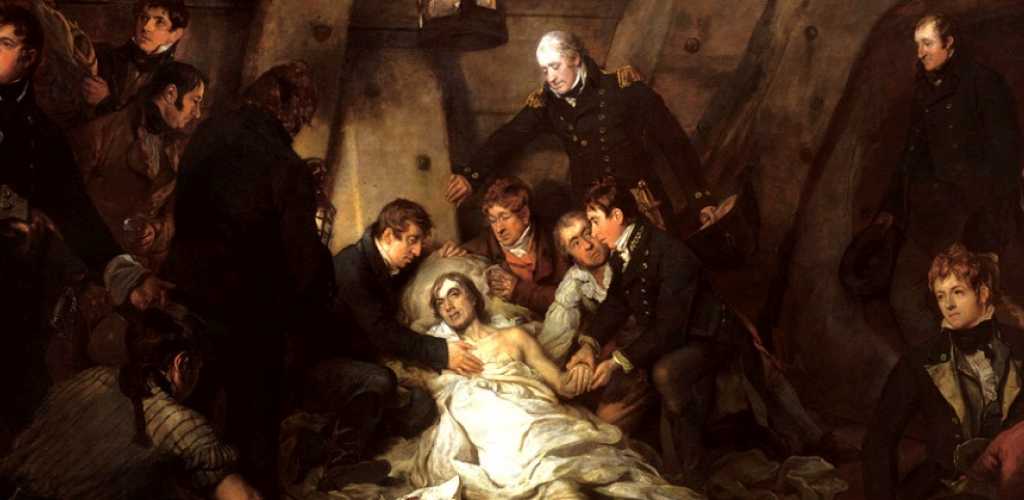
There has been extensive debate over Nelson's final words to Captain Hardy which continues today. However, there were at least three eyewitness accounts that confirm Nelson said "Kiss me Hardy" prior to his death. These witnesses were: Surgeon William Beatty, Chaplain Alexander Scott and Purser Walter Burke.
Records state that Hardy kissed Nelson twice - first on the cheek and then on the forehead. Nelson could not see clearly and asked: "Who is that?" to which came the reply "It is Hardy". Nelson replied, "God bless you, Hardy."
10 July 2019 (23:29) - Warner Bros studios on fire: 75 fire fighters scramble to scramble to former airfield in Leaversden.
About 75 fire fighters from 18 crews are tackling the fire which first broke out at about 11.30pm last night at an historic former airfield that is now Warner Bros. Film Studios. Hertfordshire County Council said: "The fire and rescue service were called to reports of a fire at Warner Bros Studios in Leavesden in Hertfordshire at 11.29pm on Wednesday 10 July. Fifteen fire engines, plus support vehicles, are currently in attendance at the scene and crews are tackling a fire in one of the stages there.
"The set was not being used at the time of the fire. There are no injuries. The incident is ongoing." In a further update this morning, Hertfordshire County Council said the number of fire crews at the scene had swelled to 18. A spokesman said: “Eighteen fire engines and support vehicles, are currently at the scene as crews continue to tackle the fire. Three jets and one aerial ladder platform are in use."
Smoke was seen billowing over the studios through the night and this morning, with a strong smell of smoke still in the air this morning. Local roads have been closed while fire crews connect hoses to a nearby canal to boost water supplies.
In an update on Twitter, Hertfordshire Police said: “Police are closing Bridge Road in Leavesden at the junction of Watford Road, known locally as Hunton Bridge to assist Hertfordshire Fire and Rescue as firefighters run a hose from the canal to tackle a fire at Warner Bros.”
Warner Bros. Studios is the home of all eight Harry Potter films. James Bond, Batman and Mission Impossible were also filmed there, as well as Oscar winning Darkest Hour and Bohemian Rhapsody. The 80-hectare site is in Abbots Langley, near Watford, in Hertfordshire. It is classed as one of the most state-of-the-art studios in the world.
Update: The fire has damaged the set of HBO’s Avenue 5, the space comedy from Veep creator Armando Iannucci. HBO said Thursday that two episodes still need to be completed on the series, which stars Hugh Laurie, Josh Gad, Zach Woods and Nikki Amuka-Bird. “The fire at Warner Bros. Studios Leavesden has affected one of the sets of HBO’s Avenue 5,” the network said. “Production continues as the producers and writers assess the best plan to complete filming of the final two episodes of the series. We echo Armando Iannucci’s praise for the firefighters who brought this situation to a safe conclusion.”
News Source: Express
"The set was not being used at the time of the fire. There are no injuries. The incident is ongoing." In a further update this morning, Hertfordshire County Council said the number of fire crews at the scene had swelled to 18. A spokesman said: “Eighteen fire engines and support vehicles, are currently at the scene as crews continue to tackle the fire. Three jets and one aerial ladder platform are in use."
Smoke was seen billowing over the studios through the night and this morning, with a strong smell of smoke still in the air this morning. Local roads have been closed while fire crews connect hoses to a nearby canal to boost water supplies.
In an update on Twitter, Hertfordshire Police said: “Police are closing Bridge Road in Leavesden at the junction of Watford Road, known locally as Hunton Bridge to assist Hertfordshire Fire and Rescue as firefighters run a hose from the canal to tackle a fire at Warner Bros.”
Warner Bros. Studios is the home of all eight Harry Potter films. James Bond, Batman and Mission Impossible were also filmed there, as well as Oscar winning Darkest Hour and Bohemian Rhapsody. The 80-hectare site is in Abbots Langley, near Watford, in Hertfordshire. It is classed as one of the most state-of-the-art studios in the world.
Update: The fire has damaged the set of HBO’s Avenue 5, the space comedy from Veep creator Armando Iannucci. HBO said Thursday that two episodes still need to be completed on the series, which stars Hugh Laurie, Josh Gad, Zach Woods and Nikki Amuka-Bird. “The fire at Warner Bros. Studios Leavesden has affected one of the sets of HBO’s Avenue 5,” the network said. “Production continues as the producers and writers assess the best plan to complete filming of the final two episodes of the series. We echo Armando Iannucci’s praise for the firefighters who brought this situation to a safe conclusion.”
News Source: Express
Building History
(Researched by Heritage & Ecclesiastical Fire Protection)
Leavesden Studios has led several fascinating lives, serving a number of prominent institutions since it was originally built more than 70 years ago.
Best known now as the home of Warner Bros, where parts of the Harry Potter movies were filmed, the site for Leavesden airfield was purchased as a factory for aircraft production in 1940. The premises were leased to two organisations: London Aircraft Production Group and The Second Aircraft Group. Handley Page Halifax heavy bombers and de Havilland Mosquito fighter-bombers were built there during the Second World War. Production started with the Halifax, the first example of which flew at Leavesden on 8 December 1941 - 710 were built there. Manufacturing of Mosquitoes soon followed, totalling 1,476. After the Second World War Leavesden moved into the field of aircraft engine development and servicing and, following various company name changes, was run laterally in this capacity under the control of Rolls-Royce.
In time, Leavesden was also a general aviation airfield for civil flying organisations. Eventually Rolls-Royce departed during 1992/93 before the airfield's final closure in 1994. Traces of the airfield, such as the two control towers, still remain.
Today's cinematic activities can be traced to when the James Bond movie 'GoldenEye' was made there in 1995, Leavesden subtly being seen in the film. Warner Bros decided to make it their permanent base in 2010. Films made at the studios include, Mortal Combat: Annihilation, Star Wars Episode One: The Phantom Menace, Longitude, An Ideal Husband and Tim Burton’s Sleepy Hollow. After the turn of the millennium it became home to the most successful film series of all time, with all eight Harry Potter films being shot at the studio.
(Researched by Heritage & Ecclesiastical Fire Protection)
Leavesden Studios has led several fascinating lives, serving a number of prominent institutions since it was originally built more than 70 years ago.
Best known now as the home of Warner Bros, where parts of the Harry Potter movies were filmed, the site for Leavesden airfield was purchased as a factory for aircraft production in 1940. The premises were leased to two organisations: London Aircraft Production Group and The Second Aircraft Group. Handley Page Halifax heavy bombers and de Havilland Mosquito fighter-bombers were built there during the Second World War. Production started with the Halifax, the first example of which flew at Leavesden on 8 December 1941 - 710 were built there. Manufacturing of Mosquitoes soon followed, totalling 1,476. After the Second World War Leavesden moved into the field of aircraft engine development and servicing and, following various company name changes, was run laterally in this capacity under the control of Rolls-Royce.
In time, Leavesden was also a general aviation airfield for civil flying organisations. Eventually Rolls-Royce departed during 1992/93 before the airfield's final closure in 1994. Traces of the airfield, such as the two control towers, still remain.
Today's cinematic activities can be traced to when the James Bond movie 'GoldenEye' was made there in 1995, Leavesden subtly being seen in the film. Warner Bros decided to make it their permanent base in 2010. Films made at the studios include, Mortal Combat: Annihilation, Star Wars Episode One: The Phantom Menace, Longitude, An Ideal Husband and Tim Burton’s Sleepy Hollow. After the turn of the millennium it became home to the most successful film series of all time, with all eight Harry Potter films being shot at the studio.
10 July 2019 (19:20) - Huge fire rips through Admiral Jellicoe pub in Canvey Island
A huge fire has broken out at an iconic former pub in Canvey Island. Firefighters are battling the epic blaze at the derelict Admiral Jellicoe, where smoke can be seen billowing across the High Street. Paramedics and police are also at the scene and have shut the road while the fire is brought under control. The blaze, which is believed to have happened at around 7.20pm this evening, (Wednesday, July 10), shows that the entire roof of the large building is completely alight, as residents nearby gather nearby to watch.
Essex Fire and Rescue Service said: "Firefighters were called to the scene of a derelict pub fire this evening. On arrival crews advised the building, which measures approximately 30 metres by 20 metres, was well alight. The officer in charge immediately requested the support of an Aerial Ladder Platform to allow firefighters to spray water on the building from height. At 8pm, the officer in charge reported that 100% of the roof and much of the first floor was on fire."
The pub was set for demolition, but that was halted in June this year when Castle Point Council issued a stop notice, claiming the developer has not agreed its contributions to the community as part of the development. Peter Greig, Canvey Independent councillor said: “I think they should be prosecuted for this. Quite a few people feel the same and share my view on this. They shouldn’t have started before they received the demolition notice. I am sorry to see it go and it doesn’t warrant a listed status but it would have been nice if a chain pub had taken it up. There is already strong feeling about it, so I think this will make people even more angry. It seems the council stepped in as quick as they could when it found out.”
A spokesman for Castle Point Council said: “The planning application is subject to a S106 agreement which is currently being drawn up. Permission does not come into effect until that agreement has been agreed and signed. Demolition works have commenced – they don’t currently have planning permission, nor have they submitted a demolition notice to the building control department.
Although it is unclear how long the pub has been on the island, it dates back to at least the early 1930s. The closure of the venue was a great sadness to the heritage of Canvey. The pub was originally closed in mysterious circumstances earlier in 2017, after a notice went up claiming that it was “closed for refurbishment.” After this, a statement was released confirming that that the freehold of the pub had been sold for £1.1million to Branch Company Ltd. It is through that the site will be turned into flats.
Local resident Geoffrey Binks said: “This is an important place on Canvey with important social history. We don’t want yet more faceless flats.” The Admiral Jellicoe has an important role Canvey’s musical history, and was one of the favourite locals of the Canvey band Dr Feelgood. It was the location for the interior cover shots of the "Be Seeing You" album.
News Source: Essex Live
Essex Fire and Rescue Service said: "Firefighters were called to the scene of a derelict pub fire this evening. On arrival crews advised the building, which measures approximately 30 metres by 20 metres, was well alight. The officer in charge immediately requested the support of an Aerial Ladder Platform to allow firefighters to spray water on the building from height. At 8pm, the officer in charge reported that 100% of the roof and much of the first floor was on fire."
The pub was set for demolition, but that was halted in June this year when Castle Point Council issued a stop notice, claiming the developer has not agreed its contributions to the community as part of the development. Peter Greig, Canvey Independent councillor said: “I think they should be prosecuted for this. Quite a few people feel the same and share my view on this. They shouldn’t have started before they received the demolition notice. I am sorry to see it go and it doesn’t warrant a listed status but it would have been nice if a chain pub had taken it up. There is already strong feeling about it, so I think this will make people even more angry. It seems the council stepped in as quick as they could when it found out.”
A spokesman for Castle Point Council said: “The planning application is subject to a S106 agreement which is currently being drawn up. Permission does not come into effect until that agreement has been agreed and signed. Demolition works have commenced – they don’t currently have planning permission, nor have they submitted a demolition notice to the building control department.
Although it is unclear how long the pub has been on the island, it dates back to at least the early 1930s. The closure of the venue was a great sadness to the heritage of Canvey. The pub was originally closed in mysterious circumstances earlier in 2017, after a notice went up claiming that it was “closed for refurbishment.” After this, a statement was released confirming that that the freehold of the pub had been sold for £1.1million to Branch Company Ltd. It is through that the site will be turned into flats.
Local resident Geoffrey Binks said: “This is an important place on Canvey with important social history. We don’t want yet more faceless flats.” The Admiral Jellicoe has an important role Canvey’s musical history, and was one of the favourite locals of the Canvey band Dr Feelgood. It was the location for the interior cover shots of the "Be Seeing You" album.
News Source: Essex Live
Near Miss
9 July 2019 (17:35) - Fire in Eynsford High Street
9 July 2019 (17:35) - Fire in Eynsford High Street
Residents are being urged to keep their windows and doors closed as crews deal with a large barn fire. It broke out behind the Castle Hotel on Eynsford High Street at around 5.35pm. Five fire engines are at the scene and due to the large volume of smoke coming from the blaze, residents and businesses in the area are being asked to keep windows and doors closed as a precaution. There are no reported injuries and the cause is not yet known. Police are also at the scene.
Although unlisted, the Castle Inn is a building contributing to the character of Eynsford Conservation Area. It was originally known as the Harrow Inn and the building dates back to the early 19th century.
News Source: Kent Online
Although unlisted, the Castle Inn is a building contributing to the character of Eynsford Conservation Area. It was originally known as the Harrow Inn and the building dates back to the early 19th century.
News Source: Kent Online
Building History
(Researched by Heritage & Ecclesiastical Fire Protection)
The first mention of the Harrow Inn is in the post office directory which states "1829 Henry Booker" - Henry was either the owner of the building or the first landlord.
Its name was changed to the Castle Hotel in 1904 when it was bought by Elliot Downs Till, a teetotaller and a local benefactor. He refurbished the pub, adding new windows, a library, which was at that time the restaurant, and a function room upstairs to the front of the building. He also added bedrooms for guest. He decreed that the landlord should serve only one alcoholic drink per person per day! The tied brewery, Dartford Brewery Company, were understandably not very happy with this decision and took him to court, but Mr Till won his case and set a precedent.
Mr Till was the founder of Arbor Day in England, an American custom to allocate a day a year to plant trees. Arbor Day was first carried out in this country in 1897 to commemorate Queen Victoria’s Diamond Jubilee. He also commissioned a village hall to be built in Eynsford at his own expense.
(Researched by Heritage & Ecclesiastical Fire Protection)
The first mention of the Harrow Inn is in the post office directory which states "1829 Henry Booker" - Henry was either the owner of the building or the first landlord.
Its name was changed to the Castle Hotel in 1904 when it was bought by Elliot Downs Till, a teetotaller and a local benefactor. He refurbished the pub, adding new windows, a library, which was at that time the restaurant, and a function room upstairs to the front of the building. He also added bedrooms for guest. He decreed that the landlord should serve only one alcoholic drink per person per day! The tied brewery, Dartford Brewery Company, were understandably not very happy with this decision and took him to court, but Mr Till won his case and set a precedent.
Mr Till was the founder of Arbor Day in England, an American custom to allocate a day a year to plant trees. Arbor Day was first carried out in this country in 1897 to commemorate Queen Victoria’s Diamond Jubilee. He also commissioned a village hall to be built in Eynsford at his own expense.
8 July 2019 (12:55) - Lidget Green church fire close to getting out of hand
A fire at a Lidget Green church was close to getting out of hand this lunchtime. A crew from Fairweather Green Fire Station attended St Wilfrid's Church after reports that a controlled bin fire had gone wrong. Some guttering and a window were damaged but fortunately, the fire did not get inside the boiler room, which had looked to be in danger at one point.
A spokesperson at Fairweather Green station said: "There's a car park behind the church that gets rented out and I think some people were just having a tidy up. They didn't use much common sense because they had the controlled fire by the church wall. The bin fell over and set some carpets alight and the fire then tried to get into the boiler room. It melted a perspex window cover but fortunately it was all bricked up behind that so the room was protected. We did have to force entry into the boiler room though to make sure it hadn't spread inside, as when we called a keyholder for the church, he didn't have the right set of keys. The only other damage was a little bit to the roof and guttering. We were there for about an hour from 12:55pm, and used just the one hose reel. We were the only crew in attendance."
The Parish Church is Grade II listed and was built 1904-05.
News Source: Telegraph and Argus
A spokesperson at Fairweather Green station said: "There's a car park behind the church that gets rented out and I think some people were just having a tidy up. They didn't use much common sense because they had the controlled fire by the church wall. The bin fell over and set some carpets alight and the fire then tried to get into the boiler room. It melted a perspex window cover but fortunately it was all bricked up behind that so the room was protected. We did have to force entry into the boiler room though to make sure it hadn't spread inside, as when we called a keyholder for the church, he didn't have the right set of keys. The only other damage was a little bit to the roof and guttering. We were there for about an hour from 12:55pm, and used just the one hose reel. We were the only crew in attendance."
The Parish Church is Grade II listed and was built 1904-05.
News Source: Telegraph and Argus
Listing Details
|
Entry Name: Church of St Wilfrid
Listing Date: 23 November 1995 Grade: II Source: Historic England Source ID: 1242614 English Heritage Legacy ID: 442089 Location: Bradford, BD7 County: Bradford Electoral Ward/Division: Great Horton Built-Up Area: Bradford Traditional County: Yorkshire Lieutenancy Area (Ceremonial County): West Yorkshire Church of England Parish: Bradford St Wilfrid with St Columba Church of England Diocese: Leeds |
Coordinates
Latitude: 53.7863 / 53°47'10"N Longitude: -1.7898 / 1°47'23"W OS Eastings: 413947 OS Northings: 432236 OS Grid: SE139322 Mapcode National: GBR J9N.89 Mapcode Global: WHC9G.G3Y6 |
7 July 2019 (15:55) - Fire engines block Tisbury Road in Hove
Smoke has been seen coming from a house in a residential street. At least four fire engines and three ambulance cars are currently attending the scene in Tisbury Road, Hove, blocking off the road surrounding the property.
A neighbour said: “I was told somebody in the house was shouting for help. Then a man ran to help them and, when he realised there was a fire, kicked the door down to get into the house.” Another witness said: "The road has been closed and there is smoke that looks like it is either coming from the first floor or the basement. The police have closed the road but there are four fire engines and multiple ambulances and more are arriving." One resident nearby said: “All I saw was smoke pouring out of the whole building, it was quite substantial, definitely a very severe fire. That was at about 4pm. You never know if there is any risk of an explosion so I kept my distance. But the fire crews were amazing and worked incredibly quickly to bring it under control.”
An East Sussex Fire and Rescue Service spokesman said: "There was an accidental fire in a ground floor flat in Tisbury Road, Hove. We were called at 3.55pm and attended the scene with four appliances to extinguish the fire. The fire started in a bedroom."
Tisbury Road lies within the Willett Estate Conservation Area. Another property, a few doors away, in the same terraced row, was described in this way by estate agents: “The elegant exterior with its bay windows and black iron railings of this classic Victorian terraced building create an instant indication of the character and charm of this impressive home.”
News Source: The Argus
A neighbour said: “I was told somebody in the house was shouting for help. Then a man ran to help them and, when he realised there was a fire, kicked the door down to get into the house.” Another witness said: "The road has been closed and there is smoke that looks like it is either coming from the first floor or the basement. The police have closed the road but there are four fire engines and multiple ambulances and more are arriving." One resident nearby said: “All I saw was smoke pouring out of the whole building, it was quite substantial, definitely a very severe fire. That was at about 4pm. You never know if there is any risk of an explosion so I kept my distance. But the fire crews were amazing and worked incredibly quickly to bring it under control.”
An East Sussex Fire and Rescue Service spokesman said: "There was an accidental fire in a ground floor flat in Tisbury Road, Hove. We were called at 3.55pm and attended the scene with four appliances to extinguish the fire. The fire started in a bedroom."
Tisbury Road lies within the Willett Estate Conservation Area. Another property, a few doors away, in the same terraced row, was described in this way by estate agents: “The elegant exterior with its bay windows and black iron railings of this classic Victorian terraced building create an instant indication of the character and charm of this impressive home.”
News Source: The Argus
7 July 2019 (04:09) - St Albans pub to close for 'foreseeable future' following devastating fire
There was a blaze at The Plough Sleapshyde, on Sleapshyde Lane, in the early hours of this morning. In a post on Facebook, the countryside pub thanked Herts Fire and Rescue Service for saving the historic building - the primary alehouse dates back to 1690 and features wooden beams, which have recently been restored to their original state.
Herts Fire and Rescue Service were called to the pub at 4.09am. Crews from St Albans, Welwyn Garden City, Borehamwood, Watford, Rickmansworth and Hemel Hempstead arrived and discovered fires in two outbuildings next to the pub. Thankfully, firefighters were able to extinguish the fire at 5.57am, preventing it from spreading further to the pub's thatched roof.
The new kitchen and shed storing area were affected by the fire but a fire door stopped the flames from spreading to the main part of the building - including the bar and restaurant. The cause of the fire is still unknown but it has been listed as accidental, the fire service said.
The post said: "We are completely shocked to say that we have had a devastating fire at The Plough early this morning but thanks to the incredible fire brigade we have saved the main building. Both Tim and Rachel are safe but obviously in shock." The Plough will not be open for the foreseeable future, it added. This announcement was met with an outpouring of sympathy on social media. One poster said: "Devastating. So much love and hard work put in to this beautiful pub. Thinking of you all xx." Another added: "I'm so sorry to hear this dreadful news. You have an amazing place there and it will be again. As soon as you are ready we will all be back spending money xx."
The part-thatched 17th century pub building is Grade II listed and featured in a 1967 episode of the ITC show The Champions (“The Night People”). The pub lies within the Sleapshyde Conservation Area.
News Source: The Herts Advertiser
Herts Fire and Rescue Service were called to the pub at 4.09am. Crews from St Albans, Welwyn Garden City, Borehamwood, Watford, Rickmansworth and Hemel Hempstead arrived and discovered fires in two outbuildings next to the pub. Thankfully, firefighters were able to extinguish the fire at 5.57am, preventing it from spreading further to the pub's thatched roof.
The new kitchen and shed storing area were affected by the fire but a fire door stopped the flames from spreading to the main part of the building - including the bar and restaurant. The cause of the fire is still unknown but it has been listed as accidental, the fire service said.
The post said: "We are completely shocked to say that we have had a devastating fire at The Plough early this morning but thanks to the incredible fire brigade we have saved the main building. Both Tim and Rachel are safe but obviously in shock." The Plough will not be open for the foreseeable future, it added. This announcement was met with an outpouring of sympathy on social media. One poster said: "Devastating. So much love and hard work put in to this beautiful pub. Thinking of you all xx." Another added: "I'm so sorry to hear this dreadful news. You have an amazing place there and it will be again. As soon as you are ready we will all be back spending money xx."
The part-thatched 17th century pub building is Grade II listed and featured in a 1967 episode of the ITC show The Champions (“The Night People”). The pub lies within the Sleapshyde Conservation Area.
News Source: The Herts Advertiser
Listing Details
|
Entry Name: The Plough Inn
Listing Date: 27 September 1984 Grade: II Source: Historic England Source ID: 1102987 English Heritage Legacy ID: 163568 Location: Colney Heath, St. Albans, Hertfordshire, AL4 County: Hertfordshire District: St. Albans Civil Parish: Colney Heath Traditional County: Hertfordshire Lieutenancy Area (Ceremonial County): Hertfordshire Church of England Parish: Colney Heath St Mark Church of England Diocese: St.Albans |
Coordinates
Latitude: 51.7485 / 51°44'54"N Longitude: -0.2599 / 0°15'35"W OS Eastings: 520220 OS Northings: 206970 OS Grid: TL202069 Mapcode National: GBR J9R.742 Mapcode Global: VHGPR.F9YX |
6 July 2019 (11:51) – Fire on King Street, Stirling
Fire crews were called to an Indian restaurant in Stirling. The alarm was raised at 11:51 at a property in King Street. The fire service said it had sent four appliances and the fire was put out by 13:32. There were no casualties.
The fire was at Maharaja Restaurant which is housed in a Category C listed building, dating from the mid 19th century. It lies within the Stirling Town and Royal Park Conservation Area.
News Source: BBC News
The fire was at Maharaja Restaurant which is housed in a Category C listed building, dating from the mid 19th century. It lies within the Stirling Town and Royal Park Conservation Area.
News Source: BBC News
Listing Details
|
Entry Name: King Street 37, 39, 41
Listing Date: 3 February 1978 Category: C Source: Historic Scotland Source ID: 387526 Historic Scotland Designation Reference: LB41331 Building Class: Cultural Location: Stirling County: Stirling Town: Stirling Electoral Ward: Stirling North Traditional County: Stirlingshire |
Coordinates
Latitude: 56.1179 / 56°7'4"N Longitude: -3.9379 / 3°56'16"W OS Eastings: 279607 OS Northings: 693377 OS Grid: NS796933 Mapcode National: GBR 1C.LH9N Mapcode Global: WH4P6.HH08 |
5 July 2019 (23:20) - York man suffers burns after shirt set on fire in pub
A man's shirt was set alight in a York pub, police have revealed. The 38-year-old York man suffered a minor burn to his lower back in the assault at the Fossgate Tap in Fossgate. The incident happened York at about 11.20pm on Friday July 5 but has only just been disclosed (16/8/19) by North Yorkshire Police. The force has issued CCTV images of three men they would like to speak to following the incident.
"Officers are asking members of the public to get in touch if they recognise the men in the images, as they believe they will have information that can help the investigation," said a spokesman. "Anyone with any information is asked to phone 101, select option 2 and ask for Jon Bostwick or email."
Fossgate Tap sits on the corner of Fossgate, a stone’s throw from York’s most iconic street, The Shambles. This Grade II listed building dates back c1796 and previously traded as ‘The Army and Navy Store’ for 93 years. Many of the original fixtures and fittings remain; retaining the building’s historical charm. The previous name, Sutlers, was an American civil war term for a civilian merchant who sells provisions to the army.
News Source: The York Press
"Officers are asking members of the public to get in touch if they recognise the men in the images, as they believe they will have information that can help the investigation," said a spokesman. "Anyone with any information is asked to phone 101, select option 2 and ask for Jon Bostwick or email."
Fossgate Tap sits on the corner of Fossgate, a stone’s throw from York’s most iconic street, The Shambles. This Grade II listed building dates back c1796 and previously traded as ‘The Army and Navy Store’ for 93 years. Many of the original fixtures and fittings remain; retaining the building’s historical charm. The previous name, Sutlers, was an American civil war term for a civilian merchant who sells provisions to the army.
News Source: The York Press
Listing Details
|
Entry Name: 30, Pavement
Listing Date: 14 June 1954 Grade: II Source: Historic England Source ID: 1257826 English Heritage Legacy ID: 463417 Location: York, YO1 County: York Electoral Ward/Division: Guildhall Built-Up Area: York Traditional County: Yorkshire Lieutenancy Area (Ceremonial County): North Yorkshire Church of England Parish: York All Saints, Pavement Church of England Diocese: York |
Coordinates
Latitude: 53.9588 / 53°57'31"N Longitude: -1.0792 / 1°4'45"W OS Eastings: 460517 OS Northings: 451806 OS Grid: SE605518 Mapcode National: GBR NQXN.5M Mapcode Global: WHFC3.DRBG |
5 July 2019 (18:54) - Fire crews rush to large Burnley mill blaze
Four fire crews were called to a large blaze at a derelict Burnley mill. Firefighters received a call that the premises in Brush Street were alight at 6.55pm yesterday. Crews from Burnley, Nelson and Hyndburn attended and used three jets and four breathing apparatus to extinguish the fire. They were at the scene for approximately two hours and 40 minutes.
The mill is known as Wood Top Mill and was built in 1890.
News Source: Burnley Express
The mill is known as Wood Top Mill and was built in 1890.
News Source: Burnley Express
Building History
(Researched by Heritage & Ecclesiastical Fire Protection)
On the 11th June 1890, the Burnley Express announced, “The New Shed at Wood Top.—The new shed at Wood Top, belonging to the Wood Top Room and Power Company, is about to be started. The building will accommodate 1,400 looms, and 1,000 of them will be run by Mr. Crabtree, (Messrs. Robert Crabtree and Co), while Messrs. Lord Brothers will run the remainder. The engine has been supplied by Messrs. Buckley and Taylor, of Oldham, while the Oldham Boiler Company have furnished the boilers.”
In January 1891, during a particularly harsh winter, the tenants, Crabtree & Co. and Lord Brothers had to close down the mill due to severe frosts, which they alleged was due to the neglect and failure of the Room and Power Company to warm the premises. They said that the provision for heating by the landlord was altogether inadequate to do so. 500 operatives were laid off.
Textiles company Bagley and Wright occupied the mill at the turn of the century. In November 1940 the Wood Top Room and Power Company went into voluntary liquidation. The mill then became the birthplace of Smiths Aerospace in 1942, and they occupied it until 2007, before moving to Network 65, and they sold it on to Connaught for £850,000.
Before its sale to Connaught the site had been marketed for an industrial sale, but received little interest. Michael Cavannagh, a partner at the firm, said:: “Despite undertaking a thorough marketing campaign little or no interest was received from industrial occupiers or industrial developers to buy the site for employment use. The lack of interest from such parties is a clear statement that even at the height of the market (Autumn 2007) industrial developers deemed the site unviable.” The surveyors also deemed the site unsuitable for retail development, leisure facilities, a hotel or healthcare facilities.
(Researched by Heritage & Ecclesiastical Fire Protection)
On the 11th June 1890, the Burnley Express announced, “The New Shed at Wood Top.—The new shed at Wood Top, belonging to the Wood Top Room and Power Company, is about to be started. The building will accommodate 1,400 looms, and 1,000 of them will be run by Mr. Crabtree, (Messrs. Robert Crabtree and Co), while Messrs. Lord Brothers will run the remainder. The engine has been supplied by Messrs. Buckley and Taylor, of Oldham, while the Oldham Boiler Company have furnished the boilers.”
In January 1891, during a particularly harsh winter, the tenants, Crabtree & Co. and Lord Brothers had to close down the mill due to severe frosts, which they alleged was due to the neglect and failure of the Room and Power Company to warm the premises. They said that the provision for heating by the landlord was altogether inadequate to do so. 500 operatives were laid off.
Textiles company Bagley and Wright occupied the mill at the turn of the century. In November 1940 the Wood Top Room and Power Company went into voluntary liquidation. The mill then became the birthplace of Smiths Aerospace in 1942, and they occupied it until 2007, before moving to Network 65, and they sold it on to Connaught for £850,000.
Before its sale to Connaught the site had been marketed for an industrial sale, but received little interest. Michael Cavannagh, a partner at the firm, said:: “Despite undertaking a thorough marketing campaign little or no interest was received from industrial occupiers or industrial developers to buy the site for employment use. The lack of interest from such parties is a clear statement that even at the height of the market (Autumn 2007) industrial developers deemed the site unviable.” The surveyors also deemed the site unsuitable for retail development, leisure facilities, a hotel or healthcare facilities.
Near Miss
3 July 2019 (20:00*) - Arrests after bin set on fire on Church Street, St Helens
3 July 2019 (20:00*) - Arrests after bin set on fire on Church Street, St Helens
Police arrested two men after a bin was torched in St Helens town centre. Officers on Church Street, St Helens came across a bin on fire on Wednesday evening (July 3). Two suspects were detained nearby by officers and both were arrested on suspicion of arson. A 19-year-old man from Liverpool has since been charged with arson and was bailed to appear at magistrates' court.
The Fire was close to the Grade II listed Church of St Helen, built 1916-26.
News Source: St Helens Star
The Fire was close to the Grade II listed Church of St Helen, built 1916-26.
News Source: St Helens Star
Listing Details
|
Entry Name: Church of St Helen
Listing Date: 11 September 1951 Grade: II Source: Historic England Source ID: 1199141 English Heritage Legacy ID: 216360 Location: St. Helens, WA10 County: St. Helens Electoral Ward/Division: Town Centre Built-Up Area: St Helens Traditional County: Lancashire Lieutenancy Area (Ceremonial County): Merseyside Church of England Parish: St Helens St Helen Church of England Diocese: Liverpool |
Coordinates
Latitude: 53.4516 / 53°27'5"N Longitude: -2.7349 / 2°44'5"W OS Eastings: 351289 OS Northings: 395238 OS Grid: SJ512952 Mapcode National: GBR 9XBJ.PD Mapcode Global: WH874.YHTR |
3 July 2019 (13:04) – Thatch roof destroyed by fire
Fire engines were sent to the village of Dolton in Devon today to a thatch roof on fire. Emergency services were called just after 1300 by the owner of the property to say it was on fire and the roof had already fallen in. 8 fire engines and numerous special appliances were sent to the property, which was undergoing renovation. After the arrival of the first 5 fire engines (Hatherleigh, Torrington, North Tawton, OKehampton and Holsworthy), everything else except the water bowser from Barnstaple were sent back to stations. Officers say it was a 2 storey building measuring 12m by 12m and the roof was completely destroyed. Crews from Hatherleigh will return this evening to check on the hotspots.
The identity of the house could not be confirmed, but there are many thatched cottages in Dolton, and all are Grade II or II* listed.
News Source: Radio Exe
The identity of the house could not be confirmed, but there are many thatched cottages in Dolton, and all are Grade II or II* listed.
News Source: Radio Exe
2 July 2019 (20:00*) Fire damages prefab in Allt-yr-yn, Newport
Firefighters have been damping down at the site of fire in an empty historic prefab in Newport this morning. It follows a fire in the building - one of last remaining old prefabricated homes in the area - towards the top of Ridgeway Hill in Allt-yr-yn. A spokeswoman for South Wales Fire and Rescue Service said: "At approximately 8pm on Tuesday, July 2, we received reports of a domestic fire on Ridgeway Hill, Newport. We mobilised appliances from Malpas and Maindee station and fully extinguished the fire. There were no people inside the property and there were no injuries."
Newport resident, Andrew Elliott, said: "I was walking past the fire as it was beginning to take hold and as the first fire tender arrived. A second fire tender arrived shortly after to control the fire. As there are other houses close by, the situation could have become much worse but the fire service had it under control very quickly." Inquiries into the cause are continuing.
A total of 750 prefabs (prefabricated bungalows) were erected in various parts of Newport to meet a severe housing shortage after the Second World War. It has probably been kept for historical reasons and could be the last one in Newport as many more that were once adjacent to it were demolished in 2013. The accommodation was very basic by modern standards, but compared with the unsanitary conditions in slums in the immediate post-war years of the mid to late 1940s, or the alternative of having to live in overcrowded existing housing, these prefabs must have been a highly desirable choice.
News Source: South Wales Argus
Newport resident, Andrew Elliott, said: "I was walking past the fire as it was beginning to take hold and as the first fire tender arrived. A second fire tender arrived shortly after to control the fire. As there are other houses close by, the situation could have become much worse but the fire service had it under control very quickly." Inquiries into the cause are continuing.
A total of 750 prefabs (prefabricated bungalows) were erected in various parts of Newport to meet a severe housing shortage after the Second World War. It has probably been kept for historical reasons and could be the last one in Newport as many more that were once adjacent to it were demolished in 2013. The accommodation was very basic by modern standards, but compared with the unsanitary conditions in slums in the immediate post-war years of the mid to late 1940s, or the alternative of having to live in overcrowded existing housing, these prefabs must have been a highly desirable choice.
News Source: South Wales Argus
Near Miss
2 July 2019 (15:15) Huge fire breaks out at Strathmartine Hospital near Dundee as seven appliances tackle flames
2 July 2019 (15:15) Huge fire breaks out at Strathmartine Hospital near Dundee as seven appliances tackle flames
Fire crews are currently tackling a huge fire at Strathmartine Hospital. Seven appliances are in attendance after the blaze broke out at around 3.15pm. It is believed the areas of ward 16 and 17 are on fire. Part of the old hospital site are Category B listed buildings. The affected areas are not listed but are close to the parts which are. Baldovan Road outside the site has been closed.
A spokeswoman for the fire service said: "We are in attendance at Strathmartine Hospital with seven appliances. The call came in at 3.15pm." A spokesperson for Police Scotland said: "Police Scotland and Scottish Fire & Rescue are currently dealing with a large fire at site of Strathmartine Hospital. The road is currently closed to traffic and motorists are asked to take alternate routes where possible.
The hospital has been targeted by both vandals and firebugs repeatedly in recent years. Although closely associated with Dundee, the facility is actually in the Angus Council area, part of the Monifieth and Sidlaw ward. In June, following a large blaze, police vowed to up their patrols of the area.
News Source: The Scottish Sun
A spokeswoman for the fire service said: "We are in attendance at Strathmartine Hospital with seven appliances. The call came in at 3.15pm." A spokesperson for Police Scotland said: "Police Scotland and Scottish Fire & Rescue are currently dealing with a large fire at site of Strathmartine Hospital. The road is currently closed to traffic and motorists are asked to take alternate routes where possible.
The hospital has been targeted by both vandals and firebugs repeatedly in recent years. Although closely associated with Dundee, the facility is actually in the Angus Council area, part of the Monifieth and Sidlaw ward. In June, following a large blaze, police vowed to up their patrols of the area.
News Source: The Scottish Sun
Listing Details
|
Entry Name: Baldovan, Strathmartine Hospital, Former Baldovan Institute
Listing Date: 10 August 2001 Category: B Source: Historic Scotland Source ID: 395542 Historic Scotland Designation Reference: LB48113 Building Class: Cultural Location: Mains and Strathmartine County: Angus Electoral Ward: Monifieth and Sidlaw Parish: Mains And Strathmartine Traditional County: Angus |
Coordinates
Latitude: 56.5038 / 56°30'13"N Longitude: -2.9977 / 2°59'51"W OS Eastings: 338684 OS Northings: 735077 OS Grid: NO386350 Mapcode National: GBR VJ.Z9LS Mapcode Global: WH7R3.XSPJ |
2 July 2019 (14:55) - Derelict building fire sends smoke stacks rising into the sky
A fire has broken out in central Coalville sending smoke plumes above the town. A derelict building has caught on fire and fire crews are on the scene. People are advised to avoid the area. Sharon Marvin, who works at Charnwood Fireplaces, in the Springboard Centre, said: “It’s in one of the derelict buildings on a piece of land over the way from us. We can see it from here. There was a tremendous amount of smoke billowing from it and it was coming into our building.There is a lot less smoke coming off it now, so the fire people seem to be getting it under control. I’ve seen at least one fire engine and a police van there.”
Mr Kowalski, whose shop is in nearby Ashby Road, near to the clock tower, says: “It’s a horrible smell, like burning tyres. As far as I know, two fire engines were called. The problem today is that the wind is quite changeable, so we’ve been affected but I don’t know about other people.” A spokesman from the fire service said the call came in shortly before 3pm. He says: “It’s a derelict building and three floors are on fire. We have three pumps - from Coalville, Shepshed and Swadlincote - in attendance. The fire was located on the ground floor and we have it under control now.” An investigation will be carried out to establish the cause, he added.
The building was originally a Co-op Bakery, built in the 1930’s. A section of the old bakery was the Palitoy Consumer Services Department during the 70s. In the early 1990’s, the Co-op sold the building to a new business called Belvoir foods Ltd. In 2007, Tulip Ltd bought Belvoir Bacon Ltd and moved the business to Bardon Industrial Estate. Soon after, TS Bloors briefly used the ground floor, converting this part of the building into cold storage.
The building lies within the Coalville Conservation Area, which says:
“The 1930 Co-op Bakery building contributes to Coalville’s 20th century heritage. The Bakery is a large three storey stone and brick building, built by the Coalville and
District Working Mens’ Co-operative Society to provide bread and confectionery to
the local district.”
News Source: Derbyshire Live
Mr Kowalski, whose shop is in nearby Ashby Road, near to the clock tower, says: “It’s a horrible smell, like burning tyres. As far as I know, two fire engines were called. The problem today is that the wind is quite changeable, so we’ve been affected but I don’t know about other people.” A spokesman from the fire service said the call came in shortly before 3pm. He says: “It’s a derelict building and three floors are on fire. We have three pumps - from Coalville, Shepshed and Swadlincote - in attendance. The fire was located on the ground floor and we have it under control now.” An investigation will be carried out to establish the cause, he added.
The building was originally a Co-op Bakery, built in the 1930’s. A section of the old bakery was the Palitoy Consumer Services Department during the 70s. In the early 1990’s, the Co-op sold the building to a new business called Belvoir foods Ltd. In 2007, Tulip Ltd bought Belvoir Bacon Ltd and moved the business to Bardon Industrial Estate. Soon after, TS Bloors briefly used the ground floor, converting this part of the building into cold storage.
The building lies within the Coalville Conservation Area, which says:
“The 1930 Co-op Bakery building contributes to Coalville’s 20th century heritage. The Bakery is a large three storey stone and brick building, built by the Coalville and
District Working Mens’ Co-operative Society to provide bread and confectionery to
the local district.”
News Source: Derbyshire Live
2 July 2019 (05:49) - Fire in Wisbech takes four fire crews two hours to extinguish
Four fire crews were called to an arson attack which saw a large pile of rubbish set alight and spread to trees and a nearby fence. The incident which happened at 5.49am this morning (Tuesday) saw one crew from Wisbech, one crew from West Walton, one crew from Outwell and one crew from King's Lynn called to the fire on New Inn Yard, Wisbech.
Wearing breathing apparatus, firefighters used one hose reel to extinguish the blaze before returning to their stations by 7.45am. A spokesman said, "A Salvation Army building was also damaged during this incident."
The Salvation Army shop is a Grade II listed building dating from the mid to late 19th century. It was formerly a WH Smith store and is known by this in its listing. The building lies within Wisbech Conservation Area.
News Source: Fenland Citizen
Wearing breathing apparatus, firefighters used one hose reel to extinguish the blaze before returning to their stations by 7.45am. A spokesman said, "A Salvation Army building was also damaged during this incident."
The Salvation Army shop is a Grade II listed building dating from the mid to late 19th century. It was formerly a WH Smith store and is known by this in its listing. The building lies within Wisbech Conservation Area.
News Source: Fenland Citizen
Listing Details
|
Entry Name: WH Smith
Listing Date: 10 February 1969 Grade: II Source: Historic England Source ID: 1331653 English Heritage Legacy ID: 48469 Location: Wisbech, Fenland, Cambridgeshire, PE13 County: Cambridgeshire District: Fenland Civil Parish: Wisbech Built-Up Area: Wisbech Traditional County: Cambridgeshire Lieutenancy Area (Ceremonial County): Cambridgeshire Church of England Parish: Wisbech St Peter and St Paul Church of England Diocese: Ely |
Coordinates
Latitude: 52.6656 / 52°39'56"N Longitude: 0.1602 / 0°9'36"E OS Eastings: 546180 OS Northings: 309736 OS Grid: TF461097 Mapcode National: GBR L1Q.Z5P Mapcode Global: WHJPH.F8H9 |
Near Miss
2 July 2019 (05:30) - Man in custody after Jaguar torched at Nene Quay.
2 July 2019 (05:30) - Man in custody after Jaguar torched at Nene Quay.
At 5.30am, a man parked a Jaguar FX outside the back of Tasty China, Nene Quay, Wisbech and set fire to the car, which was captured on CCTV.
There was no reported damage to the building, which is part of a row of late 16th century shops or granaries. The row, Numbers 3, 4 and 5 are Grade II listed specifically for their historic interest. The buildings are within Wisbech Conservation Area.
News Source: Wisbech Standard
There was no reported damage to the building, which is part of a row of late 16th century shops or granaries. The row, Numbers 3, 4 and 5 are Grade II listed specifically for their historic interest. The buildings are within Wisbech Conservation Area.
News Source: Wisbech Standard
Listing Details
|
Entry Name: 3, 4 and 5 Nene Quay
Listing Date: 10 February 1969 Grade: II Source: Historic England Source ID: 1229213 English Heritage Legacy ID: 48326 Location: Wisbech, Fenland, Cambridgeshire, PE13 County: Cambridgeshire Civil Parish: Wisbech Built-Up Area: Wisbech Traditional County: Cambridgeshire Lieutenancy Area (Ceremonial County): Cambridgeshire Church of England Parish: Wisbech St Peter and St Paul Church of England Diocese: Ely |
Coordinates
Latitude: 52.6652 / 52°39'54"N Longitude: 0.1589 / 0°9'31"E OS Eastings: 546092 OS Northings: 309688 OS Grid: TF460096 Mapcode National: GBR L1Q.YT5 Mapcode Global: WHJPH.D8WM |
2 July 2019 (05:20) - Arson attack: Historic building in Co Antrim destroyed by overnight fire
An overnight fire which destroyed the historic Steeple House in Antrim was started deliberately, the NI Fire and Rescue Service has said. The Grade B listed building - formerly the home of Antrim Borough Council - was gutted by the blaze, which was reported at around 5:20am. The property, built in 1827, had been lying vacant since 2007, but had been earmarked for possible regeneration.
Expressing his sadness at the loss of the building, the mayor of Antrim and Newtownabbey, Alderman John Smyth, said: "As both mayor of Antrim and Newtownabbey and as a resident of the nearby Steeple area, I’ve always been very proud of this building. As a serving councillor of the legacy Antrim Borough Council, I have fond memories of many council meetings held in the chamber and offices there. This is a sad day and a great loss of an historic building and well known Antrim landmark."
South Antrim MP Paul Girvan said he was "very sad" to hear about the fire. "The centuries-old listed building served as the council offices for Antrim Council for many years and there will be countless fond memories of this building for the people of Antrim," he said. Ulster Unionist MLA Steve Aiken OBE commented: “I was shocked to hear of this fire and see the aftermath. The building has a long history within the Steeple and Antrim area and to see it in the state it is in after this major fire is clearly upsetting for many local people. I, along with my colleagues, pay tribute to NI Fire and Rescue Service for the manner in which they tackled this blaze. The Ulster Unionist Party want to see a full investigation into the fire to establish how it happened and encourage anyone who can assist in establishing the facts to come forward at once.”
Councillor Leah Smyth said it was "distressing" to see the building in ruins, while Councillor Jim Montgomery said it was "stomach churning to see the building in such a sorry state." DUP Cllr Paul Dunlop commented: "I visited Steeple House to see to see first hand the destruction caused by the overnight arson attack . I met and thanked NIFRS. These attacks do nothing for the community and must be condemned . Please give any information you have to the PSNI."
South Antrim MLA Pam Cameron added: "The sight of Steeple House in flames is one that will bring a sense of sadness to all local people who cherish this historic local building. For many they will have memories of this place in its former glory, and to see it now all but a shell is truly devastating. I commend the emergency services for their endeavours in trying to save as much of the building as possible. Once again we are in their debt. Obviously any investigation that follows must be thorough and I would encourage anyone with information to pass it to the PSNI.” Alliance councillor Ne Kelly said he hopes the building can be restored. It is very sad to see such a great building up in flames, especially a listed building with such great connections to the council," he said, But it is even sadder to learn that the fire may have been started on purpose."
A spokesperson for the NI Fire and Rescue Service said two crews from Antrim, one from Ballymena and one from Springfield Road in Belfast battled the overnight blaze. Firefighters responded to a call and attended a fire at Steeple House in Antrim. Firefighters were mobilised and using breathing apparatus worked to put out the fire. The incident was dealt with at 12:15pm and the cause is determined as deliberate," a NIFRS spokesperson said.
News Source: Newsletter
Expressing his sadness at the loss of the building, the mayor of Antrim and Newtownabbey, Alderman John Smyth, said: "As both mayor of Antrim and Newtownabbey and as a resident of the nearby Steeple area, I’ve always been very proud of this building. As a serving councillor of the legacy Antrim Borough Council, I have fond memories of many council meetings held in the chamber and offices there. This is a sad day and a great loss of an historic building and well known Antrim landmark."
South Antrim MP Paul Girvan said he was "very sad" to hear about the fire. "The centuries-old listed building served as the council offices for Antrim Council for many years and there will be countless fond memories of this building for the people of Antrim," he said. Ulster Unionist MLA Steve Aiken OBE commented: “I was shocked to hear of this fire and see the aftermath. The building has a long history within the Steeple and Antrim area and to see it in the state it is in after this major fire is clearly upsetting for many local people. I, along with my colleagues, pay tribute to NI Fire and Rescue Service for the manner in which they tackled this blaze. The Ulster Unionist Party want to see a full investigation into the fire to establish how it happened and encourage anyone who can assist in establishing the facts to come forward at once.”
Councillor Leah Smyth said it was "distressing" to see the building in ruins, while Councillor Jim Montgomery said it was "stomach churning to see the building in such a sorry state." DUP Cllr Paul Dunlop commented: "I visited Steeple House to see to see first hand the destruction caused by the overnight arson attack . I met and thanked NIFRS. These attacks do nothing for the community and must be condemned . Please give any information you have to the PSNI."
South Antrim MLA Pam Cameron added: "The sight of Steeple House in flames is one that will bring a sense of sadness to all local people who cherish this historic local building. For many they will have memories of this place in its former glory, and to see it now all but a shell is truly devastating. I commend the emergency services for their endeavours in trying to save as much of the building as possible. Once again we are in their debt. Obviously any investigation that follows must be thorough and I would encourage anyone with information to pass it to the PSNI.” Alliance councillor Ne Kelly said he hopes the building can be restored. It is very sad to see such a great building up in flames, especially a listed building with such great connections to the council," he said, But it is even sadder to learn that the fire may have been started on purpose."
A spokesperson for the NI Fire and Rescue Service said two crews from Antrim, one from Ballymena and one from Springfield Road in Belfast battled the overnight blaze. Firefighters responded to a call and attended a fire at Steeple House in Antrim. Firefighters were mobilised and using breathing apparatus worked to put out the fire. The incident was dealt with at 12:15pm and the cause is determined as deliberate," a NIFRS spokesperson said.
News Source: Newsletter
Listing Details
|
HB Ref No: HB20/09/002
Extent of Listing: House Date of Construction: 1820 - 1839 Address : The Steeple Steeple Road Antrim Co Antrim BT41 1BJ Townland: Steeple Survey 2: B+ Date of Listing: 31/10/1974 Current Use: Office Former Use: House Conservation Area: No |
Coordinates
OS Map No: 96/14 NW IG Ref: J1542 8788 |
Building History
(Researched by Heritage & Ecclesiastical Fire Protection)
Built in 1827 for George Clarke; architect not known. Apparently built to replace an earlier house on the site as depicted on late 18th century maps; the name 'The Steeple' derives from the presence of an ancient Irish Round Tower which stands close by. Bought in 1927 by the Fawcett family; bought from them c 1956 by Antrim Rural District Council. Front gatelodge demolished and main front gateway moved nearer to house in 1980s when new line of Steeple Road was created, and a new caretaker's cottage was built near to the old Round Tower. The building lies within the area of an ancient monument in State Care, no. ANT50:9. This is an early 19th century building in a classical style with the proportions and internal ornamental features characteristic of that style. It is a building of considerable local interest which enjoys a pleasant and historic setting.
(Researched by Heritage & Ecclesiastical Fire Protection)
Built in 1827 for George Clarke; architect not known. Apparently built to replace an earlier house on the site as depicted on late 18th century maps; the name 'The Steeple' derives from the presence of an ancient Irish Round Tower which stands close by. Bought in 1927 by the Fawcett family; bought from them c 1956 by Antrim Rural District Council. Front gatelodge demolished and main front gateway moved nearer to house in 1980s when new line of Steeple Road was created, and a new caretaker's cottage was built near to the old Round Tower. The building lies within the area of an ancient monument in State Care, no. ANT50:9. This is an early 19th century building in a classical style with the proportions and internal ornamental features characteristic of that style. It is a building of considerable local interest which enjoys a pleasant and historic setting.
Heritage & Ecclesiastical Fire Protection
Preventing Fire, Protecting Life, Preserving Heritage
Click HERE for Expert Specialist Fire Safety Risk Assessments for Historic and Listed Buildings
Preventing Fire, Protecting Life, Preserving Heritage
Click HERE for Expert Specialist Fire Safety Risk Assessments for Historic and Listed Buildings
Phone: 07840 351458 Email: hello@fireprotect.me.uk
June - 56 Fires & 9 Near Misses
Heritage & Ecclesiastical Fire Protection
Preventing Fire, Protecting Life, Preserving Heritage
Click HERE for Expert Specialist Fire Safety Risk Assessments for Historic and Listed Buildings
Preventing Fire, Protecting Life, Preserving Heritage
Click HERE for Expert Specialist Fire Safety Risk Assessments for Historic and Listed Buildings
Phone: 07840 351458 Email: hello@fireprotect.me.uk
May - 44 Fires & 6 Near Misses
Heritage & Ecclesiastical Fire Protection
Preventing Fire, Protecting Life, Preserving Heritage
Click HERE for Expert Specialist Fire Safety Risk Assessments for Historic and Listed Buildings
Preventing Fire, Protecting Life, Preserving Heritage
Click HERE for Expert Specialist Fire Safety Risk Assessments for Historic and Listed Buildings
Phone: 07840 351458 Email: hello@fireprotect.me.uk
April - 50 Fires & 10 Near Misses
Heritage & Ecclesiastical Fire Protection
Preventing Fire, Protecting Life, Preserving Heritage
Click HERE for Expert Specialist Fire Safety Risk Assessments for Historic and Listed Buildings
Preventing Fire, Protecting Life, Preserving Heritage
Click HERE for Expert Specialist Fire Safety Risk Assessments for Historic and Listed Buildings
Phone: 07840 351458 Email: hello@fireprotect.me.uk
March - 38 Fires & 12 Near Misses
Heritage & Ecclesiastical Fire Protection
Preventing Fire, Protecting Life, Preserving Heritage
Click HERE for Expert Specialist Fire Safety Risk Assessments for Historic and Listed Buildings
Preventing Fire, Protecting Life, Preserving Heritage
Click HERE for Expert Specialist Fire Safety Risk Assessments for Historic and Listed Buildings
Phone: 07840 351458 Email: hello@fireprotect.me.uk
February - 37 Fires & 8 Near Misses
Heritage & Ecclesiastical Fire Protection
Preventing Fire, Protecting Life, Preserving Heritage
Click HERE for Expert Specialist Fire Safety Risk Assessments for Historic and Listed Buildings
Preventing Fire, Protecting Life, Preserving Heritage
Click HERE for Expert Specialist Fire Safety Risk Assessments for Historic and Listed Buildings
Phone: 07840 351458 Email: hello@fireprotect.me.uk
January - 41 Fires & 11 Near Misses
Phone: 07840 351458 Email: hello@fireprotect.me.uk
Deeside, Flintshire, North Wales, CH5 1PE
Heritage & Ecclesiastical Fire Protection is a trading style of Dragon Fire Safety
Heritage & Ecclesiastical Fire Protection is a trading style of Dragon Fire Safety

